Roads To Pittwater: The Mona Vale Road

In April 1788 Australia's first Governor, Captain Arthur Phillip, led a reconnaissance party from Manly Cove upstream through the Stoney Creek (St Ives) area, seeking fertile land for growing crops. On this journey, he noted the tall trees which were to provide timber for the growing colony.
Mona Vale Road runs along a ridge dividing the watershed on the south east via the Pymble Valley to Middle Harbour and north to Cowan Creek towards Broken Bay, and towards the Lane Cove River catchment. It is likely to have been formed in the path of an Aboriginal route, and is one of the first roads defined as a route to Pitt Water.
This rough bush track was successively known as Pennant Hills Road, Lane Cove Road, Gordon Road and is now called the Pacific Highway. At what we now call Gordon and St. Ives, the Stoney Creek road commenced and ran from Gordon to meet up with this track. The major transport route in the area was a dirt track known as Stoney Creek Road (now Mona Vale Road), originally constructed by Daniel Mathew to take timber from his saw mill to Sydney. Access was also in the opposite direction along Pittwater Road to Pittwater. The common name Mona Vale Road now applies to them both. Originally the stretch from the Lane Cove Road (Pacific Highway) to Telegraph Road in St Ives was called 'Stoney Creek Road' and from Telegraph Road(at St. Ives) northwards it was called 'Pittwater Road'.
The Lane Cove Road (now Pacific Highway) was formed closely following the original bullock tracks of these early timber-getters.
At the other end, the Mona Vale/Rocklily end, the road was called the 'Lane Cove road' - simply because it was the 'road to Lane Cove'. It is important to remember that what we now call Mona Vale had a few names in the past - one being Turrimetta and Taramatta. The area was also known to be called 'Rocklily' or Rock Lily - some residents had 'Rock Lily' as the birth place on their birth certificates, even into 1910's.
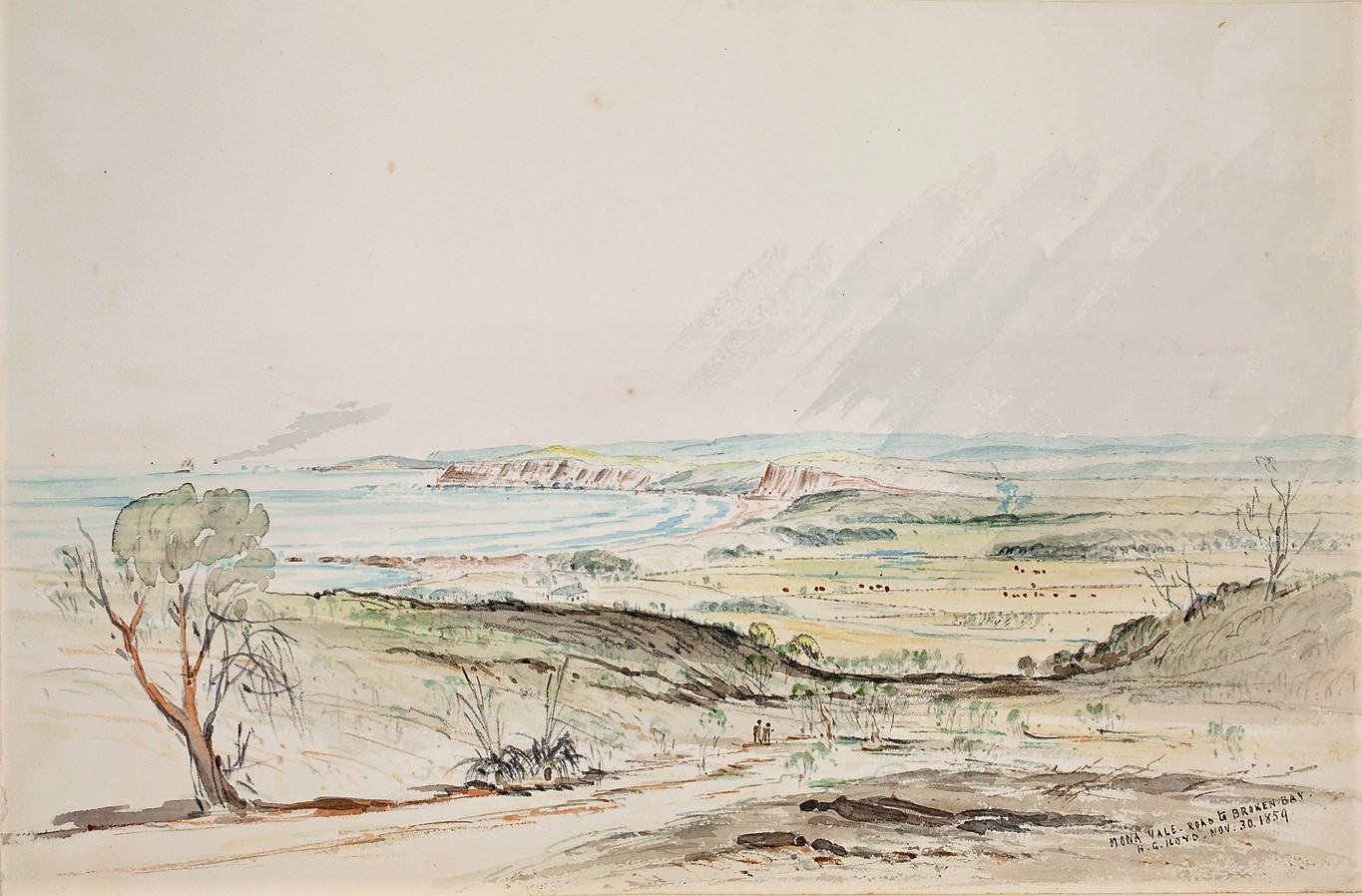
F.109 Mona Vale road to Broken Bay from Volume 1: Sketches of N. S. [New South] Wales, 1857-1888 / by H. Grant Lloyd, Image No.: a5894117h, courtesy Dixson Library, State Library of New South Wales. NB: This aspect looks as though the walkers are heading to Mona Vale from Newport, also there is no St John's on what we now call Mona Vale headland - that chapel opened in 1871.
The route wound over Sugarloaf and then down Tumbledown Dick Hill to Foley's Hill, named for Daniel Foley, the unfortunate gentleman who settled 'Mona Vale Farm' and was murdered on his way home. Visit - The Murder of David Foley by Shelagh Champion OAM
GORDON. 1. Daniel Dering Mathew, 800. Eight hundred Acres; bounded on the West by part of the East boundary of Pymble's Farm, bearing South 114 chains to the Parramatta-road; on the South by that road to the Western corner of B. Clayton's Farm, and by the North-west boundary of that farm, bearing East thirty degrees North 28 chains; on the East by a line bearing North 135 chains; and on the North by a line bearing West 61 chains to the Eastern boundary of Pymble's Farm. Quit-rent, £6 13s. 4d. sterling, commencing 1st January, 1839. Classified Advertising (1831, October 1). The Sydney Gazette and New South Wales Advertiser (NSW : 1803 - 1842), p. 1. Retrieved from http://nla.gov.au/nla.news-article2202859
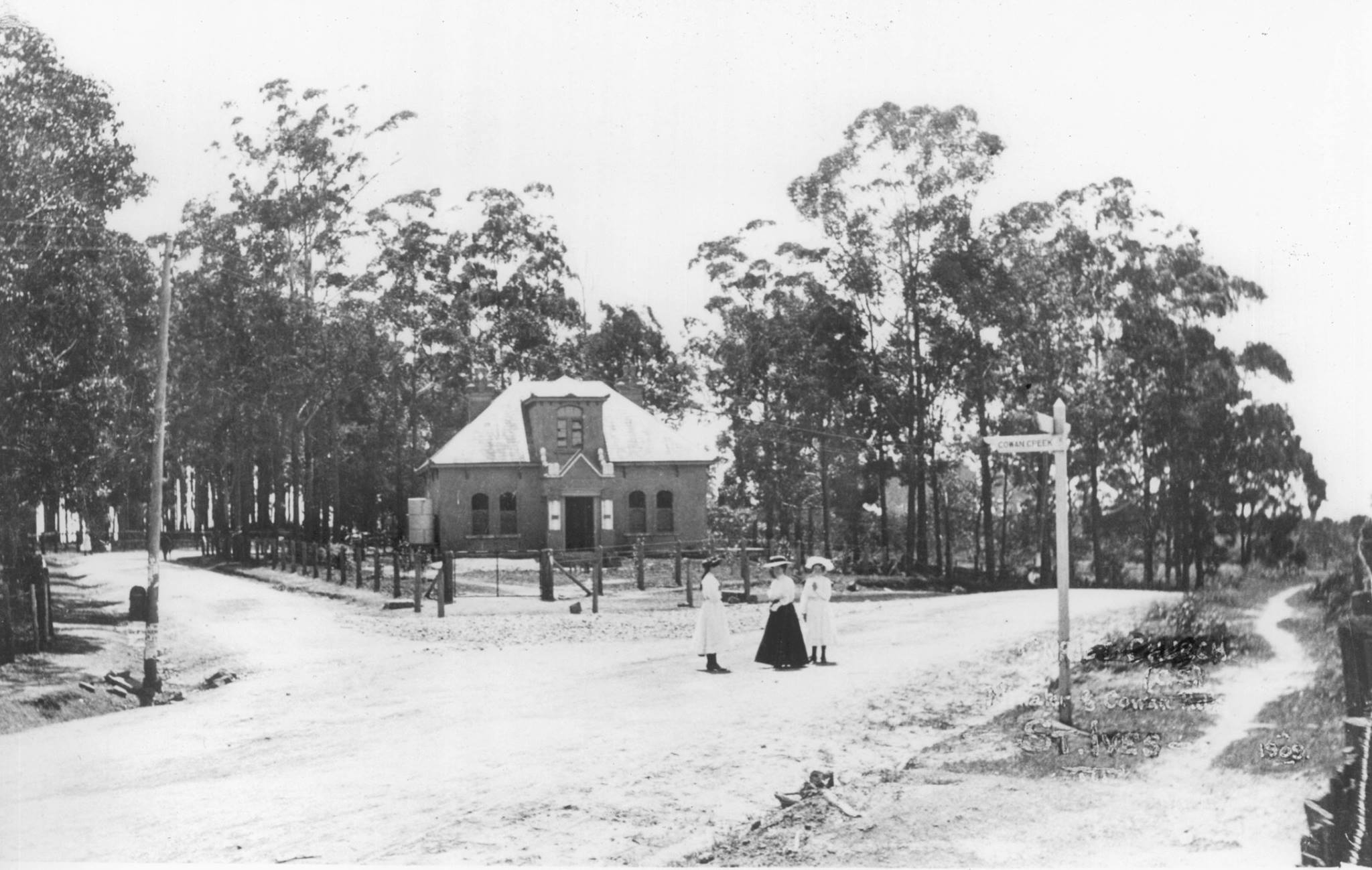
The corner of Pittwater Road (now Mona Vale Road) and Cowan Road, St. Ives, circa 1900 to 1909. Courtesy Ku-Ring-Gai Historical Society.
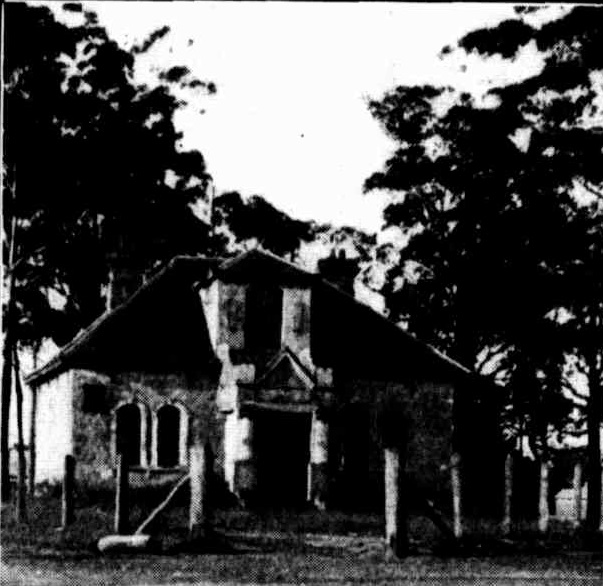
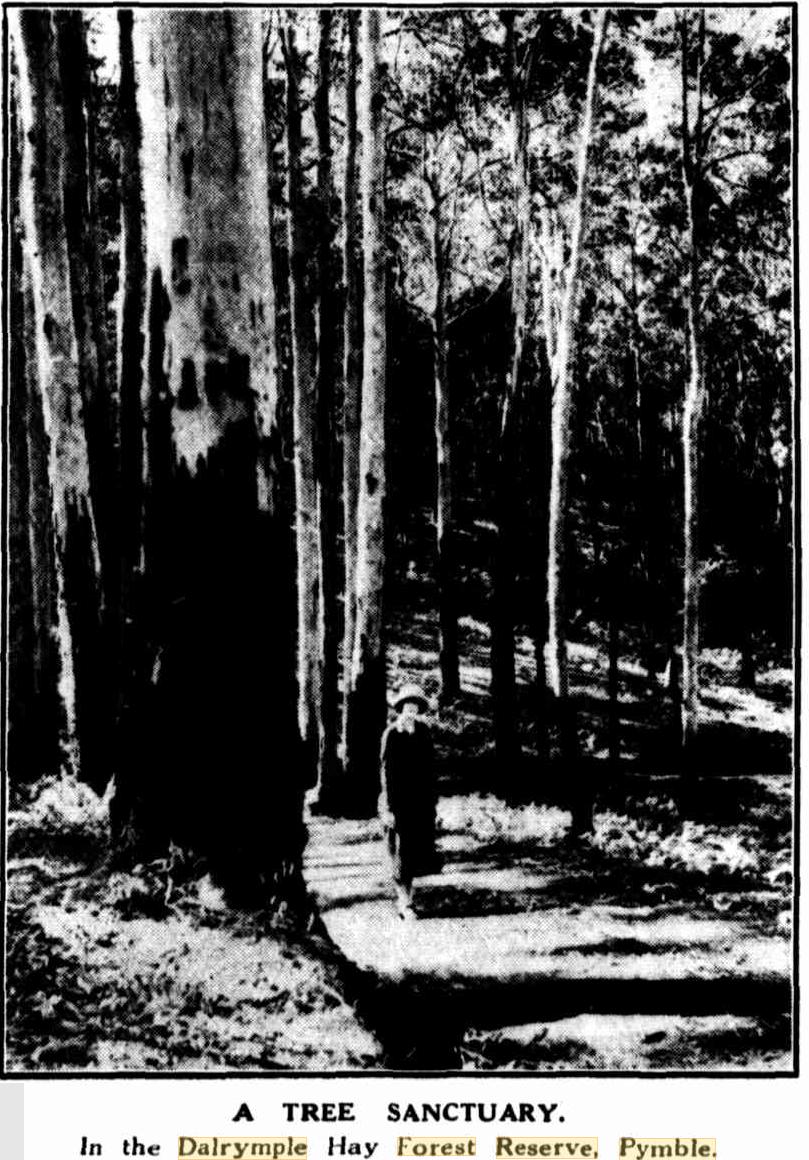
Accidental Death.
On Friday afternoon, a party consisting of William Morgan, Jame Peiniiell, Joseph Waterhouse, Robert M'Intosh, and Jim Allen Jones, set out on horseback from Lane Cove, intending to proceed to Pittwater. They had proceeded about three miles along the by-road or foot-track, when Jones rode against an over hanging limb of a tree with such violence as to throw him from his horse, fracturing his skull. His companions conveyed him home, where he lingered until about six o'clock on Saturday morning, when he expired. Deceased was a tailor by trade, and until recently was a resident in Sydney.-Herald, Feb. 27. Sydney News. (1854, March 4). The Maitland Mercury and Hunter River General Advertiser (NSW : 1843 - 1893), p. 4. Retrieved from http://nla.gov.au/nla.news-article686369
The Robert M'Intosh referred to here is Robert McIntosh II, son of the Robert McIntosh who held land by grant at Pittwater.
Robert McIntosh junior, aged 21, married Jane Pymble in 1830. They lived at Gordon, where they had an orchard opposite St. John’s Anglican Church. The inscription on their gravestone at St. John’s, Gordon, states that Robert was born on 4 February 1809 and died 30 June 1889, while Jane died 28 June 1882, aged 72 years. [3.]
Pymble was named after Robert Pymble (1788–1861) who acquired a land grant of 600 acres (242.8 hectares) in June 1823. Mr. Pymble was a silk-weaver from Hertfordshire, England, who arrived in Sydney with his wife and six children on board the Marquis of Wellington on 24 July 1821 as a free immigrant. Upon arriving in Sydney, Pymble hired convict labour and cleared the forest land for agriculture. By 1828 he had cleared 10 acres (4 hectares) of land east of Lane Cove Road as far as the border of Irishtown (now North Turramurra), sold the timber to lumberyards and had cultivated three acres (1.2 hectares) for orchards of orange trees. From 1826 until 1833 he served as policeman and pound keeper of the Lane Cove district.
GOVERNMENT NOTICE.
COLONIAL SECRETARY'S OFFICE, December 19th, 1826.
HIS EXCELLENCY the GOVERNOR has been pleased to approve of the following Alterations in the
Police of the ColonyIn the Town of Sydney-To be Constables
In the District of Hunter's Hill.-Robert Pymble, came free, per Marquis of Wellington, to be Constable and Poundkeeper.
In the District of Windsor.--John Roche, per Ship Earl St. Vincent (1), free by servitude, to be a Constable in the Room of Richard Hayes, Prisoner of
the Crown, permitted to resign.
At Myrtle Creek.-Joseph West, per Ship Coromandel (2) free, to be a Constable in the Room of James Hartley, per Ship Indefatigable, dismissed.
By His Excellency's Command.'
ALEXANDER M'LEAY. Advertising (1826, December 22). The Monitor (Sydney, NSW : 1826 - 1828), p. 1. Retrieved from http://nla.gov.au/nla.news-article31758073
On the 6th instant, at his late residence, Lane Cove, after a long and painful illness, Mr. Robert Pymble, sen., an old and respected colonist, in the 78th year of his age. He was one of our early settlers, having arrived in the colony with his wife and six children in the year 1821. Family Notices (1861, January 8). The Sydney Morning Herald (NSW : 1842 - 1954), p. 1. Retrieved from http://nla.gov.au/nla.news-article13050988
FUNERAL.—The Friends of the late ROBERT PYMBLE are respectfully requested to attend his Funeral. The procession to move from his late residence, Lane Cove, THIS DAY, Tuesday afternoon, at 1 o'clock, and thence to proceed to St. Leonard's Cemetery, and arrive at 4 p.m. at the above place mentioned. REUBEN THOMAS, undertaker, 141, York-street, late of 54, King street. Family Notices (1861, January 8). The Sydney Morning Herald (NSW : 1842 - 1954), p. 8. Retrieved from http://nla.gov.au/nla.news-article13051002

"Pymble in 1887 / showing residences of Mr James Pymble / Mr E.A. McIntosh / & Casey's house in distance / Position: Photograph taken from site of present / Railway Station facing towards Mr E.R. / Taylor's house in Grandview St."/ Mitchell Library / 30.11.37 / with complts from / Mr Justice Boyce" in ink in the same hand on the reverse. With the compliments of E.A. McIntosh on the reverse. Image No.: a1528228h, courtesy State Library of NSW.
%20Pymble%201887.jpg?timestamp=1535491580281)
"Taken from site of present Station / to East / Pymble 1887 / Showing residence of Mr CB Bradford in the / distance & orchard & nursery of Mr E.A. McIntosh / fruit packing shed cart & buggy shed & Miss Gaden's. / The latter was known as Wallaby Hall & was / at one time Mr E.A. McIntosh's batchelor's [sic] quarters. / The blue gum tree on the hill is still in Mr F.S. Boyce's grounds." in ink in the same hand on the reverse. With the compliments of E.A. McIntosh on the reverse. Image No.: a1528229h, courtesy State Library of NSW
Another orchardist was Vernon’s son-in-law, Philip Richardson, an Irish gentleman, a graduate of Trinity College, Dublin, sometimes known as The Squire of Rosedale. He was said never to have worked his farm: his native-born wife Julia Vernon superintended it with much vigour. Killeaton Street is named after Richardson’s family home in Ireland.
Other early orchardists included George Mudie, a Scot who, having worked for his father in a bakery at Circular Quay and tried his luck on the Victorian gold fields, who bought 125 acres at £1 an acre, on the Cowan Road. Mudies Road bears his name. James Terrey, had 100 acres, now the site of the Pymble Golf Course. Mr. Terrey also owned 640 acres further east, owned for a few years by his Obadiah prior to his early deaths and later named after James Terrey - Terrey Hills - as well as land at Cottage Point. [4.]
Further east at what we now call Frenchs Forest Simeon Henry Pearce (1821–1886) and his brother James acquired 200 acres in 1853. The area was known as Rodborough and designated as being part of Manly Cove although today Rodborough Road is in Frenchs Forest and runs into Allambie Heights off the Warringah road. Part of this was acquired by James Harris French 1817 - 1893, a prominent citizen in the founding of the Municipality of North Willoughby on 23 October 1865 and where a road named for him is still. He was born in Dorset, England, to James and Mary French in 1817. James H. French junior arrived in Sydney on the Alfred in January 1841 at the age of 23 and married Mary Tiffin, a daughter of the prominent Jamaican 'Billy' Blue on 10 August 1842. To Mr. French is also ascribed the development of Forestville.
Surveyor General's Office,
Sydney the 28th January, 1857.
CHURCH OF ENGLAND CHURCH, SCHOOL, AND PARSONAGE, AT RODBOROUGH.
THE descriptions of the following portions of land are published for general information, in order-that the.persons concerned may have an opportunity of. correcting any errors or omissions that may have been made inadvertently.
At the expiration of one month from this date, if no caveat be lodged in this Office, or other issue of uncertainty appear, the Deed of Grant of the same will be executed in favour of the approved Trustees.
County of Cumberland.
One acre, 1a., parish of Manly Cove, at Rodborough; commencing at the south-eastern intersection of,the Bantry Bay Road with a road 1 chain wide, dividing it from S. H. and J. Pearce's 200 acres, and bounded on the north by the road dividing it from S. H. and J. Pearce's said 200 acres, bearing east 2 chains 50 links on the east by a line bearing south 4 chains; on the south by a line, bearing west 2 chains *50 links to the Bantry Bay Road; and on the-west by that Road bearing north 4 chains-At the point of commencement. (As Site for a church)
Two roods, 2r., parish of Manly Cove, Rodborough, commencing at the north-east corner of the Church. of England church allotment, ! on the southern side of a road 1 Sham wide, dividing it from S. H. find J. Pearce's 200 acres, and bounded on the north by that road,, bearing east 1 chain ; 25 links; on the east by a line bearing south 4 chains; on the south by a line bearing west 1. chain 25; links; and on the west by a line dividing it from Church allotment aforesaid, bearing north 4 chains, to the point of commencement. (As Site for /School.')
Two roods, 2r.,-parish of Manly Cove, at Rodborough commencing at the north-east corner of the Church of England; School allotment, on the southern side-of: a road 1 chain wide, dividing it from S. H. and J. Pearce's 200 acres, and bounded on 'the ruorfeby thatroad, bearing east 1 chain 251inks ; on the east by a line bearing south 4 chains; on the south. by a line bearing west 1 chain 28 links; and on the west by a line dividing it from the allotment aforesaid, bearing north 4 chains to the point of commencement, (a Site for a Parsonage)
GEORGE BARNEY,
Surveyor General. CHURCH OF ENGLAND CHURCH, SCHOOL, AND PARSONAGE, AT RODBOROUGH. (1857, January 30). New South Wales Government Gazette (Sydney, NSW : 1832 - 1900), p. 184. Retrieved from http://nla.gov.au/nla.news-article229955233
Crown Land Sales at Rodborough in 1858:
CROWN LAND SALES.
The following lots of land will be offered for sale, public auction, at the undermentioned places,Wednesday, the 25th August, at 11 o'clock : (At the Land Sales' Room, Colonial Treasury, Macquarie-street, Sydney.)
SPECIAL COUNTRY LOTS.
County of Cumberland, parish of Manly Cove, at the west boundary of S. H. and J. Pearce's 200 acres at Rodborough:-Lots 3 to 5, SO», ouch ; 0,18a. : Upset price, £1 5s. per acre.
County of Cumberland, parish of Manly Cove, at Rodborough, and lying to the west of William Redman's 24 acres:-Lot 7, 12a. 3r. Op.; 8, lia. lr. 38p.j 9, li 3r. 0/. Upset price, £1 5s. per nore.
County of Cumberland, parish of Manly Cove, lying north-westerly from William Redman's 21 acres, at Rodborough :-Lots 10 and ll, 30a. 3r. 8p. each, 18 lol 20a. each. Upset price, £1 5s. per acre.
County of Cumberland, parish of Manly Cove, adjoining and lying to the north of Redman's, Jones's, and Ainsworth's portions, near Rodborough :-Lot 10, ll lr. Sip. ; 17 to 20,20a. each ; 21 to 33, 21a. each; 5 20a. lr. 24p. ; 26, 14a. lr. 24p. ; 20, 13a. ; 27 and S I 14a. lr. 24p. each. Upset price, ..
SPECIAL COUNTRY LOTS.
County of Cumberland, parish of Willoughby, lying to the south of Wright's 25 acres, and J. Nichols' 35 acres, and near the head of Burns's Bay :--Lot 1, lío.3C| Upsot price, £2 10s. per acre. Lot 2, 18a. lr, ; 9, Ul lr, 8p. Upset price, £2 per acre. Lot 4, Sis. Or. 8J« Upset price, .£1 per acre s-Lot Ö, lfla Upset price per acre. Lot 0,14a. Or. 18p. ; 7, 14a. Or. 34p. ; 8,13i 3r. 30p. Upset price, £2 10s. per acre.
County of Cumberland, parish of Willoughby, adjoining and near to the northwest boundaries of Nichols' 380 acres. Lot 0, 10a. 3r. 32p. Upset price £2 per acre. Lot 10, 12a. 2r. 20p. ; ll, 13a. Or. 33p. 13, 13a. 2r.*23p. Upset price, £2 10». por acre, w 13,18a. Or. Op. Upset prioe, £2 per aore. Lot 14, IO» Or. 18p. ; 16, lia. 3r. 38p. ; 10,13n. Or. 17p. ¡ 17, DJ. it 18p. ; 18,10a. 2r. 4p. Upset prloo, £2 lOa.por acre Lot 10, 20a. 2r. 37p. ! 30, 18n. Or. 33p. Upsot price £2 10s. per acre.
County of Cumberland, parish of Manly COVE, to the east of J. H. French's 41 acres and 12 perches, near Rodborough :-Lots 21 and 22, 13 a, 2r, 23p ; each. Upset price, £2 10s. per acre. CROWN LAND SALES. (1858, July 29). Empire (Sydney, NSW : 1850 - 1875), p. 6. Retrieved from http://nla.gov.au/nla.news-article60426637
PARLIAMENT OF NEW SOUTH WALES
LEGISLATIVE ASSEMBLY.
WEDNESDAY, NOVEMBER.17.
The Speaker, took the chair at half-past three o'clock.
ROAD AT MANLY COVE.
Mr. SMITH asked the honorable Secretary for Land and Works, if the sum of £100, voted by the House on the 3rd August, 1858, for opening up a road through Manly Cove has been expended ; and if so upon what road ?
In reply to this question, Mr. ROBERTSON stated that the £100 voted for opening up a road through Manly Cove, was placed at the disposal of the hon. Mr. Bligh, Mr. W. Redman, and Mr. French. Mr. French had, however, resigned the trust. Without further enquiry it was not at present known how much of the money had yet been expended. The particular road for which the money was granted was described as the new road from Bantry Bay to Rodborough, in the parish of Manly Cove. PARLIAMENT OF NEW SOUTH WALES. (1858, November 18). The Sydney Morning Herald (NSW : 1842 - 1954), p. 4. Retrieved from http://nla.gov.au/nla.news-article13020527
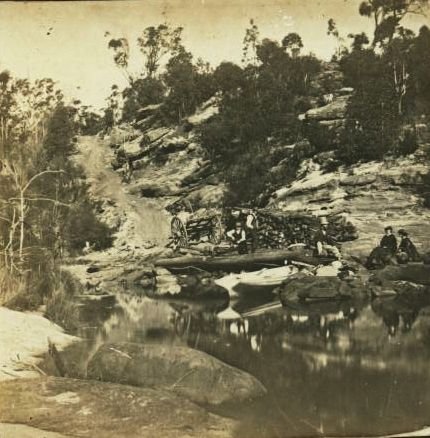
View of the ford over the Lane Cove River at the tidal limit at the 'Blue Hole' circa 1860. The cart road was superceded by today's Ryde Road and Lane Cove Road linking Pymble and Ryde. Notice the pile of timber billets and the cart. Photo taken by Professor Smith (in stovepipe hat) of Sydney University. Primary Records reference number 5/2861

Middle Harbour road at Linfield circa 1900, courtesy State Library of NSW
There was and is also 'Duffy's Forest'. This was a land grant in 1857 and he too was a timber-getter who cleared a road through the bush to Cowan Creek, where he built a stone wharf for transporting timber. The wharf is still known as Duffys Wharf and the road as Duffys Track.
Patrick Duffy (1786–1854) was a labourer until he enlisted in the British Army 3rd Regiment of Foot (known as the Buffs) for unlimited service at Sligo on 14 Sep 1805, aged 19 - he served (more below), married, had children. The Duffy family sailed on the ship 'Eliza' on the 20th, landing in Sydney on 22 November 1822.
Patrick was appointed Superintendent of the convict barrack at Parramatta. He was instructed to 'immediately report yourself'.On 21 Jul the Government Gazette reported that he was to be appointed Constable at Parramatta in the room of John Murphy, deceased.
On 3 Febuary 1830, Patrick signed a long petition to the Governor applying for a grant of land. He stated that he had been left in New South Wales when the Buffs went to India, on the recommendation of Colonel Stewart. He had been 'discharged in consequence of ...length of service and large family...was a non commissioned officer in the Buffs nearly 18 years during which time and the whole of his service Petitioner maintained an unblemished character' and '...is now labouring under very sever attacks of Rheumatism and other bodily debilities occasioned by the fatigues and wounds indured during the peninsula campaign...'
One hundred acres were granted and Patrick began to clear the land. A dispute arose with neighbours who claimed that portions of the land had been allocated to them. After the Surveyor General admitted an eror had been made, Patrick was authorised to select another plot on 6 Sep 1831 and this time, took possession of 100 acres at South Colah (now Thornleigh).
On 23 Sep 1832, James Milson, who held land near Duffy, wrote to the Surveyor General concerning the making of the road 'Duffy's Lane'...'since that time a complaint had been made by Patrick Duffy and one Sweeney, holding a ticket of leave, that the road which was originallly marked out by Mr Abbott is inconvenient to them and insist on having a new line on road...as these persons are every day threatening and interrupting my men in their work. I shall feel obliged to your finally settling the point of dispute'. The road along the top of the ridge was then marked and confirmed. It exists today as Duffy Avenue, Thornleigh, running from Pennant Hills Road to Westleigh.
Patrick's three eldest sons had by this time left home, but each is recorded in his own right as a householder living nearby, probably on portions of their father's original grant.
The Sydney Morning Herald of 13 Apr 1854 recorded the death of Patrick; 'At his residence, Pennant Hills on the 11th inst. in the 68th year of his age, Patrick Duffy, late Sergeant of His Majesty's 3rd Buffs and father of P.J. Duffy of the firm Duffy and Mitchell, Timber Dealers, leaving a large family to deplore their loss'. He died just a few weeks after his wife:
At her residence, Pennant Hills, in the 68th year of her age, Bridget, the beloved wife of Mr Patrick Duffy, late sergeant of Her Majesty's 3rd Regiment, or Buffs, and mother of Mr P J Duffy, of the firm of Duffy and Mitchell, Timber Dealers, Market Wharf, leaving a husband and large number of children and grand-chil-dren to deplore their loss. Family Notices (1854, February 20). The Sydney Morning Herald (NSW : 1842 - 1954), p. 8. Retrieved from http://nla.gov.au/nla.news-article12956397
Peter Joseph Duffy (1814-1878), Patrick's second son, lived at the 'George Inn' on the corner of Market and Castlereagh Streets Sydney, and in the 1840's he was a sawyer of Kent Street Sydney. His brother Patrick Michael Duffy (1825-1897) had 100 acres at the 'Parish of South Colah' (also Parish of Gordon on some maps) by 1839 - this was in what we call now Hornsby.
589. John Thorn, 640, Six hundred and forty acres, parish of South Colah, commencing at the south-west corner of Patrick Duffy's 100 acres ; and bounded on the north by that grant by part of Milsom's and by part of Samuel Horn's 320 acres 55 chains; on the east by a line south 25 degrees 30 minutes west 95 chains to the Field of Mar's Common ; on the south by that common being a line north 64 degrees west to the Pennant Hills Road 39 chains; and again by a line north 64 degrees west 60 chains; and on the north-west by a line north 62 degrees east 84 chains to the south-west corner of Patrick Duffy's 100 acres as aforesaid. GRANTS OF LAND. (1839, September 7). New South Wales Government Gazette (Sydney, NSW : 1832 - 1900), p. 989. Retrieved from http://nla.gov.au/nla.news-article230384451
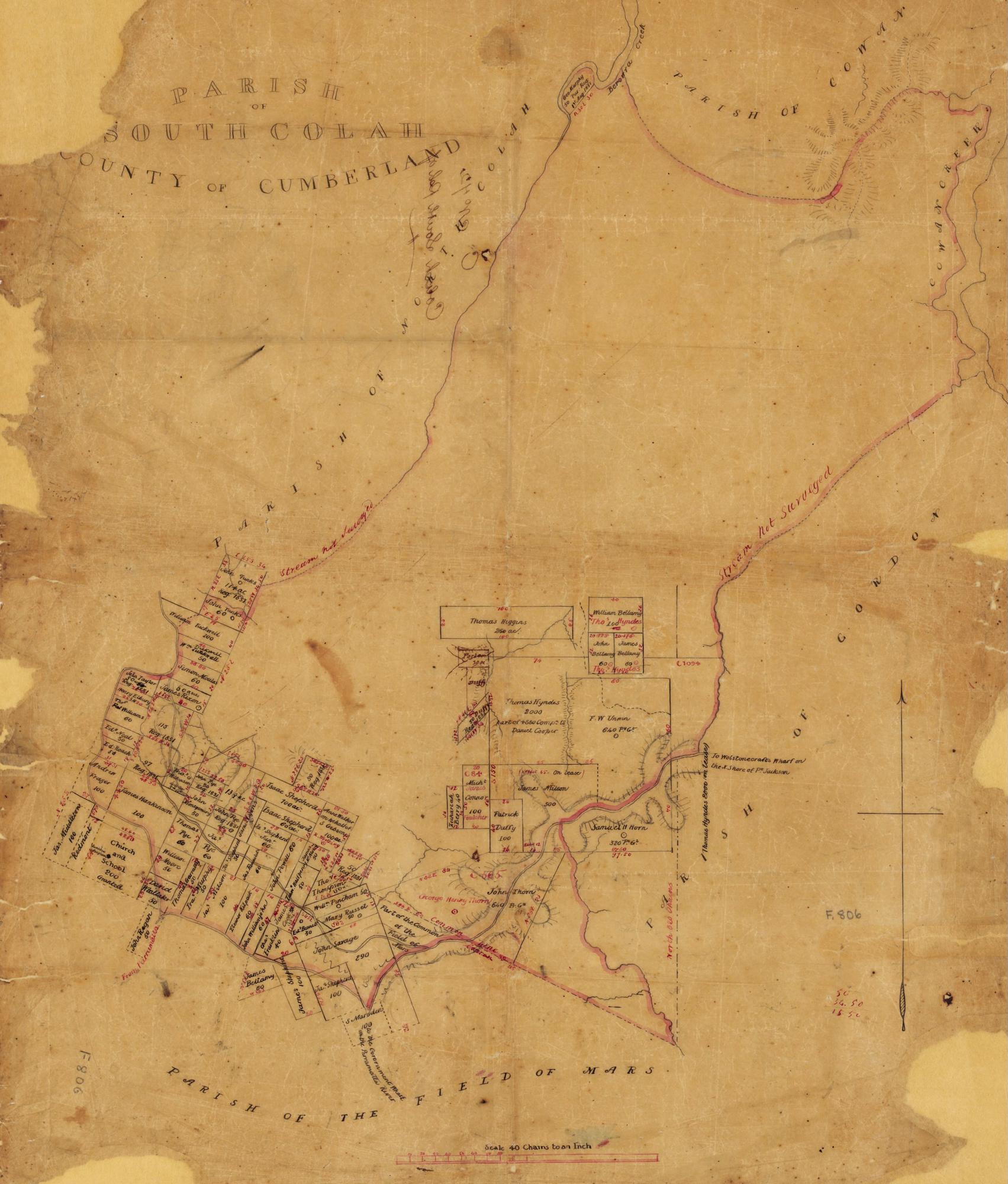

([184-]). Parish of South Colah, County of Cumberland (and section from) Retrieved from http://nla.gov.au/nla.obj-230002153
In the Insolvent Estate of Peter Joseph Duffy, of Lane Cove, sawyer.
WHERE AS the Estate of Peter Joseph Duffy was, on the 21st day of August, 1843, placed under Sequestration in my hands by order of His Honor Mr. Justice Stephen, I hereby appoint a Meeting of the Creditors of the said Peter Joseph Duffy to be holdeh at the Supreme Court House, Sydney, on Tuesday, the 5th day of September next, to commence at 1, p.m., and end at 1.30, p.m., for proof of Debts, and election of a Trustee or Trustees for the collection, administration, and distribution of the said Insolvent's Estate; and nnless at the said Meeting it be shewn that the goods and effects of the Insolvent exceed £100, the Commissioner will summarily proceed to rank the Debts which shall be then proved, and will direct the proceeds to be distributed by the Trustees accordingly.—Dated this 23rd day of August, 1843.
WILLIAM H. KERR,
Chief Commissioner of Insolvent Estates. WHEREAS the Estate of Peter Joseph Duffy was, on the 21st day of August, 1843, (1843, August 25). New South Wales Government Gazette (Sydney, NSW : 1832 - 1900), p. 1103. Retrieved from http://nla.gov.au/nla.news-article230126502
By 1854:
WANTED, an experienced Drayman. Apply to DUFFY and MITCHELL, Timber Yard, Market Wharf.
WANTED, Sawyers and Splitters. Apply to DUFFY and MITCHELL, Timber Yard, Market Wharf. Advertising (1854, March 7). The Sydney Morning Herald (NSW : 1842 - 1954), p. 1. Retrieved from http://nla.gov.au/nla.news-article12953339
INSOLVENT COURT.
MONDAY.
THE surrenders of the following estates were accepted by his honor the CHIEF JUSTICE.
Peter Joseph Duffy, and James Mitchell, of Sydney, timber merchants, on petition and affidavit ; schedule to be filed on or before Saturday next. Mr. Perry, official assignee. INSOLVENT COURT. (1855, August 7). The Sydney Morning Herald (NSW : 1842 - 1954), p. 4. Retrieved from http://nla.gov.au/nla.news-article12972618
In 1857 P J Duffy was looking for more people for:
WANTED, Labourers for the Bush. Apply to PETER J. DUFFY, Brodie and Craig's Wharf.
WANTED, a Rough Carpenter for the Bush. Apply to PETER J. DUFFY, Brodie and Criag's Wharf.
WANTED, a Bullock Driver for the Bush. Apply to PETER J. DUFFY, Brodie and Craig's Wharf. Advertising (1857, January 31). The Sydney Morning Herald (NSW : 1842 - 1954), p. 1. Retrieved from http://nla.gov.au/nla.news-article12991766
. In 1874 he is recorded as a timber-getter at Brisbane Waters. He passed away in 1878:
DUFFY. — November 18, at his residence, 472, Harris-street, Ultimo, Peter Joseph Duffy, aged 63 years, leaving a wife and a large circle of friends to mourn their loss. Family Notices (1878, November 30). The Sydney Morning Herald (NSW : 1842 - 1954), p. 1. Retrieved from http://nla.gov.au/nla.news-article13413339
Funerals.
THE FRIENDS of the deceased Mr. PETER JOSEPH DUFFY are respectfully invited to attend his Funeral ; to move from his late residence, Harris-street, Ultimo, THIS AFTERNOON, at 2 o'clock, to Necropolis. THOMAS, Undertaker, 141, York-street.
GRAND UNITED ORDER OF ODDFELLOWS. — GRANDMASTERS' COUNCIL. — All Members of the Grandmasters' Council are requested to attend the Funeral of our late esteemed Brother, P.G.M. PETER JOSEPH DUFFY ; to move from his late residence, Harris-street, Ultimo, at a quarter-past 2 o'clock, THIS DAY.
JOHN BARRACLOUGH, G.M.
HENRY STOCK, G. Sec. GRAND UNITED ORDER OF ODDFELLOWS, SYDNEY DISTRICT. — The Officers and Brothers of the various Lodges are requested to attend the Funeral of our late esteemed Brother P.G.M. PETER JOSEPH DUFFY, of the Travellers' Home Lodge, 731, to meet at his late residence, Harris-street, Ultimo, at a quarter-past 2 o'clock, THIS DAY,
HENRY STOCK, D.M.
GEORGE BRETNALL, D. Sec.
GRAND UNITED ORDER OF ODDFELLOWS,
SYDNEY DISTRICT.
The Officers and Brothers of the Travellers Home Lodge, together with the officers and brothers of the various lodges, are re-quested to attend the Funeral of our late esteemed Brother, P. N. F. PETER JOSEPH DUFFY, to meet at his late residence, Harris-street, Ultimo, at a quarter-past 2 o'clock, THIS DAY. JAMES BOYLE, N. G., CHARLES HOULAND, Secretary. Family Notices (1878, November 29). The Sydney Morning Herald (NSW : 1842 - 1954), p. 10. Retrieved from http://nla.gov.au/nla.news-article28392986
John Frederick Duffy, Orchadist with residence listed as 'Mona Vale, Pittwater', and who had a son of the same name, born at Thornleigh in 1895, who was also an Orchadist and a driver in WWI, was Warringah Shire President 1915-1918 and Councillor thereafter:
SHIRE OF WARRINGAH.
NOTICE is hereby given that Councillor John Frederick Duffy has been duly elected President of the Shire of Warringah for the term commencing 1st proximo.
R. G. JAMIESON,
Shire Hall, Brookvale, Shire Clerk.
22nd February, 1915. SHIRE OF WARRINGAH. (1915, March 3). Government Gazette of the State of New South Wales (Sydney, NSW : 1901 - 2001), p. 1471. Retrieved from http://nla.gov.au/nla.news-article226909386
WEDDING BELLS DUFFY-WHITE. On Saturday, 19th instant, at St. St. Jame's Church, King-street, Sydney, the pretty wedding of Miss Rita Florence White, only daughter of Mr. and Mrs. Frederick White of Manly, (late of Parramatta), and Mr. John Frederick Duffy, only son of Mr. and Mrs. Duffy of Mona Vale, Manly, was solemnised by Rev. J. Russell.
The church was beauty-fully decorated with choice white blooms, and the guest pews tied with true lovers knots. The organist presided at the organ, and during the signing of the register, "Beloved it is Morn,', was sung by Miss Kathleen Lovell (cousin of the bride). The bride who was given away by her father wore a beautiful scintillating bridal gown of ivory georgette over silver tissue, with underskirt of jewelled embroidery. The court train was of pink tulle and ninon, draped with silver lace, held in place by clusters of silver roses. With her tulle veil, she wore a band of silver tissue and trail of orange blossom. Her bouquet of roses and carnations with tulle and silver streamers, and a cheque were the gifts of the bridegroom. Two brides-maids were in attendance, Misses Louie Flook (bride's cousin) and Elvie Duffy (bridegroom's sister), prettily and effectively frocked respectively in shaded mauve, and champagne pleated crepe de ehene, worn with hats to match; their bouquets to tone and gold armlet and diamond brooch were the bridegroom's gifts. Mr. Ritchie White (bride's brother) was best man, and Mr. Stan White (bride's brother), grooms man. Mrs. White (bride's mother) wore orchid mauve floral georgette, over brocaded tissue, and large crinoline hat of fuchsia shade. She carried a posy of pansies, red roses and lavender. Mrs. Duffy (bridegroom's mother) black morocain, trimmed with white pleated georgette, black hat. Her posy was of scarlet roses. After the ceremony a reception was held at Sargent's, Market-street, about 100 guests being present. Mr. P. Winston presided, and the usual toasts were honored. Later Mr. and Mrs. J..P. Duffy left for the Jenolan Caves, where the honeymoon is being spent. WEDDING BELLS (1925, December 23). The Cumberland Argus and Fruitgrowers Advocate (Parramatta, NSW : 1888 - 1950), p. 4. Retrieved from http://nla.gov.au/nla.news-article103769683
£150 DESTROYED IN COTTAGE FIRE
A weatherboard cottage owned by Mr. John Duffy In Waratah Street, Mona Vale, was destroyed by fire yesterday afternoon, just after Mr. Duffy had completed arrangements for Its sale.
In trying to save £150 In notes in one of the rooms Mr. Duffy suffered cuts and scorched hands, but the money was burnt with the exception of a few silver coins. It is not known how the fire started. £150 DESTROYED IN COTTAGE FIRE (1943, December 13). The Sydney Morning Herald (NSW : 1842 - 1954), p. 4. Retrieved from http://nla.gov.au/nla.news-article17878955
The McIntosh-Pymble and Duffy connection is not the only between St. Ives and Pittwater as William Henry McKeown, who was later to own acreage of the 'Rosedale' once held by Daniel Mathew, was also among those who were responsible for erecting the Chapel at Church Point and was named as he who conducted services under a tree at Bayview prior to that. There is more on himself and his orchard below but he also had chickens:
THE FAMOUS LANE COVE LANGSHANS
Mr. W. H. McKeowns Poultry.
A TRIP TO GORDON (ERTSWHILE LANE COVE)
 ON Saturday lost we had the pleasure of paying a visit to Mr. W. H. McKeown's Poultry Farm at Gordon (Lane Cove), where are to be seen—as the majority of people interested in poultry know —some of the most creditable specimens of the Langshan breed of fowls to be found this side of the line. The renown of Mr. W. H. McKeown's Langshans, we need scarcely remark, has travelled throughout New South Wales, and is not unknown in the other colonies. Without an effort towards making any artificial display, the gentleman named has—by simply rearing first-class birds, and doing business in the good, old-fashioned, best system, of faithfully giving customers that treatment which he professes to give—scored so heavily that to confess to an ignorance of the merits of his strain is to confess one's self a stranger to Langshan fowls in Australia. Mr. McKeown e has bred, during his 48 years residence in the district which is now proud to claim him as a leading resident, many good varieties of feathered stock; but he confesses that the Langshans have triumphed in the end. A. few game pullets, and a decent-looking rooster, and the Last of the Mohic ---the Spanish, we should say—just preserve a semblance of caste superiority, over the odd barn-doors,picking about the place; but the days of even these few survivors of past glories, are numbered.
ON Saturday lost we had the pleasure of paying a visit to Mr. W. H. McKeown's Poultry Farm at Gordon (Lane Cove), where are to be seen—as the majority of people interested in poultry know —some of the most creditable specimens of the Langshan breed of fowls to be found this side of the line. The renown of Mr. W. H. McKeown's Langshans, we need scarcely remark, has travelled throughout New South Wales, and is not unknown in the other colonies. Without an effort towards making any artificial display, the gentleman named has—by simply rearing first-class birds, and doing business in the good, old-fashioned, best system, of faithfully giving customers that treatment which he professes to give—scored so heavily that to confess to an ignorance of the merits of his strain is to confess one's self a stranger to Langshan fowls in Australia. Mr. McKeown e has bred, during his 48 years residence in the district which is now proud to claim him as a leading resident, many good varieties of feathered stock; but he confesses that the Langshans have triumphed in the end. A. few game pullets, and a decent-looking rooster, and the Last of the Mohic ---the Spanish, we should say—just preserve a semblance of caste superiority, over the odd barn-doors,picking about the place; but the days of even these few survivors of past glories, are numbered.
The Langshans have " cut out" all the old favourites, and—with Mr. McKeown—have evidently come to stay. In this connection we may perhaps quote with a advantage, a few lines published by Mr. McKeown (with reference to the particular breed under notice) some years back. The remarks still hold good, the only thing which remains to be added being, that the value of the last lines may now be emphasized more than ever. Mr. McKeown, in the little publication referred to, says:—
" I bought a cock and three hens . . . and by the amalgamation of the strains, and careful mating, I have succeeded in raising birds which have won many prizes at the Sydney shows, and are superior to any imported Langshans I saw; in Christchurch, N.Z. . . , . I have-proved the Langshan to be one of the best all round of the many breeds of fowls. They are good layers, grand table fowls, and very hardy. . . . The young ones develop so well that it is difficult to distinguish pullets which I have of nine months,from the old hens."
On a road or lane leading from the old "Lane Cove Road," off towards Pittwater, is Mr. McKeown's homestead. It stands on the crest of a rise, and the orchard slopes away from the proprietor's residence, towards the north-east, giving an aspect, for t tne cultivated land, Such as is generally coveted by the settlers when marking out his future holding. Over "billows" of rolling uplands the view stretches out towards the rugged country, on the coast, near Marrabeen. The .glimpses of the country inland, when the visitor turns, and looks out westerly, are charming. The land dips deeply in the near front, and then rises to bear, on the crest of the next wave, so to speak, the old main road, and the new steel-way, both running upwards and onwards towards Hornsby. Then, beyond, and far • away over the charming stretches of fields, rich in their emerald mantles of young crops, or with brown soil just turned in regular furrows by the yeoman's plough are forest land, and the homesteads of Field of Mars, Carlingford, and Ryde;— In the centre of these attractive surroundings,-is Mr. McKeown's orchard, with its old-fashioned cottage residence, numerous outbuildings, and poultry yards.. It seems most natural that the birds thrive, and prosper,—till their renown spreads through the country, carrying proudly into other districts the fame of their breeder. They would be most ungrateful Langshans, were it otherwise!
The fast-developing town of Gordon is reached, either by road or rail. In the latter case, a pleasant trip may be taken via Sydney, the visitor crossing the harbour, landing at Milson's Point, and taking the new line through St. Leonard's to Chatswood, and so on, to the spot known in the " good old days" as Lane Cove. This is, of course, an interesting trip, and, the day we ; made it, the country was at its best; the scent from the clearings—busy with "bush" labour—and the sight of the glorious wattle bloom,brightening every yard of the route—tending to make the .journey a perfect dream of delight. After a fairly long walk from Gordon station, we reached our destination. Greeted cordially by our host, we were soon perfectly, at home and before many minutes had flown were "doing" the place. We first crossed the road to the poultry pens on the part of the proprietor's estate lying nearest the railway. Here we caught our first glimpse of the renowned Langshans. The rooster in the first yard passed was in-prize at Newcastle late show.
A taken at spme of our host's Game «idj| fewSpitnisn came upon more of lhe |» this farm—a number of splendid hens, with a couple of disti Dgulshed looking. mates, of almoit f>erfebt shape and feather. One bird, particularly. attractive, was a rooster which 'it would not be easy to best, in this class any where in this part of the-world. A few others, in pens close by claimed attention also, it being difficult to differentiate, in relation to merit, between the birds.
Retracing our steps, we passed the home-stead again; and inspected the pens on, the other side of the farm. Here a magnificent Langshan prince was met with, whose only fault was a slightly defective comb. Otherwise, he would perhaps have ranked, oh bis merits, as the first rooster of his class in , Australia. As he was, he took a prize, a little while ago, in the Melbourne Show, after most critical examination, and against, of course, a strong opposition. . In homes near by, were birds differing in characteristics;. bat al boasting that distinctive aristocratic shape, plumage, and mein, which make conspicuous the well-bred fowls already dealt with in detail.
Mr. McKeown, having come at last to the end of his feathered trophies, led the way to the dog kennels and here, a surprise quite as genuine as any in connection with the birds, awaited us. Finer specimens of St. Bernard's we never wish to see (—and how they are treated at this week's Exhibition will not be uninteresting to those who have a kindly corner in Aeir hearts for man's faithful friend!) The puppies—great lumbering, frolicsome, affectionate, fluffy young lions, they looked— greeted us with never-ceasing manifestations of interest and delightal most tumbling us- over meanwhile. Words can hardly give an idea of the " high degree " of these canine beauties; but figures may—and when we say, that one of Mr. McKeown's St. Bernard's is a relative, by immediate descent, of an animal whose price was fixed at £1,400, we may have said sufficient for the purpose.
The illustration at the head of this article gives a very good idea of the Langshan—the type of bird bred, and shown with success, by Mr. McKeown. It may be said, finally, that many poultry fanciers, and more especially men and women who expect to make a business by raising the most profitable breed of fowls known in New South Wales, will only be doing a natural thing if in'future they watch for the honoured name of W. H. McKeown, in the Langshan classes, when the prize-lists of our different big shows are being published. THE FAMOUS LANE COVE LANGSHANS. (1893, August 26). The Cumberland Mercury (Parramatta, NSW : 1875 - 1895), p. 8. Retrieved from http://nla.gov.au/nla.news-article249016039
THE LANE COVE ROAD.
(BY CHARLES WHITHAM.)
How does the Lane Cove-road, the main thoroughfare of the North Shore districts, get its name? It never comes within sight of Lane Cove waters, and, except for a brief incursion, it scarcely enters the municipality of that name. Indeed, people who live along its northern end call it the Gordon-road, which seems more appropriate, for it does go through Gordon.
It is the oldest white man's road in the district, for it follows the track that was cut by Lieutenant Henry Lidgbird Ball, of H.M.S. Supply, in 1789, from Blue's Point, along the ridge which affords the easiest route for the penetration of the North Shore region. Quite possibly, Ball followed up an aboriginal trail, of which there were many between Port Jackson and Broken Bay. The present North Shore railway to Hornsby follows nearly the same route as the Lane Cove-road and the rails are seldom far apart. Like the Military road of Mosman, its course is tortuous, and for the same reason the makers of those old trails avoided as far as possible the primal curse of man, and went round a big tree rather than undertake the labour of removing it.
For at least seventy years the road was a very rough one, not much more than a dray track through the big timber. When William McKeon, whose descendants are well known in Sydney to this day, went to Gordon (then known as Lane Cove Settlement) in 1845 there were only a few bark huts, occupied by timber-getters, along the track. In 1851, some money was appropriated by Parliament for improving the road, for we are told by the "Sydney Morning Herald" of May 1 that a meeting was held at the Old School, Lane Cove (where St. John's Church, Gordon now stands), to elect trustees to supervise the expenditure of the vote. Mr. Burgess was in the chair, and the trustees elected were Messrs. Geering, John Duffy, McKeon, R. Porter, Richard Hill, and H. Whittingham, all well-known names in the chronicles of Lane Cove, using the name in its earlier sense, as referring to all the country lying between St. Leonards and Wahroonga.
MAIL CARTS OF THE SIXTIES.
But the expenditure of a Government subsidy did not put the road into first-class order, for we read in Lepinstrier's book on Willoughby that in 1805, when the mail cart started from Chatswood for Blue's Point, it always carried an axe to cut away trees that might have fallen across the track. The fare was eighteen pence, and seats had to be booked a day previously. The road is in somewhat better condition now, for it is recognised as one of the great arterial avenues leading out of Sydney, and very large sums have been, and are being, spent on it. It is not known as the Lane Cove-road until you go to the North Sydney Post-office. For the first three miles or so, the grade from the waterside is steep. A height of 210 feet is reached at St. Leonards, but from that point to Pymble the grades are easy. But from Pymble there is a steep series of grades to Pearce's Corner (630 feet), where the old Pennant Hills road is met, and the Lane Cove road loses its name. This corner, at the modern Wahroonga, was named after Aaron Pearce, one of the earliest settlers. Here beginneth the Peat's Ferry road.
The populous region now comprised in the municipalities of Willoughby and Lane Cove and Kuring-gai Shire was known in the early days of the colony as Lane Cove, because it was generally approached by the Lane Cove River, then navigable by small craft as far as, and beyond, Fidden's Wharf, near the present Killara. If you visit St Thomas' Graveyard in North Sydney you will see that the Archbolds, a well known Roseville family, are described as "of Clanville, Lane Cove." Clanville being the present Roseville neighbourhood.
"THE LUMBERJACKS."
The first white settlers of this district were what the Americans call "lumberjacks." Sydney Town was a voracious consumer of building timber, which came chiefly from the big gum trees of Lane Cove. They were felled by the pioneers, sawn into planks, or hauled in the log to the various wharves on Lane Cove, and shipped to the city. When the bush was cleared, orchards and market gardens were planted. Here is an advertisement from the "Sydney Gazette" of May 5, 1804, only 16 years after the arrival of the First Fleet, showing that settlements had been formed In Lane Cove at a very early date -
Whereas public notice has heretofore been duly given, cautioning persons from committing acts of trespass upon the farms known as Watson's, Archer's, Ikin's, and Waitrel's, lying near to and about Lane Cove, now the property of James Willshire, notwithstanding which, a number of very fine sheoaks and other trees have been fell and removed, no labour and exspense will be spared In putting the law, In force against them.
The land agents who advertise properties for sale in the Roseville-Pymble districts, describe their wares as choice, exclusive, and superior, but It was not ever thus. Lane Cove was a refuge for escaped convicts and bad men; sporting bloods went there to see cock fights and prize fights.' Stolen booty and unlawful liquors were cached in its thickets and caves.
This is, what the "Sydney Gazette" said in its leader of February 25, 1841:- -
"Lane Cove has long been noted as the resort, of disreputable people, and we do not hesitate to say that there should be a military post established there, to prevent smuggling and sly-grog selling. Sly-grog selling is carried on so openly at Lane Cove that can scarcely be said to deserve the name of 'sly.' Thieving is practised, the grog sellers being the receivers of stolen goods. If an active police magistrate were to visit this Infamous district frequently, we make no doubt that much would be done towards cleansing it of as great a set of ruffians as the colony holds."
The people of Killara and Gordon are not quite like that now.
THE LANE COVE ROAD. (1928, February 4). The Sydney Morning Herald (NSW : 1842 - 1954), p. 13. Retrieved from http://nla.gov.au/nla.news-article16439308
LOST, stolen, or strayed from Stoney Creek, Lane Cove Road,—A bay horse, branded eJ9. £l reward. Apply—
THOMAS WATSON,
Ominbus Proprietor, Lane Cove Road. LOST, stolen, or strayed from Stoney Creek, Lane Cove Road,—A bay horse, branded B. £1 reward. Apply— (1883, May 1). New South Wales Government Gazette (Sydney, NSW : 1832 - 1900), p. 2323. Retrieved from http://nla.gov.au/nla.news-article225725299

Map sections from Pymble-St Ives. Area, County of Cumberland Parish of Gordon Land Map - cancelled 1967, still show most of these earlier land grants and settlers sections side by side - above is Pacific highway end - then following two head east towards Mona Vale:
.jpg?timestamp=1535672067529)
.jpg?timestamp=1535672112224)
The timber-getters became orchardists. An early attempt to remedy the old bullock track into something more traverse-able came in the form of a petition accompanied by a prayer:
Mr. DARVALL presented a petition from certain residents at Hunter's Hill, the Pennant Hills, Wollombi, Pitt-water, &c., praying for the repair of the road leading from the North Shore, Sydney, to the northern districts. -Received. PETITIONS. (1851, November 19). The Sydney Morning Herald (NSW : 1842 - 1954), p. 2. Retrieved from http://nla.gov.au/nla.news-article12932187
By 1880 the development of orchards along what we now call Mona Vale road attributed for most of the population of what is now the Ku-ring-gai Shire Council area. Those up the hill were also active on these 'improve the road' grounds in Pittwater decades later:
Pittwater Affairs.
A meeting of the residents of Pittwater was held on Saturday evening at Bolton's Hotel, for the purpose of urging the Government to make the road from the Lagoon to Newport. Mr. Crawford, who was appointed chairman, in a neat speech, explained the object of the meeting and drew attention to state of the road which, in some parts was almost impassable, he stated that he was convinced it was only necessary to brine the matter under the notice of the Minister for Works to get the work done. After several forcible and appropriate speeches were made the following gentlemen were appointed to wait upon the Minister.— Messrs. M'Keon, Drs. Tebbut, O’Riley, James, and F. Smith. At the conclusion of the business a concert was given by a number of ladies and gentlemen, (visitors from Sydney), and a most enjoyable evening was spent. Pittwater Affairs. (1883, March 27).Evening News (Sydney, NSW : 1869 - 1931), p. 2. Retrieved from http://nla.gov.au/nla.news-article107230268
The road itself:
23181 Department of Mines, Sydney, 1st May. 1883.
FORMAL OPENING OF A PARISH ROAD.
NOTICE is hereby given thit the line of Parish Road mentioned in the annexed Schedule has been formally marked and opened by the proper officer, and that the same is now open for public use. JOSEPH P. ABBOTT.
Schedule. Roads No. 83-1349 81-500-14 SG, R.8810
Description of Road.
Road from the Stony Creek Head to the Lane Cove Road, at Wright's Hill, parish of Gordon, county of Cumberland, being part of the road from Lane Core to Pittwater.
Date of Gazette of last Notice. 10 June, 1881, folio 3146. Plan, &c., lodged at the Police Office at— Ryde. FORMAL OPENING OF A PARISH ROAD. (1883, May 1). New South Wales Government Gazette (Sydney, NSW : 1832 - 1900), p. 2303. Retrieved from http://nla.gov.au/nla.news-article225725410
TENDERS ACCEPTED.-The following tenders have been accepted : ... M'Gee and Brennan, Lane Cove road, £300 0s. D. Bailey, road Lane Cove to Pittwater, £543 18s. 7d. GOVERNMENT GAZETTE. (1887, July 30).The Sydney Morning Herald (NSW : 1842 - 1954), , p. 8. Retrieved from http://nla.gov.au/nla.news-article13652337
The rail link to Pearce's corner/Hornsby opening in 1890 was the next phase of development which may have meant improvements along the old bullock track. The push to extend suburbia and open up heretofore inaccessible areas would allow subdivisions:
 NORTH SHORE TO PEARCE'S CORNER RAILWAY.
NORTH SHORE TO PEARCE'S CORNER RAILWAY.
The adoption by the Government of a tender, under certain conditions, for the construction of n railway from Pearce's Corner to St. Leonards has caused general satisfaction, as this work is looked upon as a necessary one, and will afford employment to a large number of men out of work. The length of the proposed line is 10 miles r.O chain., and the estimated cost, for the work of construction only, is about £12,000 a mile. The line at Pearce's Corner will form a junction with the Southern and Northern Junction railway at 20 miles 03 chains 10.3 links. From Pearce's Corner the line runs in a southeasterly direction through the county of Cumberland, parish of Gordon, and then through the county of Cumberland, parish of Willoughby, and at the St. Leonards terminus the nearest portions of the harbor to the station will be Neutral Bay and Lavender Bay.
During Mr. Lyne's tenure of office, when the matter was prominently considered, almost the the whole of the landowners on the route of the proposed line came forward and undertook to give the land that might be required for the line free, with the exception of one large fil and-it is understood that the owners of the land are disinclined to fulfil the obligation morally entered into, and the present Government, it appears, are determined that the construction of the railway shall only be conditional upon all the land, as promised, being conveyed free to the Crown. It is supposed that the Government have under consideration a proposal for a tramway line along the main road, which would require no purchase of land whatever; and, failing the agreement of the owners to give the land required, it is thought that probably the Government will take into consideration the propriety of making a tramway, which could be constructed at a quarter of the cost of a railway and which at the same time would he suitable for all requirements.
The estimated value of the land through which the railway will pass is a little over £60, 000. The various properties through which the line passes are very numerous. Of about 305 sections of land touched by the line only 41 belong to the Crown. The remainder are owned by about 110 persons. A glance at the map which is published herewith will show how numerous are the blocks of land affected by the line, and it is right to suppose tun: if the area required for railway purposes were given, the gift would be more than repaid by the improvement to the other portions of the land by the introduction of the railway. The largest quantity of land required by the Goverumeut from any one individual is not more than 6a. 2r. and 11p., and this is bush land. Messrs. John Brodie, sen., and J. Brodie, jun., are the owners of about 5a. of bush country wanted. The land required from nearly all the owners is on an average less in area than 1r. Owing to the large number of the allotments cut by the line and their small size, we are unable to do what we had wished to do — namely, indicate on the allotments shown on our plan the names of their owners.
The following streets among others will be intersected by the proposed line: Lane Cove-road, Stony Creek-road, Mount William-street, Park-avenue, Harold-street, Occupation-road, all in the parish of Gordon ; also, Albert-street, William-street, Ashley-street, Anderson-street, Wilson-street, Day-street. Railway-street, M'lntosh-street. Help-street, Brown-street. Victoria-avenue, Thomas-street, Carlotta-street and O'Brien-street, in the parish of Willoughby.
A great deal of the land on the route is bush land and allotments, and there are a few paddocks and orchards. The proposed line, beginning at Pearce's Corner, runs almost parallel with the Lane Cove-road for the first nine miles, only cutting it in two places, namely, at the third mile and the fourth.
The following is a list of the names of the owners of the land required for the purposes of the railway :-Messrs. Ross, Robertson and M'Rae, 2a.2r.lp.; Richard Archibald, ua. lr. 13p. ; Precious and Doust, 5a.; J. and J. Brodie, 5a. ; Harnett and Smart, la. 2r. ; Henry Cornwall, 4a. lr. ; Win. M'Intosh, 4a. lr. ; Wm. M'Gillivry, 4a.; John Dawson, 3a.; trustees of the late Sir Alexander Stuart, 3r. 26p. ; William Graccy, Jacob Dreis, Penny, Herbert Fowler, Henry Ingram, Frank Mooney, Patrick Noonan, J. B. Lucas, Joseph Dobson, R. B. Smith, Reuben Sawyer, trustees late J. F. Jones. Henry Hare, E. Keen, Daniel Ryan. E. K. Wilson, W. Ray, Peter Gilvov, Port Jackson Land and Investment Company, M'Millan, J. W. M'Mabon, H. A. Brady, It. Porter, jun., It. Porter, sen., J. It. Porter, M. Porter, G. M'Intosh, J. Jones, Osbourne, M. O'Grady, E. M'Intosh, U. and C. Buckingham, W. M'Keown, A. Menzies, J. Vernon, G. K. M'Intosh, W. L M'Intosh, R. Precious, G. Precious, H. Moorhouse, T. Stead, jun., G. Norton TL Kitching, R. Neville, J. G. Edwards, A. J. Brady, J. Johnston, William Braharn, W. Bickle. J. Kent, J. Burns, Erwin, trustees of the late R. leeldon, J. F. Montgamery, T. Coleman, It. Archibald, G. Archi-Frauds Lord, Sydney and Suburban Mutual Permanent Building and Land Investment Association, J. Houghton, P. B. Treatt, E. Bains, John Basskan, E. H. Day, P. F. Richardson, Thomas Dalton, J. Walsh, H. Peduleson, F. Murphy, James Medley. J. F. Burns, Edward Lee, John Cardwell, W. L. Korsley, G. .Tunes, E. E. Brett, John Clatworthy, T. Broughton, Dr. On Lee, Captain Pockley, Captain Craig, Rev. George M'Intosh, Mesdames Drewitt, Annie Hill, Jane Pymble, Edwards, E. Macmahon, Annie M'lntosh, Powell, Misses E. M-Intosh and Gazely.
The total area required from Pearce's Corner up to Mr. Berry's land is 193a. 2r. 39 2/3p. It is at this point that the St. Leonards end of the line will terminate.
NORTH SHORE TO PEARCE'S CORNER RAILWAY. (1887, June 29). The Daily Telegraph (Sydney, NSW : 1883 - 1930), p. 5. Retrieved from http://nla.gov.au/nla.news-article239811498
The North Shore Railway.
The following are the general conclusions at which the Public Works Committee have arrived in reference to the North Shore railway :— The proposed railway is enormously expensive, and being so, every precaution should be taken before the expenditure is authorised, to see that, if constructed, the line will prove remunerative.
The circumstances attending the construction of the present North Shore railway, and the present condition and prospects of North Shore being such as to show that the original plan in regard to passenger traffic on this rail way was not misconceived, there is nothing on those grounds to prove that this, railway, assisted by adjuncts other than the proposed connecting line to Milson's Point, will not meet public requirements for at least some years.
The proposed railway, if constructed, would be useless to the great majority of the present and future population of North Shore, inasmuch as most of the settlement in the suburb is, and will continue to be, to the east of the proposed line.
The prospect of a large population along the North Shore railway, travelling to and fro similar to what is to be seen on the suburban railways starting from Redfern, is not free from considerable doubt. A through passenger traffic is a matter of great uncertainty.
The evidence respecting the subject of a goods traffic is contradictory and inconclusive, and generally of such a nature as to show that the question of goods traffic has not been thoroughly and satisfactorily considered.
By extending the present -tramway for a short distance, at very small cost 'compared with the estimated cost of the proposed railway, and making provision for improving the running of the frame, at certain times of the day, in point of speed and frequency of journeying, public requirements could be met, the North Shore railway utilised, and the great expense of constructing the proposed railway avoided.
As a bridge to carry a railway may be constructed between Sydney .and North Shore within the next few year--, it is necessary to provide for a connection of the railway crossing the bridge with the railway at North Shore on a high level, and this requirement would not be met by the proposed extension to Milson's Point. The evidence taken in the inquiry was considered by the committee on Tuesday, November 5, and the following extract from the minutes of the meeting will show the resolution which was passed:—
Mr. Dowel moved, — ' That the committee consider it expedient that the proposed railway' to connect the North Shore railway with the deep waters of Port Jackson at Milson's Point, as referred to them by the Legislative Assembly, be carried out.' Mr. Garrard seconded the motion. The motion was negatived, after discussion, on the following division :— Ayes, 5 : Dr. Garran, Mr. Humphery, Mr. Garrard, Mr. Dowel, Mr. Hurley. Noes, 8 : Mr. Abbott, Mr. Lackey, Mr. Trickett. Mr. C'ux, Mr. Copeland, Mr. Tonkin, Mr. O'Sullivan, Mr. Lee.
Mr. Trickett moved, — 'That the committee do not consider it expedient that the proposed rail way to connect the North Shore Railway with the deep waters of Port Jackson at Milson's Point, as referred to them by the Legislative Assembly, be carried out.' The motion was seconded by Mr. Lackey, and passed on the following division : —Ayes, 8 : Mr. Abbott. Mr. Lackey, Mr. Trickett, Mr. Cos, Mr. Cope) and, Mr. Tonkin, Mr. O'Sullivan, Mr. Lee. Noes, 5 : Dr. Garran, Mr. Humphrey, Mr. Garrard, Mr. Dowel, Mr. Hurley. (Signed) J. P. Abbott, Chairman. Sydney, December 11. The North Shore Railway. (1889, December 28). The Sydney Mail and New South Wales Advertiser (NSW : 1871 - 1912), p. 1423. Retrieved from http://nla.gov.au/nla.news-article162066095
 c1890s nla.obj-142827586-1_0.jpg?timestamp=1535750926638)
North Shore railway terminus (St Leonards) c1890s nla.obj-142827586-1_0
The North Shore Line was opened on January 1st, 1890 as a single track between Hornsby and St Leonards. The line was finally extended to the Sydney Harbour foreshore at Milsons Point on May 1st, 1893. From 1890 on the subdivisions commenced, as did the calls for new roads and improvements to those already in place:
THE APPROACH TO GORDON RAILWAY STATION.
The question of opening a road from the Gordon railway station along the eastern boundary of Mr. Matthew's land was also placed before the Minister of Lands by a deputation yesterday. A petition in favour of the work was presented, and it was stated that the deputation would guarantee subscriptions to the amount at £200 towards the cost.
Mr. Brunker read reports from officers of the department, which were quite opposed to the work being done. These, however, had been made sometime since, and the contentions were, in part, repudiated by the deputation. The Minister promised to call for a fresh report, and to inform the deputation of his decision. THE APPROACH TO GORDON RAILWAY STATION. (1890, October 30). The Sydney Morning Herald (NSW : 1842 - 1954), p. 3. Retrieved from http://nla.gov.au/nla.news-article13791918
TELEGRAPH-ROAD, GORDON.
Yesterday Mr Howarth M L A , introduced a deputation of the residents of Pymble and St Ives to the Minister for Works to request that Telegraph-road in the Gordon district should be classed as a first class schedule road and should receive an annual vote. It was pointed out that the proposed increased expenditure would result in a corresponding decreased expenditure on Stoney Creek-road. The principal traffic to the Pymble station would be greatly benefited if the wishes of the deputation were granted.
The Minister, in reply, said he was not prepared to say that the relative value of Telegraph road was such as to entitle him to regard it as a main artery of traffic and to expend a large amount of money on it. The view taken by some of the superior officers of the department last year is that more money was spent in the North Shore district than its reasonable claims warranted. Also it had been pointed out that in a district in which the population was increasing and which was close to the great centres of population the residents might do something for themselves by way of incorporation. He could not promise to do anything for them until after the Estimates were passed. Then he would call for a further report. He would never schedule a road within 20 miles of Sydney unless it was a main artery of traffic. TELEGRAPH-ROAD, GORDON. (1898, November 4). The Sydney Morning Herald (NSW : 1842 - 1954), p. 3. Retrieved from http://nla.gov.au/nla.news-article14183376
OVER THE LANE COVE RIVER.
TO THE EDITOR.
Sir, Kindly permit me to correct a statement which occurs in your issue of this morning. Under the heading "Over the Lane Cove River" are the statements, that till lately it was understood that the bridge (the proposed Lane Cove River bridge) was to be built lower down the river, either at Moubray-road or at Fuller's-road, the aldermen of Willoughby and Lane Cove having agreed In conference to leave to the department the final decision as to which of these two sites was the more desirable. But then the people of Pymble and thereabouts 'arrived' suddenly with a scheme for a bridge at the head of the navigable portion, of the river, and obtained something very like a promise from Mr. Lee."
As an old resident of this district— one who distinctly remembers the whole history of the bridge movement— I can assure you that the foregoing statements are Incorrect. Over 80 years ago the residents' of Gordon and Ryde agitated for the construction of a bridge across the river at a spot only a few yards from where it is now proposed to erect It. Repeatedly during the last 80 years has the agitation been revived by the residents of Gordon and Ryde, and during that time surveys have been made, estimates given, and even a sum of money put on the Estimates for carrying out the undertaking at the head of navigation. Many years after what may be called the commencement of the Pymble agitation it was suggested by the Willoughby Council (and old members of the council, such as Alderman Forsyth, will doubtless confirm my statements) that the building of the bridge at Fuller's-road would better serve the interests of Willoughby, and that an effort should be made to block the Gordon proposal.
Since then every effort made by the northern districts to have the work carried out— which has been repeatedly promised by Ministers of the Crown — has been opposed by our Willoughby friends, with the result that Willoughby, which, in the writer's opinion, does not require the bridge, is unable to get it, and Pymble cannot get it either.
Mr. Lee certainly, fully understood the question when he decided the bridge should be put at the head of navigation, and promised the residents that he would have the work carried out at once. Chatswood, Willoughby, and Hunter's-Hill are well served, by the bridge at the Fig Tree. This bridge is approached by good roads both from Hunter's Hill and Willoughby, whilst to make roads and approaches to a bridge at Fuller's-road would probably cost six or seven thousand pounds. If, too, another bridge is required, surely it should be put half-way between Wahroonga and the present Fig Tree bridge, otherwise only the southern part of the districts will be served.
Moreover, all the main roads through Hunter's-hill, Ryde, Marsfield, Eastwood, Carlingford, etc., converge to the head of navigation, whilst on the other side of the river the road from Manly through French's Forest, from Pittwater, from Sugar Loaf, and from the head of Cowan all junction with Stoney Creek-road, which is a production of the main highway from Hunter's-Hill. From Fig Tree Bridge to where Fuller's-road junctions with the river is not much over two miles, and it would be unwise to place two bridges close to each other whilst all the rest of the river remained without bridge accommodation. Unless the Government is prepared to erect bridges at Intervals of two miles tile whole river length, then there is but one place for the bridge, and that to at the head of navigation. — Yours, etc., JAMES G. EDWARDS. "Killara," September 13. OVER THE LANE COVE RIVER. (1899, September 15). The Daily Telegraph (Sydney, NSW : 1883 - 1930), p. 3. Retrieved from http://nla.gov.au/nla.news-article237194089
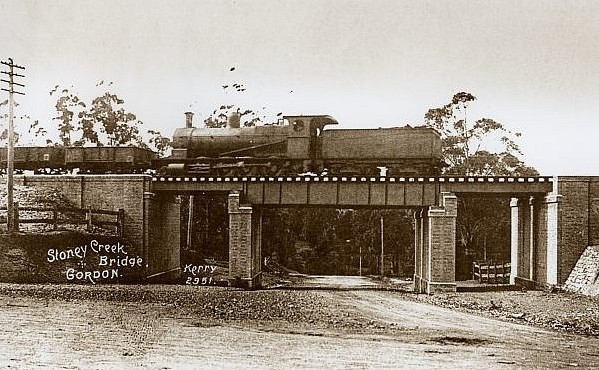
Kerry image, circa 1900
This isn't Mona Vale road but lends insight into how, if a place 'now becoming populated' couldn't get a look in than a place further out wasn't going to have much done either - the railway was it. This road eventually got the go-ahead in 1901 but ran and runs, alongside the Lane Cove river.
THE RYDE TO PITTWATER ROAD.
The desirableness of Governmental action being taken to put the main road from Ryde to Pittwater in proper repair was pressed upon the notice of the Minister for Works yesterday by a deputation from the Ryde and Hunter's-Hill Municipal Council. Replying, Mr. O'Sullivan stated that the report of the departmental engineer was against the work being done by the Government, but he would look carefully into the matter and see what could be done. THE RYDE TO PITTWATER ROAD. (1900, June 8). The Daily Telegraph (Sydney, NSW : 1883 - 1930), p. 3. Retrieved from http://nla.gov.au/nla.news-article237329893
PITTWATER-ROAD.
The need of putting part of the road from the Ryde district to the sea coast at Pittwater into repair was brought under the notice of the Minister for Works yesterday by residents of Ryde and neighbourhood. It was a main road and a military road at one time, and passed through Crown lands, and, with the opening of the bridge over the Lane Cove would have a considerable traffic. The Minister said the report of the officer was against the proposal. He would, in view of their representations, look further into the matter. PITTWATER-ROAD. (1900, June 8). The Australian Star (Sydney, NSW : 1887 - 1909), p. 7. Retrieved from http://nla.gov.au/nla.news-article229378260
THE LANE COVE BRIDGE AND THE FIELD OF MARS TRAM.
(PHOTOS. BY F. LEE, ULTIMO.)
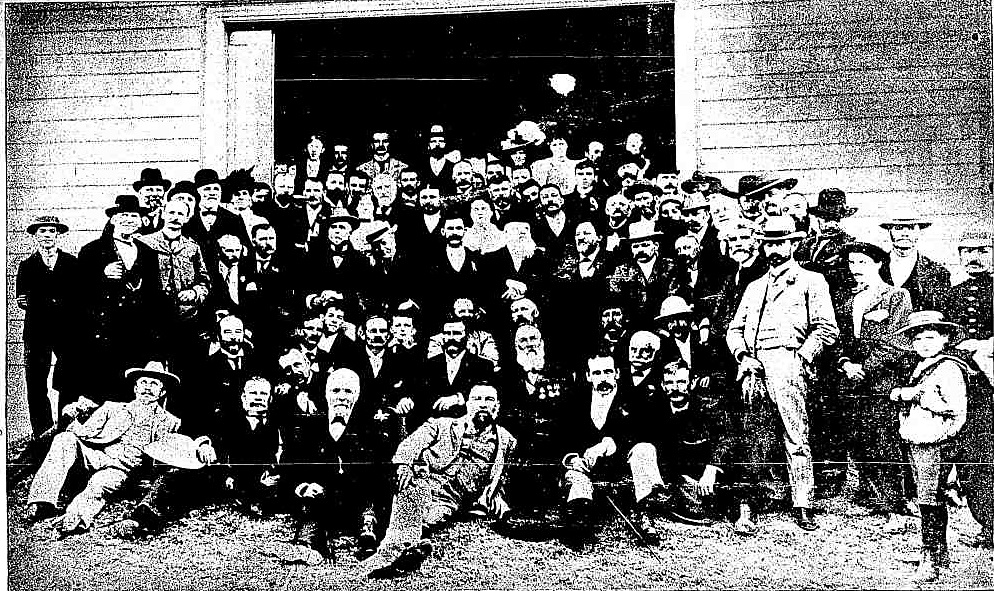
.jpg?timestamp=1535524559603)
THE BRIDGE AT LANE COVE.
Lane Cove Bridge and Field of Mars Tramway.(See illustrations on this and previous page.)
.jpg?timestamp=1535524648706)
NOTICE UNDER REAL PROPERTY ACT.
APPLICATIONS hating been made to bring the lands hereunder described under the provisions of the Heal Property Act, Certificates of Indefeasible Title will issue, unless Caveats be lodged in accordance with the Third Schedule to the said Act, on or before the date named opposite each case respectively.
Property.
No. 11,361. County of Cumberland, parish of Gordon, 9 acres 2 roods 26 ¾ perches, situated near Pymble, adjoining the properties of J. Terrey, — Ashdown, D. Stuart, and T. Brown,—is lot C of a subdivision of lot No. 5 of the Rosedale Estate, and part of 800 acres (portion No. 15 of parish) granted to Daniel Dering Mathew. NOTICE UNDER REAL PROPERTY ACT. (1901, December 13). Government Gazette of the State of New South Wales (Sydney, NSW : 1901 - 2001), p. 9524. Retrieved from http://nla.gov.au/nla.news-article226391586
A fete at Pymble in 1902, attended by well over one thousand people, shows the shift from orchards towards residential areas was already taking place:
OPEN AIR FETE AT PYMBLE, SATURDAY. NOVEMBER 8.
In Aid of the Royal North Shore Hospital.
The people of Pymble, acknowledging the claim of the new northern suburbs hospital for support, decided to organise a fete, the proceeds of which would be handed over to the North Shore Hospital committee to augment the funds of the new building, portion of which is now nearing completion.
A committee, consisting of Dr. O'Reilly (president). Dr. Kottman, Rev. J. Marshall, Rev. Father Kirby, S.J., Messrs. T. H. Jackson, C. M. Buck (treasurer), A. Cooper, F. S. Willis, W. A. Gilder, M. Blake, W. A. Roof, P. Hepworth, and J. G. Hull (hon. secretary) was formed and it was decided that the demonstration should take the form of an open air fete. Every arrangement was made to ensure the success of the movement, and the residents responded liberally.
On Saturday some 1500 people attended the fete, which was held in a large paddock close to the railway station, the formal opening being performed by Mr. Dugald Thomson, M.IL.A, who during the course of a few remarks congratulated the committee upon the excellence of the arrangements, and wished the function every success.
The grounds were gay with bunting, and several tents had been erected, where refreshments, confectionery, flowers, and fancy goods were procurable. Proceedings were enlivened with music supplied by the Police and Fifth Regiment (Scottish Rifles) bands.
The attractions were varied and interesting, all the side shows and other entertainments being well patronised. The children of the Gordon Public school gave a creditable dumb-bell display, and amongst the numerous attractions were maypole dances, woodchipping contests, fancy dress, cricket match, fancy -dress tug-of-war, catching the greasy pig, treacle bun contest, punch and judy shows, Aunt Sally shooting galleries, pony riding, gramophone selection and palmistry. Collecting boxes were carried round, and altogether a good sum was realised. It was, however, unfortunate that shortly before 5 o'clock a heavy thunderstorm passed through the district, the rain causing a great many of the visitors to bent a hasty retreat. The various stalls did good busines, and the function was in every way successful.

Back Row-Reading from Loft to Right : W. A Gilder. A. Cooper. P. Hepworth. Dr. Kottmann. W. A. Roof. T. U. Jackson. C. M. Buck (treasurer). Mc-Keown, Charlton. Front Row : F. S. Willis, Dr. O'Reilly (president). J. G. Bull (secretary). THE COMMITTEE.

FETE AT PYMBLE.— VIEW OF CRICKET GROUND
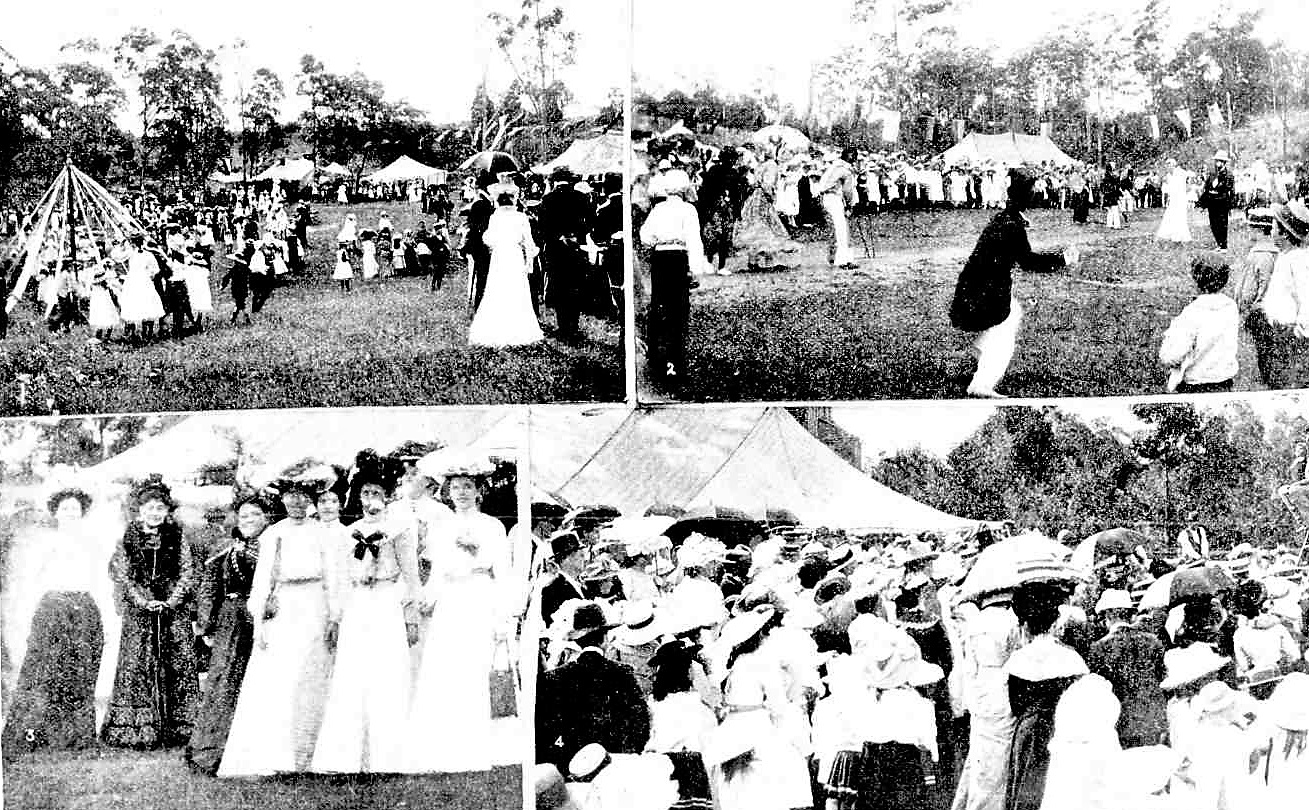
1 Maypole. 2. Fancy Dress Cricket. 3. Some Lady Workers. 4. The Ventriloquist . FETE AT PYMBLE.
OPEN AIR FETE AT PYMBLE, SATURDAY, NOVEMBER 8. (1902, November 12). The Sydney Mail and New South Wales Advertiser (NSW : 1871 - 1912), p. 1253. Retrieved from http://nla.gov.au/nla.news-article165385841
This has Tumbledown dick Hill as being close to Pymble:
MILITARY INTELLIGENCE. MANOUVERS BY THE LANCERS IN THE VICINITY OF NEWPORT.
The Sydney and Parramatta squadrons of the New South Wales Lancers were engaged on Saturday and part of yesterday in some interesting fluid operations in the neighbourhood of Rock Lily and Newport. The parade was also the last of the year.
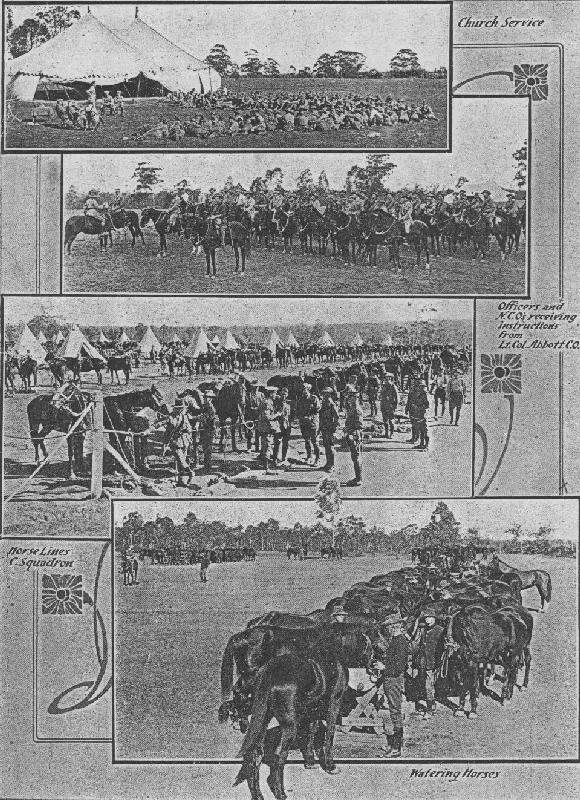 The Sydney squadron, numbering 69, under Captain King, was as supposed to represent the advance party of an enemy which had landed at Bongan Bongan Beach, near the entrance to Broken Bay. The squadron left the city at 8.30 a.m., and bivouacked at 1 p.m. at Narrabeen. The landing party, by arrangement, commenced to make its dispositions at 2 p.m. from the Rock Lily Hotel, and the idea, was that the telegraph lines should be tapped in order to prevent reinforcements of the defending force coming from Hornsby.
The Sydney squadron, numbering 69, under Captain King, was as supposed to represent the advance party of an enemy which had landed at Bongan Bongan Beach, near the entrance to Broken Bay. The squadron left the city at 8.30 a.m., and bivouacked at 1 p.m. at Narrabeen. The landing party, by arrangement, commenced to make its dispositions at 2 p.m. from the Rock Lily Hotel, and the idea, was that the telegraph lines should be tapped in order to prevent reinforcements of the defending force coming from Hornsby.
The Parramatta, squadron of Lancers was ordered to find out the strength of the enemy that had landed at Bongan Bongan Beach. According to the plan of operations the road via the Spit was held to be untenable, so that the detachment had to proceed via Pymble. The Parramatta men mustered 72, and were under the command of Captain Mackenzie. They left Parramatta at 8a.m. and reached Tumble-down Dick, near Pymble, in time for lunch. Lieutenant-Colonel James Burns, officer-commanding, accompanied them, and at Pymble Brigadier-General Finn, Major A. P. Luscombe, D.A. Q.M.G., and Lieutenant Macartney, A.D.C., joined the party with a view to witnessing the manouvres.
A start was made at 2 p.m. from Tumbledown Dick to ascertain the whereabouts of the enemy, and very rough country was encountered, but trooper's and horses got over the ground capitally. The enemy's landing party not having time apparently to achieve its object, its officer-commanding threw out a line of outposts extending from the Rock Lily Hotel to a little point near Newport. Shortly alter 3 p.m. the Parramatta squadron got into touch with the outposts about two miles from the hotel, and after some good work on both sides the evening's advance guard, according to the prearranged plan, was driven back to the reserve near the beach.
Owing to this reverse and the weather becoming thick and stormy the landing party was supposed to be unable to re-embark by boats on board of the cruisers, consequently a position was taken up on Bongan Head. In this phase of the operations, however, the Sydney squadron no longer represented the enemy, but joined the Parramatta men. The enemy's position on Bongan Head was represented by eight canvas targets, which had been erected under the supervision of Major M. Hilliard, D.S.O., and Captain P. C. Timothy. Four of these were located about 500 yards from the main road and the other f our about 900 yards distant, but the ranges were unknown to those who subsequently took part in the firing. It was decided that the attack on this position should be made shortly after daybreak on the following day by the entire body of Lancers representing the home force.
The two squadrons a little after 5 p.m. reached Mr. George Brock's Mona Vale estate, where Captain Timothy had arranged with the owner for the whole force to bivouac for the night. The troops were here joined by Colonel H. D. Mackenzie, A.A.G., Captain J. Purves, and Captain J. S. Brunton, the two latter travelling by motor car. The Lancers band also came down by a coach provided by the officers, who also contributed the commissariat supplies.
The State Commandant addressed the officers and N.C.O's. during the evening, and said that he was well pleased generally with the tactics, intelligence, and conduct of the troops. The men had shown their efficiency as skilled horsemen in very rough country, and he complimented them on their mobility. The outpost work was creditably performed, but at times rather humid. After tea a camp-fire concert was held, in which the band figured conspicuously, and Mr. Brock' rendered valuable assistance. A boxing bout between two amateur champions, Troopers Parbury and R. Baker, proved exciting, as were also some smart singlestick tourneys.
At daybreak yesterday the reveille sounded, and the Lancers at 5.45 a.m. were on the way to attack the enemy's position, indicated by the canvas targets on Bongan Head, forty rounds of ball cartridge were fired per man in the attack, which was at unknown distances. The shooting was good. One target had about 200 hits on it. The weakness of the attack, according to Brigadier-General Finn, lay in the fact that the men were too prone to expose themselves and rush forward in large numbers instead of in twos and threes. These were defects apparent in all sham fights, however, and only corrected by a taste of the " Real thing."
The troops returned to camp at 8.16. After morning "stables " a bathing parade was held, in which nearly every Lancer participated on his horse. Mr. Brock was thanked for his kindness in quartering the forces, and route march was then taken via the Spit for the Sydney Squadron and via Pymble for the Parramatta men. - The Sydney detachment reached the city in the afternoon. MILITARY INTELLIGENCE. (1902, December 15). The Sydney Morning Herald (NSW : 1842 - 1954), p. 9. Retrieved from http://nla.gov.au/nla.news-article14521240
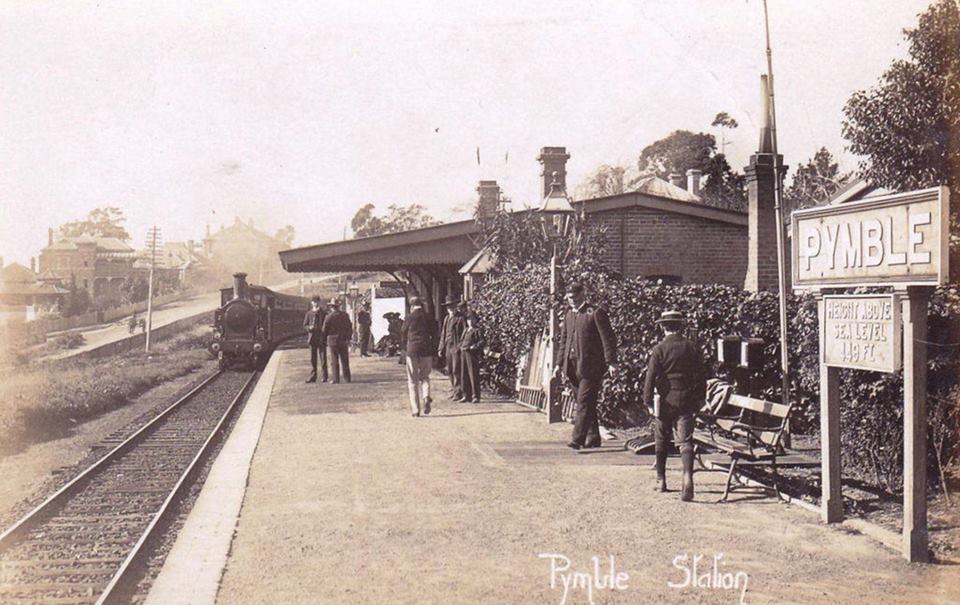
Pymble station circa 1908 The road going along the hill is Grandview.

Lane Cove Road, Turramurra 1908, from album Glass plate negatives of North Shore, Sydney Harbour and general subjects, courtesy State Records of NSW - Also Visit: Roads To Pittwater: The Pittwater Road
Another foray:
MILITARY. LANCERS' STAFF RIDE.
On Monday last the Sydney Squadron of Lancers returned from a three days' staff ride in the vicinity of Pittwater. The work was undertaken on a tactical scheme connected with the landing of an enemy, the whole being under the command and supervision of Lieutenant M'Mahon. Organised as a complete regiment, the squadron left Sydney about 9 a.m. on Saturday, on a rapid march on Bay View, two squadrons travelling via Gordon and Tumbledown Dick Mountain, and two via Manly and Narrabeen, the advanced parties, by means of signalling communication, coming simultaneously into touch with each other in the scrub behind Rocklily. All ranks had duties of a higher nature than their existing rank, particular attention being paid to the issue of written orders, the forwarding of reports, and sketches In the field. Tents were not taken, the intention being to camp in the open, but owing to the wet weather, the men were billeted in one of Mr. Brock, of Mona Vale's, buildings, the 90 horses being picketed in the rear. MILITARY. (1906, October 4). The Sydney Morning Herald(NSW : 1842 - 1954), p. 9. Retrieved from http://nla.gov.au/nla.news-article14828169
And a description of the road during those years:
The Old Gordon-Rocklily Road
The old road to Gordon from Mona Vale is at present in a very bad condition. About twenty years ago it was a fairly good road, but now trees grow in the middle of it. Cart-wheels sometimes sink to the axle. This was a proper Government roadway. It was made by the Government not much over twenty years ago, and it is said that It partly owed its origin to ideas of military strategy. The residents in the vicinity are about to get up a big petition to have it put in good order again. They say it is impossible to drive a vehicle upon it. For five or six miles from Gordon many orchards are seen. The whole distance from Gordon to Mona Vale or Rock Lily is 16 miles. There is an opening here for a line of coaches—or at any rate there will be when settle meat has increased. The road could be easily improved, especially from Station Hill. At Folly Rock 2 1/2 miles from Rock Lily the road is very bad. The Old Gordon- Rocklily-road. (1906, July 21). The Mosman Mail (NSW : 1898 - 1906), p. 2. Retrieved from http://nla.gov.au/nla.news-article247014780
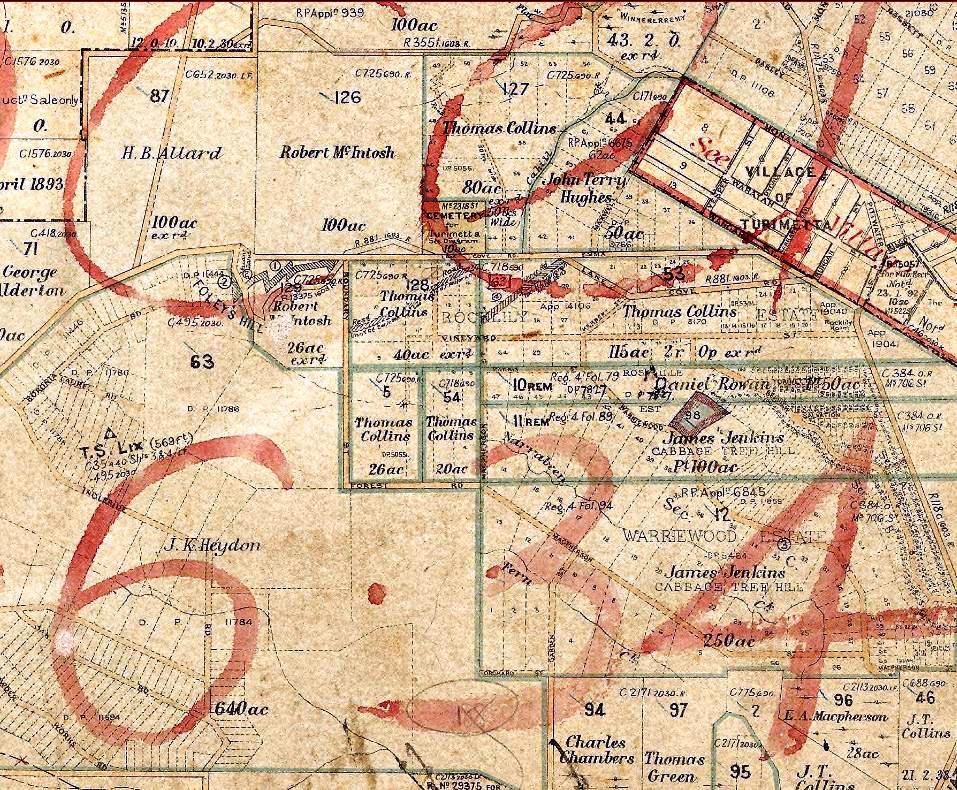
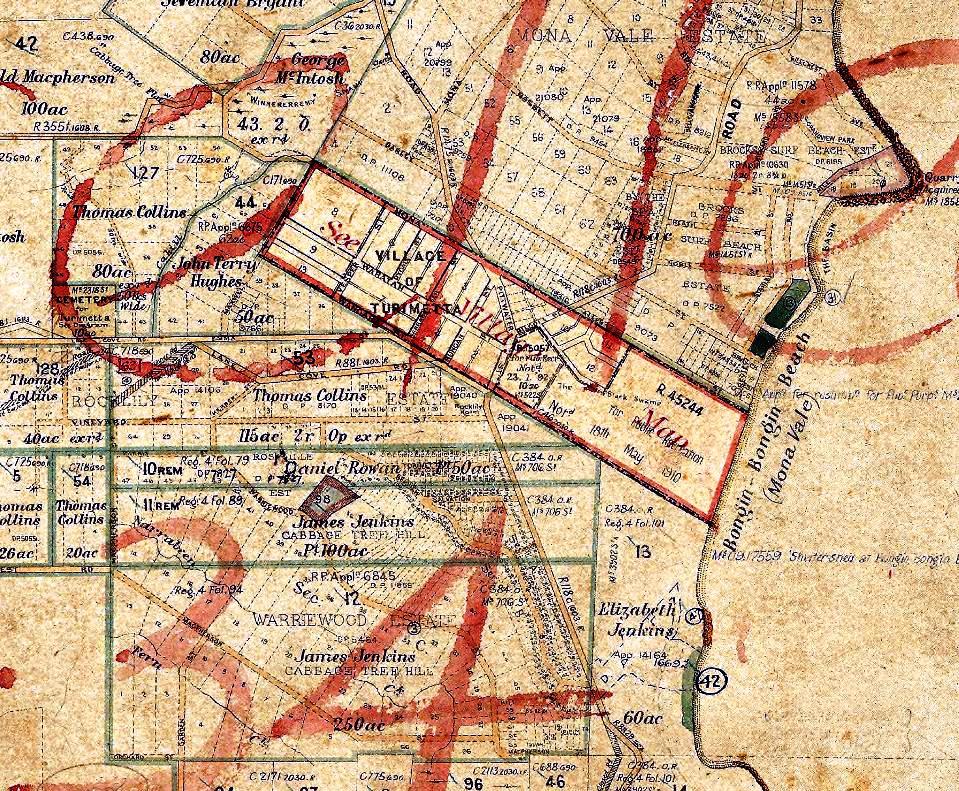
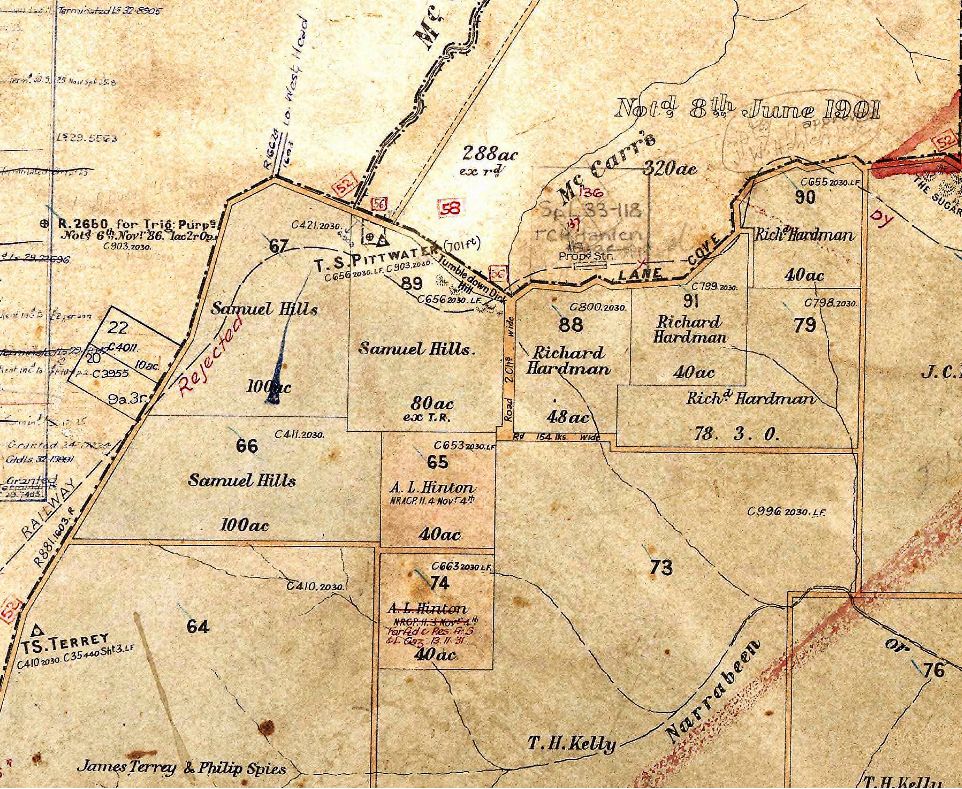
Photo: sections from 1905 Parish Map of Narrabeen showing railway dotted line - that was rejected - and 'The Sugarloaf - this section at Terrey Hills part of map also shows 'James Terrey & Philip Spies' owning section of 640 acres previously held by Obadiah Terrey - Below map was Proclaimed April 22nd 1886:
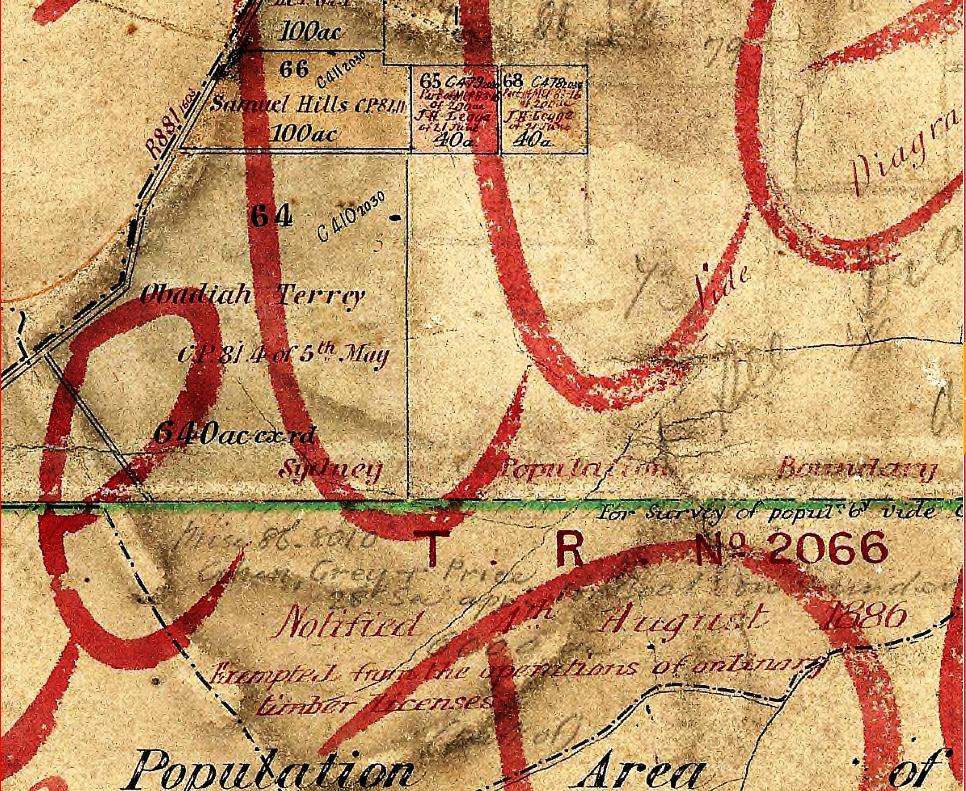
In 1904 the Lane Cove Road (Pacific Highway) to Telegraph road section in St Ives was still called Stoney Creek (MV) Rd, north of Telegraph Rd was still called Pittwater Road. Lane Cove Rd to Woodlands Ave (then Plum St) was in Gordon, Woodlands to Telegraph was Pymble, north of Telegraph was St Ives. The other end, at 'Rock Lily', Taramatta and today's Mona Vale was called the 'Gordon Road'.
With the advent of motor vehicles becoming available in 1904 and 1905 the days of people putting up with dirt tracks were going to come to an end. As more and more people could afford a vehicle, and the advent of motoring bodies such as the N.R.M.A. advocating for better roads where they were in place and the construction of those where they were not, and when this fitted in with 'opening up new areas for residential purposes', the 'road to Lane Cove' was getting closer to actually being that rather than an old bullock track.
A LITTLE KNOWN BEAUTY SPOT.
BY FRANK WALKER.
A little known stretch of country is that lying between the upper portion of the Milson's Point railway line and the district of Rocklily, Newport, Bayview, etc. The track that gives access from Gordon to Rocklily, passing through the rustic village of St. Ives, is known as the Pittwater-road, and has been in existence for some years, in a more or less neglected condition. Now, however, the authorities are bestirring themselves, and though in places there are stretches of deep sand to negotiate, and in others abrupt and dangerous descents, the major portion of the road is suitable for light traffic, and as the surface is further improved, this road will become more and more popular with tourists. There are views from different portions of the route, which for beauty and extensiveness even excel the Blue Mountains. The road passes through great forests, whose delicious coolness, even on the hottest day, is something: to look back upon with delight, whilst from the summits, of the more elevated plateaus the eye takes in an extent of country which to the west presents a succession of rolling hills and isolated mountain peaks as far as the eye can reach, and lo the east, the smiling landscape is bordered by the deep blue of the Pacific Ocean, the gleam of yellow seabeaches, with their silvery line of surf, standing out pure and white against the background of blue. Already the wild flowers art: breaking forth into bloom. The lovely epacris, or native heath, abounds in this region, and in the proper season must fill this well favoured locality with a blaze of glory. The handsome grevillia, or spider plant, with its deep red and silver-grey blossoms, may be found everywhere, and late though the season was when the writer visited this district, myriads of Christmas bells were still in bloom, and the numerous Dilwynnia family, with their variegated flowers of red and yellow, formed oases of colour amongst the grass.
About midway between Gordon and Rocklily the road winds up the side of a high mountain, locally known as 'Tumbledown Dick,' the views from every bend, being superb. Here would be the place for a fine, up-to-date residential hotel, which would be convenient to the city, would be surrounded by charming scenery, and whose inmates would derive the benefit to be obtained from the pure mountain air, without undergoing the preliminary toil and fatigue of a long railway journey. A few hundred pounds spent on the road would, enable a swift motor-car service to be initiated between this locality and Manly, Narrabeen, or Rocklily, and irrespective of the future, when, without doubt, accommodation houses will be built along this route, the whole extent of the road from Gordon to its terminus at Rocklily or Narrabeen would make an ideal tourist route, and amply justify the money spent in making the road fit for traffic. As to the name of this mountain, 'Tumble-down Dick,' it is high time that such nomenclature of beauty spots should be done away with, and as a suggestion the writer would offer the name of 'Mount Cook,' or 'Cook's Plateau,' as a tribute to the great navigator, whose eyes no doubt rested upon this elevated spot in his memorable passage up the coast in the year 1770. The whole of this region to the west is practically unexplored, a greater part of it being bounded by the area known as the Kuring-gai Chase, and it only awaits development, in the shape of good roads, to make of it a desirable place, where the city merchant could establish his country home, and though almost in touch with the metropolis find himself surrounded by all that is health-giving and enchanting in Nature. A LITTLE KNOWN BEAUTY SPOT. (1909, May 19). The Sydney Mail and New South Wales Advertiser (NSW : 1871 - 1912), p. 22. Retrieved from http://nla.gov.au/nla.news-article164292811
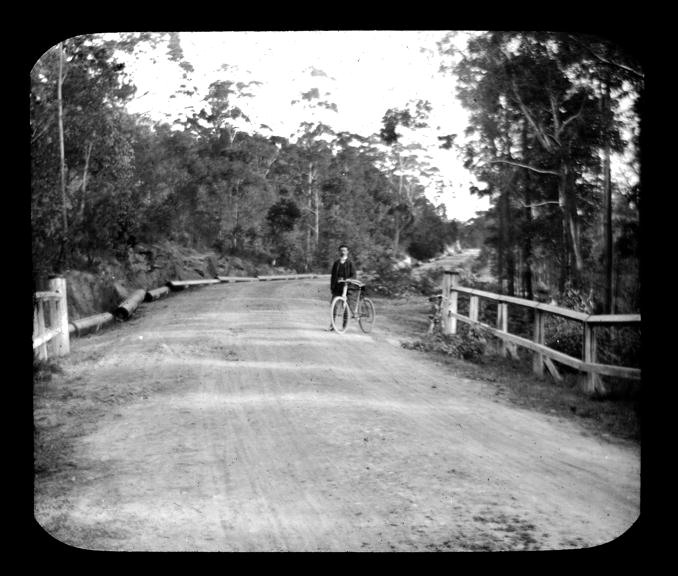
Photo: Stoney Creek Road near Gordon, 19 May 1906 – photo by Frank Walker. RAHS states; Unidentified man with bicycle on Stoney Creek Road, near Gordon. Possibly Frank Walker's cycling companion Richard Rowell. From negative in Mitchell Library Frank Walker Collection ON 150, Item 161 Visit: The New Cycle Path - Manly to Pittwater (1901) in Motor Car Tours To And In Pittwater Show Us The Way This Place Once Was
As seen in Roads To Pittwater: The Pittwater Road, in 1906 the "Local Government Act 1906 No 56" and "Local Government Extension Act, 1906 No 40" the responsibility for roads was devolved to local government under the new Local Government Act, which came into operation on 1 January 1907. The Act also increased the number of local government authorities by compulsorily incorporating many rural areas as shires. However, the Public Works Department remained the main construction authority. On 30 June 1906, the Public Works Department cared for 48,311 miles (77,749 km) of roads. Roads Trusts cared for 195 miles (313.8 km). A total of 1,338 miles (2.153.3 km) was controlled by local government with government subsidies. An additional 8,300 miles (13,357.6 km) of municipal roads received no subsidy.
This meant the newly formed Warringah Shire Council became responsible for the Mona Vale and Ingleside end of what we today call 'Mona Vale Road' although then, and for a while longer, it would remain in name as the 'Gordon Road' simply because it was still the road to Gordon.
Several examples of Warringah Shire Council seeking tenders for the work to improve and even build this road from the Mona Vale end are throughout that council's records:
13th December 1907; it was decided to call for fresh tenders for the clearing of Gordon road from west end of Mona Vale Cemetery to Larkins. ('Larkins' was the Waratah Farm, near and comprising the former Ingleside Powder Works)
WARRINGAH. At a meeting of the Warringah Shire Council the clerk presented a statement showing a credit balance of £538 He stated that although the ordinances and regulations were somewhat intricate, they proved it valuable assistance to him in his work Contracts were lot for the supply of 300 yards of metal, and for the clearing and forming of part of Gordon road, to Messrs. Oliver and Whitney respectively. WARRINGAH. (1907, July 17). The Sydney Morning Herald (NSW : 1842 - 1954), p. 7. Retrieved from http://nla.gov.au/nla.news-article14834033
5th June 1908; C. Harrington asking for work on the Gordon Road Mona Vale
IN THE SHIRES. — WARRINGAH
At the last meeting of the Warringah Council, C.» M'Intosh moved:— "That application be made to the Minister for Lands to re-name Manly and Curl Curl Lagoons, as their present names are not in keeping with their positions.:' The mover Adopted a suggestion that the motion stand overs to allow, him to suggest suitable names. . . Cr. M'lntosh moved and Cr. Ralston seconded— "That this council take the necessary steps under section 120, to secure by resumption or appropriation, about three chains of land lying between the Pittwater-road and Nicolson-street. The resumed area to be for a road of access for quarry and other purposes." It was decided to first ask the landowners in the benefited area to contribute to the cost of the undertaking. Cr. M'lntosh moved, and Cr. Powell seconded— (a) "That the engineer prepare an estimate of the cost of forming and ballasting 30 chains ot the Fish-road, Dee-why." (b) "As the above road gives direct access to large areas of Crown lands, which will shortly be made available by auction sale, application be made to the Governor to declare the making of the above road a national work, as. provided for in section 137, L.G. Act, and to pay to the council such proportion of the cost of the work as may be agreed upon between the Minister and the council. Carried unanimously. As the successful tenderer for the Gordon-road work (Mr. Hill) declined to take up the contracts, they were given to the next Jowett— Devlin and Erickson. £100/10/; and G. Riddle, £108/15/. The consideration of tenders for metal for the Beacon-hill was allowed to stand over until the next meeting. IN THE SHIRES. (1909, September 6). The Daily Telegraph (Sydney, NSW : 1883 - 1930), p. 11. Retrieved from http://nla.gov.au/nla.news-article238323050
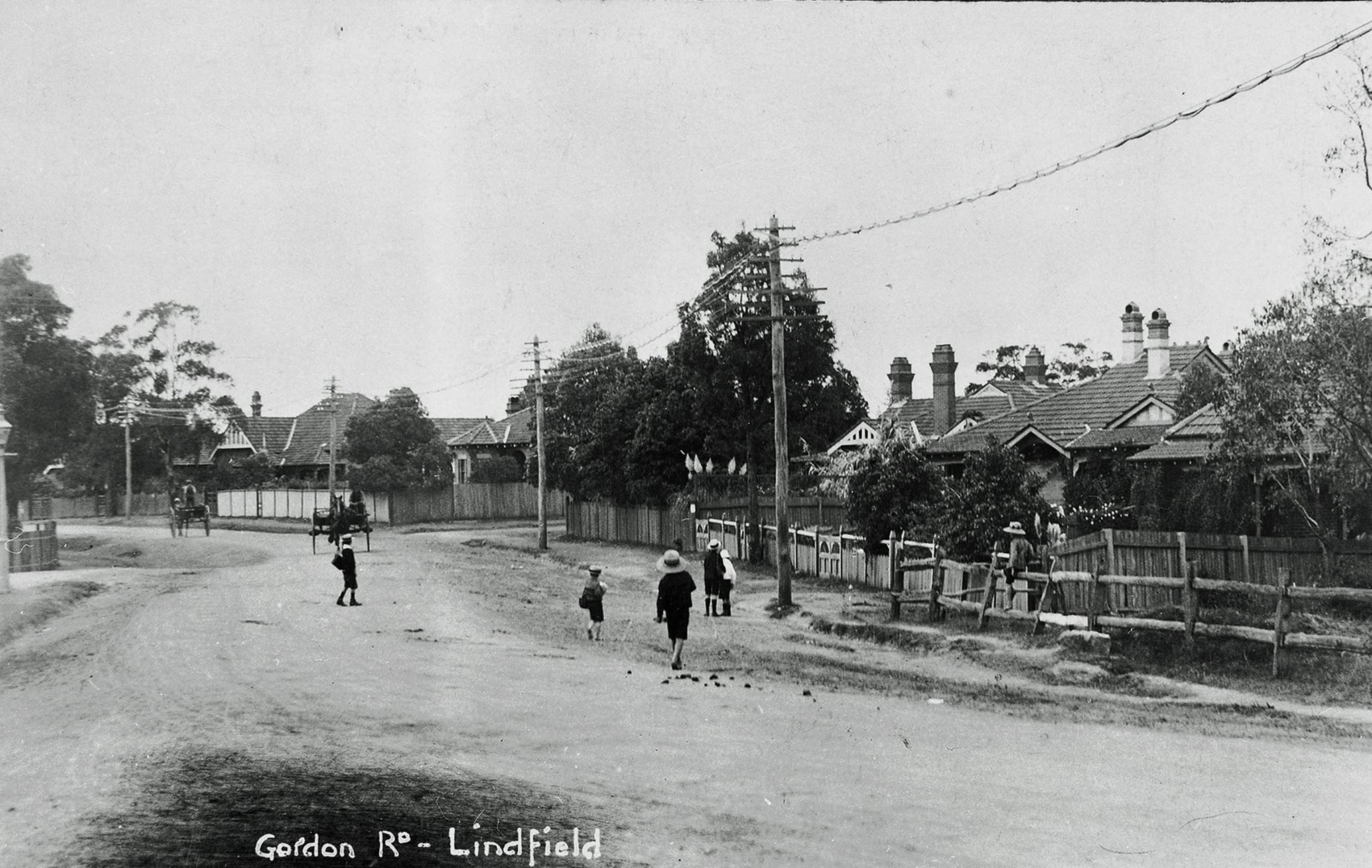
Gordon Rd, Lindfield ca.1910. Taken on Gordon Road (now known as the Pacific Highway) looking North with Strickland Avenue on the right. Courtesy State Records of NSW
March 1911 Warringah Shire Council Records show improvements had ben made, although there was still criticism on how good these were:
WARRINGAH SHIRE COUNCIL: the president's minute.
At the last meeting of the Warrningah Shire Council, the president (Cr. Quirk) submitted his annual minute. The finances of the shire were in a very sound condition, the total income amounting to £8391,. as against £5552 for the previous year. As the outlook was most promising, the current year would probably give a corresponding increase. Surf bathing was one of the shire a principal assets, and the pastime had received every attention from the council, accommodation being established at Newport and Narrabeen during the year. Towards the expenditure on the new enclosures the Government department had contributed £ for £, while the local residents subscribed one-third of the amount.
The roads throughout the shire had been improved considerably. The principal amount spent was on Gordon-road, viz., £500. That thoroughfare was being made trafficable for the purpose of providing a new and direct route to the seaside for northern suburbs residents.
An excellent business transaction resulted in the handing over of the whole of the Newport beach frontage— about six acres— to the shire. The transfer was effected through the payment of £150 by the Lands Department.
The extension of the tram to Brookvale was most satisfactory, and made all tlie more pleasing by reason of the Minister's promise for an ultimate extension to Narrabeen. During the year 130 new dwellings had been erected within the area. Turimetta Reserve had been improved, and a splendid site secured for the Brookvale Park. Queenscliff and Freshwater had been lighted for the first time, the water supply of those places being also carried out by means of mains from Manly. The health of the shire was good, not one case of infectious disease having occurred during the year. Cr. Quirk hoped for the continued success of the council under the new presidency of Cr. Ralston. WARRINGAH SHIRE COUNCIL (1911, March 1). The Daily Telegraph (Sydney, NSW : 1883 - 1930), p. 13. Retrieved from http://nla.gov.au/nla.news-article238718474
Mr. Joe Pearson, who travelled, over the road from Rocklily to St. Ives a few days ago, says that the road is being Improved, but It will be some time before It Is in a good condition. At any time the best way to travel would be from St. Ives to Rocklily as the grades Ii places are some-what severe, there being a rise up Foley’s Hill of 600ft. In three miles, when there is a fall of about 100ft in the next mile, after which the ascent of 'Tumbledown Dick' Is made, 250ft being the rise In a little over one mile. As several sandy patches are met on the Journey, they make the ascent rather severe, but by going the way recommended they should not be so troublesome. It Is a pity that greater efforts are not made to make the road, better, as some of the views from various parts are charming. In fact there are not many better around Sydney. CYCLING AND MOTORING. (1911, June 8). Evening News (Sydney, NSW : 1869 - 1931), p. 2. Retrieved from http://nla.gov.au/nla.news-article114138913
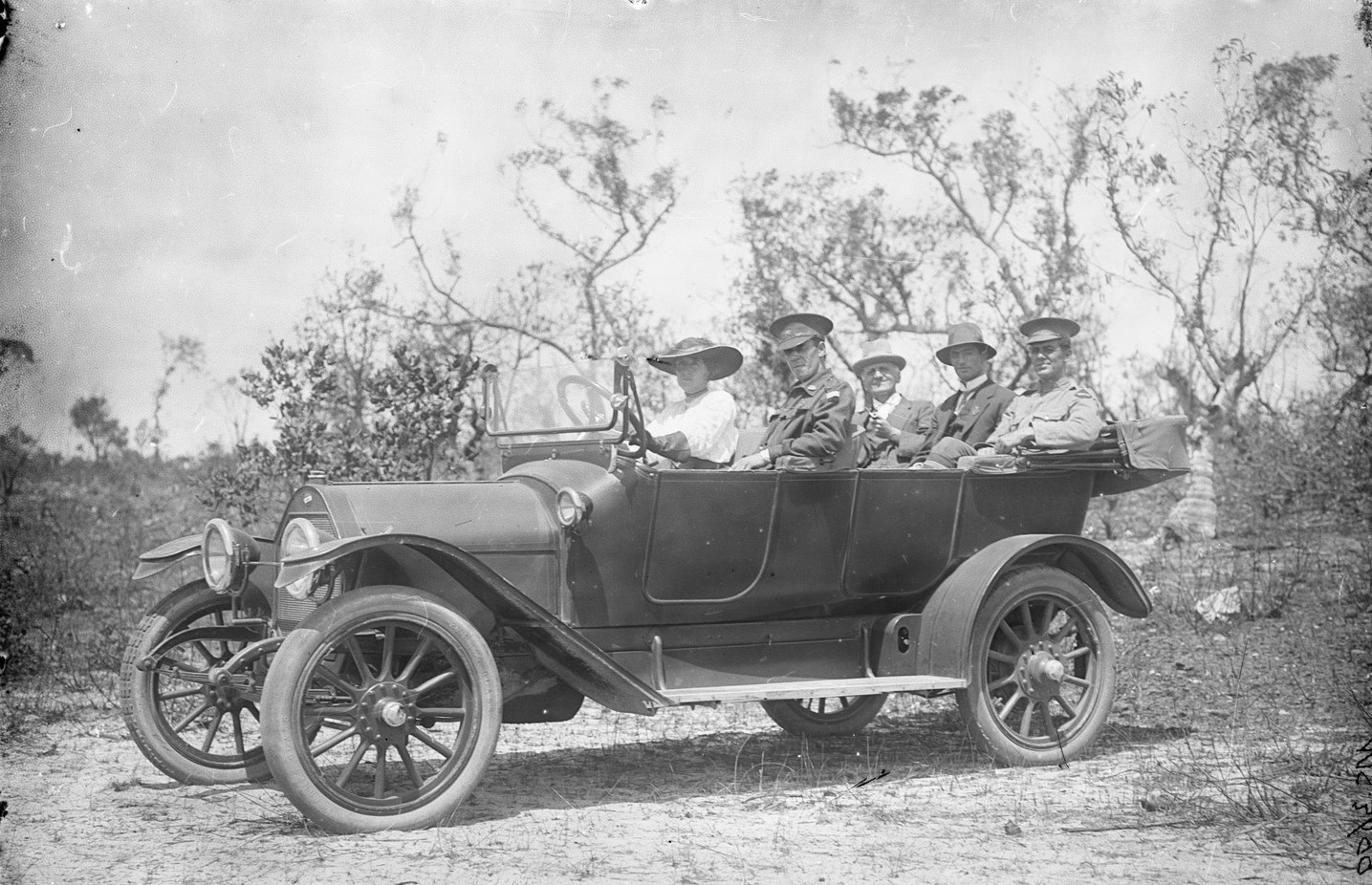

Above and Below: Panorama of Mona Vale, New South Wales, ca. 1930 [picture] / EB Studios National Library of Australia PIC P865/125 circa between 1917 and 1946] and sections from made larger to show detail.
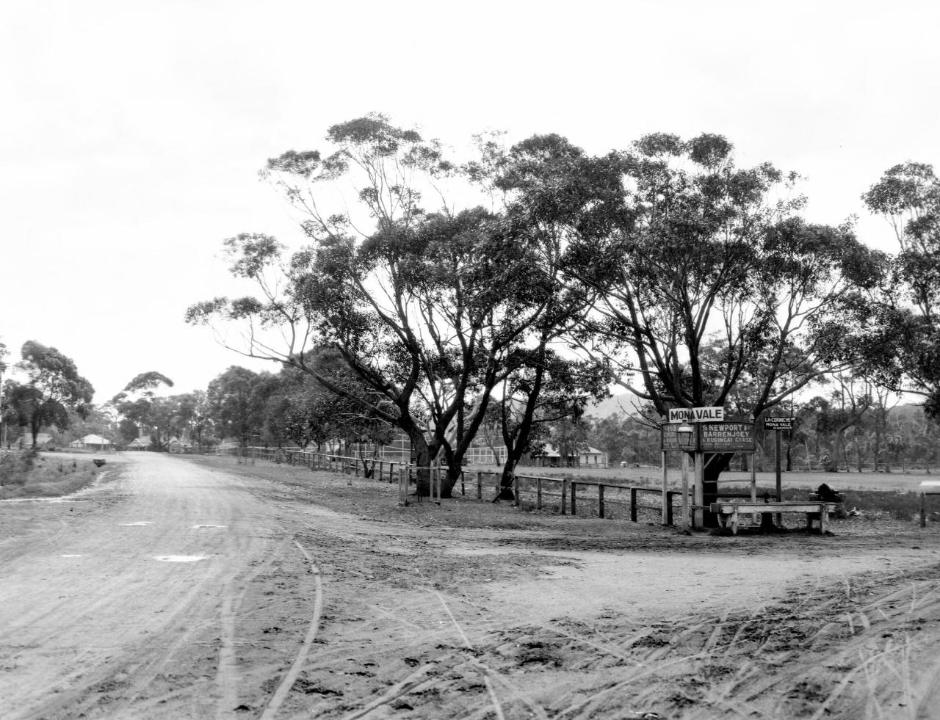
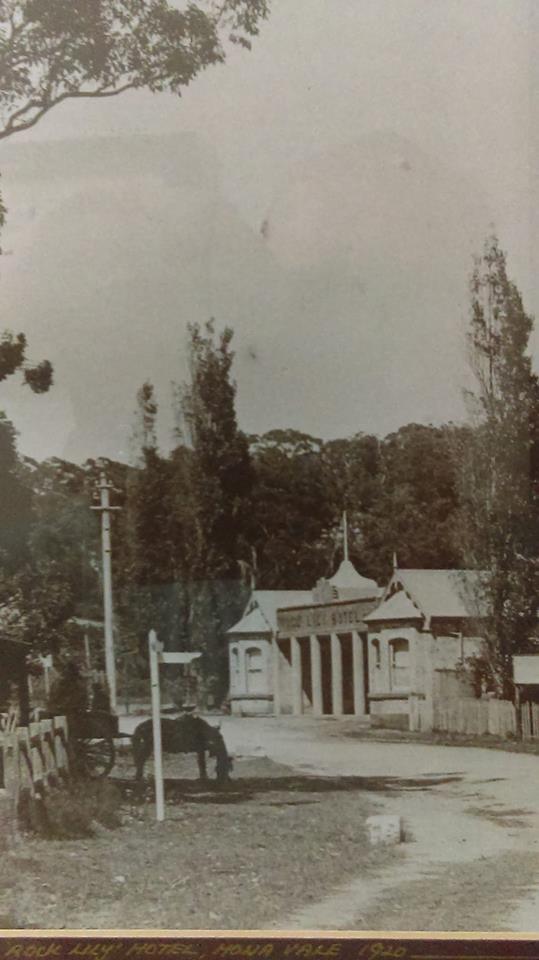
GROWTH SINCE FEDERATION
Sydney. Saturday.
When Australia federated in 1901 the population was 1.776,000. To-day it is nearly 6,000.000. The Federal Parliament has to date passed 4000 Acts. AUSTRALIA'S POPULATION (1926, January 2). Barrier Miner (Broken Hill, NSW : 1888 - 1954), p. 1. Retrieved from http://nla.gov.au/nla.news-article45921343
POPULATION OF N.S.W,
2.300,000 AT END OF 1925
Sydney, Friday.
Mr. H. A. Smith, Government Statistician, in his annual report, states that at the end of 1925 the population of New South Wales was 2.300.000. The proportion of males to females was 104 to 109. POPULATION OF N.S.W. (1926, October 29). Barrier Miner (Broken Hill, NSW : 1888 - 1954), p. 1. Retrieved from http://nla.gov.au/nla.news-article45952583
Many of these road reports came from the N.R.M.A.:
STATE OF THE ROADS
FOR WEEK-ENDERS ROADS ROUND SYDNEY WATTAMOLLA AND GARIE
FURTHER improvements in the condition of some of the more popular motoring routes around Sydney and within easy distance of the city are recorded in this week's N.R.M.A road bulletin, which has been prepared for the benefit of motorists contemplating week-end trips.
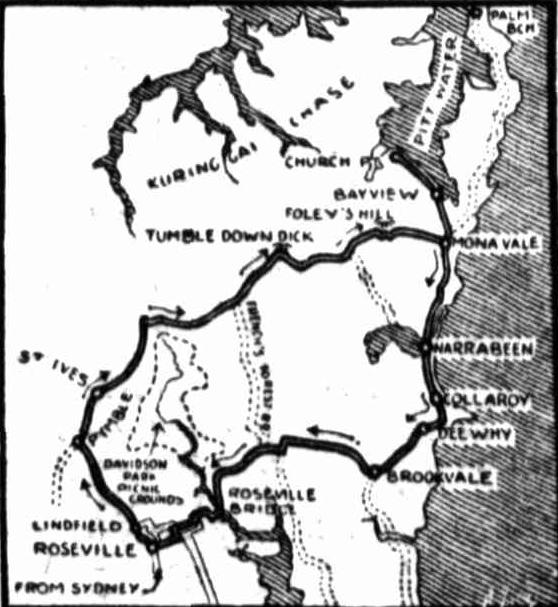 Some of the most delightful motor tours around Sydney are quite close at hand. Of course, for the motorist who can spare a couple of days there are beautiful trips to be made north, south and west, but they are beyond the reach of the average man. He wants somewhere that will allow him to get along at an easy pace, have time to linger by the roadside, admire the view, boil a billy or even, perhaps have a little sleep beneath the shade of a tall gum. One of the prettiest and handiest runs for a Sunday afternoon is that which takes in French's Forest, with all its wealth of flowers, with its occasional glimpses of the sea — and which gives also a taste of the salt air about Narrabeen, Mona Vale and Brookvale. There are picnic places galore — communal camping grounds and secluded spots where one will not be disturbed. The best route to follow is that which starts from the Gordon-road, at Pymble.
Some of the most delightful motor tours around Sydney are quite close at hand. Of course, for the motorist who can spare a couple of days there are beautiful trips to be made north, south and west, but they are beyond the reach of the average man. He wants somewhere that will allow him to get along at an easy pace, have time to linger by the roadside, admire the view, boil a billy or even, perhaps have a little sleep beneath the shade of a tall gum. One of the prettiest and handiest runs for a Sunday afternoon is that which takes in French's Forest, with all its wealth of flowers, with its occasional glimpses of the sea — and which gives also a taste of the salt air about Narrabeen, Mona Vale and Brookvale. There are picnic places galore — communal camping grounds and secluded spots where one will not be disturbed. The best route to follow is that which starts from the Gordon-road, at Pymble. 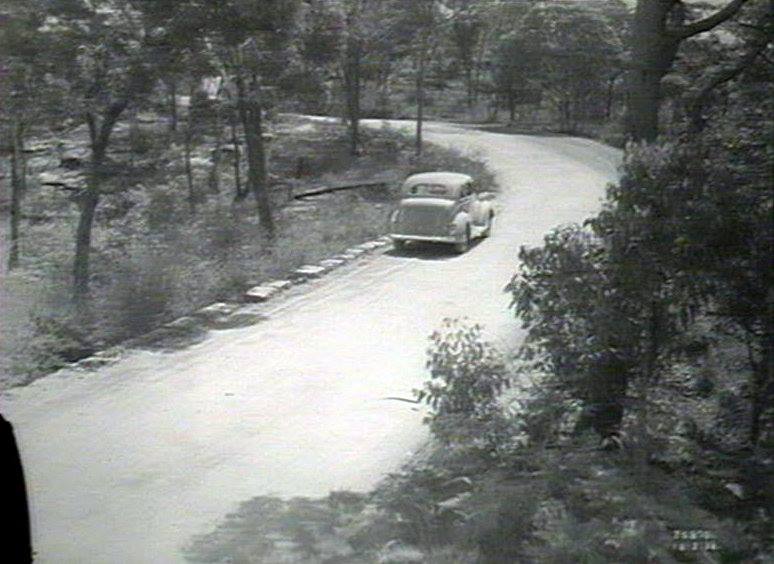
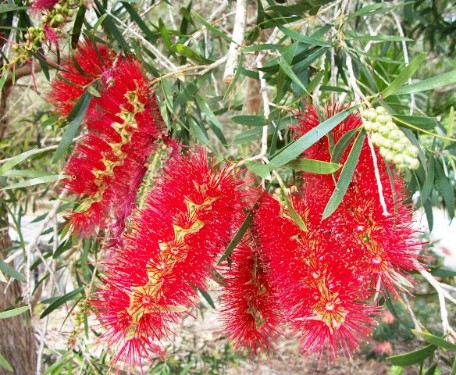 MEMORIAL AVENUE.
MEMORIAL AVENUE.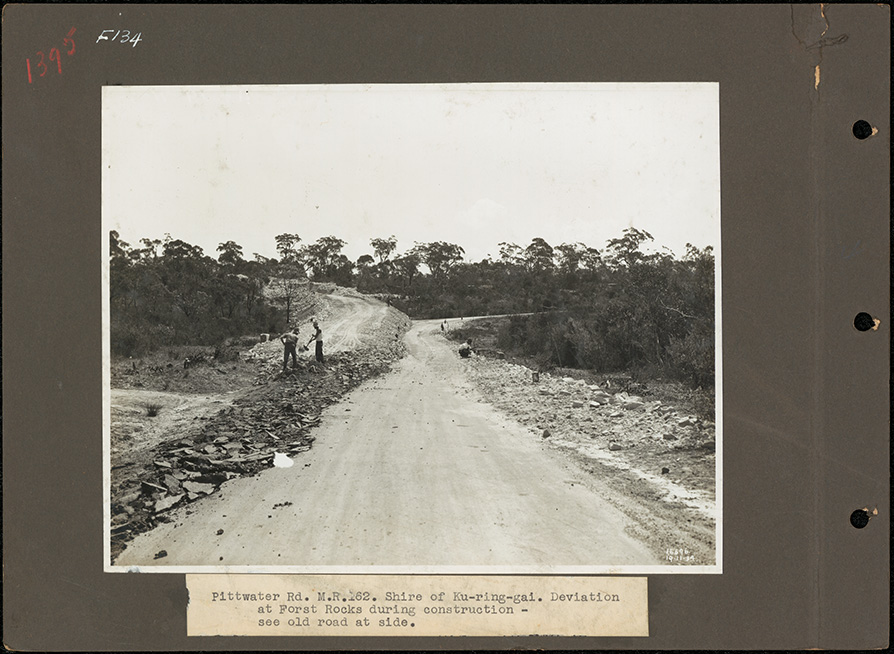
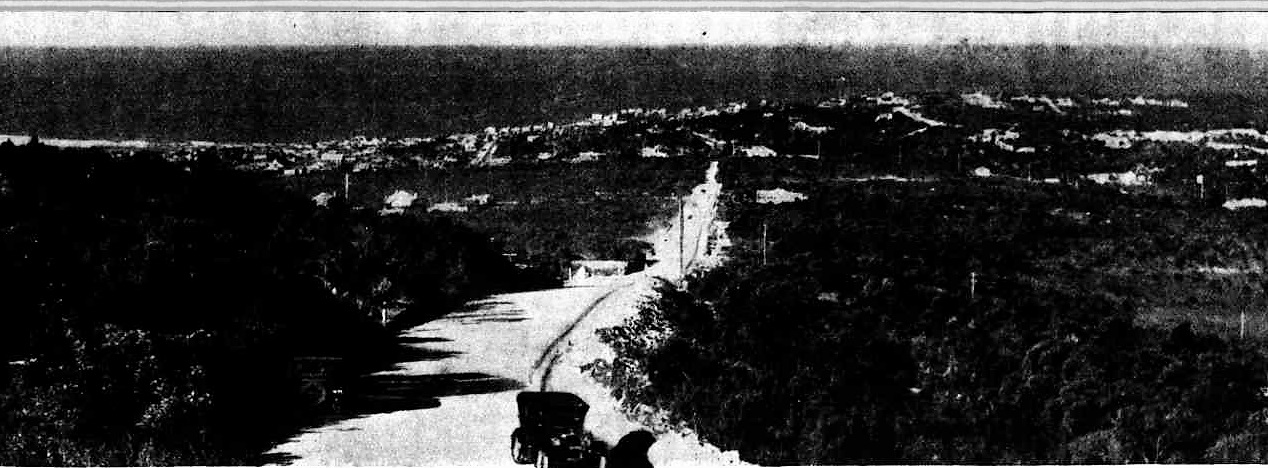
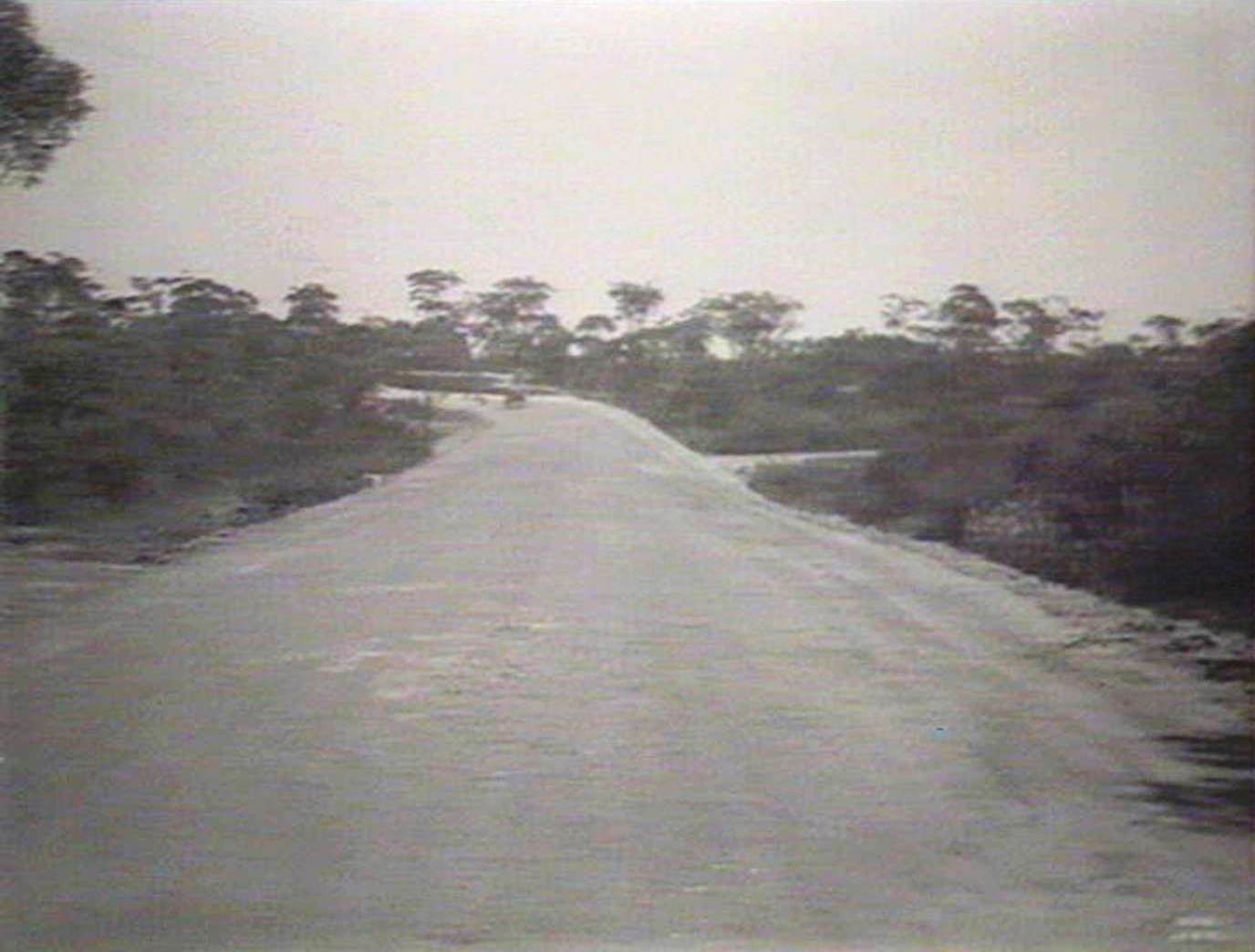
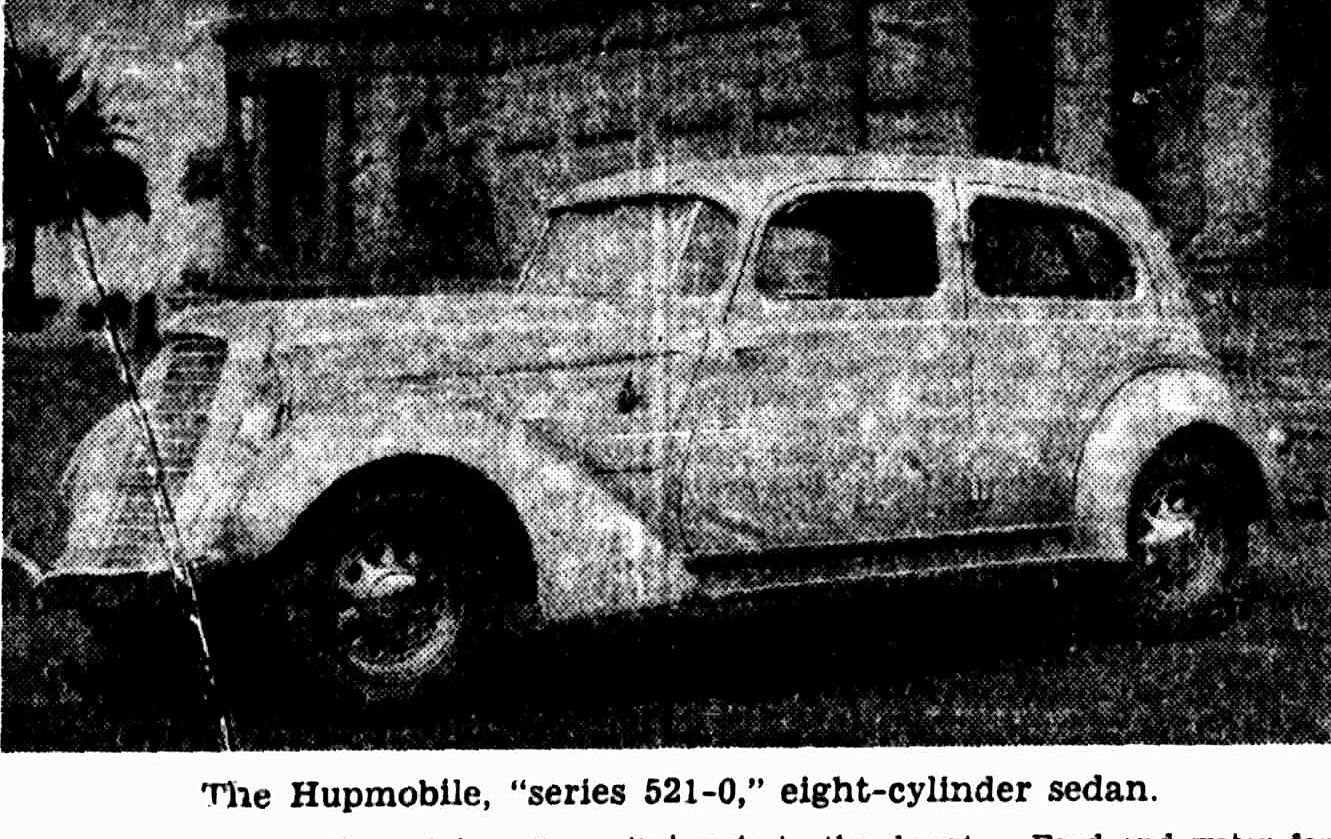


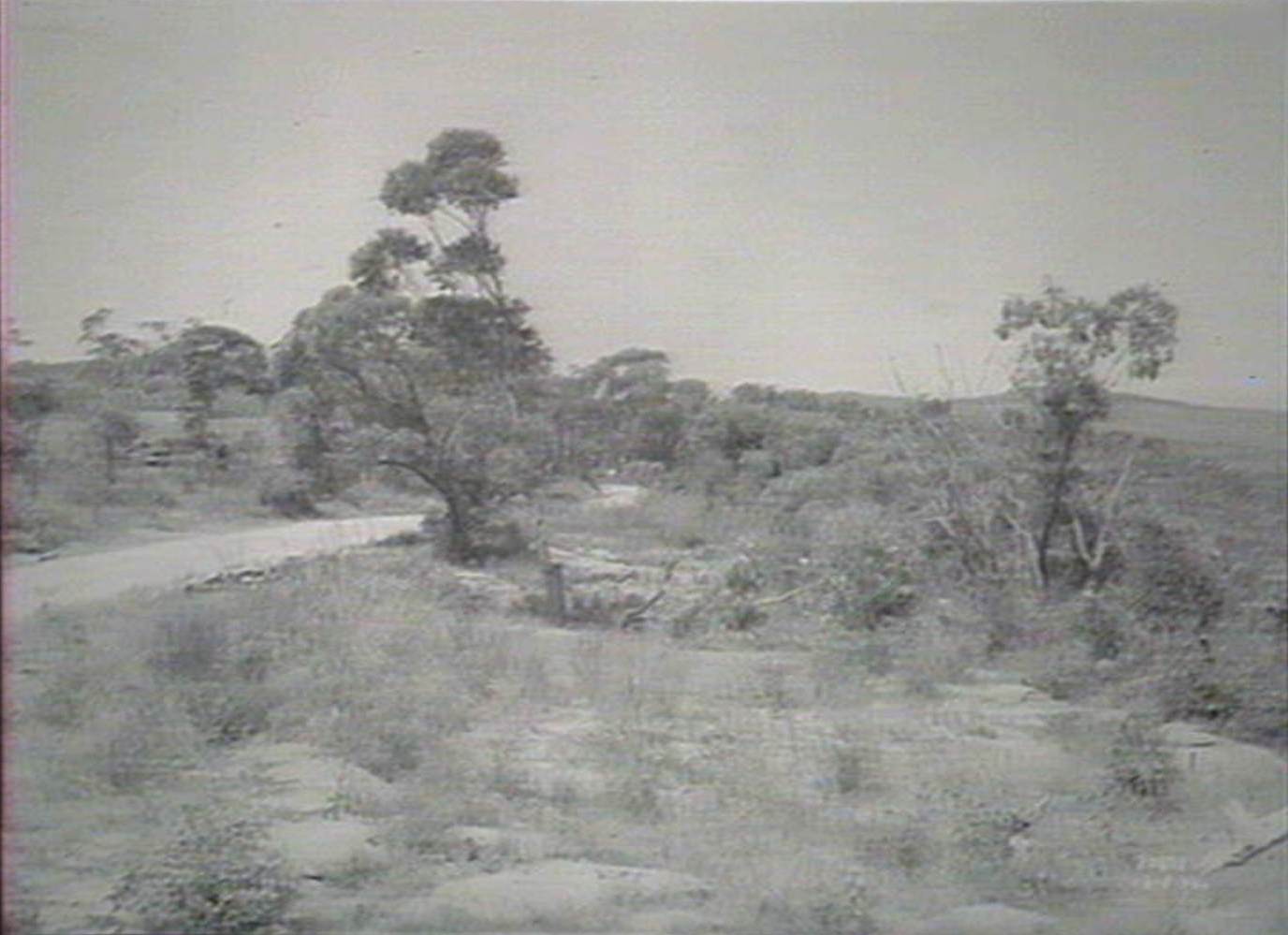
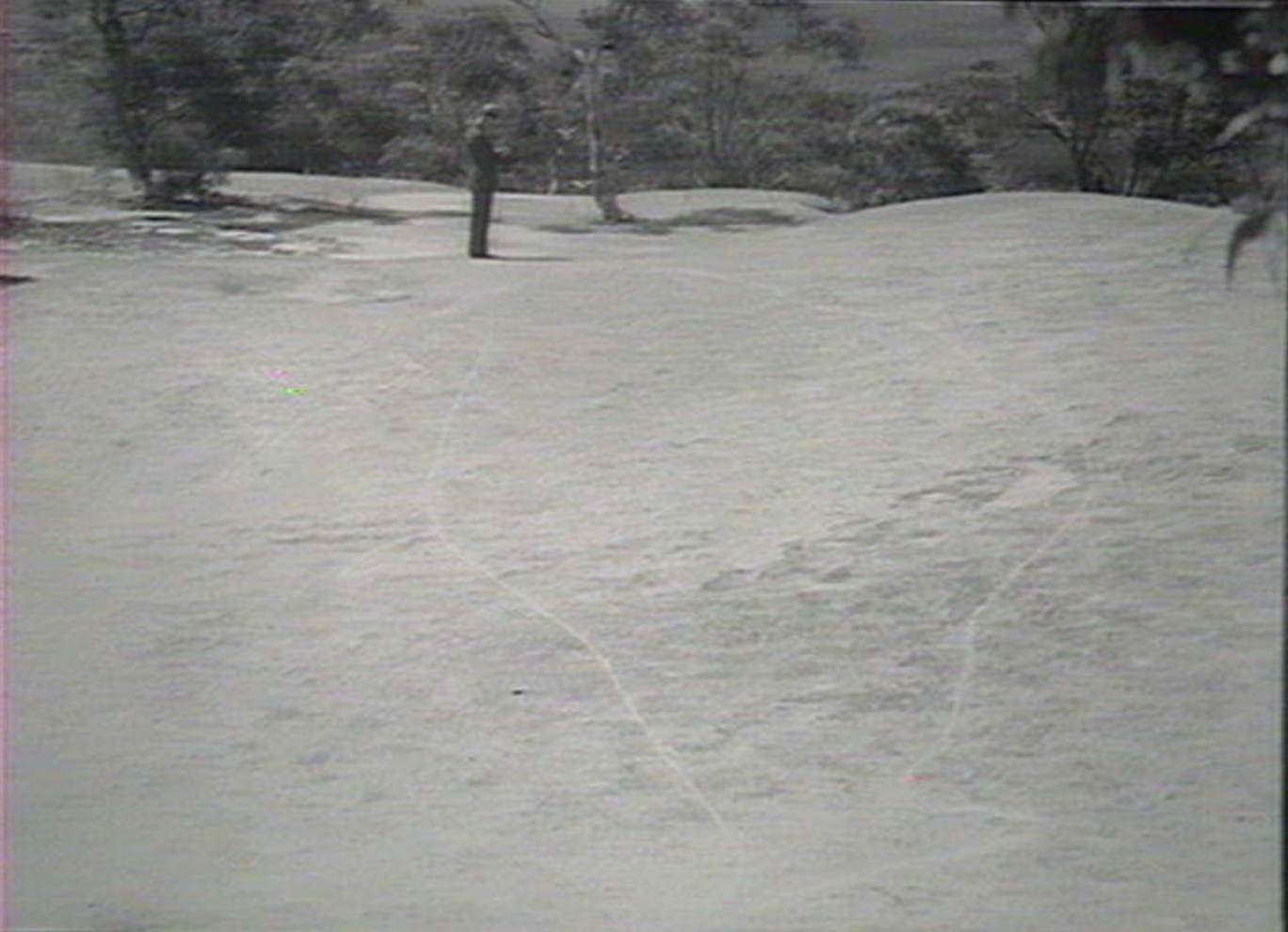
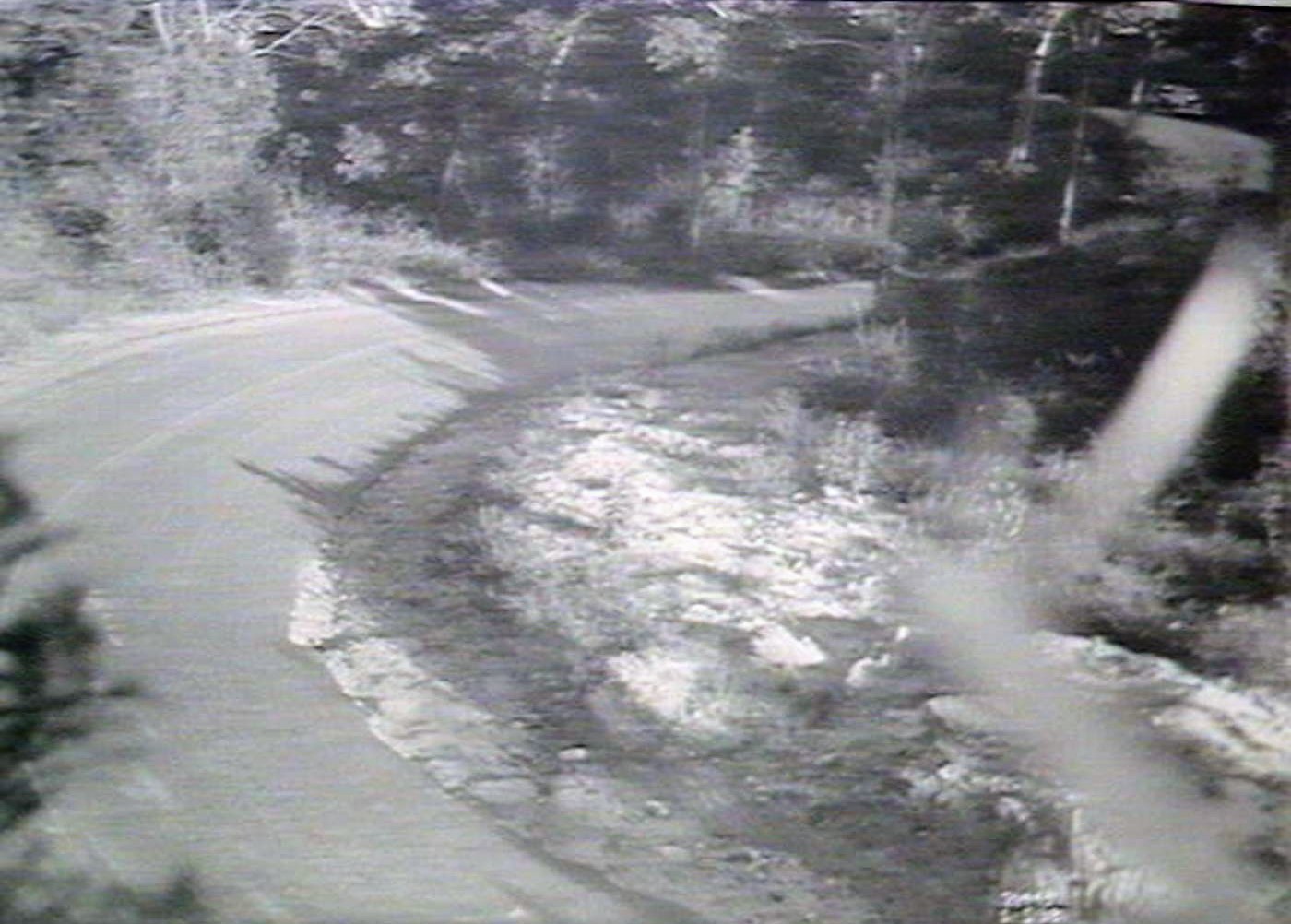
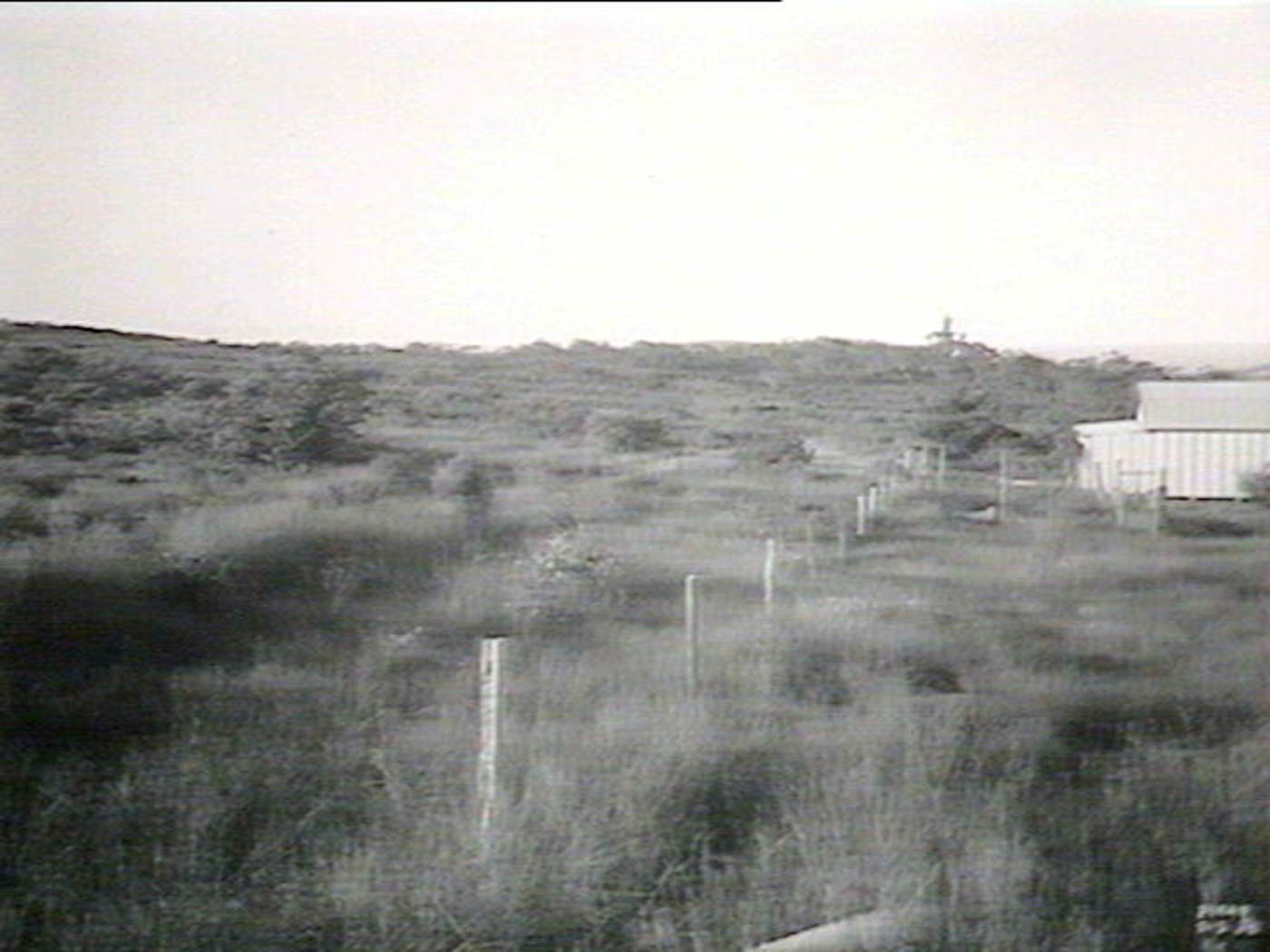

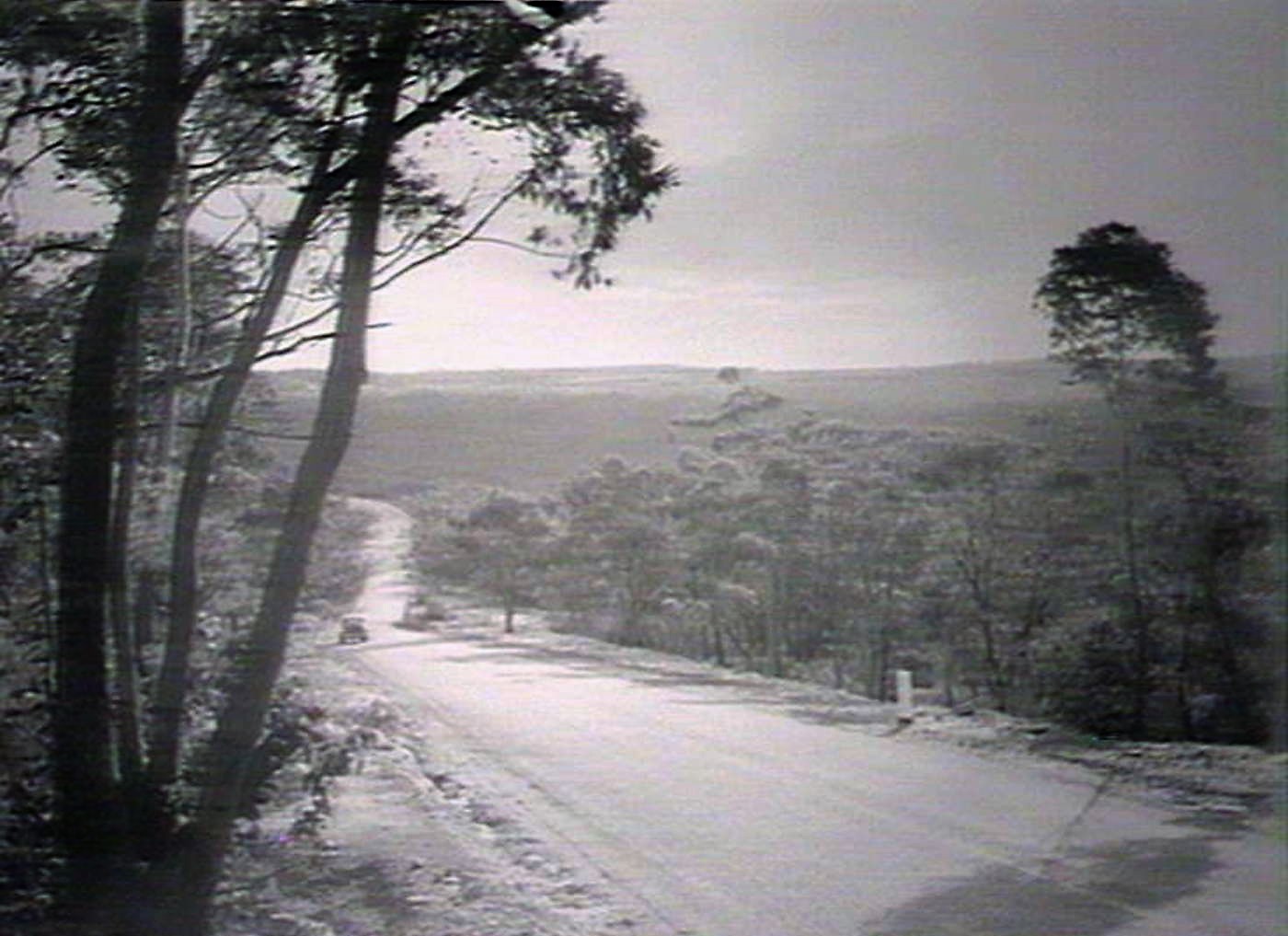
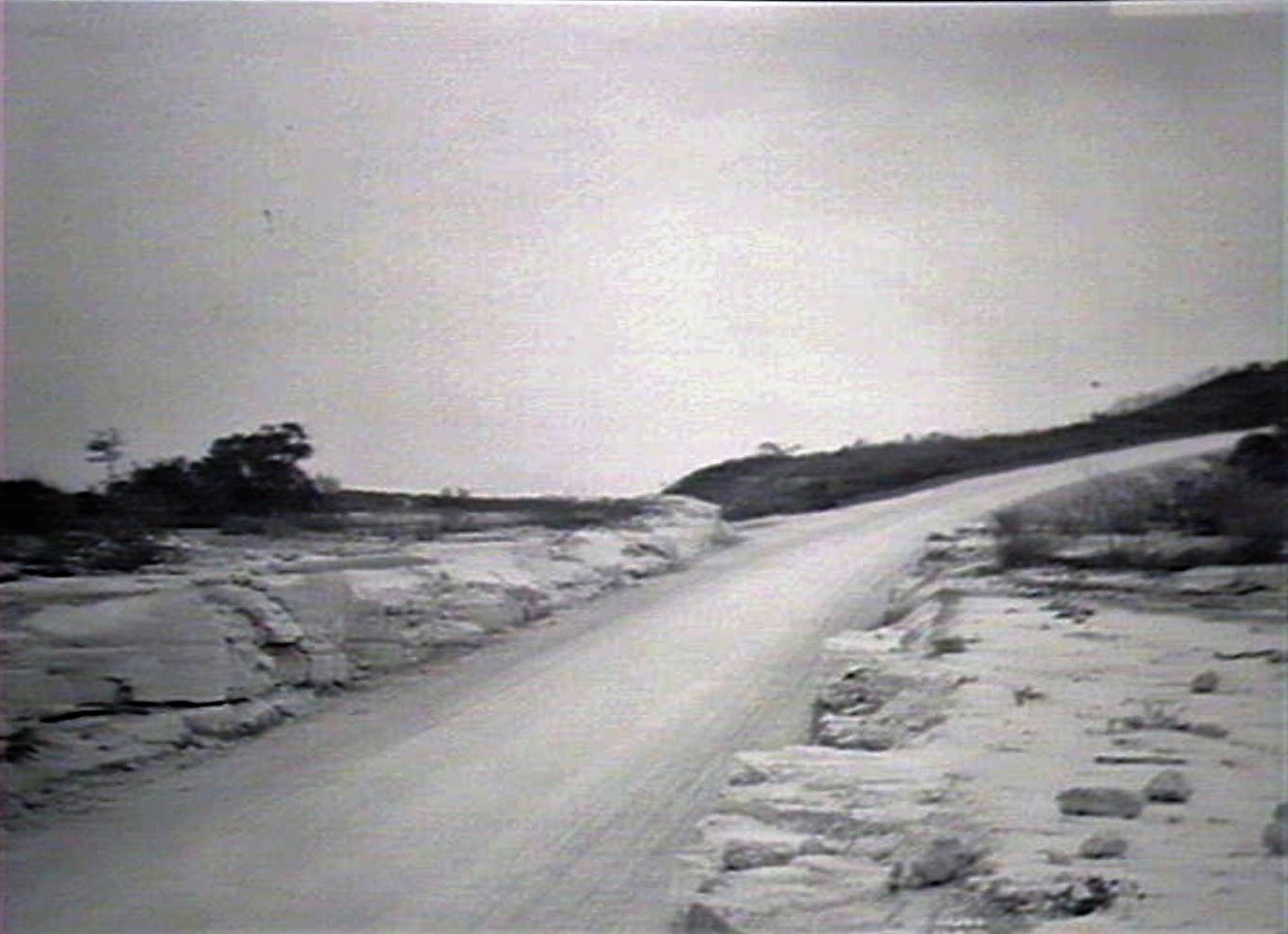
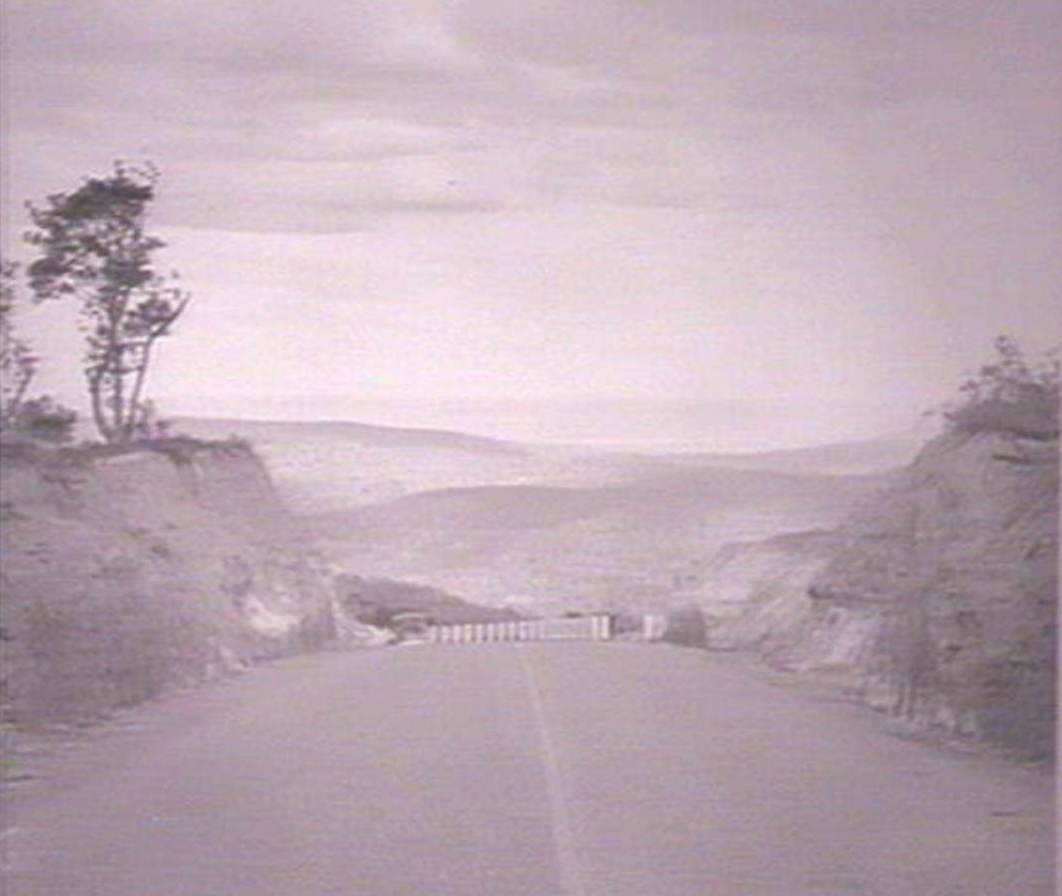
Mona Vale: looking E from top of Tumble Down Dick Hill. Date: August 1939. Government Printing Office 1 - 27008, courtesy the State Library of NSW.
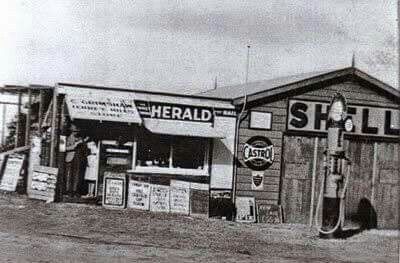
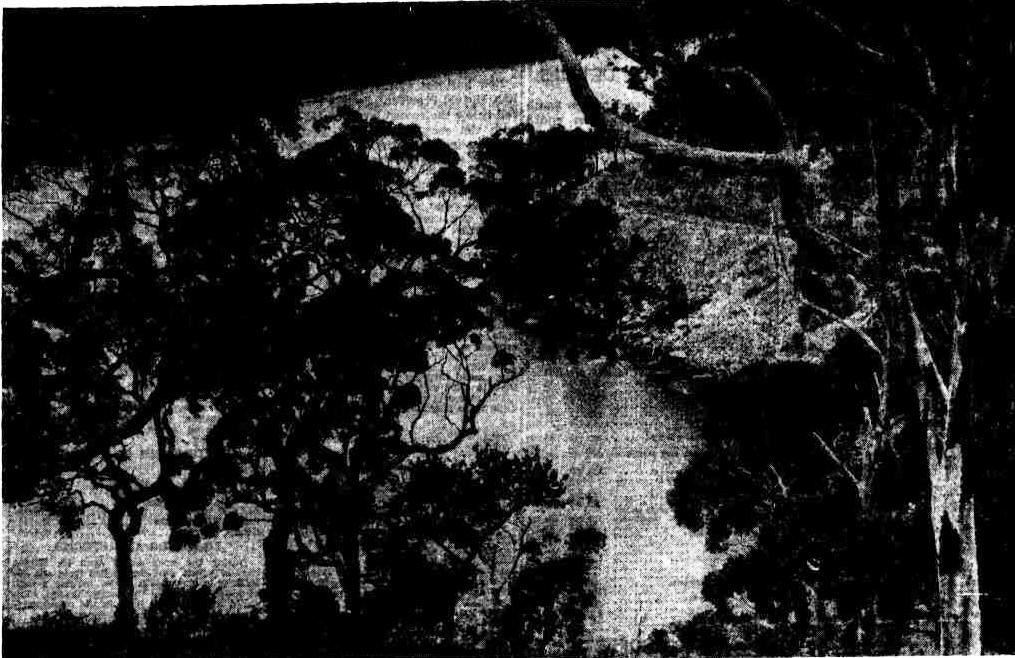
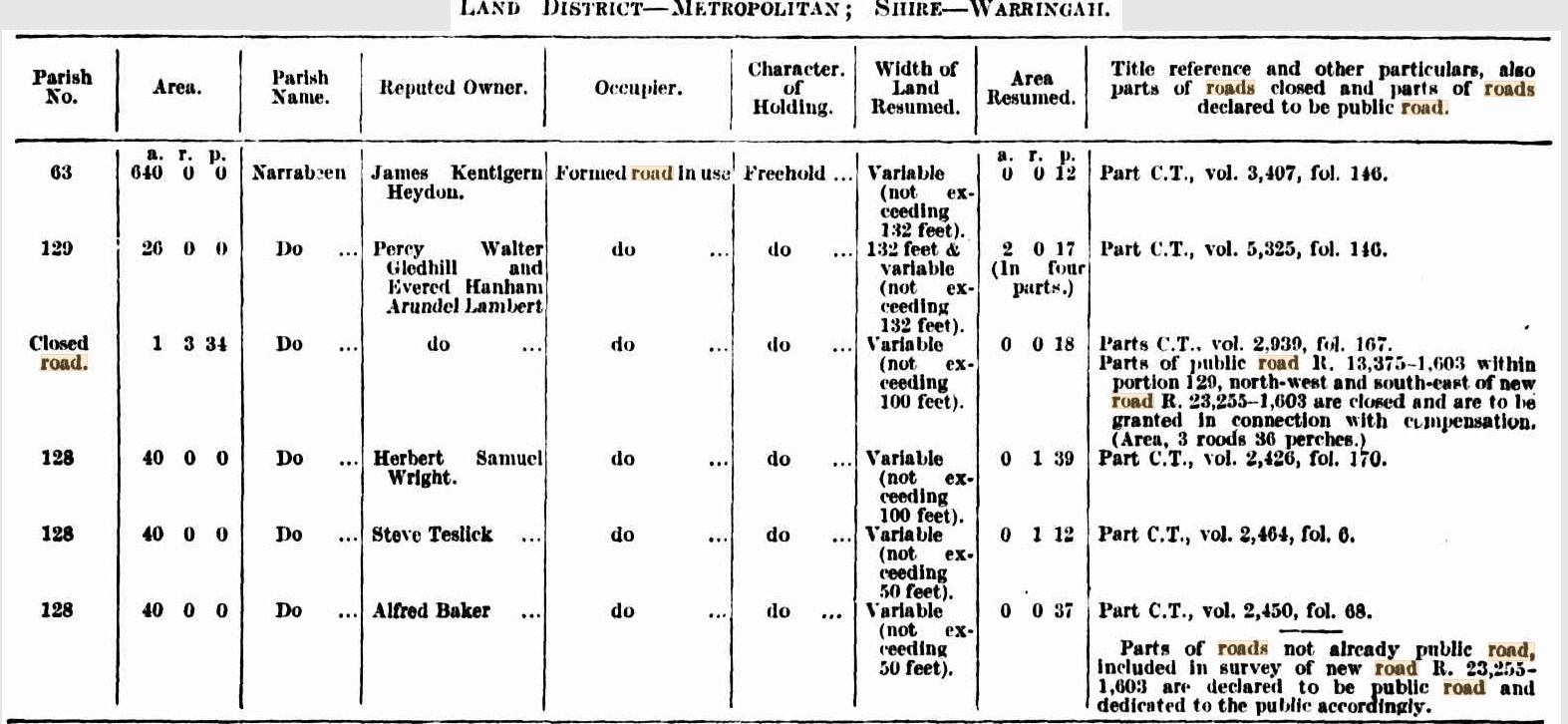
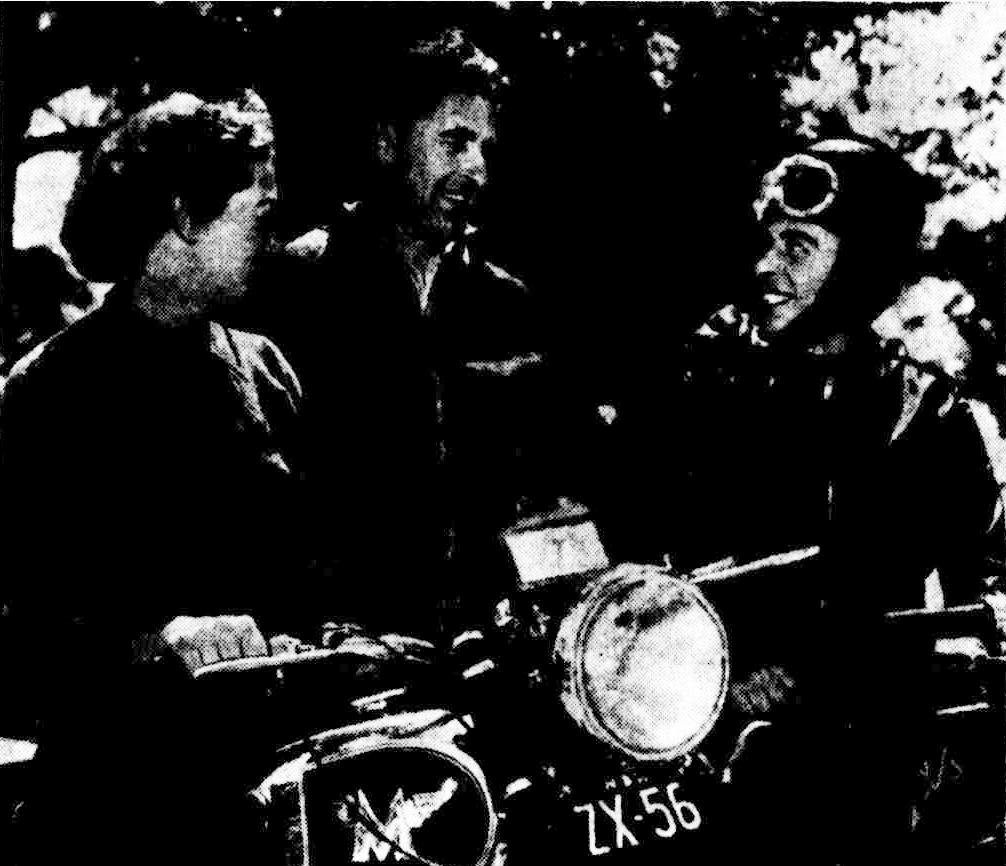
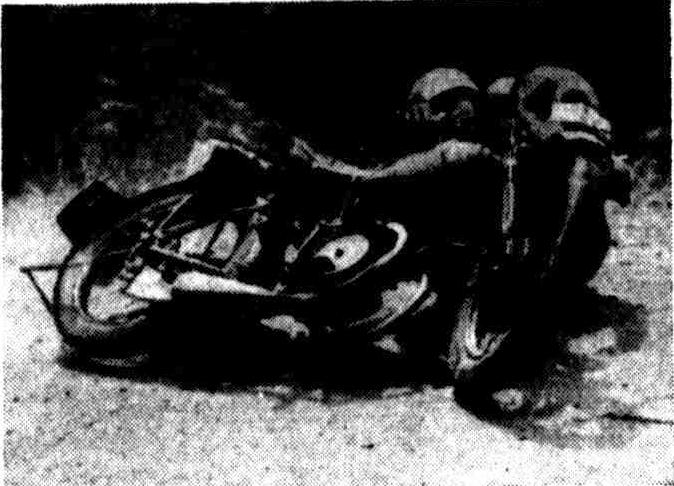
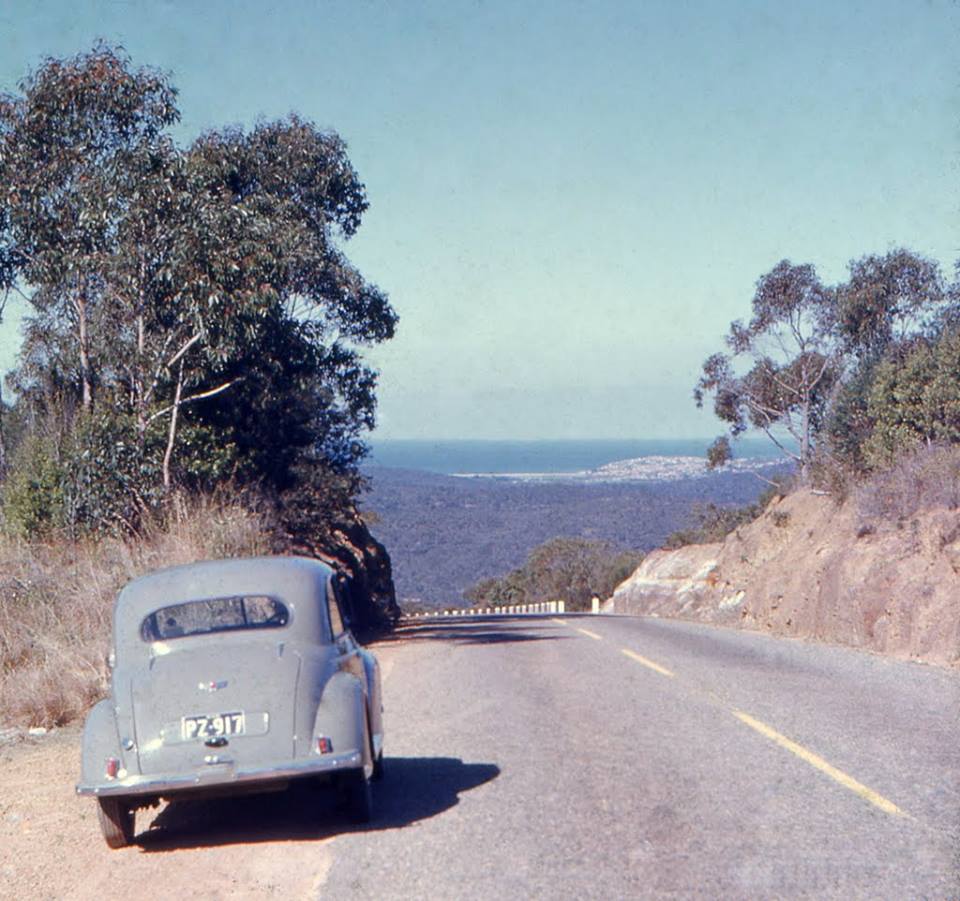
MAIN ROADS ACT, 1924-1963
Notification of Approval of Governor to Plans of a Proposal for Realignment under Division 1 of Part Vb of the Main Roads Act, 1924-1963
Municipality of Ku-ring-gai. Main Road No. 162—Mona Vale road. Proposed widening between Pacific Highway (State Highway No. 10) and Killeaton-street.
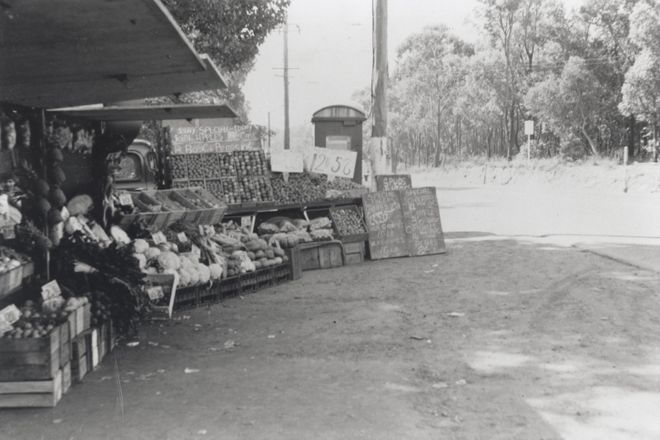
The Great Railway Schemes
A subject that has been discussed even today is a rail connection to Pittwater, or Narrabeen or Dee Why to Chatswood along the thoroughfare that will lead past the new Northern Beaches Hospital.
Such notions have been around for a while - caused speculators to bu land in Pittwater at even the hint of a tram running to Narrabeen and unfortunately for one gentleman, Mr. Brock, meant the loss of a grand estate in 'The Oaks' at Mona Vale.
Some earlier schemes lend insights into the paths to and from Pittwater, in a round about way:
Camp Life at Field of Mars, Ryde.
The scenery of Ryde and its neighbourhood is of the most picturesque character, offering glimpses and peeps of diversified views, with variations of light and shade, charming in the extreme. Ryde parish church is an elegant structure, reminding us of the old English village style, and its graveyard contains many handsome tombs, placed by loving mourners to the memory of the departed. Ryde itself, is the nucleus of what will one day be a large and flourishing town.
The Field of Mars, portions of which our illustrations represent, is distant from Ryde some-thing less than three miles.
The " Government Party " Camp, Field of Mars, near Sydney, New South Wales.

1. Overseer's' Camp. 2. Main Camp. 3. Pittwater-road (Tram Route to Parramatta). 4. Lane Cove River (seen from the Estate). 5. Camp on Kitty's Creek. 6. Grinding Axes. 7. Sylvan, Scene on the Kitty's Creek.
The Colonial Secretary, it may be remembered, at a critical period in the depth of winter, and owing to the disorganization of the labour market, through the late disastrous drought, which so severely affected the whole colony, felt himself called upon to give employment to some hundreds of " unemployed '' who thronged the streets of Sydney, and were reduced to great straits. The common of the Field of Mars has been cleared by some of these men, and is now surveyed and laid out in roads, streets, and allotments, the acreage" of the latter and the width of the former being defined and accurately shown on the maps. We have been informed that this splendid tract of land will be thrown into the market very shortly for sale by auction, as villa sites,and the situation of some of the sections, overlooking the Lane Cove River, are exceedingly fine. The wildness of rugged crags in shapeless grandeur and primeval form, offering a singular contrast to the soft foliage of the far away bush, dotted here and there with a solitary homestead, nestling in, and gleaming white against the dark background, and the placid river flowing at our feet.
The common is to be approached by a tramway which is to run through Balmain and Gladesville, crossing Stranger's Creek, where an elegant bridge is to be erected, the material for which is now on the ground. This tramway will traverse the common on its eastern side, then proceed in a northerly direction along a main road to Pittwater, and form a loop of a line to be taken from Ryde to Pittwater. The common of the Field of Mars is also comparatively of easy access from the Figtree Wharf on the Lane Cove River, and also by the Parramatta River from Ryde or Gladesville, from each of which it is about equi-distant. The acquisition of land here for villa sites, of an exceptionally pleasing and attractive nature, will doubtless have consideration from those in search of a retired and select location, and it is said the idea is to make this quarter very select-a second Potts Point in fact. On the ridges the soil is of good quality, fit for orchards and vineyards ; the timber is chiefly young mahogany, bloodwood, and gum. Other portions possess soil of the richest description, and for speculators will, no doubt, when offered for sale, be provocative of keen competition. There is a cemetery 27 acres in extent which has been thoroughly cleared, and is apportioned for the various sects and denominations, and will be shortley dedicated and handed over to trustees. From its centre may be obtained one of the prettiest views of the village of Ryde and its church.
Where it rises above the graves on the hill, Silent and sad, and sombre and still.
If the idea of the aristocratic officials to develop a fashionable suburb be accomplished, the piece of country -which has been cleared by the men who sought employment from the Govern-ment offers special advantages, easy of access, a salubrious climate, a rich and fertile soil, and exquisitely beautiful scenery. The roads are all open to excursionists, whether on horseback or by conveyance. Camp Life at Field of Mars, Ryde. (1884, December 13). Australian Town and Country Journal (Sydney, NSW : 1870 - 1907), p. 26. Retrieved from http://nla.gov.au/nla.news-article71021325
THE PROPOSED ST. LEONARDS TRAMWAY.
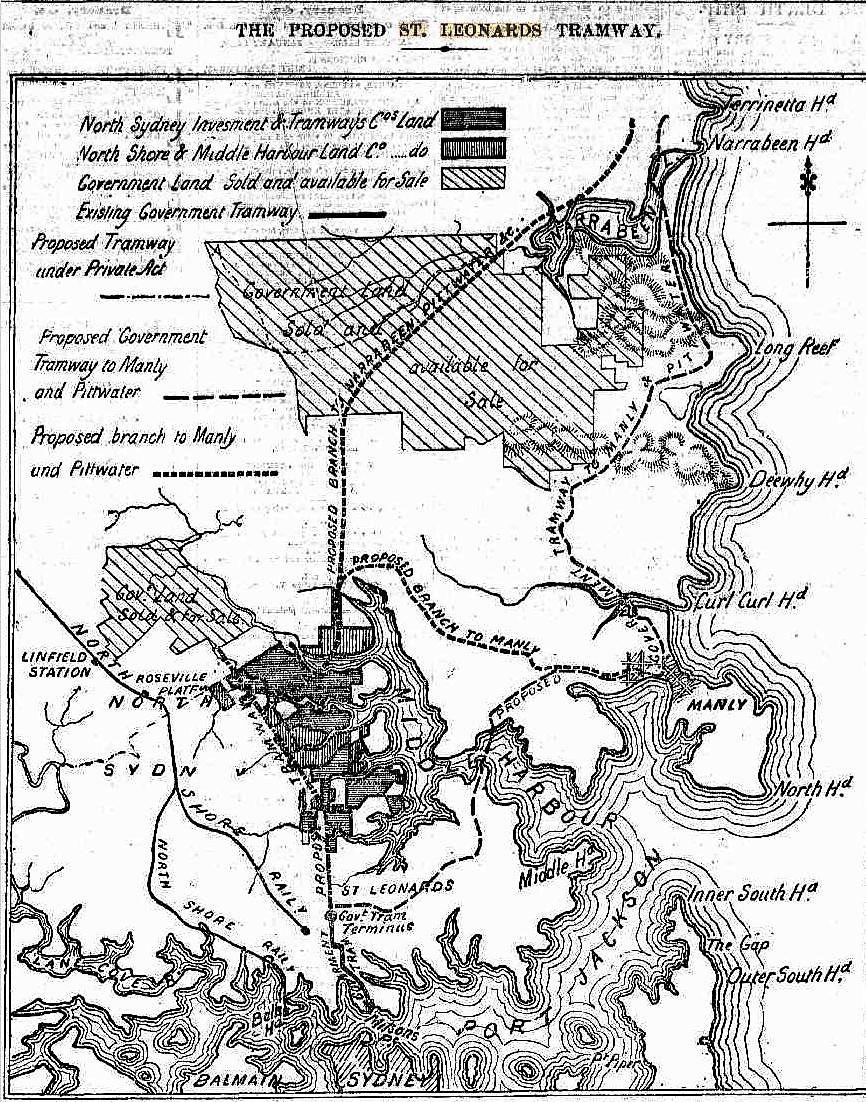
Though within easy distance of Sydney, very little is known of the magnificent charnpaign country lying contiguous to the many bays which are to be found in Middle Harbor, certainly the most beautiful portion of our beautiful harbor." The many who take the trip round the harbor, going up its glorious waters up to Green Cape, seen on either side steep, rock -guarded uplands, with a rich mass of verdure clothing them with perennial green ; but few have explored these uplands from the land side, or have any conception not only of the goodness of the land but of the magnificence of the views to be obtained from almost every point. Here, extending north of Si. Leonards, is a grand sanatorium— a large extent of country in its native state, consisting of undulating land covered with heather and thick undergrowth, running eastward towards the waters of Middle Harbor. Some time since this attractive area, which hitherto had lain idle, being cut into allotments mainly owned by one man, attracted the attention of two gentlemen who saw that bore was an opportunity of bringing these magnificent sites for suburban residences within easy access of Sydney, opening out country with the finest uplands, breezy and health-encouraging, running on towards the waters of Middle Harbor, and at the same time forming a straight route on to Pittwater and Narrabeen, two place which in the near future must become of increased importance, not only us holiday resorts but also as settled centres of industry. The idea was that a tramway line carried from the present terminus of the North Shore cable tramline at the corner of St. Leonards Park, straight along Miller-street, on through the municipality of North Willoughby to a point near the head waters of Middle Harbor would not only be a good speculation but would also be the means of bringing into existence a new' suburb, which in point of picturesque beauty of scene would outrival many of the beautiful outskirts of the city. A thousand acres of ground shown' in the annexed plan marked with horizontal and perpendicular lines were acquired by purchase by Mr. Andrew Armstrong and Mr. James Alexander Brown, each owning 600a., and after much consultation and many and varied calculations it was decided to get permission, if possible, from Parliament to construct a tramway to the extremity of the property so acquired. After some trouble the matter was brought before Parliament, and on July 18, 1887, an Act was assented to authorising Messrs. Armstrong and J. A. Brown to construct and maintain a tramway along the proposed route.
The description of the tramway in the Act is from the terminal point of construction of the St. Leonards cable tramway, along Miller-street, Palmer-street and Bellevue-street, in the town and municipality of St. Leonards, and through certain private land, across French's-road, Mowbray-road, M'Lellan-street, -Victoria-avenue and along Murano-road, in the municipality of North Willoughby. It was specified in the Act that the tramline should not occupy in any part of a road or street a greater space in breadth than 22ft. including the support and foundations ; that it should be constructed and brought into use within three years from the passing of the Act and constructed In a workmanlike manner that nothing should impair the lawful authority of the municipalities of St. Leonards and North Willoughby or of any other corporation to construct, maintain and preserve gasworks, water works, sewerage works and other works lawfully constructed under ground ; that the gauge of the tramway should be 4ft. 8 ½ in. that it should be laid with rails subject to the approval of the Commissioner for Railways; "that the promoter should maintain in perfect order the tramway and the pavement of the streets between the rails and for the space of 1ft. Oin. on each side of the rails, and should erect all necessary causeways ; that they should emptor electricity, locomotive engines, stationary engines with cable connection, horses, or other moving power ; that they should be responsible for all injuries caused through negligence or improper construction ; that regulations should be framed, but none or' them should authorise the closing of the tramway between sunrise and sunset, except at any time when In consequence of any of the works being out of repair it should be necessary to close the line or any part of it ; and finally, that the Government should have power at any time to purchase the line at its then assessed value.
After this the land, which had been purchased by Messrs. Armstrong and Brown, who were the real fathers of the scheme, attracted the attention of a number of capitalists, and two companies were formed, who in December, 1887, and January, 1888, acquired the whole of the land. The first of these was styled the North Sydney Investment and Tramway Company, with a nominal capital of a million sterling, and the land owned by them is shown on the map marked with horizontal lines. The second company the North Shore and Middle Harbor Land Company, with a nominal capital of £1500,000, has its property distinguished by perpendicular lines, and as will be seen, this company own two pieces of land away from the proposed tramline, the one to the left an area known as the Royal Park Estate, and the other an allotment 270a, in extent on the opposite side of Middle Harbor, near where there is a further proposal to erect abridge for a road or train extending from the proposed line. This area of ground which has been bought with a view to further, development has a water frontage on the main waters of Middle Harbor, commencing at a point situated just above a small cove, where the steamers plying usually turn and close to an exquisite spot — a crag bound little peninsular extending to the water, covered with a beautifully green carpet of turf surrounded by rich and variegated, woodland foliage. This spot was a favorite resort of Sir Hercules Robinson when Governor of New South Vales, and he and his family and friends were wont to come here picnicking. The whole of this property, owned by two companies, is well adapted for residential purposes. The total length of the proposed line is about three miles and a half, the distance from the present cable tram terminus to the bridge at Long Bay being one mile, and it is stated that will present but few engineering difficulties.
THE LAND PASSED THROUGH.
Hitherto the whole of the large area of country situated within the boundaries of the borough of North Willoughby, and extending back to the parish of Gordon, has been to a great extent cut oft' from communication with Sydney in consequence of the rugged gorge formed by the waters of Long Bay, the southernmost arm of Middle Harbor, the waters of .which extend a long distance westward, terminating in what in summertime is a Huge canon with steep sides, mid at whose bottom lie huge boulder, through which the course of g . creek 'is discernible, its existence being marked only by. here and there a limpid pool of water and its sides, rough, uneven land, which might be utilised without trouble, and on the slopes of which arc dotted here and there a number of residences of all kind, some of them of the most primitive type. The design of the proposed tramline, which is to be at once proceeded with, is to bridge this chasm and to open out in the first instance the areas running on the one side out through the territories included in the borough of North Willoughby comprising the lauds through which the railway to Crow's Nest runs, and on to the unimproved and at present, owing to the unwillingness of the proprietor to sol unimprovable, estate owned by Mr. David Berry, the whole of the original grant known as .Wolstoncrofte, and on the other the areas running eastward to though shores of Middle Harbor and its numerous offshoots. This latter is comprised in four distinct ridges ; the first and the largest of the four in point of area, bounded on the south by Long Bay and on the north by Mowbray Bray : the second between Sailor's Bay and Sugar Loaf Bar ; the third a beautifully-situated promontory on either side of what is known as Sugar Loaf Bay ; and the fourth washed on either side by the main waters of Middle Harbor up to beyond its navigable waters. This is in effect the design, of the first portion of the scheme shown on the plan, but its extension is contemplated on to Pittwater with a detour to the west to Manly.
Taking the tramline as proposed, the first portion will run from the present terminus of the cable tramway, (by the Government) at the south-western corner of St. Leonards Park along Miller-street for a -distance of a little over a mile to the waters of Long Bay, and will bring into direct and near communication with Sydney the whole of the northern portion of the borough of .St. Leonards, as on either side of the. line there is a large population, with spacious well-formed streets. The whole of the land to the left of the line is portioned off into streets up to the boundaries of the Berry Estate, a small portion of which has been alienated. And on this stand numerous residences and places of business, besides several public buildings, including the pretty cottage hospital—a credit to the borough, which was formally opened by Sir Henry Parkes less than a year ago. To the right of the line is the St. Leonards Park — a well laid out public reserve —which is yearly being Improved; while beyond, a little, further to the westward, below Ernest-street, is situated Cammeray Park, a triangular piece of ground through which passes a road leading to Cammeray Point, whilst in a once sequestered nook, which has been of late invaded by a tramline leading to Borne quarries at the extremity of a little harbor is situated Folly Point, approached by a road formed by the St. Leonards corporation, a favorite boating and fishing resort, but which is not. used as it might be owing to the difficulty of access from Milson's Point. The gorge at Long Bay is to be crossed by a handsome suspension bridge, and after crossing this the line enters upon the territory of the borough of North Willoughby.
At present the only means by which this borough can be reached from Milson's Point direct is by the Sydney-road, a well-formed thoroughfare, whilst the bay as it is still called, though it really is a creek, dry in summer but a roaring torrent after heavy or even moderate rains, has been spanned through the energy of the North Willoughby Council by a massive stone bridge, which cost somewhere about £5000. Near here, perched on the heights, are the residences of Mr. Thomas Datton, M.P., and Mr. Douds, M.L.C. Passing over the bridge the road ascends, and though the land is pleasant and the scenery delightful there is not much settlement until what is known as the Central Township is reached, a beautifully laid out little village, where there are numerous pretty residences and a large tannery, the most extensive to be found around Sydney, owned by the Messrs. Forsyth, who have taste-full villa residences in the vicinity. The whole of the rest of the country to the westward of the land, including Mowbray Park, the township of North Sydney, Alleyne Park, the Artarmon Estate and numerous other allotments — some merely fenced in, others lying waste, and others again built and settled upon— is a rich country, where gradually people are finding their way, and which only wants an impetus such as a tramline should impart to make it one of the gardens of New South Wales. As an instance of progress, it may be stated that out in this now distant and but little-known suburb, at a spot whore there is but a straggling population, Mr. Museton is meeting a line hall to be called the Centennial.
But after all in connection with the tramway, it is the land situated to the eastward, with some seven miles of frontage to Middle Harbor and extending from Long Bay to the topmost arm of the harbor, which will give it Its chiefest charm and value. No finer views are to he obtained near Sydney, and the combination of water and wood and tree and fern, upland and valley and clear heathland and rocky defiles, clothed with all the rich flora and ferns of New South Wales, are all beautiful. The whole of this country is owned by the two companies who hare taken in hand the task of constructing and carrying on the tramway, with the exception of a few stray allotments which are shown in our plan, and several valuable reserves which have been retained, but never up to the present time used by the Government. The first ridge through the extremity, of of which the tramway will pass is bounded on the south by Long Bay, with a curious inlet known as Saltpan Creek, which many years ago was looked upon us a natural dock, and which it was intended should be used for Government purposes. This is included in a large reserve designed partly for a site for harbor defences and partly for a training school for boys from the ship Vernon, but up to the present it remains wild and unimproved. The whole of the land on this peninsula has been partially cleared and a fine roadway formed, whilst from a lofty dome-shaped hill which rises abruptly from the surrounding plateau an attractive view of the harbor and its tributaries is to be had. Below, abutting sharply on the water is Figtree Point, a well-known resort by persons voyaging into these waters, and at the northernmost extremity of the promontory a piece of laud known ns Albert Town, with a park reserve adjoining, to which the rood, which has been formed partly by the company and partly by the borough council, descends. Opposite is the curious point known as Quaker's Hat and a rich flat, which some time or another must become valuable. All the land on this area is well adapted for residential sites. The ridge beyond this is intersected by Mowbray-road, and the character of the land is similar, though in parts more rugged, while the scenery as we advance northward assumes a bolder and more mountainous character, softened always by the glorious stretch of water which spreads itself in all directions, terminated by lovely bays and rich campaign areas. The most northerly of the ridges, and by far the most beautiful, is at present approached by the Teralba-road leading from Alleyne Park and descending to the bond of Sugarloaf Bay, where there is a considerable settlement. A creek runs in to the bead of the buy, and along its banks are two tanneries and a number of pretty residences, all surrounded by gardens and orchards; in fact, everywhere in this fertile region fruit trees seem to flourish to an astonishing extent, and wherever the hand of man has been at work luxurious gardens are to be found. On the heights to the southward of Sugarloaf Bay, near Mount Wilson, there is a large Chinese garden of some 21 ha., owned by a man who in years past was a celebrity amongst his countrymen, one Chenateak, and here a large vegetable trade is done. At the back of the garden there is a joss house which is used by the numerous Chinese gardeners, who have made for themselves a home in various likely spots throughout the borough of North Willoughby— In fact, wherever water was to be found.
The proposed tramway terminates on a crested hill, known as Echo Farm, after crossing a rock-embrasured creek which just below the tramline passes through a series of rocky' basin, and then tumbles over a precipice, forming n waterfall some 70ft. or 80ft., the sides of this narrow gorge, only about 10ft. in width, being covered with ferns and every species of flora and shrub. As opening out this magnificent country and thus bringing within easy reach a land but little known either to the tourist or the resident of Sydney the tramline proposed, apart from any profit it must bring to the companies who have obtained permission to construct It, must be regarded as a public benefit." Its extension, as contemplated, on to Manly and further afield to Narrabeen and Pittwater, in lieu of the line proposed through St. Leonards and across the Spit by means of a bridge, is a matter only of time. THE PROPOSED ST. LEONARDS TRAMWAY. (1889, January 19). The Daily Telegraph (Sydney, NSW : 1883 - 1930), p. 9. Retrieved from http://nla.gov.au/nla.news-article235866189
The bridge referred to above was originally called the North Sydney Bridge. The depression of 1892 saw both companies go into liquidation and at that point the name Northbridge began to appear. This downturn was caused by a number of factors including a severe drought, the sinking of wool, wheat and metal prices, and most of all, the withdrawal of British investment in NSW on a major scale.
The plan for a train to Pittwater persists:
TURNED DOWN. A SUGGESTED RAILWAY. GORDON TO PITTWATER.
In ten years time you might have a chance: to-day you have none. This in effect was the reply made yesterday by the Minister for Works to a deputation which waited upon him with a request that he would favourably entertain the building of a railway from the North Shore line in the neighbourhood of Gordon or Pymble across to Pittwater with Broken Bay as the final objective. The deputation lacked nothing in numbers. There was a strong representation of the Kuringai and Warringah Shire Councils, of the Kuringai Ratepayers' Association, and of the Pittwater Progress Association It was introduced by Mr. Wade who with Dr Arthur emphasised the advantages to be derived from the construction of the proposed line. Dr Arthur enlarged on the advantages of throwing open for settlement country that from the standpoint of hygiene lacked nothing. It would be an ideal district he said for testing the Government scheme for erecting workmen’s homes. The land lay from 600 to 700 feet above sea level the surroundings were most picturesque and it lent itself well to drainage and sanitation. Since Sydney was increasing at such an enormous rate people would be driven more and more Into the Suburbs and he thought It would be a pity to compel them to seek homes along the low lying parts served by the Western line or along the shores of Botany Bay when such elevated and beautiful country as that lying between the North Shore line, and the ocean could be made accessible.
The Rev. Paul Clipsham president of the Kuringai Shire Council said the country lying between Gordon-Pymble on the one side and Narrabeen-Mona Vale on the other rivaled In its beauty anything to be seen on the Blue Mountains. He had not the slightest doubt that if the line were constructed it would develop an enormous passenger traffic. A line 17 miles long would open up the district well and seeing that there are no engineering difficulties to be overcome, he did not think It would be an expensive line to build. Apart from that it would greatly enhance the use of Crown lands through which the railway would pass. In all probability it would pay almost from the start. It would run through St Ives one of the most thriving fruit growing districts in the state. It would carry heavy consignments of fruit to Sydney and doubtless when communication with Broken Bay was opened up much of the fish supply of Sydney would be carried by It.
Messrs Ralston (president of the Warringah Shire Council) Griffiths, T. W. Taylor, Jones (secretary Pittwater Association) and R D Brown also addressed the Minister In Support of the railway project.
It was pointed out that Broken Bay would play an important part in any scheme of defence and that under these circumstances the Defence Department of the Commonwealth might be prepared to contribute to the cost of the maintenance of the line.
The Minister for Works said one of the stock arguments used by advocates of railway projects was the bearing the line would have upon defence. His business was to build lines not for defence purposes but for the development of the country. If however, there was anything in the suggestion that the Defence Department would pay part of the cost of a line to Broken Bay he would of course go carefully into the matter. He did not need to be told anything about the beauties of the country through which the proposed line would pass. He knew the country and it was the most beautiful country he had ever seen. It was to Australia what the Riviera was to Southern Europe. But he could not give the deputation a very encouraging reply. In time the railway would he made but he could not see his way to regard it as one of pressing necessity. Apart from that it would be enormously costly. The North Shore line cost £55 300 per mile and on that basis it would cost over a million to build the 20 miles to Broken Bay or if the line stopped at Mona Vale the cost would run to three quarters of a million. That was an enormous sum to spend to open up even so beautiful a district as the one in question. It would be a very fine thing for the landowners of the district whose property would be enormously increased in value. The State would get little out of it seeing that barely 1 ½ miles of the line would pass through Crown land. If the railway were justified on other grounds he would not object to making the fortunes of the landowners of the district.
But it was not Justified seeing the larger areas of unoccupied land to which the North Shore line gave access. Within 1 ½ miles of Wahroonga station alone there were hundreds of acres of primeval bush and the same thing applied to other stations along the line. The land was being held by owners, waiting for fancy prices. That land must be settled before the line to Pittwater could be considered. It was the policy of the government to spend what money it could get in building railway to open up wheat and agricultural country.
That was obviously more urgent work than building a railway into residential country which already had a railway on one side and would have an electrical tramway on though other side. It was proposed to have the electric tram service extended to Mona Vale. The line would be built off the road and In order to secure a speedy service the stopping place would be at Intervals of quarter or half mile. For quite a number of years that is all the residents could expect to get. The railway would come some day. Perhaps if the deputation waited upon the Minister 10 years from now they would probably get a more encouraging answer than he was able to give. TURNED DOWN. (1911, November 21).The Sydney Morning Herald (NSW : 1842 - 1954), p. 7. Retrieved from http://nla.gov.au/nla.news-article15290696
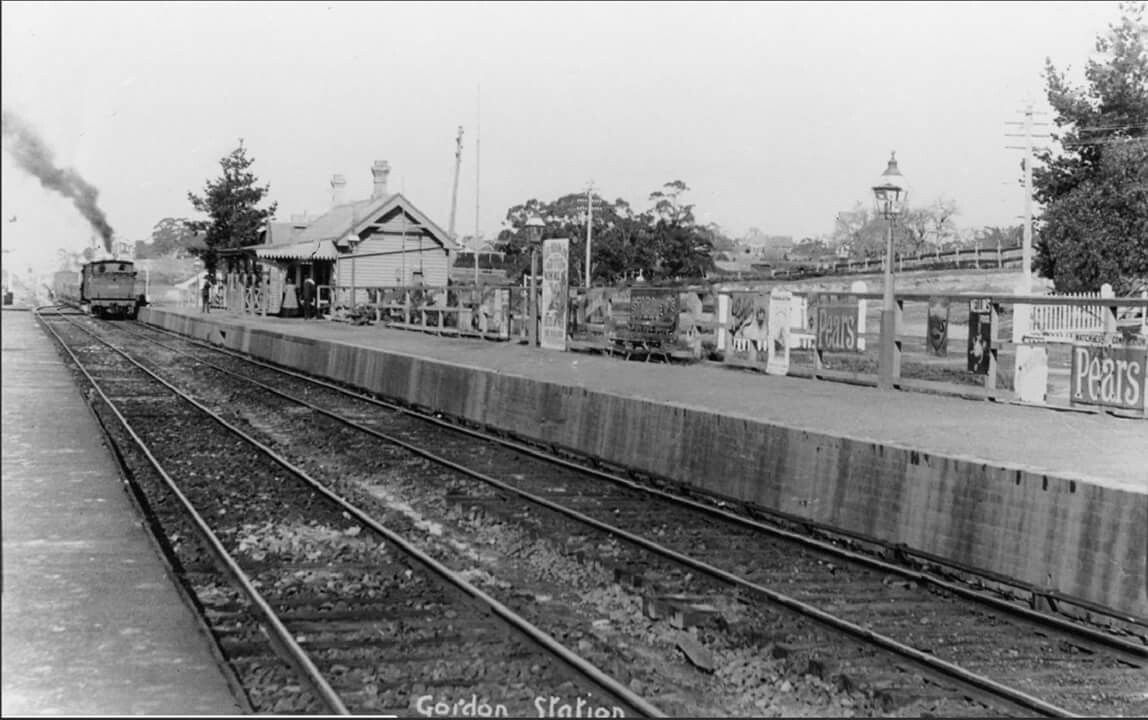
Photo: Gordon Railway Station, in the Upper North Shore of Sydney in 1907, courtesy State Library of NSW

Photo: sections from 1905 Parish Map of Narrabeen showing railway dotted line - that was rejected - and 'The Sugarloaf - this section at Terrey Hills part of map also shows 'James Terrey & Philip Spies' owning section of 640 acres previously held by Obadiah Terrey
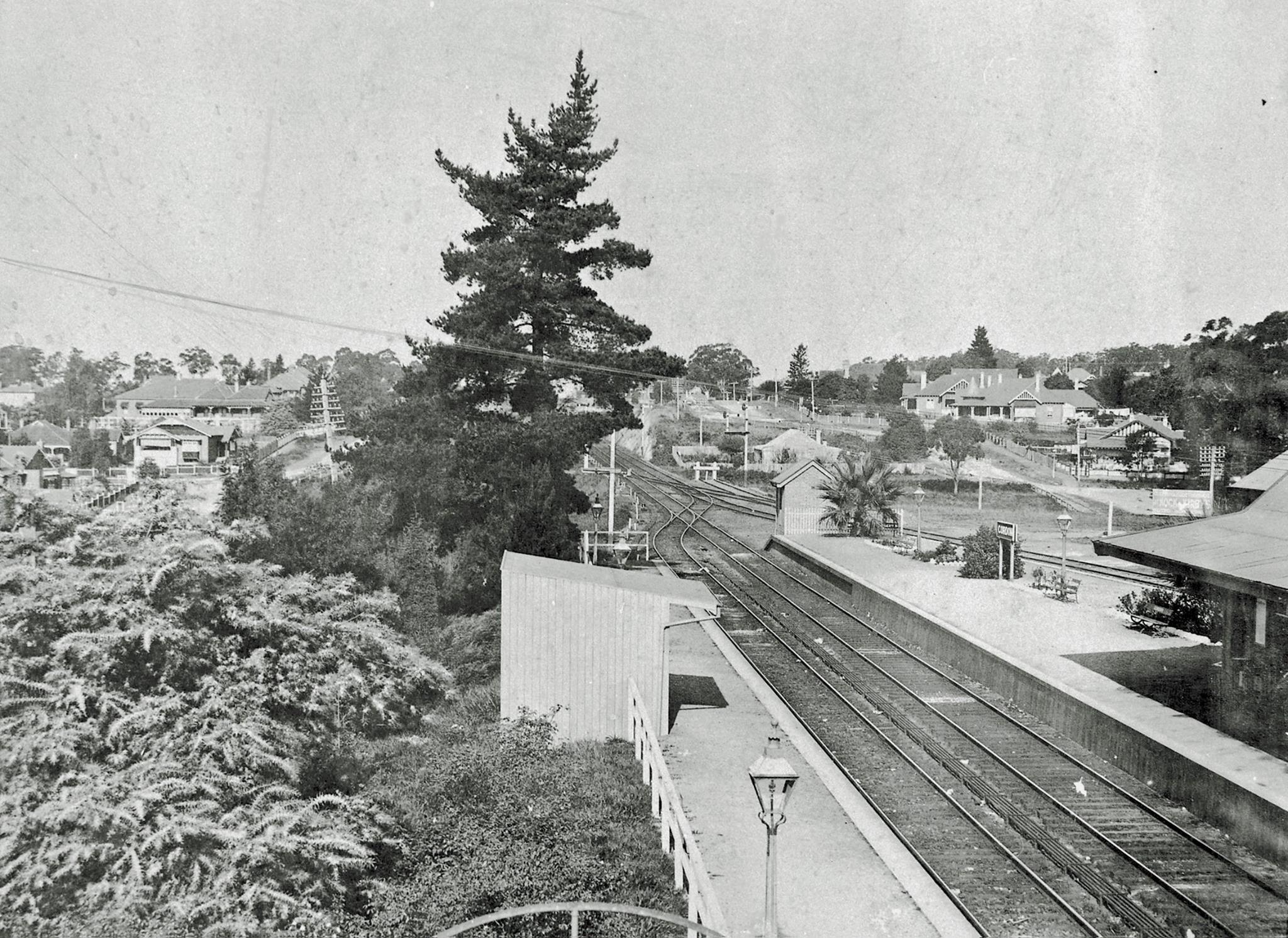
Gordon Railway Station ca.1917. Shows a view of Gordon Railway Station looking towards Killara. The Station platforms, waiting shed, gardens and gas lamps can be seen. Gordon Station was opened on January 1, 1890 when the North Shore Line began operating from St Leonards to Hornsby.
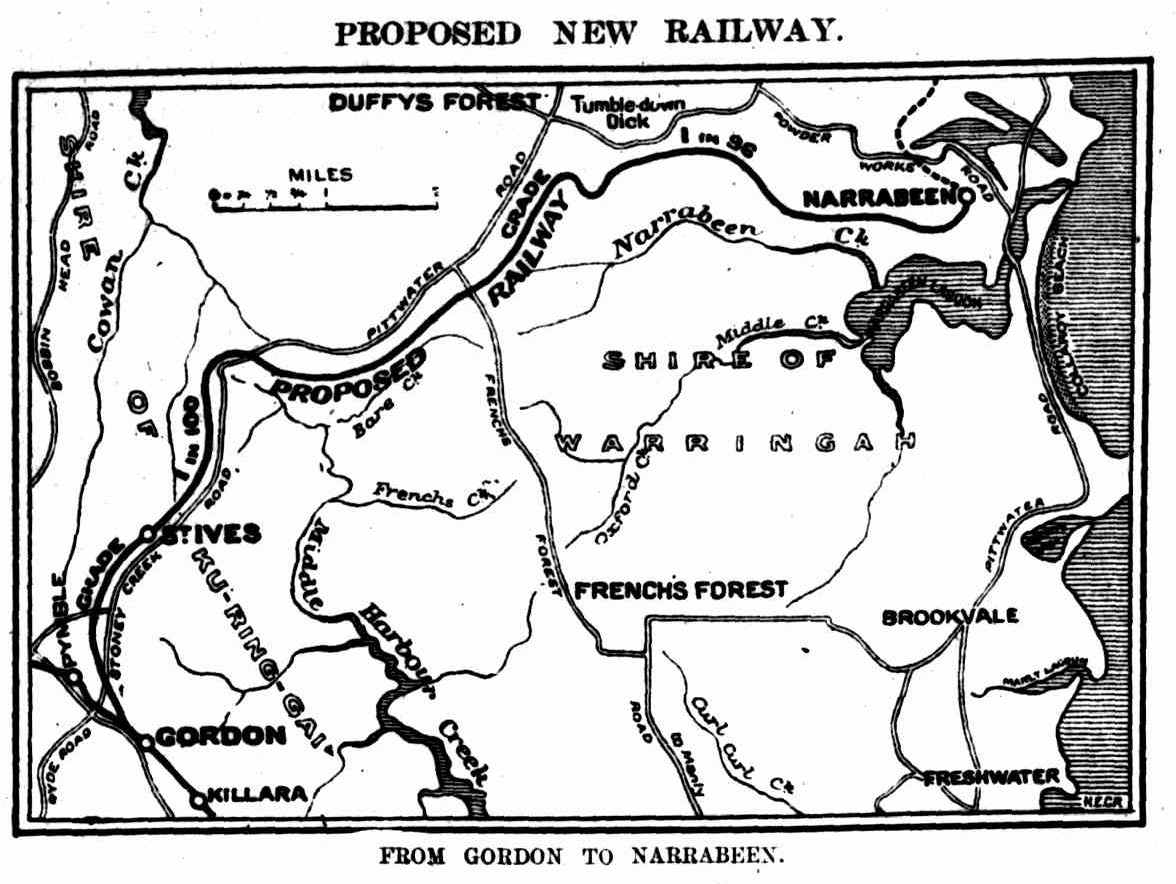
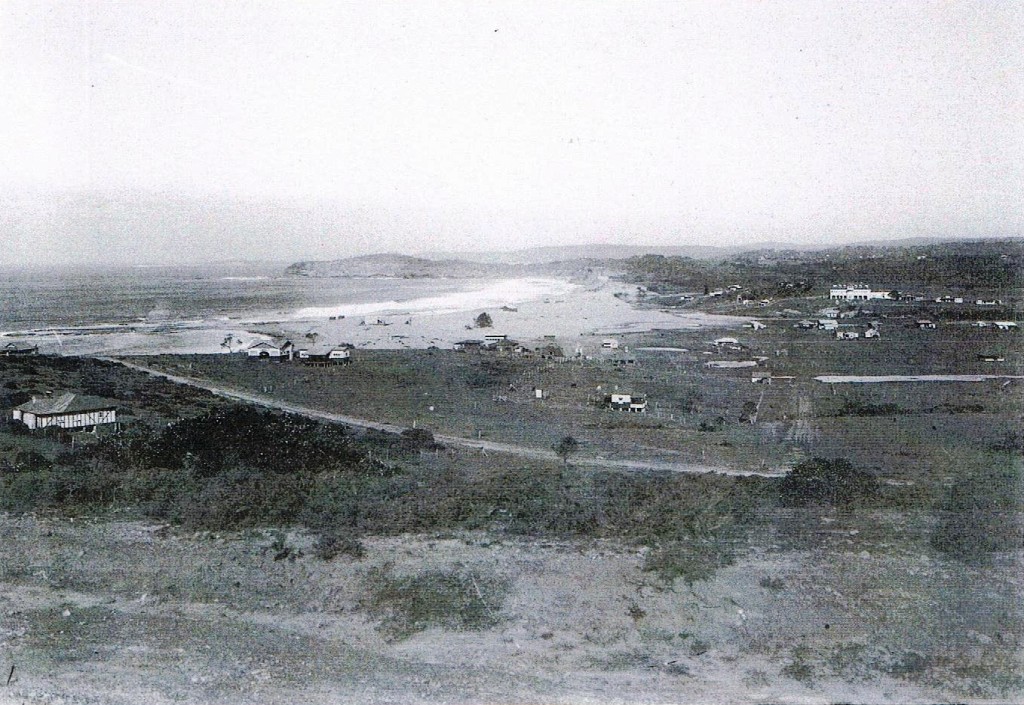
Mona Vale views: Mona Vale, Call Number Government Printing Office 1 – 15675, courtesy of the State Library of NSW.
Extras and References
1. TROVE. National Library of Australia.
2. PROFILES OF THE PIONEERS IN MANLY, WARRINGAH AND PITTWATER. by Shelagh Champion, OAM, B.A.(Lib.Sc.) and George Champion, OAM, Dip.Ed.Admin. 1996
3. Edwards, Zeny, Pymble, Dictionary of Sydney, 2010, http://dictionaryofsydney.org/entry/pymble
4. Ku-ring-gai Historical Society Inc
Further
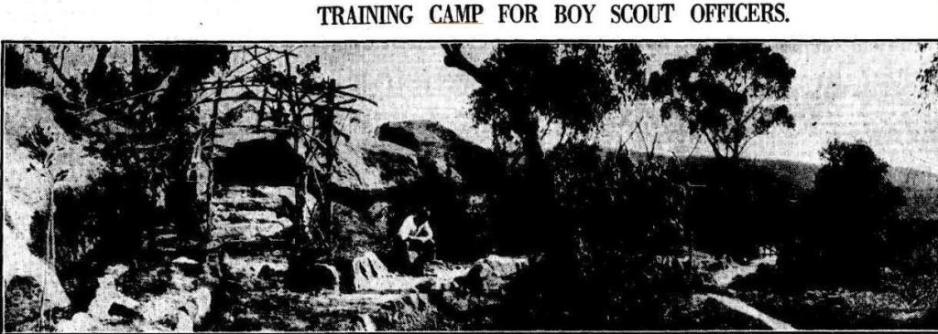
Early Settlers along the ways
Daniel Deering Mathew
PROVOST MARSHAL'S OFFICE, OCT. 10,1822.
In The Supreme Court.
Campbell Jun. v. Daniel Deering Mathew.
BY Virtue of a Writ of Fieri Faeias to me directed in the above-named Cause, I will Put up and Sell by Public Auction, at my-Office, in Hunter-street, Sydney on Friday 25th Day of October instant, at the Hour of 11 O'clock, A. M. A FARM, containing 400 Acres of land, situate at Lane Cove, the Property of the Defendant; unless the Execution thereon be previously discharged. No title (1822, October 18). The Sydney Gazette and New South Wales Advertiser (NSW : 1803 - 1842), p. 1. Retrieved from http://nla.gov.au/nla.news-article2181386
PROVOST MAKSHAL'S OFFICE, OCT. 10, 1822. "NOTICE.- Having received a Communication from Mr. Secretary GOULBURN, under Date of the 7th Instant conveying certain Instructions from his EXCELLENCY the GOVERNOR, for my Guidance in the Discharge of one of the Duties of my Department, as Provost Marshal of the Territory, I hereby give Notice to all whom it may concern, that the following is a Copy of the Communication with which I have been so honored.
J. T. CAMPBELL, Provost Marshall
(COPY.)
COLONIAL SECRETARY'S OFFICE, OCT. 7, 1822. " SIR,
" The Attention of the GOVERNOR has been arrested by some Advertisements from your Office, tendering in Public Sale; certain Grants, very recently executed by the late Governor (MACQUARIE); the Purchasers of those Estates will undoubtedly take them, with all the risks attendant on the Conditions of their Grants being either unperformed or violated :-I am accordingly directed to have the honor to request, that, at the Time of Sale, this Circumstance be duly noticed to the Public by you, Sir, as a high and public fairer, enjoying the peculiar Prerogative to promote His Majesty's Profit in all Things that belong to your Office, as far as you legally can or may truly to preserve the King's Rights, and all that belongeth to the Crown not to consent to decrease, lessen, or conceal the King's Rights, or the Rights of His Franchises:-whensoever you shall have Knowledge that the Rights of the Crown are concealed or withdrawn, be it in Lands, Rents, Franchises, Suits, or Services, or in any other Matter or Thing, to do your utmost to make them " to be restored to the Crown again i-and if you " may not do it yourself, to certify and inform the " King thereof, or some of His Judges."
I have the honor to be. Sir,
your most obedient humble Servant,
F. GOULBURN, Colonial Secretary/'
John Thomas Campbell, "Esq.
Provost Marshal of New South Wales. No title (1822, October 18). The Sydney Gazette and New South Wales Advertiser (NSW : 1803 - 1842), p. 1. Retrieved from http://nla.gov.au/nla.news-article2181386
TWO POUNDS REWARD..
THE PUBLIC are hereby cautioned against employing THOMAS WHITMORE, a Prisoner, he having left my employment before the time of his Agreement was completed ; and a REWARD of TWO POUNDS will be paid by me to any person giving information where the said THOMAS WHIT'EMORE may be at work, after this Notice immediately return to his work, he will be apprehended and prosecuted, agreeable to the Act of Council in such case may be provided.
DANIEL DEERING MATTHEWS.
Rosedale, Lane Cove, 2nd April, 1834.
Advertising (1834, May 10). The Sydney Monitor (NSW : 1828 - 1838), p. 1 (MORNING). Retrieved from http://nla.gov.au/nla.news-article32146255
CAUTION.
THE UNDERSIGNED having given a PROMISSORY NOTE at three' months for .£24 155. Od., to Mr. EDWIN BOOKER, upon certain conditions which he has not performed. I hereby CAUTION the PUBLIC ~not to receive this NOTE in payment, as I have received no value for-the same.
DANIEL DEERING MATHEWS.
Rosedale, lane Cove, 1
13th Oct., 1836.
Advertising (1836, October 24). The Sydney Monitor (NSW : 1828 - 1838), p. 1 (EVENING). Retrieved from http://nla.gov.au/nla.news-article32152568
PHENOMENON EXTRAORDINARY.
To the Editors of the Sydney Morning Herald.
GENTLEMEN,-As a regularly educated physician who has studied and practised physic as well as all the branches of natural philosophy for nearly fifty years, I am going to relate a fact, of which I had ocular demonstration, of phosphorus in an active state being found in the internal membrane of the gizzard or stomach of a domesticated fowl. One of my fowls was ill, apparently from fighting, it was killed, and upon opening it two or three hours after, the internal membrane of the stomach, which contained nothing but the seeds of the rose canina, commonly called the sweet briar, I found upon the least pressure with the knife volumes of smoke were emitted, the smell was decidedly phosphoric , the membrane I kept until dark, when it was as luminous as a stick of phosphorus rubbed upon a wall. Now every medical man and natural philosopher knows that phosphorus in a combined state is contained in the bones and some of the secretions of all animals, and it is distinctly visible in fishes after a partial decomposition. I shall be much obliged to any scientific gentleman to solve this problem. From what little knowledge I have obtained from books study, and experiment
I am now completely in the dark. I
DANIEL DERING MATHEW, (sic.) [Matthew]
Cali. : Coll. Cantab.
PHENOMENON EXTRAORDINARY. (1843, May 16). The Sydney Morning Herald (NSW : 1842 - 1954), p. 3. Retrieved from http://nla.gov.au/nla.news-article12426679
THE BITE OF A CENTIPEDE.
To the Editors of the Sydney Morning Herald,
GENTLEMEN,—It has been supposed that the bite of a centipede is generally attended with either the loss of limb, paralysis, or sometimes death, in all hot countries, particularly the East and West Indies, and other countries within the tropics ; but in this colony, for the information of medical practitioners, as well as the public at large, I will give a short account of a very dangerous case of a sawyer bit by a centipede.
This man came to me on the 14th February of the present year, with his arm swollen to three times its natural size, the heat of which was nearly equal to boiling water, the poison having been retained so long in the arm as to affect the whole system, so much so that he was in a very high fever. The patient did not know what was the matter with his arm, and therefore neglected it ; but upon examination I found two small punctures made by the forceps of the insect, after the cicatrix was removed, being very near the elbow. I have attended this man nearly six weeks, and am now happy to say that he is perfectly cured, and that he has the complete use of his arm, and can work at his trade as well as he could before he was bitten.
There is another insect in hot countries called a scorpion, which is also considered venomous. Above twenty years ago, one of my men came to me and said he was stung by a scorpion. I at first did not believe him, but he persisted in saying he saw the insect on his hand, and killed it, after it had stung him. This happened about the middle of summer; and upon examining his hand with a micro-scope I discovered the place. I made him wash and keep wet the part with a saturated solution of muriate of ammonia, and in a few minutes the pain was allayed, and the hand never swelled, nor was it in any way affected afterwards. As this application was made momentarily, as an experiment, I cannot say it is a specific ; but it is to be observed, the man came to me in less than two minutes after he was stung, so that no absorption of the poison could have extended far : and I am of
opinion that, until active inflammation is produced, by the incision of the teeth, fangs, claws, forceps, proboscis, or sting, no absorption can take place of the poison of any reptile; but that the venom of some animals is more active, and is imbibed sooner into the system, than others, I will admit.
DANIEL DERING MATHEW,
Collegii Socius Cati Coll. Cantab.
Rosedale, March 25.
THE BITE OF A CENTIPEDE. (1845, March 27). The Sydney Morning Herald (NSW : 1842 - 1954), p. 2. Retrieved from http://nla.gov.au/nla.news-article12878312
DIED. On the 13th instant, at his residence, Rosedale, Lane Cove, Daniel Dering Mathew, Esq., in the 71st year of his age. Family Notices (1856, June 18). Empire (Sydney, NSW : 1850 - 1875), p. 4. Retrieved from http://nla.gov.au/nla.news-article60249445
DEATHS. On the 13th instant, at his residence, Rosedale, Lane Cove, Daniel Dering Mathew, Esq., in the 71st year of his age. Family Notices (1856, June 18). The Sydney Morning Herald (NSW : 1842 - 1954), p. 1. Retrieved from http://nla.gov.au/nla.news-article12977845
THIS DAY, half-past 12 o'clock. At. Rosedale, Lane Cove. In the Estate of the late Daniel Dering Mathews, of Rosedale, Lane Cove. Household Furniture. Horses, Gig-, Harness, Poultry, Blacksmiths' Tools, Lathe, and Effects, &c, &c
BOWDEN and THRELKELD have received instructions from the Executor of the estate of the late Daniel Dering Mathews, to sell by auction, at his late residence, Rosedale, Lane Cove, THIS DAY, Monday, 23rd June, at half-past 12 o'clock prompt, Household furniture and effects. Horse, gig, and harness. Cart. Poultry. Blacksmiths' tools. Turning lathe, &c,, &c, &c. Terms at sale.
Advertising (1856, June 23). The Sydney Morning Herald (NSW : 1842 - 1954), p. 6. Retrieved from http://nla.gov.au/nla.news-article12977598
In the Insolvent Estate of John Pearson.
By order of the Official Assignee, RICHARDS0N & WRENCH have received instructions from F. W. Perry, Esq.. Official Assignee, to sell by public auction, at the rooms, Pitt-street, on Monday, 11th February, at 11 o'clock, all his right, title, and interest in and to the following properties in the above Estate—
Lot 27 of the Rosedale Estate, Lane Cove, containing 15 acres 2 roods and 20 perches, fronting Stoney Creek Road, being portion of D. D. Matthews' grant.
Allotment No. 4 of section 2, Village of St. Peter's, having about 30 feet frontage to the Cook's River Road, with a depth of about 99 feet.
Plans at the rooms.
Terms—Cash.
RICHARDSON & WRENCH have received instructions from F. W. Perry, Esq., Official Assignee, (1861, February 5). New South Wales Government Gazette (Sydney, NSW : 1832 - 1900), p. 364. Retrieved from http://nla.gov.au/nla.news-article230060154
NOTICE UNDER REAL PROPERTY ACT.
- APPLICATIONS having been made to bring the Lauds-hereunder described .under the provisions of The Real Properly Act, Certificates of indefeasible title will secure, unless Caveats be lodged in form of the said Act, on or before the dates named opposite of each case respectively.
NO. 713, Lane Cove, Parish of Gordon 60 acres, being part of the Rosedale Estate, as originally granted to the late Daniel Dering Mathews. Applicant – George Thorne, Sydney March 31. Advertising (1865, February 18). Empire (Sydney, NSW : 1850 - 1875), p. 6. Retrieved from http://nla.gov.au/nla.news-article60566123
George Mudie
George Mudie a sawyer age 60 died Apr 29 1866 at Lane Cove. Cause of death marasmus, Born 1805.
Son of James Mudie a watchmaker and jeweller and Margaret Smith. Informant Robert Mudie, brother of Lane Cove.
Assisted immigrants who arrived in NSW aboard the ship John Barry in Jul 1837. The indent recorded:
Mudie, George, a native of Stanley Perthshire, age 29, married, Presbyterian, could read and write, blacksmith, no rleatives in the colony
Mudie, Ann, a native of Luncarty Perthshire, age 27, married, Presbyterian, could read and write
Mudie, Frances, 7, native place Glasgow
Mudie, Margaret, 5, native place Aberdeen
Buried May 1 1866 at Sydney, Robert Mudie undertaker
Born Perthshire Scotland, 29 years in colony
Married (1) Stanley Perthshire Scotland to Ann Cook
Married (2) not known
Children of marriage:
Fanny (Lane) about 36
Margaret (Miles) 34
George 26
Agnes (Veilly) about 22
George Mudie, senior, of the North Shore, was brought before the Court charged with having neglected to register the death of his child. Defendant's child had been treated by Dr. Rutter, in October last and died on the 20th of that month, when Dr. Rutter gave defendant's wife the necessary cer-tificate, telling her to take it to Dr. Ward, the district registrar. Defendant on the 20th October did take the certificate to Dr. Ward, but after office hours, and as the document did not contain all the information required, he was told that be must call again within thirty days. Defendant never called again, and thus in fact no registry was made. Defendant pleaded ignorance in the matter, and the Bench not being unanimous as to the proof of the offence, made no order in the case. WATER POLICE COURT. (1859, February 17). The Sydney Morning Herald (NSW : 1842 - 1954), p. 5. Retrieved from http://nla.gov.au/nla.news-article13021553
A man named George Mudie, aged 62 years, died at his brother's residence, Lane Cove, on Sunday last. The City Coroner received the following notes, the first being an enclosure of the second:— "Sydney, April 30th, 1866. I certify that George Mudie, aged 60, died from marasmus, on 29th instant J. Anderson, M.D." This was addressed to Dr. Ward, district registrar, St Leonards, who wrote to the Coroner—"My dear sir, I have received the accompanying certificate, signed J. Anderson, M.D. As the name is unknown to me, and as I do not believe in such a disease as marasmus causing the death of a man of 60, and, as the certificate does not state when the deceased was last seen, I have deferred registering till I hear from you. There is in the medical directory a Dr W. J. Anderson, who is a qualified man, but no Dr. J. Anderson. Please let me hear from you as soon as possible. Believe me, &c., R. D. Ward." The Coroner made inquiries and found deceased had been ailing for several months, and though the body had been removed to the Union Inn, North Shore, declined to hold an inquest being satisfied that such was unnecessary. On reference to tho Nosological Index, pub-lished by Government in 1863, page 9, marasmus is defined as emaciation, atrophy, debility. Surely a man of 60 can die of marasmus. ADELAIDE. (1866, May 3). Empire (Sydney, NSW : 1850 - 1875), p. 5. Retrieved from http://nla.gov.au/nla.news-article60595683
William Henry McKeown
LANE COVE ROAD.
TO THE EDITOR OF THE HERALD.
Sir-It will appear to persons unacquainted with St. Leonards and the above named road, that Mr. Tunks, in his reply to my letter of the 29th May, has made a crushing defence against the charge of selfishness and neglect of duty preferred by me.
Persons travelling from Sydney to Pennant Hills will be able to give a true verdict, that, while the road through parts of St Leonards and Willoughby is almost impassable, that portion (viz., 13 miles) kept by the Minor Roads grant is in good repair.
I now see that in my letter I left a loophole, and that Mr. Tunks has availed himself of it.
I should have said-that portion of road north of St. Leonards township.
Mr Tunks states that the Borrough has spent from six to seven hundred pounds on the main road, and I have no reason to doubt the correctness of this statement. The street has been kerbed and guttered, and the road made level and good up to and a little past Mr. Berry's gate, and on this I ground my charge of selfishness and injustice, by keeping the road good to gentlemen's residence, and stopping there.
Now, did Mr. Berry live a mile further on, we should have no reason to complain of the state of the road. There are no gentlemen's residences beyond his in the borough, and in consequence that part of the road is neglected
Also, on the fact referred to by Mr Tunks, that the inhabitants of St. Leonards are contributing to the public revenue through the Custom-house by the same rule we contribute to the revenue from which the municipalities receive their endowment. Again, if the municipalities were not in existence we would have the "minor roads grant," of which we have been deprived.
When East St. Leonards was proclaimed, ten or eleven years since, the grant to this road was reduced by £50 per annum. When Willoughby was proclaimed a further reduction of £125 was made, thus making it very clear that the duty of repairing the road was thrown upon the boroughs through which it passes. Mr. Tunks refreshes my memory with reference to the state of the road past Mr. Muston's about two years since; if I should live for a hundred years I could not forget that. I contributed to lay down a road of saplings on the footpath, to enable carts to get along. I now take the liberty of refreshing Mr. Tunks's memory, and ask him if that state of things was not brought about by two end half years' neglect on the part of the Borough Council of St Leonards, which came into existence some four or five years previously. He cannot saddle the trustees with the bad state of the road two years since. I will not discuss this matter farther, publicly, with Mr. Tunks. As our representative in Parliament and Mayor of St Leonards we have a right to look to him to have the present state of things remedied in some way.
Yours, &c.,
W. H. McKEOWN.
Rosedale, Lane Cove, 6th June.
LANE COVE ROAD. (1872, June 11). The Sydney Morning Herald (NSW : 1842 - 1954), p. 6. Retrieved from http://nla.gov.au/nla.news-article13258915
A FARM OF 98 ACRES, AT LANE COVE, AND ONE OF 47 ACRES
By order of the Trustees in the Assigned Estate of Mr. William Henry M'Keown.
T. W. BOWDEN is instructed by the trustees to sell by auction, at the Land Sale Rooms, 154, Pitt-street, on THURSDAY, the 24th January, at 11 o'clock,
A farm of 98 acres, purchased from the Crown by Mr. M'Keown, situated in the parish of Gordon, Lane Cove, commencing at the north-east comer of John Ayre's 326 acres ; bounded on the north, by a road one chain wide ; on the east, by a road, one chain wide ; on the south, by the northern boundary of a farm 99 acres, being a line west, 64 chains 92 links ; and on the west, by a part of the eastern boundary line of John Ayre's 320 acres, being a line bearing; north 15 chains 44 links, exclusive of a road one chain wide, from Parramatta to Pittwater, passing through this grant in a northerly direction.
Also a farm of 47 acres, in the same parish, commencing on a road, one chain wide, at the south-west corner of a measured portion of 47 acres ; and bounded on the north by the southern boundary of that land, being a line bearing east 30 chains ; on the east, by a line bearing south, 15 chains 72 links; on the south, by a northern boundary, of a measured portion of 47 acres, being a line bearing west 30 chama ; and on the weet, by the aforesaid rood, dividing it from part of S. Morley's 60 acres, bearing north 15 chains 72 links, to the south-west corner of the 47 acres aforesaid.
These farms were selected by Mr. M'Keown as suitable for orchards, and purchased by him from the Government for that purpose. Terms at sale. Advertising (1867, January 17). The Sydney Morning Herald (NSW : 1842 - 1954), p. 7. Retrieved from http://nla.gov.au/nla.news-article13138990
HCA4 is the location of the second subdivision (1892) known as Roseville Estate, by the orchardist William McKeown. Church Street, Mona Vale Road and Orana Avenue mark the boundaries of the subdivision. Orana Avenue also marks the driveway entrance to a second McKeown house located at no25 Orana Avenue. The conservation area records the historical layer of subdivision of rural land used for orchards for the development of suburbs of Ku-ring-gai. Though the subdivision dates from 1892, the development of the site and did not occur until the inter-War period. This is a record of the economic shifts of boom and bust when larger properties in Ku-ring-gai were subdivided and development delayed until the economy recovered. The impetus for these subdivisions was the planning of the railway with its staged development from 1887 and eventual link from St Leonards to Hornsby in 1890.
HCA4 is built predominantly Inter-War and immediate post war houses which provides a consistency of style, scale and materials. The setbacks from the street and between neighbouring houses allow for mature gardens and trees which creates a consistent suburban context that typifies Ku-ring-gai’s suburbs. These elements in combination with street trees, a high tree canopy and the relief and..
The HCA4 is located to the wet of Mona Vale Road and includes Church Street, Orana Avenue and Kywong Avenue. The layout of this area to the west of Mona Vale Road has been determined by the historical subdivision of orchards in 1892. This area was developed in the Inter-War period and includes a number of houses of this period and immediate Post War houses. The area of Kywong Avenue includes some 1950s and 1980s houses and follow the creek line and that forms and densely vegetated riparian landscape.
The second McKeown House is located at the north-western bend of Orana Avenue. The house is hidden from view by the new houses resulting rom then subdivision of front garden.
Orana Avenue was originally the entrance drive to the McKeown house and retains a driveway form with unformed kerb and gutter, informal street tree planting to edge of street and no footpaths.
Lane Cove Orange Groves.
(FROM OUR REPORTER.)
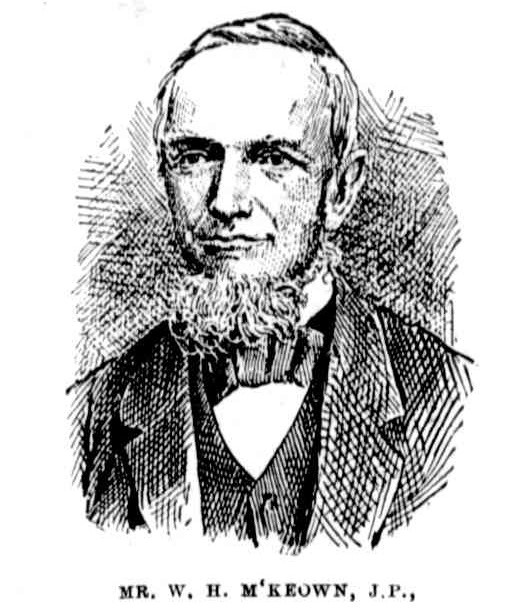
MR. W. H. M'KEOWN, J.P.,
The subject of our-illustration, is a pioneer fruitgrower of the Lane Cove or Gordon district. He emigrated from Waringtown, county Down, Ireland, to this country, in the year 1841. He arrived as a single man, and without capital. He was, however, possessed of something more precious than gold-a robust constitution, a determined and persevering spirit, and an industrious and economical disposition, Endowed with these sterling characteristics, he has been successful, and has amassed property. Mr. M'Keown settled in the Gordon district over forty years ago, as overseer for Mr. Richard Hill, then the owner of the greater portion of the land which Mr. M'Keown now owns. Having served Mr. Hill for three years, he purchased 40 acres of land from that gentleman, and planted a fruit orchard on it, and he has prosecuted that industry with energy and success ever since. He now possesses about 150 acres of land, about 60 of which are planted to citrus and deciduous fruit trees.
His comfortable homestead of Roseville is pleasantly situated near the crown of a gentle hill, from which views of the Blue Mountains, Petersham, Botany Bay, Woollarri, and Port Jackson Heads, and the ocean may be obtained. A public road runs past the door, and luxuriant orchards of oranges, lemons, apples, pears, peaches, plums, apricots, nectarines, &c, and vines line each side of the road. The aspect of the country is rolling hill and dales; some portions of the soil being rather poor, and passing into stiff clay; while other portions are of a finely pulverized loam. The older part of the orchard, which was purchased from Mr. Hill, has never been as proliño as the newer portion. About fourteen years ago a terrific hailstorm swept over and wrecked the greater part of the old orchard, and in about 10 minutes destroyed about £1500 worth of fruit The effects of the storm may be seen in the orchard to-day, by the irregularity of the trees.
Mr, M'Keown believes in good and proper cultivation, and manuring, and in using insecticides for the preservation of his trees. All the muck and litter which accumulate in the bush, consisting of bark, leaves, and ferns, &c., are raked up and spread around the trees, and form a kind of a mulch, from which they derive much benefit, Bone dust is also applied to the land, first as a top dressing, and then ploughed under. Mr. M'Keown does not believe in superphosphates. The bone dust, he thinks, by this method is too much decomposed ; and the trees assimilate its ammonia and phosphate all at once, and leave nothing for next year; whereas by applying the bones, run through a mill, or broken as finely as possible, a constant and gradual decay ensues, and of course a gradual assimilation of the fertilising ingredients contained in the bones. This, he says, he knows is clean against scientific teaching and theories ; but it is his experience. He is not an advocate of draining where the soil slopes and the subsoil is moderately loose. Surface drains in such localities as his, he thinks, are sufficient to carry off the water. True, he has lost many trees from root rot; but other people who had their orchards sub soil drained, lost their trees from the same cause.
Speaking of the profits of fruit growing, Mr. M'Keown estimates that an orchard in moderate bearing, is worth all round £350 an acre per annum. Portions of orchards or very highly cultivated small orchard may be worth more; but taking such an orchards as his, he thinks £850 a fair average. From £83 to £9 will pay all the expenses of cultivating and manuring. So, we see, there is still a handsome margin left for profit. In reference to the question how a capable man may succeed in Australia, Mr. M'Keown says there are over a dozen settlers in his vicinity who own orchards, and are all comfortable and prosperous, and whom he hired off emigrant ships as farm laborers. One man has been in his service over twenty years, and, he thinks, is worth over £1000. And, as far as the chances of success of a working man in this country are concerned, they are better to-day than when he started, as there is no such hard fighting to get on now as there was then.
Mr. M'Keown has about one acre and a quarter of fine healthy vines, mostly planted to table grapes. £50 worth of grapes was taken off half an acre of three-years-old vines last year. The Alexandra muscat vines grow very well, and give promise of most abundant yields. A young nursery of orange trees adorns one of the hillsides, and looks healthy and flourishing. Lisbon lemons also bear wonderfully well-BO well, indeed, that the trees exhaust themselves in a few years. Navel oranges are also grown in the orchard ; but here, as elsewhere in the district, they prove very why hearers, and are not a profitable crop.
In addition to the orchard, Mr. W. M'Keown possesses a number of fancy poultry of pure breed.
As an insecticide for seales and blight, a solution of three parts of lime and one part of sulphur is said i and no difficulty has ever been experienced in keeping pests under. Borers made their appearance a few years ago, but have disappeared again:
Since Mr. M'Keown's advent into the district he has been a prominent member of the Wesleyan Church. He was a member of the first church of that denomination erected in the district. Five other churches, a parsonage, and a schoolhouse have been built since, to all of which he has lent a helping hand. Quite recently the members of the various churches in the circuit united in presenting Mr. M Keown with a handsome illuminated address, detailing in glowing terms his services to the church of which he has been a member for over forty years. Mr, M'Keown is the father of ten living children, several of whom are engaged in various industries and callings in his neighborhood.
There are various other large and prosperous fruit growers in the district.
Until recently property continued low in the district. But the opening of the railway, to Hornsby, and the anticipation that the line from Pearce’s corner, on the Homebush-Waratah line, to St. Leonards would be begun shortly, have given land a "boom" and now £100 and even £200 per acre are asked and obtained for good unimproved fruit land. Improved orchard is worth- from £200 to £300 per acre. The district has suffered muon from neglect and the inconveniences of the transportation of the produce to market. It costs now for cartage and ferry about 9d per case of fruit (gin cases), so that although Gordon is only some fourteen miles from the fruit market, yet fruit might be sent just as cheaply from Albury, or Dubbo, to the Sydney markets as from Gordon. When this portion of the colony is intersected by railways and tramways, it will make a most desirable place for suburban residences. In the meantime there is room for hundreds of families to make comfortable homes for themselves as fruit growers. Chinamen are potting hold of some of the best orchards in the district and their orchards look as well, and are as clean and healthy, as any in the neighborhood.
We shall always be glad to avail ourselves of material furnished to us by correspondents throughout these colonies for the publication of biographies of self-made men like Mr. M'Keown. Lane Cove Orange Groves. (1887, February 5). Australian Town and Country Journal (Sydney, NSW : 1870 - 1907), p. 21. Retrieved from http://nla.gov.au/nla.news-article71684308
It was not a matter of surprise when it was announced that Mr. W.H. McKeown had passed away on Sunday morning last. He had attained the goodly age of 91 years, and was gathered at last as a shock of corn fully ripe. He was a real father in our Methodist Israel, and his story deserves to be more fully told. He was buried on Tuesday last in the Waverley Cemetery. For the present we content ourselves with a journalist's tribute as it appeared in the 'Daily Telegraph' of Tuesday, June 11th.
THE PASSING OF A PIONEER.
In the death of Mr. William Henry McKeown, sen., there has passed away one of the oldest colonists of the State, and one of the pioneers of the North Sydney district. His reminiscences of the early days in what was then called the Lane Cove district were always interesting, and the contribution he made to the material and moral welfare of the neighbourhood such as to deserve honourable mention.
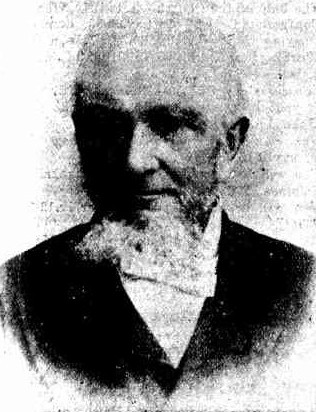 THE LATE MR. W. H. McKEOWN. [photo]
THE LATE MR. W. H. McKEOWN. [photo]
Mr. McKeown arrived in Sydney early in the year 1840, being then a lad of 19 years of age. He came from Ireland, and brought with him the sturdy qualities of the typical North of Ireland stock. His early attempts at finding a footing in Australia were associated with the care of 'Government men,' an employment from which he shrank, and which he speedily gave up. One temporary job succeeded another, in which his self-reliance and power of adaptation were tested and developed.
About the year 1845 he accepted an engagement in connection with a newly-planted orangery in what is now called Pymble, and thither, with his young wife, he removed. Crossing from Sydney to the northside of the harbour, he found there was no made road to what was then the distant bush. He had to find his way through a dense forest, simply following dray tracks through the bush. A few bark huts at intervals along the way, the abodes of sawyers and wood getters, were the only signs of occupation of the territory where now stand the thriving suburbs of North Sydney, Chatswood, Roseville, Lindfield, and Gordon. Arrived at Pymble, there was a house licensed to sell beer only, an old wooden church, which served also as a school, and a public-house, where all sorts of drink, were sold. A gang or two of 'Government men' were employed hereabout, and timber-getting as the principal occupation. Orcharding on a small scale was also being attempted.
For over half a century Mr. McKeown lived in the district, and witnessed its emergence from the primitive conditions in which he found it to one of the most popular and thriving of all the environs of the city of Sydney. The record of his personal struggles interesting enough to form the subject of a popular autobiography. The path of the early settler was beset with many difficulties. Droughts were interspersed with terrific hailstorms, the latter of which occasionally stripped the orchards and rendered them comparatively unproductive for years. Labour troubles even then in evidence although unions and strikes had not been invented. The discovery of gold caused a stampede to the west of the Blue Mountains, labourers, clerks, shop-keepers, and even lawyers forsook their wonted employ to find their El Dorado at the Turon and Tambaroora. Mr. McKeown sufficiently caught the fever to take two trips across the mountains, but it was rather as a chartered driver in charge of organised parties, under contract for a consideration, than as a gold-seeker on his own account. He never believed in sudden roads to wealth, and never found one for himself. From the first Mr. McKeown was interested in the religious welfare of the district, and laboured personally earnestly to promote it.
An old stone building stands on the Gordon-road, in Gordon, now as a store, which was the first substantial edifice for public worship erected north of North Sydney. It was built in the early fifties, at a cost of £850, and served also as a schoolroom, with master's quarters attached. For many years this was known as "Lane Cove" Chapel, and was served by ministers from the York-street Methodist Church, and by local preachers, of whom Mr. McKeown soon became one. The debt on it fell principally on its promoter's shoulders, and quaint are the tales he used to tell of the devices resorted to to meet the interest and reduce the debt. Zeal and self-denial eventually overcame all difficulties. 'Revivals' were frequent, and delighted the heart of the earnest man who was set upon the spiritual welfare of his neighbours. As population increased and spread, other 'chapels' were built at Willoughby, Hornsby, Pittwater, and other places, these being the pioneer places of worship in their respective neighbourhoods.
As long as strength lasted Mr. McKeown continued his voluntary labours as a lay preacher, and at the time of his death he was probably the oldest local preacher in Methodism in Australia. Apart from his special interest in Church matters, Mr. McKeown was a good citizen in respect of the interest lie took in the social and material welfare of the district. He introduced new and improved methods of fruit culture. As a poultry-raiser he showed what could be done by special strains adapted for egg-production or for table use. He set a high standard of commercial morality, and when on one occasion he assigned his estate — mainly through the failure of others to meet their engagements to him — he subsequently paid most of his creditors in full, although under no legal obligation to do so. He was an ardent politician, and took a keen interest in public affairs right up to the last. In the, days when candidates were openly nominated on nomination day, he was frequently chosen to 'propose' a candidate from the hustings, and. his local influence was such that his candidate usually topped the poll. For a period he served as an alderman in the City Council, when he was carrying on business as a wood and coal and fruit merchant in Sydney. More than once he was asked to stand for' Parliament, but he could never be persuaded to become a candidate. His house was ever a 'centre' of kindly hospitality, and the record of those who have sat at his table or slept under his roof at Roseville, Pymble, where he resided for over half a century, would be interesting as including ecclesiastics of all Churches, politicians of all hues, and commercial men from all the States and from over the seas. Since 1880 the North Sydney district has witnessed a wonderful development, and has become one of the most popular of all the residential areas of the metropolis. The Milson's Point-Hornsby railway line, has been the principal factor in bringing this about, and in securing the construction of the line Mr. McKeown took a leading part. Public meetings and deputations were organised by him, in conjunction with a few others, and successive Ministries were importuned until the work was put in hand, and at length carried to completion by the extension right to Milson's Point. With this the veteran's public work seemed to come to an end, and shortly after attaining his80th year he removed from the scene of his half century's labour to reside in quietude at Summer-hill. On leaving, he was made the recipient of several demonstrations evincing the esteem and appreciation entertained for him and his wife (who survives him)by the residents among whom they had lived so long and usefully. A family of 10 children and between 50 and 60 grandchildren, with several great-grandchildren, is the best legacy the venerable pioneer has left to the State. His sons are Rev. R. McKeown, of Waverley; Mr. G. M. McKeown, of Wagga Wagga Experiment Farm; Mr. J. McKeown, of the Civil Ambulance Corps; Mr. W. H. McKeown, of Ashfield; and Mr. E. McKeown, of Belford. His sons-in-law are Rev. G.M'Intosh, of Chatswood; Mr. J. G. Edwards, of Kil-ara; Mr. W. Benson, of Waverley; Rev. J. E. Carruthers of Lindfield; and Mr. H. Hazlett, of Summer-hill. THE LATE W.H. McKEOWN. (1912, June 15). The Methodist(Sydney, NSW : 1892 - 1954), p. 3. Retrieved from http://nla.gov.au/nla.news-article155458683
Deaths. FRENCH.—March 2, 1893, at his residence, Alpha-road, North Willoughby, James Harris French, aged 74 years. Family Notices (1893, March 3). The Sydney Morning Herald (NSW : 1842 - 1954), p. 1. Retrieved from http://nla.gov.au/nla.news-article13899650
The Friends of the late JAMES HARRIS FRENCH are respectfully invited to attend his funeral to move from his late residence, Alpha-road, North Willoughby, TOMORROW, (Saturday) MORNING at 10am and proceed to Wesleyan Cemetery, Chatswood. Higley, Undertaker, Miller-street, St. Leonards.
The Friends of Mrs MARY FRENCH are respectfully invited to attend the Funeral of her deceased HUSBAND, the late James Harris French; to move from his residence, Alpha-road, North Willoughby, TOMORROW, (Saturday) MORNING, at 10 am and proceed to Wesleyan Cemetery, Lane Cove Road. Family Notices (1893, March 3). The Sydney Morning Herald (NSW : 1842 - 1954), p. 10. Retrieved from http://nla.gov.au/nla.news-article13899730
Colonial Secretary's Office,
Sydney, 30th May, 1865.
PETITION UNDER THE MUNICIPAL ACT.
WILLOUGHBY.
IN pursuance of the Act of the Colonial Parliament, 22 Victoria, No. 13, His Excellency the Governor, with the advice of the Executive Council, has directed the publication of the substance of a Petition addressed to His Excellency, as hereinafter set forth, signed by sixty-seven householders, resident in the rural District of Willoughby, praying for the erection of their locality into a Municipality.
CHARLES COWPER.
The Petitioners state that the number of inhabitants of the rural District hereinafter defined, amounts to four hundred, and that it is desirable that the said District should be declared a Municipality, by the name of " North Willoughby,"— the boundaries of which are as follows : —
Commencing in Long Bay, Middle Harbor, parish of Willoughby, County of Cumberland, at the junction of a fresh water creek, at the eastern point of James Yates' 5| acres and James William Bligh's 3| acres; and bounded on the south-west by that creek to the south-west corner of Archibald Mossman's 34 acres; thence by a line bearing south-west to the source of a creek dividing Wright's 29 acres and Woolstoncroft's 525 acres; thence by that creek to a bay, and by the bay and the waters of Port Jackson running westerly, and by Lane Cove Creek to the head of Blue Gum Creek; and thence by the dividing boundary line of the parishes of Willoughby and Gordon to Middle Harbor; thence by the waters of Middle Harbor to the point of commencement.
And the Petitioners pray as follows, viz.:—" That "your Excellency will be pleased to declare the said rural District, within the limits and boundaries hereinbefore set forth, to be a Municipality, " by the name of ' North Willoughby.' "
T. C. Ludowice James Medlyn William Smith John Collins John Boyle Andrew Smith Thomas M'Clelend William Martin Albert Batke G. H. Chalk James Reid James Bereyen Edwin Rannard Henry Russell James Snow ( John Scholfield William Pollard William Donnelly Richard Horsley T. T. Allard George Woolland George Jones Hugh Haron Peter Corkin Alexander Casher James Mills Francis Bellman David Etherington George Trickett Alexander Wallace John Jones Smith Bennet Michael Smith B. Carnett Thomas Adamson Joseph Cox Richard Johnson John Cropley Jacob Holland Donald Carmichael Thomas Foote, senior Joane Howard Thomas Foote, junior John Williams Francis Stack George Green William Purnell Heinrich Kulman H. H. Bligh John Rogers Emuel Dew Edward Anderson William Watts Thomas Connelly Jethro John Pearse Charles Andie William Reynolds Connell Linsley John M’Millan James Cook John Armitage Edward Lee Edward Carr Matthew Simpson Timothy Cuick James French James Welch
SYDNEY: Printed and published by Thomas Richards, Government Printer, Phillip-street, 30th May, 1865. PETITION UNDER THE MUNICIPAL ACT. (1865, May 30). New South Wales Government Gazette (Sydney, NSW : 1832 - 1900), p. 1161. Retrieved from http://nla.gov.au/nla.news-article225851571
Borough OF NORTH WILLOUGHBY.
NOTICE is hereby given, that James Peter Best and James Harris French have been duly elected Aldermen, and John Silvester Ryan and William Cochran, Auditors, for the above Borough.
H. H. BLIGH,
14th February, 1871. Returning Officer. BOROUGH OF NORTH WILLOUGHBY. (1871, February 21). New South Wales Government Gazette (Sydney, NSW : 1832 - 1900), p. 409. Retrieved from http://nla.gov.au/nla.news-article224330622
North Shore Hospital. — The monthly meeting of the committee of this hospital was held last evening at MTntyre and Homing's rooms, Walker-street. Mr. A. W. Green presided, and there were also present Mrs. Mordnunt Clarke, Dr. D. Clarke, Messrs. J. Harding, Carter, J. Crowley, F. W. Syor (Hon, sec.), and F. Smith (hon, treas.).
A letter was received from Mr Doyle, head master of Mosman public school, enclosing the sum of £1 6s, being the proceeds of a dolls' bazaar held by several little girls at Mosman's Bay. Mr. J. H. Clayton solicitor, forwarded a copy of the will of the late James Harris French, by which the testator devised his farm at Willoughby, consisting of about 20a., to his trustees upon trust to permit his (testator's) wife to have the use thereof for her life, and after her death upon trust to sell the land, and, after payment of all expenses, to pay the proceeds to the treasurer of the hospital for the use of the hospital.
The treasurer reported that the receipts since last meeting amounted to £17 8s, and expenditure to £126 15s, there being now a credit balance of £311 16s. The matron's report showed that at date of last meeting there were 10 in the hospital, since admitted 16, left hospital 12, died 1, now under treatment 13. Mesdames Partridge and Dibbs, and Messrs. J. Crowley and T. E. Cresswell, were appointed a visiting committee for the coming two months. LADY JERSEY "AT HOME." (1893, August 11). The Daily Telegraph (Sydney, NSW : 1883 - 1930), p. 4. Retrieved from http://nla.gov.au/nla.news-article236030760
and closed by James French, an old Government ranger, the original holder of 'French's Forest,' who lived then at 'Paradise.' on part of what Is now known as Northbrldge. The old residence is still standing just off French 's-road. WILLOUGHBY'S JUBILEE (1915, October 23). Evening News (Sydney, NSW : 1869 - 1931), p. 8. Retrieved from http://nla.gov.au/nla.news-article115269384
CASE of FORCIBLE ENTRY on DISPUTED PROPERTY.
At the Water Police Court, yesterday, before Mr. Marsh, P.M., and Captain Edwards, six persons, named respectively Harry Waterhouse, Thomas Waterhouse, Richard Green, Peter Wallace, John Simpson, and Edward Brezer, wore summoned to answer a complaint of forcibly entering upon and taking possession of certain lands known as the Artoman Estate, situated in the parish of Willoughby, North Shore, in the possession of Mr. Alexander Stuart, M.L.A.
Mr. William Roberts appeared on behalf of Mr. Stuart, and Mr. Pilcher (instructed by Mr. W. H. Way) appeared for the defendants.
Mr. Roberts having briefly opened the case, the following evidence was adduced for the prosecution :-
Henry Pike deposed that he was in the service of Mr. Alexander Stuart on the 3rd December on the Artoman Estate, situate at North Willoughby ; there was a house on the land, and the land was enclosed by a two-rail fence ; he had been in charge of the property on behalf of Mr. Stuart for nearly three years ; put a man named Smith Bennett to reside in the house ; did not give any of the defendants possession or permission to enter on the land on the above date ; on the morning of the 3rd December, witness, Lawrence Dwyer, James Neagle, and Smith Bennett were all present on the property, in the interest of Mr. Stuart ; there were other men cutting timber on the enclosed ground for Mr. Stuart ; whilst witness and the other three servants of Mr. Stuart were at breakfast in the house that morning, the defendant Richard Green made his appearance within the enclosure, and close to the house ; witness asked Green what he wanted, to which the latter replied-"If you wait awhile you will see some sport."
After the lapse of half an hour, the remainder of the defendants, with others, came on the ground ; did not say anything to them, as he was alarmed; Thomas Waterhouse ordered him off the ground, saying, "I won't lead you off, I will kick you off : don't let me see you here any more." Witness walked to the fence, fearing that he might be roughly handled; the intruders, numbering 10 or 12, then proceeded to one corner of the house, and Green, with four others, tried to lift it from its foundations, the house being a wooden one ; they tried to lift it so that they could remove one of the supports and let it down bodily, with the man Smith Bennett, the caretaker, inside . Smith Bennett had locked the door from the inside, and was in bed at the time ; before they interfered with the house at all, Thomas Waterhouse said to Smith Bennett, " If you don't come out we will smoke you out ; " failing to raise the house the defendant Henry Waterhouse commenced pulling down the walls assisted by three of the others ; as soon as they got two boards off they went inside and knocked the house completely down, Smith Bennett "being inside at the time, and even until the roof fell; four of the defendants carried Smith Bennett out on his bed on to an adjoining land the defendants took the materials of the house away-: they did not seem to be under the direction of any one, but they were all acting together; it was impossible for the servants on the ground to prevent them ; had seem them on the land on several previous occassions ; five or six days previously- there were 16 or 17 of them present ; on that occasion Thomas Waterhouse threatened him ; and he heard him tell the others that "if they found him on the ground again, to chop his legs off;" two or three days afterwards he was subjected to personal violence at the hands of two men employed by Thomas Waterhouse: he said to Waterhouse, -'Are you going to allow this?" Waterhouse answered, " Yes, give it him ; " he was roughly handled, and had black eyes tor a week afterwards ; Mr. Wilson, a relative of Mr. Stuart, was also assaulted on the ground ; as soon as witness got clear of them he ran away, as he was afraid he would be killed; there were six altogether in the interest of Mr. Stuart, but three of them ran away at once ; the Artoman estate formed the subject of an action in the Supreme Court recently.
To Mr. Pilcher : Did not hear Waterhouse say on the 3rd December that he was there in the assertion of a right, and that no one would be hurt : when the house was pulled down, Waterhouse said they were Barayene's men, Barayene being an agent or tenant of Mr. Thomas Broughton.
William Edward Wilson deposed that he did not give any any of the defendants permission to enter on the land; about a week previous to the 3rd December he asked Thomas Waterhouse if he had any authority from Mr. Broughton to come there ; Waterhouse said, " No ; that he had brought his dray there to cut some poles ; " on the 1st December a lot of "men appeared on the ground, led by Thomas Waterhouse ; the men surrounded the dray, and pulled the timber off the dray-; the horse started, and witness was thrown off the dray; he was subjected to personal violence ; he was there to take the names of the intruders, and warned them that it was against the Act to enter upon enclosed lands.
The main facts, as given above, were corroborated by Smith Bennett, and Joseph Dwyer.
Alexander Stuart deposed that he was a merchant; Edward Wilson acted as his agent for the property known as Artoman, lately in the occupation of Smith Bennett ; the property was fenced in, about the year 1877, and continued to be, up to the present time; the cottage which was knocked down, was built at his expense in 1877 ; he came into possession in May, 1877 ; at the time of the building . of the cottage and the fence being put up, he did not meet with any interruption from anyone ; he had Pike in possession "before the fencing was completed or the cottage built ; Pike was his servant ; Mr. Mackenzie occupied the cottage some time during the present year ; Smith Bennett occupied it after Mackenzie ; he was in possession for him, and on his behalf; Edward Wilson was the authorised agent for him in the management and in the letting of the property ; he did not give the defendants or any other person permission to enter upon the property or to knock down the cottage.
To Mr. Pilcher : The original grant of Artoman was to William Gore; William Bligh Gore was son of William Gore; Gore's Farm, or Gore's Hill, was a different property to Artoman; he believed both William Gore, the grantee, and William Bligh Gore, the son, were in possession of Artoman ; the fence was built in 1877 and cut down by Barayene in 1879 ; he brought an action about that; it was tried on the l5th, 16th, and 17th November last, and the verdict was for defendant ; he had given notice of a new trial.
James Barayene deposed that he had known Artoman for about twenty-three years ; he had the estate twelve or thirteen years ago, and had been in possession up to the present time ; held it from Mr. French till his death, six years ago, and then took it from Mr. Broughton ; had held it from Mr. Broughton up to the present time ; had undisturbed possession until Mr. Stuart came in 1877, when Mr. Stuart had him carried off by six men daily; the defendants were his men; he engaged them, and paid them to prevent Mr. Stuart's men stealing his wood and axes ; he told the men to pull down the shanty on the 3rd December, and also before that ; he said that it must go down.
Thomas Broughton, who gave evidence for the defence, deposed that Artoman was 150 acres in extent, comprised in what is called the Gore estate ; he lent James Naimby Shuttleworth £2000 in 1856 : a few days afterwards, he (Broughton) became the mortgagee in posession of the Gore estate, including Artoman : placed William Bligh Gore in possession of the estate as his agent, and for his trouble in taking care of the estate he was to have the privilege of cut-ting and selling wood; shortly afterwards, Mr. James Naimby Shuttleworth became insolvent ; Mr. John Morris was appointed his official assignee : in the year 1861 he purchased from the official assignee the whole of the assets in the estate of James Naimby Shuttleworth ; in January, 1862, he went over the estate in company with Bligh Gore and James Kingcott; Bligh Gore still continued in possession of Artoman as his agent, and at that time there was no residence of any- kind on the Artoman Estate ; in the year 1863 Mr. Bligh Gore died, and James Barayene became his tenant; James Barayene accounted to Mr. French, as his agent, for the rent ; Mr. French was agent for him (Broughton) after the death of his uncle, Wm. Bligh Gore ; in the year 1864 his attention was called to a conveyance from John Boyle to Patrick Freehill, in the office " of Allen, Bowden, and Allen. In consequence of seeing that conveyance, he went over to the Artoman Estate, in company with Alderman Charlish and his son to see if there were any persons trespassing on Artoman ; he found Owen Boyle, brother of John Boyle, there ; Boyle said he was there on his own account; Barayene had been acting for him (Broughton) ever since he conveyed some small farms on Gore's estate to French, and had been his tenant for 17 years; he had been in sole possession, by himself or through his agents, since 1858 ; he never conveyed away any portion of the Artoman estate ; he had the Crown grant for Artoman in his possession for 24 years, having received it, with other documents, from Sir. Robert John-ston, attorney for Mr. Shuttleworth, at the time he took the mortgage ; had never heard of a registered conveyance to Boyle ; he heard there was a lease from French to Barrayene ; he claimed Artoman under Wm. Bligh Gore.
Several other witnesses having been called for the defence, to prove that when they went on the property they were put off by force.
Mr. Pilcher briefly addressed the Bench, and pointed out that anything the defendants did on the property could not be held to be forcible entry, inasmuch as Mr. Broughton, through his agents or servants, was in possession of the estate. Mr. Stuart was not, either in statute or at common law, seized in fee, and consequently, in erecting the house on the land or putting up the fencing, he was a trespasser.
Mr. Roberts, on the other hand, contended that Mr, Stuart was in peaceable possession and occupation of the property at the time of the forcible entry. He also urged that it was immaterial whether the estate was a property belonging to the prosecutor by right or by wrong, for even if the defendants had a right of entry, the mere fact ot their asserting that right with a strong hand or with a number of people, was equally an offence as if they had not that right.
The Bench decided that the case was one for the higher Court, and accordingly committed the defendants one and all to take their trial at the next Criminal Sessions, to beholden in February.
The defendants were allowed, and obtained, bail. CASE of FORCIBLE ENTRY on DISPUTED PROPERTY. (1880, December 24). The Sydney Morning Herald (NSW : 1842 - 1954), p. 6. Retrieved from http://nla.gov.au/nla.news-article13479742
In the Supreme Court of New South Wales.
PROBATE JURISDICTION.
In the will of James French, late of Granchester, near Mundoorau, in the Colony of New South Wales, farmer, deceased.
APPLICATION will be made, after fourteen days from the publication hereof, that probate of the last will of the above named deceased, may be granted to George French and Mary French, the executor and executrix respectively named in the said will.
WILLIAM MARTIN,
Proctor for the Applicants,
33y his Agent.—R. B. Asher, Coonabarabran.
17,0'Connell-street, Sydney. PROBATE JURISDICTION. (1896, December 22). New South Wales Government Gazette (Sydney, NSW : 1832 - 1900), p. 9199. Retrieved from http://nla.gov.au/nla.news-article222832111
Motions, etc.— Exparte William Milson, mandamus; exparte Rowland Baldwin, prohibition; exparte John Hourn, mandamus; In re the bill of costs of Elliott Meyer, gent., one, etc., exparte John Thomson and another, for review of taxation. Special case — In re J. II. Clayton and T. T. Forsyth (executors of Mary French, deceased) and the Stamp Duties Acts of 1880, 188- . and 1894. LAW NOTICES. (1896, July 30). The Daily Telegraph (Sydney, NSW : 1883 - 1930), p. 3. Retrieved from http://nla.gov.au/nla.news-article238592491
Mary Blue Age: 831812–1895
Name Mary Blue
Given names Mary
Surname Blue
Married Name Mary Tiffin
Married Name Mary French
Married Name Mary Tifffen
Birth 1812 64
Sydney City, Greater Sydney, New South Wales, Australia
Source: Ancestry.com. Australia Birth Index, 1788-1922 [database on-line]. Provo, UT, USA: Ancestry.com Operations, Inc., 2010.
Text: Name: Mary Blue
Birth Date: 1812
Father's name: William Blue
Mother's name: Elizabeth
Birth Place: New South Wales
Registration Year: 1812
Registration Place: Sydney, New South Wales
Volume Number: V18122725 1A
Marriage Robert Tiffin - View family 1830 (Age 18)
, , New South Wales, Australia
Source: Ancestry.com. Australia Marriage Index, 1788-1950 [database on-line]. Provo, UT, USA: Ancestry.com Operations, Inc., 2010.
Text: Name: Robert Tiffin
Spouse Name: Mary Blue
Marriage Date: 1830
Marriage Place: New South Wales
Marriage James Harris French - View family 1842 (Age 30)
Sydney City, Greater Sydney, New South Wales, Australia
FRENCH.- March 27, at the residence of Mr. G. Montgomery, Christie-street, Willoughby, Mary French, aged 85 years. Family Notices (1895, March 28). The Sydney Morning Herald (NSW : 1842 - 1954), p. 1. Retrieved from http://nla.gov.au/nla.news-article14000553
George Montgomery
THE RELATIVES and FRIENDS of the late Mrs. MARY FRENCH are kindly invited to attend her Funeral, which will leave the residence of Mr. G. Montgomery, Christie-street, Willoughby, near St. Leonards station, THIS (Thursday) AFTERNOON, at a quarter past 3 o'clock, for St. Thomas' Cemetery, St. Leonards. WOOD and COMPANY, Telephone No., 726. Undertakers and Embalmers.
THE FRIENDS of Mrs. S. SCHOFIELD are respectfully invited to attend the Funeral of her beloved AUNT, Mrs. Mary French ; to move from her late residence, Christie-street, St. Leonards, THIS (Thursday) AFTERNOON, at 3.30, to St. Thomas' Cemetery. WOOD AND COMPANY, UNDERTAKERS and EMBALMERS, Sydney (799 Geo.-st.), Balmain, Petersham, St. Leonards, and Pyrmont, Telephones : 726 Sydney, 5 B'main. 22 P'sham. 9 N. Syd. Family Notices (1895, March 28). The Sydney Morning Herald (NSW : 1842 - 1954), p. 8. Retrieved from http://nla.gov.au/nla.news-article14000633
WATER POLICE COURT.
MONDAY.
BEFORE Mr. H. H. VOSS, Mr. J. B. Smithers, and Mr. A. Thompson.
James H. French, charged with using threatening words to Mary French, his wife, was ordered to find sureties to keep the peace for six months. WATER POLICE COURT. (1868, December 29). The Sydney Morning Herald (NSW : 1842 - 1954), p. 3. Retrieved from http://nla.gov.au/nla.news-article13178009
Family with parents
Father
William "Billy" Blue 1748–1834
Mother Elizabeth Williams ?–1824
Elder Sister Susannah Blue 1805–1861
Elder Brother William Blue 1807–1841
Elder Sister Elizabeth Blue 1809–?
Herself Mary Blue 1812–1895
Younger Brother Robert Blue 1814–1872
Younger Brother John Blue 1815–1891
FUNERAL.-The Friends of Mr. W. CHUTER are respectfully invited to attend the Funeral of his late departed Wife, SUSANNAH, to move from her late residence, Billy Blue Inn, North Shore, on FRIDAY AFTERNOON, at 3 o'clock. No circulars will be issued. THOMAS DIXON, undertaker. Family Notices (1861, February 7). The Sydney Morning Herald (NSW : 1842 - 1954), p. 8. Retrieved from http://nla.gov.au/nla.news-article13052296
William "Billy" Blue
Born about 1748
Immigration 14 December 1801 (Age 53)
Sydney Cove, Greater Sydney, New South Wales, Australia
Source: State Library of Queensland. Convict Transportation Registers Database 1787-1867 [database on-line].
Citation details: Australian Joint Copying Project. Microfilm Roll 87, Class and Piece Number HO11/1, Page Number 291 (145)
Text: William Blue, one of 297 convicts transported on the Nile, Canada and the ship Minorca, June 1801.
Sentence details: Convicted at Kent Quarter Sessions for a term of 7 years on 04 October 1796.
Vessel: Nile, Canada and Minorca.
Date of Departure: June 1801.
Place of Arrival: New South Wales.
Source: Bateson, Charles. The convict ships 1787-1868. 2nd ed. Glasgow : Brown, Son & Ferguson Ltd., 1985 ie 1969
Citation details: p. 338
Text: The ship Minorca arrived in NSW 14 Dec 1801
Marriage Elizabeth Williams - View family 1805 (Age 57)
Sydney City, Greater Sydney, New South Wales, Australia - On 27 April 1805, they were married at the old St. Philip's Anglican church in Sydney, where 5 of their 6 children were later christened. Source: Ancestry.com. Australia Marriage Index, 1788-1950 [database on-line]. Provo, UT, USA: Ancestry.com Operations, Inc., 2010.
Text: Name: Elizabeth Williams
Spouse Name: William Blew
Marriage Date: 1805
Marriage Place: New South Wales
Registration Place: Sydney, New South Wales
Registration Year: 1805
Volume Number: V A
Census November 1828 (Age 80) Seven Hills, Greater Sydney, New South Wales, Australia
Source: Census of New South Wales November 1828, ed. by Malcolm R. Sainty and Keith A. Johnson. Sydney: Library of Australian History, 1985 ie. 1980
Text: Blue, Robert, 16, born in the colony, Protestant, weaver for Simeon Lord, Botany
Blue, John, 13, born in the colony, Protestant, weaver for Simeon Lord, Botany
Blue, William, 80, free by servitude, Minorca, 7 years, Protestant, landholder, Hunters Hill
Blue, William, 21, born in the colony, Protestant
"Blues Point" Blues Point, Greater Sydney, New South Wales, Australia
Source: Website - Wikipedia, the free encyclopedia
Text: Blues Point was named after Billy Blue, a convict who arrived in Sydney on the Minorca on 14 December 1801, transported for stealing a bag of sugar. Physically imposing, he was described as a "strapping Jamaican Negro 'a very Hercules in proportion' with a bright eye and a jocular wit".
He claimed to have served with the British Army in the American War of Independence. When he arrived in 1801 he only had two years of his sentence left and he was soon working on the harbour with boats and selling oysters. His friendly manner and humorous conversation made him popular and he became a notable local character.
He married English-born convict Elizabeth Williams in 1805, and in 1807, was the only person licensed to ply a ferry across the harbour. Governor Macquarie named him "The Old Commodore" and he ran his ferry dressed in a blue naval officers coat and top hat. His ferry service grew to a fleet of 11 vessels, and in 1817, Governor Macquarie granted Billy Blue 80 acres (320,000 m2) at what is now Blues Point. He died in 1834 at his North Sydney home.
.jpg?timestamp=1616546219580)
Billy Blue's Cottage & the Harbour W. Moffitt sculp. Iteme00350_0068_m (77) ,from album 'Photographs Illustrating the Earliest Times of New South Wales' ca. 1880-1889 (copy photoprints of earlier works, 1770+), courtesy Dixson Library, State Library of New South Wales
Text: Elizabeth Williams, one of 338 convicts transported on the Coromandel and ship Experiment, November 1803.
Sentence details: Convicted at Hants. Quarter Sessions for a term of 7 years on 11 July 1803.
Vessel: Coromandel and Experiment.
Date of Departure: November 1803.
Place of Arrival: New South Wales.
Source: Bateson, Charles. The convict ships 1787-1868. 2nd ed. Glasgow : Brown, Son & Ferguson Ltd., 1985 ie 1969
Citation details: p. 338
Text: The ship Experiment I arrived in NSW 24 Jun 1804
William (Billy) Blue (c.1767?-1834), convict, settler and ferryman, was born possibly in Jamaica, New York City. As he later claimed to have served with the British army in the American war of independence, he may have been a freed African-American slave from colonial New York. By 1796, however, he was living at Deptford, London, and working as a chocolate-maker and a lumper (labourer) in ships in the River Thames. On 4 October that year at Maidstone, Kent, Blue was convicted of stealing raw sugar—presumably intended for confectionery making—and sentenced to seven years transportation. After over four years in convict hulks, he was transported to Botany Bay in the Minorca. He was described in convict records as 'a Jamaican Negro sailor', aged 29 in 1796.
Reaching Sydney on 14 December 1801, Blue had less than two years of his sentence to serve. By July 1804 he was living at The Rocks with Elizabeth Williams, a 30-year-old, English-born convict, who had arrived from Hampshire the previous month. They married on 27 April 1805 at St Philip's Church of England and were to have six children. Billy worked as a waterman and collected and sold oysters and other items. He found favour with both government officials and the public, to whom he endeared himself with his whimsical style and banter.
In 1808 his name was included in a list of citizens who supported the arrest of Governor Bligh. Blue was appointed harbour watchman and constable by Governor Macquarie in 1811. These titles enabled him to acquire a new home overlooking Sydney Harbour, which became a local landmark known as 'Billy Blue's Cottage'. Macquarie was a regular user of the ferry services; he reported in his diary in 1817 that his wife and son were taken up the river to Parramatta in Blue's boat. That year Blue was granted a farm of eighty acres (32.4 ha), which he called Northampton, at the southernmost tip of the north shore of Port Jackson. The headland became known as Billy Blue's Point. As a landowner on the north side of the harbour, he saw the potential for operating a boat service to the site and quickly built up a 'fleet of ferries'. Macquarie light-heartedly dubbed him 'Commodore'; Blue became known as 'The Old Commodore'.
The location and business offered opportunities to participate in smuggling. In October 1818, arrested for possessing two casks of rum, he claimed that he had found them floating and lashed them to his boat to return them to the shore. Encouraged by Deputy-Judge-Advocate Wylde to plead guilty and name his accomplices, Blue refused, lost his position as harbour watchman and constable and was imprisoned for a year.
In 1823 Edward Wollstonecraft and William Gore, both landholders on the north shore with vested interests in harbour trade, attempted to oust Blue from his land and ferrying service, alleging that he was a law-breaker who regularly smuggled goods and harboured escaped prisoners. In response Blue petitioned Sir Thomas Brisbane that, in view of his long and trusted service for the government, he should be granted 'in his old age the peaceable enjoyment of his premises and ferry'. The governor found in his favour, authorizing him to 'have the Use and Occupation of his ferry, which he formerly occupied between his farm in Northampton and Sydney'.
Elizabeth died in 1824. In the 1828 census Blue gave his age as 80. Described by (Sir) James Dowling as 'an eccentric, loquacious character', he took to donning a travesty of a naval uniform, with a top hat, and would board newly berthed vessels as 'commodore' to welcome the officers to Sydney. Brushes with the law continued. He was found guilty of harbouring an escaped convict and of manslaughter—when he threw a stone at a boy who was tormenting him and the youth later died—but avoided prison. By 1833 he and his family were reported as keeping a ferryboat and cultivating vegetables and fruit for the Sydney market.
Blue died on 7 May 1834 at his North Sydney home. His will, which he signed with a mark, left his property to his surviving three sons, including William junior, and two daughters. Streets in North Sydney were named after him and the site of his northern ferry terminus remained known as Blues Point. The Mitchell Library, Sydney, holds several portraits of him, including an etching by Charles Rodius, a lithograph of 'The Old Commodore' by John Carmichael and an oil painting by J. B. East.

DIED, On Tuesday last, at his residence, North Shore, WILLIAM BLUE, aged 97. Family Notices (1834, May 8 - Thursday). The Sydney Gazette and New South Wales Advertiser (NSW : 1803 - 1842), p. 3. Retrieved from http://nla.gov.au/nla.news-article2216083
BILLY BLUE
I knew him well, Horatio; a fellow of excellent wit—
Where now be they flashes of merriment which were wont to set the [old hands] in a roar?
Quite, quite chop-fallen! - Hamlet
So the gallant "Old Commodore" has for ever laid aside his truncheon of command. He died at his Villa, on the North Shore, on Tuesday. The reign of Billy is coeval with the foundation of the Colony, and the remembrance of the whimsicality of character which grew with him as he advanced to the end of his earthly pilgrimage, will be long treasured in the minds of the present generation, when the minions of ambition are forgotten in the dust. Billy's public avocations were not always such as to bring him under the particular observation of the illustrious Officers who have from time to time administered the Government ; but what his talents in business would probably have for ever denied to him, was procured by his singular humour and excellent disposition. When the "high and mighty" aristocrat was spurned for profligacy and ambition from the threshhold of Government house by the lion-hearted and injured Macquarie, poor Billy found there a welcome. As a public functionary, Billy had not the fortune to evade, like his betters, the informers of the day, or enrich himself by the profits of his avocation ; for at that time ever official was a trader, a retailer of rum, tobacco, and lolly-pops. Billy did his best to smuggle—but some-how or other he was detected, and forfeited his situation in the domain. His hilarity was but little abated, however, by a circumstance which would have weighed down the good humour of most people. He still walked about, noticed by and noticing every one, and woe-betide the man or woman, high or low, who did not honour the "Commodore" with a proper salute. The good old Governor (Macquarie), never long withdrew his countenance from the sable veteran ; and when he did so, from a high sense of public duty, Bdly still found a steady friend in his peerless lady, who by obtaining even a distant smile from the Governor, to the disgraced smuggler, brought back to his heart that joy which he must have previously abandoned.
Seeing him at length likely to be without a shelter for his head, and anxious to give the children a home, Macquarie settled the Commodore on a point of ground on the northern shore of Port Jackson, which was given under, we believe, certain conditions depriving him or his family of the right to sell it. It was in fact a sort of entailed estate for his descendants. Here Billy was not exempt from the "iron hand of adversity," for he was incarcerated through a runaway prisoner of the crown being discovered in his house, and became only restored to liberty by the liberality of the late Mr. Pitman, who discharged the fine. Who ever saw the Commodore out of humour?
He might have purveyed for an army. And who ever saw him return home with an empty bag? Fish, flesh, fowl, cheese, butter, wine, porter, and ale, might be there seen in glorious confusion, borne on the shoulders of the humorous old Billy, to whom even the very urchins lifted their caps in token of respect. "No rows!" " Go—go, my child—true blue for ever," now and then found utterance as the obsequious citizens struck their ensigns to the Commodore; and if they did not (and the eye of Billy was always at work), the whole street would ring with his screams and abuse. "You brute—you long-legged brute—forget the Commodore !" and his stick would ring upon the stones in cadence to the melodious sound of his sweet voice, invoking vengeance on the recreant. But Billy's nature changed the general levity of his manner on Sunday. Though the same respect was shown to him by men of all ranks and degrees, his voice would not on that day be heard beyond a whisper "We are all going down, remember the worship of God my child," was the homely serious caution of one who, with all his bantering, never forgot the duties of a good christian ; and who on that holy day seldom, health and weather permitting, absented himself from Divine worship.—Requiescat ! "We may never look upon his like again."
BILLY BLUE. (1834, May 8). The Sydney Gazette and New South Wales Advertiser (NSW : 1803 - 1842), p. 2. Retrieved from http://nla.gov.au/nla.news-article2216088
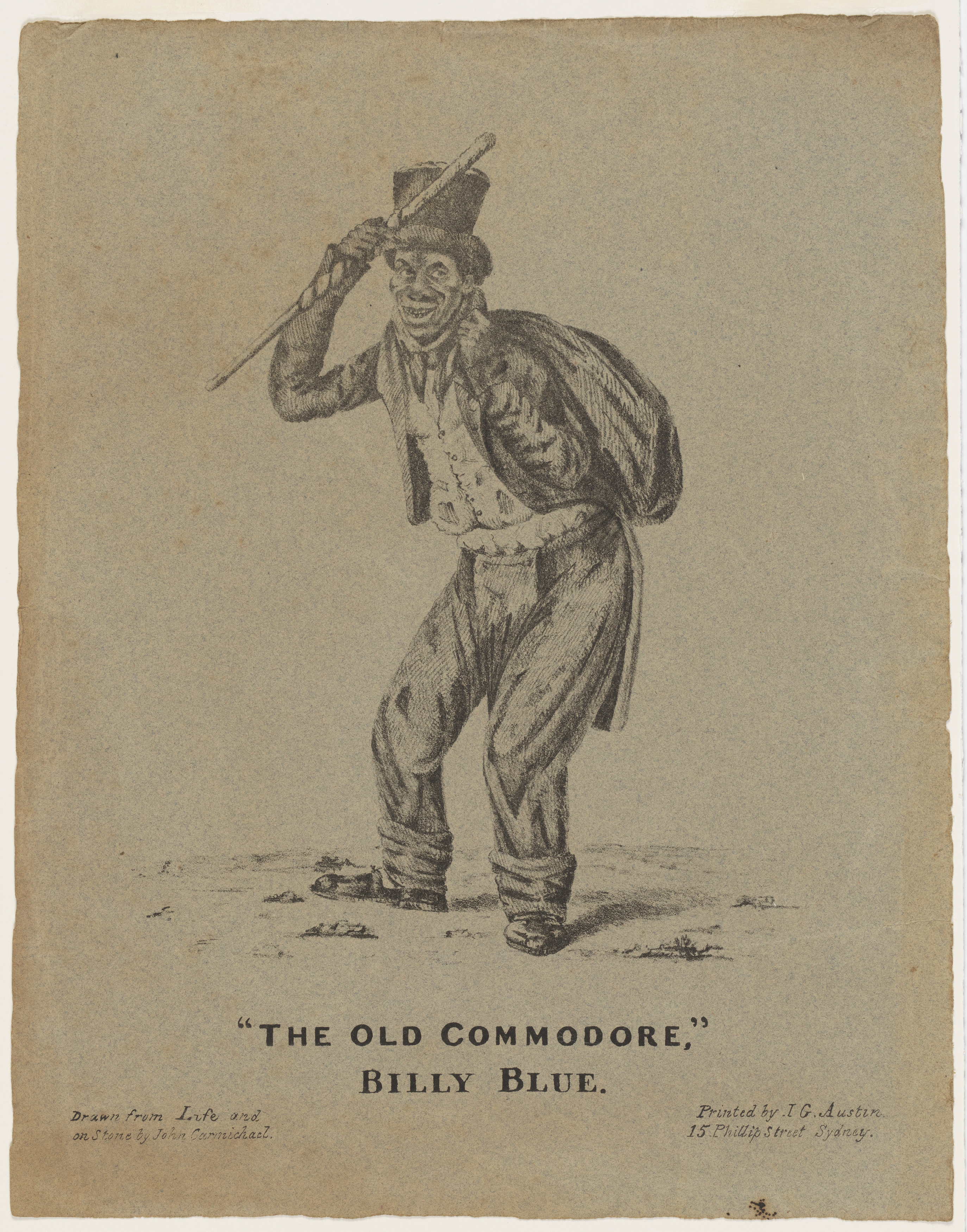
A portrait of 'The Old Commodore', Billy Blue, ca. 1834 / drawn from life and on stone by John Carmichael, Item 88010600, courtesy State Library of NSW
In 'Old Sydney,' 24/12/11, I was in error respecting the parentage of Mrs. Chuter, who died in the first sixties. Mrs. Susannah Chuter was a daughter, not a granddaughter, of the original William Blue, and was born, if 54 years of age at her death, in 1807. This would be in Governor ' Bligh's time. She married George Lavender, the boatswain of the Phoenix Hulk, ' which lay in 'Hulk' Bay, now known as Lavender Bay.
On Lavender's death she married William Chuter, who kept the Billy Blue Inn on Blue's Point-road. On January 24, 1817, Governor Macquarie granted 'unto William Blue, his heirs and assigns, to have and to hold for ever, eighty acres of land lying and situated in the district of Hunter's Hill, bounded on the north by a line cast thirteen degrees, south forty chains, commencing at the mouth of a small run at the bottom of a bay on the north 6ide of Port Jackson Harbor, on the east by a south line of three chains fifteen links to the harbor, and on all other sides by the harbor, reserving the right of watering to shipping.' This was to be held by William Blue, his heirs -and assigns, free from all taxes, quit rents, and other acknowledgments, for the space of five years from the date thereof. There was a proviso against alienation during the said period of five years, and for the cultivation of eighteen acres within the said term, otherwise the land would revert to the Crown. The Government reserved the right of making a road and taking timber. After the said term of five years William Blue and his heirs, &c., were to pay an annual quit rent at two shillings.
By his last will and testament, dated May 2, 1834, William Blue, among other diviees, gave and devised to his son, Robert Blue, 'that portion of his, the said testator's, estate allotted out for him, commencing on the south at William Blue's land, and extending in a north-easterly direction to a Government road, together with the house built thereon, provided that Robert Blue, on taking possession, engaged not to ply a boat for hire as therein mentioned. A desire was expressed in the will that no portion of the land given to William, Robert, Mary, Susannah, and John Blue should either be sold or mortgaged, otherwise to be divided in equal parts among testator's surviving children, share and share alike. William Blue, jun., was appointed executor.
By indenture of demise, dated 1st July, 1836, between the said Robert Blue, of the first part, the said William Blue, Robert Tiffin, and Mary, his wife, George Lavender, and Susannah, his wife, and John Blue (which said William Blue was the eldest son, and the said Mary Tiffin, Susannah Lavender, and John Blue, were three other children of the said William Blue, deceased), of the second part, and Henry Croasdaile Wilson, of the third part, under this indenture, for a sum, as bonus, of £25 to William Blue, and an annual rent of £20, paid quarterly, Wilson (who was third police magistrate, and lived at Miller's Point) got all that piece or parcel of land, situated on the north side of Port Jackson Harbor, in the district of Hunter's Hill, aforesaid, containing thirteen acres, more or less, and bounded on the east by the waters of Port Jackson, aforesaid, on the south by the allotment of the said William Blue, on the north by a creek, and on the west by the Lane Cove-road, on a fifty years' lease. Out of it, however, was reserved an acre adjoining William Blue's allotment, extending from the water to Lane Cove-road (now known as Blue's Point road).
In 1839 Colonel Wilson sold the residue of his lease to Hutchinson Hothersall Browne, who was Immigration Agent, and had other lucrative billets. Mr. Browne was, of course, to continue the payment of £20 per annum to the Blue family, in addition, he gave Colonel Wilson £1000 — one -thousand pounds — as bonus. After being three months 'in occupation Mr. H. H. Browne mortgaged his lease to Mary Ann Ridge, for £600. That was on January 1, 1840. (Ridge-street, North Sydney, is named after the family of this lady. There were several of the name on the Hawkesbury, and at Campbelltown, in the twenties of last century). Mr. Browne had power to pay off this sum on giving six months' notice. This he did on February 27, 1845; and it appears, from a document in front of me, that Mr. Browne at the same time got the fee simple for £100 — that is to say, the sum named, cash down, was considered by the Blue family as a more convenient mode of dealing with the thirteen acres, than waiting until the year 1886 for the expiration of the lease granted to Colonel Wilson. It seems a poor bargain for the Blues, but so it reads. In 1844 John Nepean Mcintosh appears to come in, I think, as a trustee. This gentleman was Admitted a solicitor in 1840, and for a time practised in Sydney, but for many years he was the leading solicitor in Bathurst, and died there at a good old age. And from Mr. Mcintosh's time, up to the present, the original 80 acres grant of Billy Blue has undergone' many, and mighty changes, but the whole story of its alienation, its mortgages and releases, its owners and occupiers, would , take up more space than I can afford to have the whole story in print. OLD SYDNEY. (1912, January 28). Truth (Sydney, NSW : 1894 - 1954), p. 9. Retrieved from http://nla.gov.au/nla.news-article168743164
MELANCHOLY SUICIDE.—It is our painful task to record the suicide of Mr. George Lavender, of Blue's Point, North Shore, which occurred at his residence about half-past six o'clock last evening. The particulars of this tragical event, as they have come to our knowledge, are as follow :—
Our informant was at Mr. Lavender's house at three o'clock yesterday afternoon, when the deceased was getting his dinner in his usual health and spirits. He talked freely, and eat a hearty meal. During the remainder of the day he engaged in his regular business about the house, without his conduct in any respect attracting particular notice in his family. About half-past six in the evening Mrs. Lavender was alarmed by the report of a gun at the rear of the house, and on running out she discovered the body of her unfortunate husband, with his forehead literally blown in, lying on his back in an out-house, and struggling in the agonies of death. The shrieks of Mrs. Lavender brought a plasterer, who was at work in an upper room of the house, immediately to her assistance, but only in time to witness the breath of life pass away from the mangled form of her husband.
The deceased appears to have taken the gun from the house unobserved ; and no reason can be assigned for the perpetration of the dreadful act. He was an old colonist, possessing considerable property and enjoying a large share of respect. His widow is left, we believe, with one child. No title (1851, February 21). Empire (Sydney, NSW : 1850 - 1875), p. 3. Retrieved from http://nla.gov.au/nla.news-article60032868
Coroner's Court.
An inquest was held yesterday afternoon, at the Macquarie Inn, Blue's Point, North Shore, on the body of John George Lavender, there dying dead. The deceased had been suffering, under mental depression for several weeks, and had been known to threaten the commission of this deadly act, yet as no marked symptom of aberration it could be traced, little dread was apprehended that, ht deeply resolved upon so dreadful a project. Upon the jury being sworn-Susan Ann Lavender, a child of about 10 years old, deposed that, between the hour of five and six on the evening of Thursday last, she was startled by the report of a gun, and running "out in the direction whence it had proceeded she found her late father stretched upon the ground in a shed at the side of the dwelling-she immediately alarmed her mother-Susannah, wife of the deceased, corroborated the daughters testimony-her screams brought constable Thompson and others to the spot-Mr. Benson, a surgeon, alarmed that having been called to the deceased, he found him quite dead-with a gun-shot wound in the left eye-the organ itself protruding over the cheek-portions of the brain had also been forced down-the scalp had been riddled as if by shot, and the skull consequently penetrated-death resulted from these injuries-A verdict of suicide, whilst labouring under temporary insanity was returned. The gun was found by the side of the deceased with the ramrod out of its socket, and it is imagined that having placed the weapon in position, he touched the trigger with the ramrod, and so discharged the piece. Coroner's Court. (1851, February 22).Empire (Sydney, NSW : 1850 - 1875), p. 3. Retrieved from http://nla.gov.au/nla.news-article60032920
In the Supreme Court of New South Wales.
ECCLESIASTICAL JURISDICTION.
In the goods of George John Lavender, late of St. Leonards, in the Colony of New South Wales, innkeeper, deceased.
NOTICE is hereby given, that Susannah Lavender, of St. Leonards aforesaid, the widow of the abovenamed deceased, intends at the expiration of fourteen days from the publication of this notice, to apply to this Honorable Court, in its Ecclesiastical Jurisdiction, that letters of administration to all and singular the goods, chattels, credits, and effects of the said George John Lavender, be granted to her.—Dated this twenty-seventh day of February, a. d., 1851.
ALLEN & SON,
Proctors for the said Susannah Lavender, 190, Elizabeth-street, Sydney. ECCLESIASTICAL JURISDICTION. (1851, February 28). New South Wales Government Gazette (Sydney, NSW : 1832 - 1900), p. 370. Retrieved from http://nla.gov.au/nla.news-article230691868
French's Forest : Its History and Romance — Remarkable Aboriginal Carvings
By Maude Kearney-Morgan
THE very mention of a forest conjures up visions of romance, and in some respects there can be no spot in Australia that holds so much that has affected so diverse shades of human life as French's Forest — the magnificent stretch of country, with wonderful panoramic views, situated between Middle Harbour (Sydney) and the coast. Historical records tell how Governor Phillip and his staff explored this region and were favourably impressed by it.
The first white man to think of settling here was Mr. Simeon H. Pearce, who in the early fifties was appointed Commissioner for Crown Lands for the District of Sydney, but his wife would not entertain the idea of living in so wild a place.
Mr. James French, who was special constable and ranger of Crown lands, acquired the two hundred acres. He was a shrewd and unusual man. At that time he lived in the vicinity of Willoughby, in the road that has been named after him. Through French's second wife he came into possession of a good deal of McMahon's Point and Blue's Point. After he left the Government service Mr. French went to live in the forest, and it was ever after called French's Forest. There he had the command of thousands of pounds' worth of timber, stringybark and red gum mostly. The trees were about one hundred feet high and two feet thick, and were needed to supply the settlers on the harbour front with posts and rails for fencing. When split the timber was carted to Bantry Bay, and thence shipped by cutters to any part of the harbour.
An aboriginal carving — probably an eel (14ft long).
Traces of the First Inhabitants
LONG before the timber-getters went to the forest it was inhabited by a race of people who have left, carved upon the rocks, a record of their existence. Nearly three miles from Manly, and almost three hundred feet above Curl Curl Lagoon, is an eminence that commands a vast panoramic view of the coast. It is known as Flat Rocks. Upon the sandstone surface are carvings executed by aborigines. The first drawing reached is apparently intended to represent a whale. It is twenty-four feet long and fifteen high. Then there are fish, kangaroos, wallabies, and human figures. What first occurs to the consideration of the beholder is the crudity of the drawings. When you have examined the set on the French's Forest road near Bantry Bay, and noted that the figures are similar to those at Flat Rocks and have the same type of crudities, one ponders, and the thought comes that perhaps the crudities themselves have a special significance.
THE Bantry Bay carvings are on a plateau of flat rocks, and this site commands a panoramic view inland, as does the other over the ocean. The two most striking figures here are a whale or a shark, sixteen feet long and seven feet high. Close to it is what looks like an eel; or perhaps it is a sea-serpent, for he certainly has a wily look in his eye. There are fish, kangaroos, wallabies, shields, boomerangs, and several human figures from five to seven feet tall. One is holding a large shield and facing another who has a boomerang close to his right hand. One has the arms outstretched horizontally, but most, as on Flat Rocks, have the arms thrown above the head. The feet are generally depicted in the attitude of executing the corroboree dance. None of the faces have any features, the necks are so thick that they are out of all proportion, the knees are angular, and the fingers spiked. Undoubtedly the carvings were intended as symbols of something more than can be read by the uninitiated. Dr. A. Carroll explains that "they are totemic of the tribal myths and laws of a people who have left little else to mark their long occupation of this island continent. . . . Observation has proved that every turn in their lives was guided by a code of native laws regarding not only the action of the individual, but of the families and tribes.
The Forest Mystery
OF a very different nature are the relics left mouldering in a hidden gorge by a modern man of great intellectual achievements. To reach the location, take the turning to the left across Narrabeen Lake. Climb up, up, until you stand high above the tops of the trees in the valley, and the ocean far below looks like a sheet of blue glass studded with emeralds glinting in the sunlight. A little farther on rears the iron gateway of what was once the picturesque residence of Baron von Bieren. Flights of stone steps, flagged courtyards, stone columns — two of these bearing carvings of gunpowder kegs and inscribed 'Advance Australia,' and the two on the opposite side the inscription C. v B. 1884 A.D.— are all that remain of this palatial home built in the wilderness and occupied by a remarkable chemist, who made charcoal from which he extracted gunpowder, and got varnish and gum from the Australian grass-tree. Those who remember 'Ingleside House' in the days when its cultured founder entertained on a lavish scale tell that it resembled a Swiss chalet, having a steeple and an octagonal tower.
The largest carving of the group at Bantry Bay. It is 16ft 6in by 7ft, and is probably intended to represent a shark.
TO-DAY there are only ruins for passing motorists to wonder about. None of these motorists guess that a few hundred yards away, hidden in a secret gorge, is a building of considerable size that represents a mystery to the present generation. One has to see the gorge to have any comprehension of how completely is hidden the large two-story building of nine chambers that are more like halls of entertainment than ordinary rooms. In the year 1924 a sensational article appeared in a Sydney newspaper telling how von Bieren, a German spy, had built in a hidden gorge a mysterious building that was to have been used in the designed capture of Australia. Old residents of these parts treat that story with scorn. They will tell that they knew Baron von Bieren and his wife as Dutch-Americans, and that the lady put £5000 of her own money into the company that was floated by her husband as the Australian Gun-powder and Explosive Manufacturing Com-pany, in which many prominent citizens of Sydney took shares. Perhaps one reason why the company failed was that the Government of the day condemned the works because the cylinders were of iron instead of copper. Von Bieren was ulti-mately sentenced as a fraudulent bank0 rupt to two years and ten months' imprisonment, and died before the expiration of the sentence. Products and Industries
THE forest has been the scene of various industries. As well as timber getting and grass-tree exporting was the making of bricks and potteryware from the local clay deposits. In the early days fish leases were granted by the Government, and tons of fish were taken annually from Narrabeen Lakes and marketed. At Newport a family named Farrell extracted salt from sea-water. In 1888 Mr. Kelly took up a thousand acres on a mineral lease and prospected for coal. He spent £2000, went to a depth of two thousand feet, and did not find coal. Mr. John Coghlan put down a diamond drill, and vegetable gas was found. For six months the works cottage was brilliantly lighted, gas being supplied also for cooking. A company was started, but did not continue, probably because it was reported that where natural gas was used the cost to the consumer amounted to about twopence for each burner, and sevenpence for a cooking stove, per month. The gas company would hardly make a fortune. Warriewood might be termed a city of glass with its hundred glass-houses, each one hundred feet long and holding (at such times as tomatoes soar to a price prohibitive for the general purchaser) rows of heavily laden vines.
Tragedy
FRENCH'S FOREST became a place of notoriety when the bushranger known as Thunderbolt escaped, with his mate, from Cockatoo. Nearly famished with hunger, they arrived at the hut of some men working for French. The police did not capture them until some years afterwards. Tragedy is associated with Narrabeen. It derived its name from a half-caste girl. Convicts murdered the Ramsay family. Narrabeen tramped to Parramatta, to where in 1818 the police were stationed. By the time she got to the police and they arrived at Mount Ramsay a week had elapsed. The murderers were still there, stupefied with rum, of which they had found a quantity on the premises.
Carving of a wallaby at Flat Rocks, two and a quarter miles north-west of Manly, and 272ft above Curl Curl Lagoon.
Beauty
FROM Tumble-Down Dick, the name given to the top ridge of the forest, one looks down hundreds of feet upon a riot of dense vegetation. Sunlight tips the trees, but in the depths rest unprobed mysteries. Sylvan beauty you can find if you take a boat at Narrabeen and cross the lake when it is a dazzle of golden sunlight. It connects with several enticing waterways fed by waterfalls, and here, intermingled with the green of trees and ferns, are touches of brilliant colours, for wildflowers, native berries, birds, and butterflies abound. Return in the evening, when the soft tones of blue, violet, and purple that the mountains in the background and their reflections in the water take enchant you. Land when the lake is a glory of silver splendour in the moon-light, and you will feel that you have been in touch with the romance of the universe. I wish to acknowledge the courtesy of Mr. James Wheeler in giving me much of the historical data for this article. Mr. Wheeler is one of the oldest residents of the district, his grandfather having been one of the pioneers. French's Forest : (1937, April 7). Sydney Mail (NSW : 1912 - 1938), p. 15. Retrieved from http://nla.gov.au/nla.news-article160501939
Billy Blue was a convict who was transported to Sydney for stealing sugar in London. The convict records of 1796 state that he was ‘a Jamaican negro sailor’ aged about 29, so he was born about 1767. However Billy Blue said that he fought in the American War of Independence (1776) and in an 1828 census claimed he was 80 years of age; this would mean he was born around 1748 and in America.
Whatever the truth of his origins and age, Billy Blue arrived in Sydney in 1801 and completed his sentence in 1803. In 1805, living in a house at The Rocks, he married the English convict Elizabeth Williams and they had six children.
Contemporary sources tell us that Billy had a genial and entertaining nature. He gained the favour of Governor Macquarie, who appointed him harbour watchman in 1811. One of the perks of the job was the provision of a stone hexagonal (six-sided) watch house overlooking the harbour, on the eastern side of Circular Quay. The house soon became known as Billy Blue’s cottage.
In 1817 Governor Macquarie granted Billy Blue 80 acres of land on the north shore. He moved there with his family and the promontory soon became known as Blues Point. Billy was also appointed the official ferryman for the north shore and he would row soldiers from Dawes Point across to Blues Point to cut grass for their horses. Macquarie often used Billy’s ferry service and mentions in his diary about Billy taking Macquarie’s wife and son up to the Governor’s house in Parramatta.
A track (now known as Blues Point Road) soon led from the Blues Point wharf up to St Leonards, and Billy Blue’s ferry service became the first and major transport link that helped open up the north shore for settlers. In fact within a short time Billy owned so many small ferry boats that Macquarie joked that with such a fleet he should be called Commodore (a high ranking naval officer). The nickname stuck and from that day on Billy Blue became known as The Old Commodore.
Like so many other ex-convicts of his time, Billy also took the opportunity to make money in other ways, and in 1818 was arrested for smuggling rum. He lost his job as watchman, but still ran the ferry service.
In 1822 Billy’s benefactor, Governor Macquarie, returned to his native land and business rivals were temporarily successful in shutting down Billy’s ferry service through various allegations. He regained the right to run it again in 1825.
Elizabeth Blue died in 1827 and Billy became increasingly eccentric. Wearing a battered coat, top hat and cane he would often be seen in George Street or would board ships in the harbour, demanding people acknowledge him as ‘the Commodore’, and abusing them if they did not. In 1829 Billy was again gaoled for sheltering a run-away convict but was released on paying a fine.
Billy Blue died in 1834 and newspapers of the time wrote obituaries that praised his humour, honoured his connections with the origins of the colony, and said regretfully that ‘We may never look upon his like again’. A portrait of him painted by J B East was exhibited soon after Billy’s death to general praise.
The legacy of the convict pioneer, Billy Blue, was the opening up of the north shore with his ferry service, and his endearment to Sydneysiders as a character. In 1850 his son John Blue went on to build the Old Commodore Hotel and his daughter Susannah owned the Billy Blue Inn, both near Blues Point. Various streets in the area are named after him and his children.
Billy Blue’s ‘voice’
As an illiterate convict you would expect that Billy Blue’s voice in history would be barely heard. All that you would know about him would be through what others chose to record. However, Billy Blue was involved in a number of court cases in which his testimony was reported both as a witness for the prosecution and for the defence. He also paid an amanuensis (a clerk or secretary who takes dictation) to write down his version of his life story as part of a petition to the Governor to restore the ferry service to him. Billy Blue’s inability to read and write did not prevent him from engaging in the life of the colony and being well-loved and well-remembered. But who knows what we would have discovered if he had been able to keep his own journal.
Note: The Mitchell Library's punchbowl, made in about 1820, is one of the most spectacular mementoes of a time only 30 years after its foundation, when Sydney had already become a multi-national port and destination on Asian and Pacific sea trade routes.
Black Commodore Billy Blue
By K. S. POOLE
THE plan to build a block of 250 flats, housing 1,000 workers, at Milson's Point, and other flats in Lavender Street, McMahon's Point, has aroused a new interest in two of Sydney s oldest suburbs.
James Milson, accepted pioneer of the North Shore arrived in Sydney Cove in 1804. His house, Brisbane Cottage, was the first to be built at Milson's Point, and one of the earliest on the North Shore. Milson was a man of education and of note, and has not lacked biographers.
Lavender Street is linked with a story as old as Milson's, less clear but no less colourful. The street and the adjacent Lavender Bay were named after George Lavender, boatswain of the hulk Phoenix. This vessel was moored in the bay as a temporary gaol for convicts who had been again convicted after their landing in the colony. The bay originally called Quiperee, was then known as Hulk Bay.
In 1828 its beauty and possibilities so impressed the Surveyor General, Major (later Sir Thomas) Mitchell, that he suggested that the highest part of the foreshores might be adorned with crescents of buildings and terraces of flowers. This was considered "a sub-lime idea but too vast."
Only the names of East Crescent and West Crescent Streets, McMahon's Point, now remain of this suggestion.
Mitchell also recommended Hulk Bay as a suitable site for a naval base, and foresaw quarters and docks there for the British squadrons in India and China—"nowhere in the world were to be found such natural ad-vantages." This idea also came to nothing.
In the "incomparable" bay convicts were held on board the Phoenix until a sufficient number were assembled for transportation to the cruel remoteness of Newcastle, Port Macquarie or Moreton Bay.
George Lavender, the boatswain, later became a ferryman, and lived ashore. When his cottage was burnt down in 1838, public subscriptions were invited to build him a new one.
The earnings of an industrious couple being consumed and themselves penniless. He sold his second house some ten years later, and went to live at the Old Commodore Hotel, in Blue's Point Road, at the head of Lavender Street.
THE Old Commodore himself, Billy Blue (whose daughter George Lavender married)—laughing, friendly and irrepressible, a legend in his own life time and black as the Ace of Spades—may claim equally with Milson if you are no snob, to have initiated the development of the whole North Shore.
Blue was a Jamaican or American negro, who is said to have come out as a sailor in one of the early ships, and elected to stay in Sydney. As with all ancient heroes, some confusion has grown around his story.
Some say that because he was a powerfully built man, he was made caretaker of the Octagon Provision Store built by Governor Phillip to keep provisions in at Circular Quay. Later, he is recorded as keeper of the magazine in the Domain, from which position he was dismissed, apparently through detection in attempted smuggling.
The Governor and Mrs. Macquarie, according to a copy of "The Sydney Gazette" published just after Blue's death, could not stand by and see Billy Blue without a roof over his head, and his children homeless. So, in 1817, Macquarie gave Blue, then 83 years old, a grant of 80 acres on the North Shore, including Blue's Point and the western side of Lavender Bay.
Here, undaunted, the old man grew vegetables for the Sydney market, and used his skill as a boatman (which had given happy hours in earlier days to Macquarie s delicate son) to build up a small fleet of clumsy boats.
In these he and his sons ferried travellers across from Dawes Point to Miller's Point or Blue's Point and back.
Macquarie, crossing one day, perhaps as host to one of the parties which shot parrots, ducks, and kangaroos in the North Shore bush, laughingly said to Blue "that as he had such a fleet of boats, he should be called commodore of his fleet." Thereafter Blue was always "The Commodore."
His first passengers were mainly soldiers cutting grass on the North Shore either for their horses, or for thatching Sydney's roofs. But a track, blazed by Lieut. Ball, R.N., of H.M.S. Supply, ran from nearby Ball's Head promontory to Middle Harbour. A track from Blue's Point wharf joined it, and Billy Blue's ferry provided the first invaluable transport link which opened up the North Shore for travellers and settlers. As always, development followed the provision of lines of communication.
Blue built a house some little distance from the Point itself. Here, out of kindness of heart and a reasonable disinclination for making enemies, he would sometimes give food and a pot of tea to runaway assigned servants, headed for Sydney rum and beauty, or to escaped twice-convicted men from the Phoenix, afterwards rowing them across to Sydney at nightfall.
In 1829 (when the older settlers still told tales of "shooting parrots, to make pies of, in the middle of George Street, then a crowded wood") Blue was gaoled for sheltering a run-away prisoner, but was released on payment of a fine.
Other homes had begun to spring up. At Blue's Point itself a Captain Norrie built a house, on a shelf blasted out of the solid rock, and called the house "Gibraltar." Only a wide, friendly verandah, looking over to Dawes Point, and some great scattered blocks of stone, remain of "Gibraltar," which afterwards boasted a cannon for defence, and a later tenant who kept pet monkeys.
The old way to it was by steps at the point cut out of solid stone. These are still there though access to them is unofficial. Sydney Ferries, Ltd., own a caretaker's cottage further in-land, just behind the old house, and have marked the main entrance gate "Strictly No Admittance".
Billy Blue died in 1834, aged 100 years. Of his house also, only tumbled convict-hewn blocks of stone remain though if you go there at dusk you may be prompted to look behind you. But there is never anything there, except a queer sense of pleased amusement, as though some-body had chuckled silently, "Wot, looking for the Commodore's house, after all this time?"
In his day, Billy Blue was one of the best-known figures in Sydney. He was daily to be seen in George Street.
His contemporaries writing of him said: "Who ever saw the Commodore out of humour?" "Scarcely a day passes but Billy Blue, an octogenarian makes more than half the faces he meets look happier. Many a one smiles or laughs at him and nothing else." "Even the urchins doff their hats to him." "The Sydney Gazette" mourned his death and wrote several hundred words on his life.
Few of those who live on his 80 acre grant could tell you Blue's story now. About 1864 Mr. McMahon, a brush and comb manufacturer, built a house on the small headland just east of Blue's Point, and the suburb gradually became known as McMahon's Point.
Local history leaves many questions unanswered.
Why did George Lavender shoot himself in the Old Commodore Hotel in 1851, leaving his widow, Blue's daughter, to marry again soon after-wards? And where was Jack Buckley's house in Lavender Street, where he lived for many years? (In later days he went to Samoa, was a friend of Robert Louis Stevenson, and died from an explosion caused "by examining a cask of gunpowder while smoking a cigar.") And where in McMahon's Point did Henry Lawson live? Down in the old ruin by the present ferry, or up in William Street, where heavy blocks of stone from a forgotten house lie haphazardly among the saplings?
There is no answer now in McMahon's Point to such queries. There are only old trees, old worn steps going down to the water, old houses dreaming as they look out towards Quiperee, Dawes Point, or Berry's Bay. Black Commodore Billy Blue (1947, May 3). The Sydney Morning Herald (NSW : 1842 - 1954), p. 9. Retrieved from http://nla.gov.au/nla.news-article18024537
Patrick Duffy
Patrick Duffy (1786–1854) was a labourer until he enlisted in the British Army 3rd Regiment of Foot (known as the Buffs) for unlimited service at Sligo on 14 Sep 1805, aged 19. He served as a private for 5 years, 203 days, as a Corporal for 6 years 37 days, and as a Sergeant for 10 years 197 days. After his enlistment, Patrick went to the Isle of Wight and then to Bexhill, Sussex where he joined the 1st Battalion of the Buffs on 17 Mar 1806. The regiment then marched to Liverpool and crossed to Dublin early in 1807.
He married Bridget Conlan, of sligo, in 1810. After his marriage, Patrick went to Spain again with the regiment to fight in the Peninsular War and was described as a brave soldier. He was wounded by a musket ball in the left thigh at Albuera, Spain in 16 May 1811 in a particularly fierce battle led by Marshal Beresford against Marshal Soult.
He was also wounded in the right thigh by a musket ball at 'Hillette, France' on 2 Mar 1814. This action was known as the 'combat of Aire' in the south eastern region of France and occurred during Wellignton's pursuits of Marshal Soult during the closing stages of the Peninsular War. Records of the battle and local ordinance maps show the battle to have occurred at 'Houriellet', transcribed as 'Hillette' in the despatches to London. Patrick, then a corporal, had his wife with him during the whole of the campaign and their second son was born in France in 1814. Another son, John Francis, according to his obituary in 1894, claimed that he had been born off the coast of France in 1818. The Duffy family embarked at Deptford, Kent, England on 15 Jul 1822 and sailed on the ship 'Eliza' on the 20th, landing in Sydney on 22 November 1822.
Patrick was appointed Superintendent of the convict barrack at Parramatta. He was instructed to 'immediately report yourself'.On 21 Jul the Government Gazette reported that he was to be appointed Constable at Parramatta in the room of John Murphy, deceased.
Note: In 1824 he was detached to Liverpool and then to Hobart. In August 1825 he was back in Sydney. Patrick was discharged in Sydney on 24 Nov 1827 on the order of Lt General Ralph Darling 'being worn out for length of service'. He had served for over 22 years. On discharge he was about 42 years old.
On 3 Feb 1830, Patrick signed a long petition to the Governor applying for a grant of land. He stated that he had been left in New South Wales when the Buffs went to India, on the recommendation of Colonel Stewart. He had been 'discharged in consequence of ...length of service and large family...was a non commissioned officer in the Buffs nearly 18 years during which time and the whole of his service Petitioner maintained an unblemished character' and '...is now labouring under very sever attacks of Rheumatism and other bodily debilities occasioned by the fatigues and wounds indured during the peninsula campaign...'
One hundred acres were granted and Patrick began to clear the land. A dispute arose with neighbours who claimed that portions of the land had been allocated to them. After the Surveyor General admitted an error had been made, Patrick was authorised to select another plot on 6 Sep 1831 and this time, took possession of 100 acres at South Colah (now Thornleigh).
On 23 Sep 1832, James Milson, who held land near Duffy, wrote to the Surveyor General concerning the making of the road 'Duffy's Lane'...'since that time a complaint had been made by Patrick Duffy and one Sweeney, holding a ticket of leave, that the road which was originally marked out by Mr Abbott is inconvenient to them and insist on having a new line on road...as these persons are every day threatening and interrupting my men in their work. I shall feel obliged to your finally settling the point of dispute'. The road along the top of the ridge was then marked and confirmed. It exists today (2009) as Duffy Avenue, Thornleigh, running from Pennant Hills Road to Westleigh.
Edward Muldowney per Earl Grey, which arrived on 31 Dec 1836, was assigned to Patrick and recorded with him a year later.
It was not until 30 Nov 1839 that a notice appeared in the Government Gazette announcing that deeds for the frant would be issued to Patrick and asking if any other party had any claim. Patrick's son Peter Joseph wrote and claimed that his father had given him 14 acres, but Patrick wrote that he wanted the Deed for the whole property, which he had called 'Inglewood', issued in his name alone. This was done on 13 May 1840.
Patrick's three eldest sons had by this time left home, but each is recorded in his own right as a householder living nearby, probably on portions of their father's original grant.
The Sydney Morning Herald of 13 Apr 1854 recorded the death of Patrick; 'At his residence, Pennant Hills on the 11th inst. in the 68th year of hisa ge, Patrick Duffy, late Sergeant of His Majesty's 3rd Buffs and father of P.J. Duffy of the firm Duffy and Mitchell, Timber Dealers, leaving a large family to deplore their loss'.
He had died only 7 weeks after his wife Bridget.
Source: Hornsby Shire Historical Society (comp). Pioneers of Hornsby Shire, 1788-1906 : a history / compiled by the Research Committee of the Hornsby Shire Historical Society. Sydney: Library of Australian History, 1979
Source: Spurway, John, ed. Australian Biographical and Genealogical Record. Series 1, 1788-1841, with series 2 supplement, 1842-1899. Sydney: A.B.G.R., 1992
Duffy Family:
Patrick Duffy 1786–1854
Wife Bridget Conlan 1788–1854
Son William Duffy 1811–1885
Son Peter Joseph Duffy 1814–1878
Son John Francis Duffy 1817–1894
Daughter Esther Duffy 1823–1841
Son Patrick Michael Duffy 1825–1897
Daughter Elizabeth "Eliza" Duffy 1828–1880
Daughter Mary Anne Duffy 1830–1864
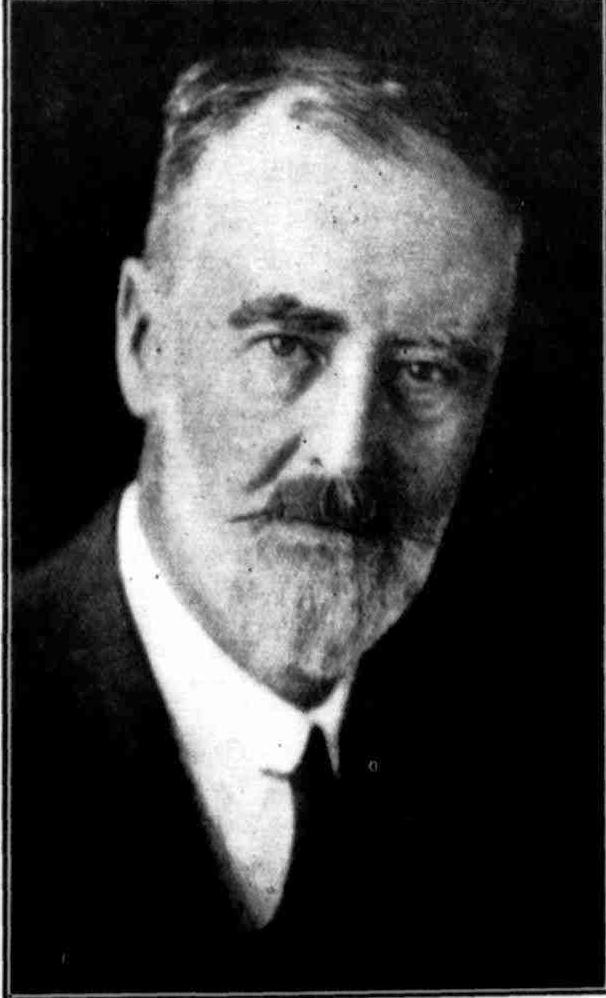 MR. FRANK WALKER, J P., F.R.A.H.S.
MR. FRANK WALKER, J P., F.R.A.H.S.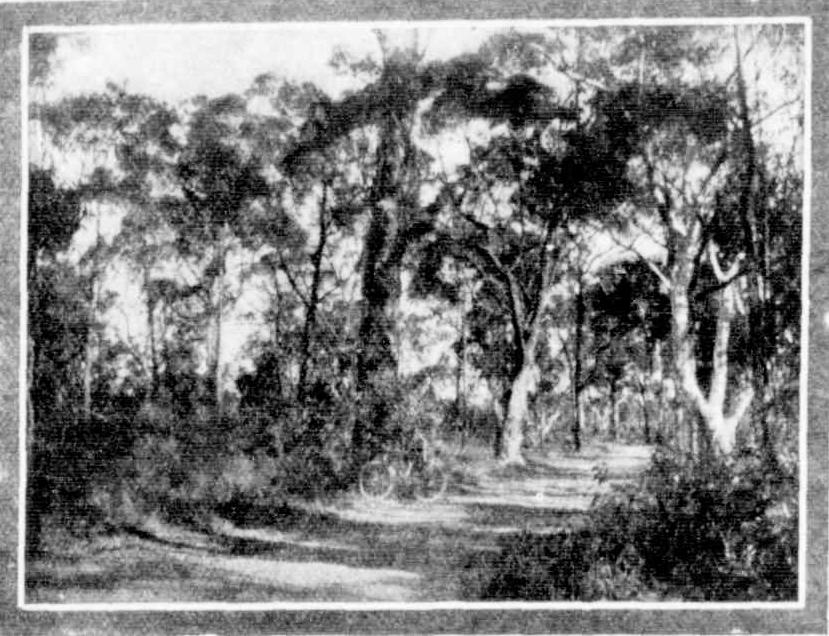
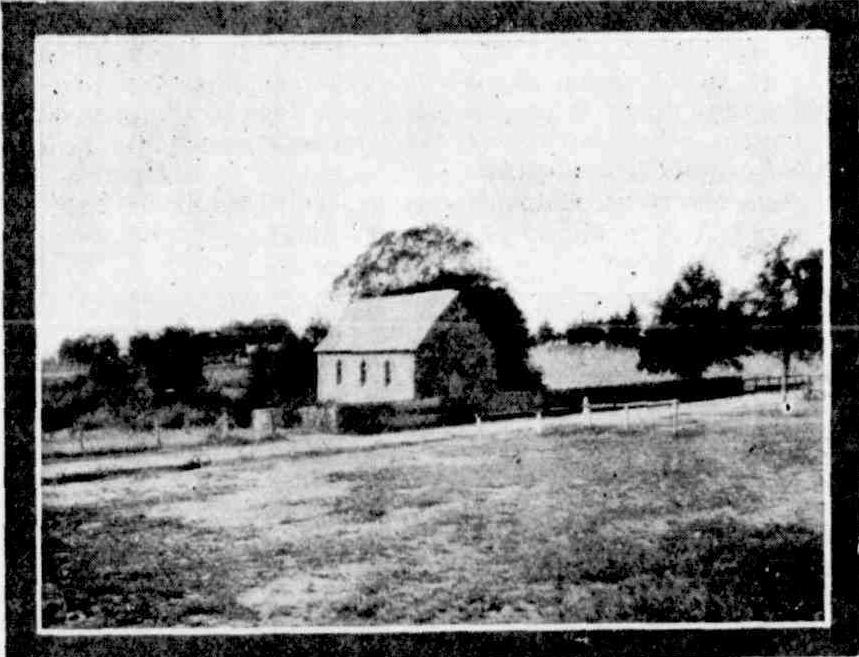
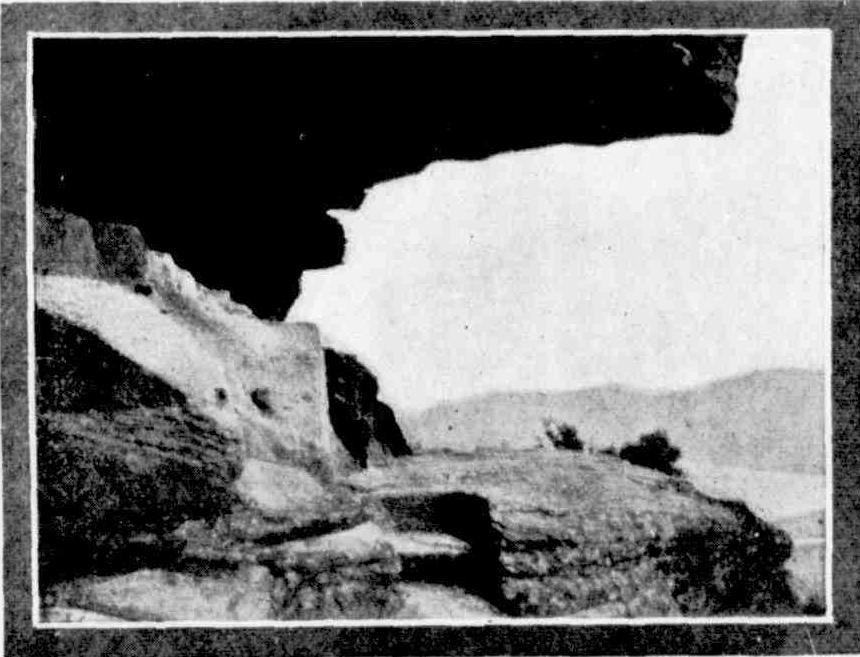
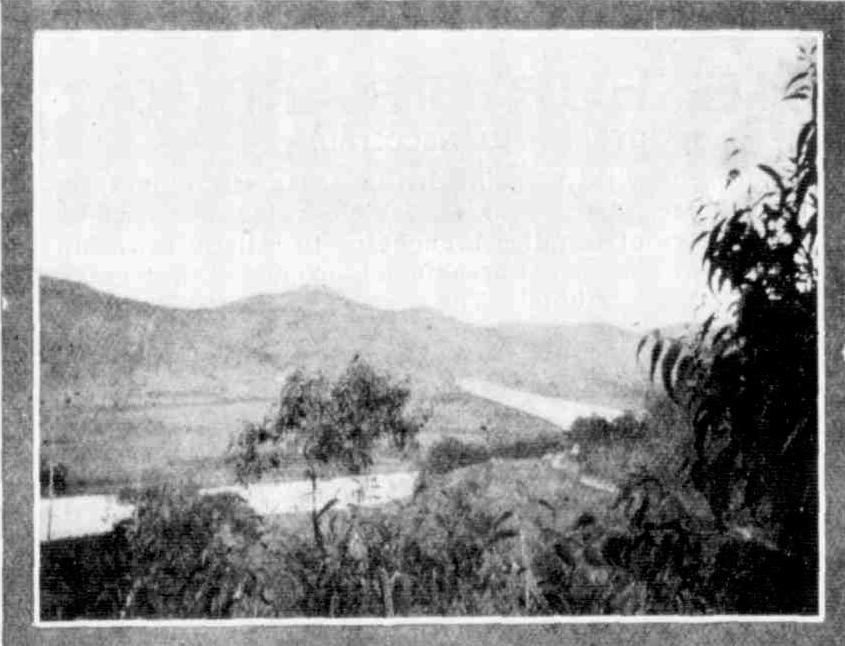

Motoring
Less Than an Hour from the G.P.O.
Sydney Beauty Spots for Afternoon Picnics
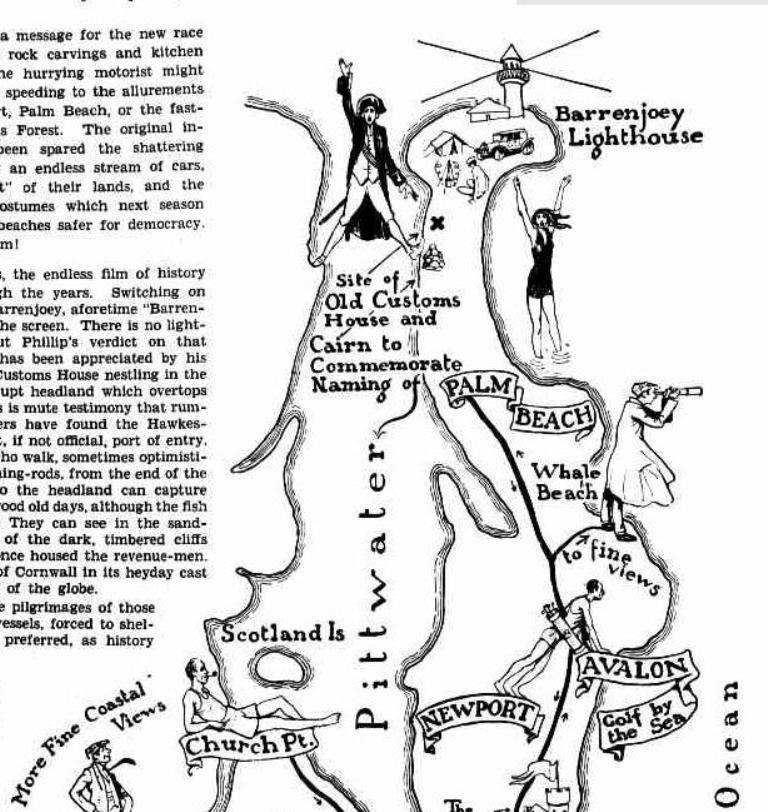
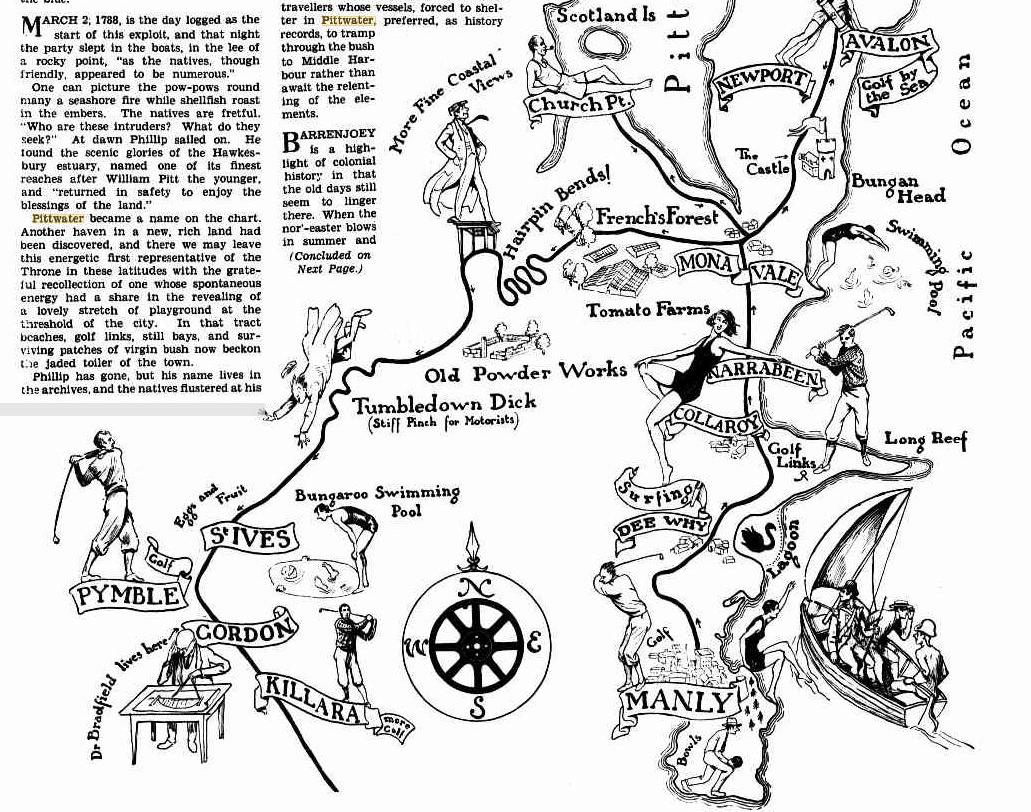

Mona Vale Public School Plants 140 Trees In Three Streets
 ONE hundred and forty Bottle Brush trees were planted at Mona Vale on August 11, when Arbor Day was celebrated at Mona Vale School.
ONE hundred and forty Bottle Brush trees were planted at Mona Vale on August 11, when Arbor Day was celebrated at Mona Vale School.
The trees were planted in Narrabeen, Waratah and Park streets, which surround the school, at which 148 students have become tree wardens.
The tree planting was arranged by the schoolmaster, Mr. Daly with the co-operation of the Parents and Citizens' Association. ;
- The P. &. C. and school children bought most of the treelings from the Forestry Department, the Department giving the remainder.
Mr. Daly addressed the gathering of children, parents and visitors, after which Mr., Austin, inspector of schools, Mr. Asian; M.L.A., and Mr. Watson, of the Naturalist: Society, addressed the large gathering.
All spoke of the great value of trees to the individual, the community, and the nation, and urged the growing, care, and protection of trees.
Trees were living things of beauty and great usefulness, and every effort should be made to save them from damage and destruction, the speakers said.
The young trees were distributed among the visitors, children and members of the Parents and Citizens' Association who moved to positions in the three streets where the treelings were planted.
Other visitors included members of the N.S.W. Town Planning Association (Mr. and Mrs. B. W. Ford), the president of Warringah Shire Council(Mr. R. Kent),- a member of the Forestry Advisory Committee (Mr.Turner), the secretary of Pittwater R.S.L. (Mr. Bimsan), Mrs. Ingleton, representing the Mona Vale Community League, and Mr. and Mrs. E. H. Collins.
The president of the P. and C. Association (Mrs. K. Batten) assisted by the secretary (Mrs. O. Anderson)entertained the visitors at lunch, while the school children provided a bright concert programme, which included Master Ted Budge's vocal solo, "Trees."
Visitors paid tributes to the school staff, P. and C. members, and all who assisted in the tree planting and entertainment. MONA VALVE SCHOOL PLANTS 140 TREES IN 3 STREETS. (1950, August 25). The Land (Sydney, NSW : 1911 - 1954), p. 14. Retrieved from http://nla.gov.au/nla.news-article105713567
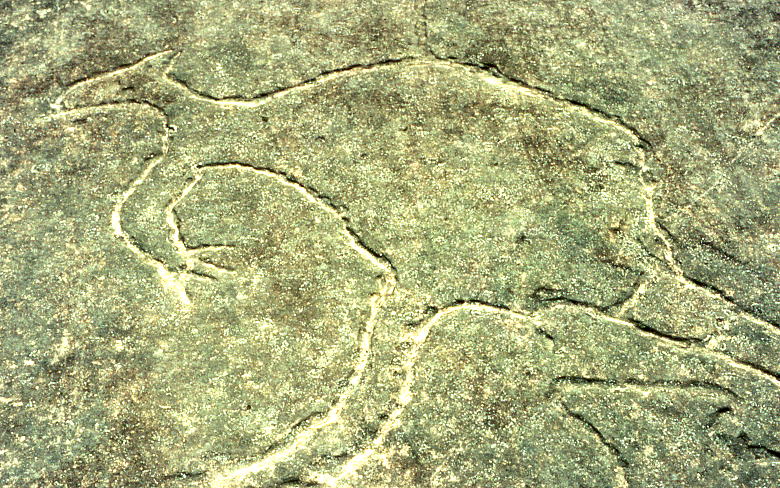


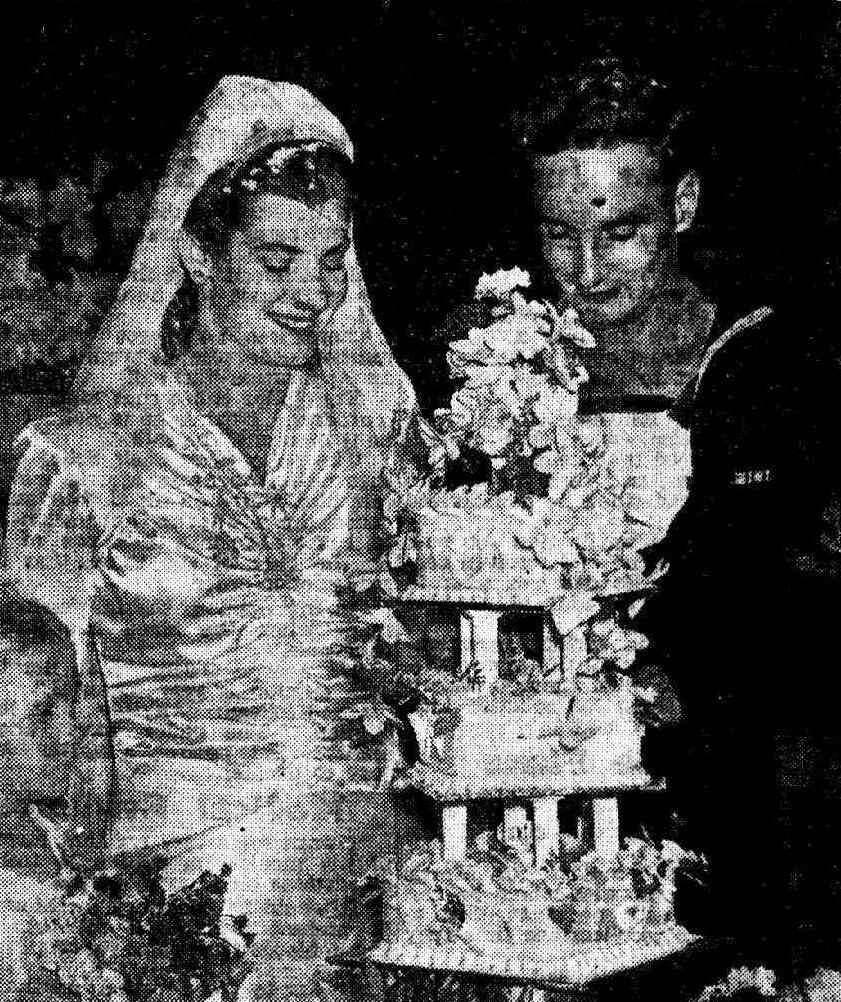
Along The Lane Cove Road (Now Pacific Highway) To Willoughby, lane cove, linfield, roseville, killara,Gordon, Pymble, St Ives And Then Onto Mona Vale
NEW NORTH ROAD.
BY a notice published in the Government Gazette on the 11th of last month, it appears that ferries have been established on the new line of road from Sydney to Maitland by way of Brisbane Water. We are informed that about ten days ago an officer of the Government passed over the Wollombi to examine a line of road, for the opening of which the inhabitants of the Wollombi district had forwarded a memorial to the Government.
This road commences at a point on the North Shore of Port Jackson, exactly opposite the north end of Macquarie-street, whence it passes through St. Leonard's, and along what is called the Lane Cove Road, to a farm belonging to Mr. Aaron Pearce, where it branches off, keeping the range between Berowra and Cowan Creeks by a well beaten road, leaving a small farm called the "Old Man's Valley" on the left to a tree known in the neighbourhood as the Cowan tree - the word "COWAN" being engraved on its bark. Within a few yards of the Cowan tree a beautiful avenue has been opened through a forest of tall straight trees for about a mile and a half, where gnarled gumtrees, honeysuckles, and stunted scrub, present themselves, growing on the wild sandstone range. About five miles beyond the Cowan-tree, a small open flat sprinkled with oak trees occurs. The road continues thence along the division of the waters of Berowra and Cowan, showing deep gulleys on each side, with high mountains in the distance to the left, the short lateral spurs exhibiting such rugged features as to prevent the possibility of deviating from the leading ridge, which, at about six miles from Pearce's, becomes very level, and at the seventh declines into a saddle-back, where are the remains of a camp. The remains consist of a horse trough formed of the hollow trunk of a tree, a little beyond which, and close to a rocky water hole is a rude bark hut. Three miles further the ground breaks towards the Hawkesbury and coast, and some engineering is requisite to case the ascent of a steepish hill. About half a mile beyond this is another saddle back, short and sharp, but which may be eased by working round. Thence to the Hawkesbury (where a succession of beautiful views present them-selves) the road, which has been cleared, merely requires trimming. The descent to the river continues along a narrow rocky fea-ture, until a sharp turn round a rock leads over a piece of masonry constructed to clear a deep and rugged gully. The road then passes at the foot of a wall of rock upwards of a hundred feet high, and reaches by a very gradual descent the ferry at Kangaroo Point.
The ferryboat belonging to Mr. Peat (an old settler whose house stands on the opposite bank of the river) is capable of taking six horses.
A long narrow neck of mountain ground between Mooney Mooney and Papran Creeks, is the commencement of the line from the Hawkesbury to Wollombi. The ascent up this neck is the chief labour required in the formation of the road, there being no difficulties on any part of the line. From the top of the hill above Peat's, the direction of the wood is defined by the course of the range, which (though somewhat tortuous) it keeps for about fifteen miles, where it passes over a bluff mass of rock, which re-quires to be reduced by blasting. About two miles beyond this point, and at a low, tame, feature, in a thick scrub, a tree is marked on a part bared of its bark WATER with RM and anchor under, denoting thereby, that a safe place of anchorage is near. From this point the ground ascends gradually towards two remarkable rocky knolls reminding one of "Los dos Aripiles," of the celebrated battle field of Salamanca, and which are as important as a key to the road as those of Spain were to the military position. Keeping close under these remarkable points, the road leads over a small water course dropping towards Papran, then passes through a thick scrub to the crest of the range, which soon becomes very open-commanding extensive views on both sides. To the north-east, Warrawolong towers over all the subordinate ranges heading the Wollombi Brook. To the north-west Yengo occasionally shows the whole of its form through the foliage, and serves as a guide in selecting the track by which to keep the leading range. There are, however, some delusive patches of open ground; the temptation to follow these must be resisted, as they almost invariably lead into gullies; it must therefore ever be borne in mind that the range is the road.
At about six miles beyond the Aripiles is a singular out-crop of trap from among the sandstone country: the land which rests upon it is of the richest description, thickly clothed with grass, and with standing timber, of girth, height, and straightness, rarely to be met with in this part of the country. The extent of this rich land is however very limited, and the road continues as before, along the top of the same range, which near the trap country (Warre Warren) throws off the waters eastward to Aurimbah Creek, and thence to Tuggurah Beach Lagoon-those on the west side falling into Mangrove Creek. Following the range between the heads of those creeks and the Wollombi, (the general bearing of Warrawolong and Yengo, being nearly as before, making allowance for distance,) the line strikes the road from Wise-man's (Lower Portland Head) to Wollombi, at a small stone bridge about four miles on the Sydney side of McDonald's Flat. Fifteen miles of the best part of the Wollombi Road completes the distance.
Several gentlemen have travelled the line referred to, and represent it to be free from any serious difficulties. A road party was a short time ago employed upon the first part of it, but suddenly withdrawn. Why this was done we are at a loss to imagine, for it opens a direct road from Sydney to a most important district. NEW NORTH ROAD. (1848, March 8). The Sydney Morning Herald (NSW : 1842 - 1954), p. 2. Retrieved from http://nla.gov.au/nla.news-article12898008
THE LANE COVE HOAD.
TO THE EDITOR OF THE HERALD.
Sir,--I desire, through the medium of your columns, to draw public attention to the hardships now endured by the residents of the North Willoughby and Lane Cove districts through the disgraceful state of the main road within the municipality of St. Leonards. At the present time, the road from the point known as the Crow's Nest to the School of Arts is in a most dangerous state-indeed it is in matter of fact that, without driving on the (so called) footpaths, it is impossible to get along. Nothing, however, is done in the way of repair to the road, save by throwing largo boulders of stone into the holes and leaving them to be broken up by the cartwheels passing over them, then by causing danger to life and limb. The poor people of the Lane Cove district are put to serious loss by the existing state of things-those who come from the remoter parts having to start at 1 or 2 o'olock in the morning with wood or fruit to enable them to be in Sydney in the early part of the day ; they are subjected to the annoyance of having to pay two tolls on the one rood, and than not be able to travel without danger. Only yesterday I heard of a case where a horse and cart had to be dug out of the mud. I do think it is time that something was done towards remedy-ing this state of affairs. The main road from Milson's Point should be taken over by the Government, and a Road Trust appointed to manage it. I consider the several Municipalities concerned should not have taken the road over in the first instance. I do hope the Mayor and Corporation of the Borough of St. Leonards, who are the persons most to blame, will set to work at once towards doing something to help the poor hard-working residents of the above districts, by giving them a road fit to travel upon.
EDWARD STACK.
THE LANE COVE ROAD. (1874, July 29).The Sydney Morning Herald (NSW : 1842 - 1954), p. 6. Retrieved from http://nla.gov.au/nla.news-article13341666
ROAD AT NORTH SHORE.
Introduced by Mr. Withers, M L A , a deputation consisting of Mr. B O Holtermann, M LA, and Messrs. Edward, Knapp, and Harris waited on the Hon the Minister for Mines yesterday, to ask that the Government would contribute £100 for the resumption of land for a road on the Lane Cove Road, and running eastward through what is known as Clayton’s ground. It was represented that this £100 was only half the value of the land in question and that the present owner, Mr Mackintosh, was willing to forgo the other £100. The road would connect two roads already in existence and would give people egress and ingress to lands which were now practically locked up. Mr. J. P. Abbott, in reply, said that he had already called for a report in regard to this road, and that it had not yet been sent in. He was inclined to meet the wish of the deputation, but he could not speak positively until he saw the report, and so he could only say that he would communicate his decision to them in a week or 10 days. The deputation thanked him and withdrew. ROAD AT NORTH SHORE. (1883, March 17). The Sydney Morning Herald (NSW : 1842 - 1954), p. 9. Retrieved from http://nla.gov.au/nla.news-article13530449
The North Shore Bridge.
The correspondence with Mr. Garbett, which Mr. Lackey promised to give, has been furnished by his successor. The late Ministry while they undoubtedly encouraged the concessionaire, did not in any way commit the country to the venture. They committed themselves, and certainly would have been bound in honour to support the project when it came before Parliament, and we are left to conjecture how far they would have used their political influence to back up the scheme. When we remember what they did to force the Milburn Creek vote through the House, we are justified in feeling that we have had a lucky escape. The first thing to be said about a bridge to North Shore is to discuss whether it is a proper work to be undertaken at all. It would be a very gigantic work, something like the bridge between Brooklyn and New York, though perhaps with more difficulty about foundations. We have seen in the cases of the Iron Cove and Parramatta River bridges, how very uncertain the rock bottom of our harbour is, and what great difficulty there is in getting to a trustworthy foundation. The borings show that we shall have still greater difficulties to deal with in the Hawkesbury River, and we may have some trouble with the George's River. What the bottom is between Dawes' Point and North Shore nobody knows, for no attempts have been made to ascertain, and to attempt to fix the cost of a bridge till this is known is all gueBs work. Mr. Bennett, the Commissioner for Roads and Bridges, thinks that there would be great objections to putting piers in the fairway even if there should be no trouble about the foundations, and says that if there is to be a bridge at all the least objectionable plan would be to have a clear span. But this would necessitate a wire suspension bridge, which is not a very desirable kind to carry a railway. The Brooklyn bridge, which is 100 feet longer than ours need be, will cost nearly two millions. It has been seven years in hand, and is not finished yet, and from recent advices it has already been complained of as 10 feet too low. Mr. Bennett's opinion is that such a bridge would be unsightly, would j be liable to injury from an enemy or an earthquake, and would only partially supersede an effective ferry service, while its cost of maintenance would be quite equal to that of keeping up an effective ferry. Looking at the question all round, therefore, the Government professional adviser strongly condemned the project. From no quarter did the Government receive any favourable advice from its professional subordinates, and under such circumstances the proper course would have been to have taken borings and sent the whole question to England or America, to be submitted to competent engineers, who could advise on the subject, and who might, perhaps, have overruled the opinions of the local engineers. But nothing of the sort was done, Mr. Garbett makes an offer, which is provisionally accepted. There is no proof asked or offered that he is in connection with competent capitalists or engineers. What he was to get was a sort of sporting concession, which he could carry in his pocket to England, and hawk about amongst speculative contractors. We can hardly imagine that Parliament, if not put under pressure, would have given its approval to any such bill as it would have been necessary to pass. But it is impossible to say how easy Parliament might have been under Ministerial blandishment. It has been disclosed that a reputable firm in England has offered- to make a bridge for far less than the sum named by Mr. Gasbett. This is sufficient to show that competition is to be had if it is sought in the right way. If it comes without asking, it is sure to come if asked for properly, and the benefit 6f such competition should belong to the colony, and not be thrown away on a concessionaire. But there is nothing at present to show that English firms, who may be willing to tender, know anything at all of the real conditions of the enterprise, or what it involves ; and in no case does it include the cost of the purchase of land, which would, be considerable. Offers are little more than rough estimates, till engineers have had time to examine and calculate. In the proper order of things, a careful engineer first examines, and the contractor calculates on the basis of his report. If there is no preliminary survey, then a corresponding margin has to be put on to cover unexpected contingencies, and this is a thriftless method of going to work, which no careful Government would encourage. As to contractors, it may be said, what does it matter to us what risks they run and what money they lose so long as the Government only pays for successful and completed work ? It matters a good deal. In the first place it is not to our interest that capitalists should sink money out here in unproductive enterprises. It is better for our finance and our credit that they should make money, and that Australia should have the reputation of being a good harvest field and not a grave for investment. And, in the second place, if the enterprise should break down in the middle the Government is sure to be dragged into it. There is but one possible buyer for an uncompleted work of that kind, and the country would have to take over a failure. No undertaking of this magnitude should be commenced or allowed to be commenced until it has been thoroughly studied and its successful execution has been made almost a certainty. At present the whole thing is clearly premature. Better communication with North Shore is badly wanted, but a steam ferry on the pattern of that at Brooklyn would more than answer immediate wants. The delay there is scarcely more than that of crossing a bridge with a toll, while it is quite as easy to drive any conveyance on to those capacious ferry boats as to drive under any porch or into any stable yard. The Government might fairly establish such a ferry as part of the Great North Road, and indeed it is open to question whether such a ferry would not be sufficient at present for crossing the Hawkesbury, and whether the half-million which the railway bridge there will cost could not be more advantageously spent elsewhere ? The North Shore Bridge. (1883, January 27). The Sydney Mail and New South Wales Advertiser (NSW : 1871 - 1912), p. 176. Retrieved from http://nla.gov.au/nla.news-article162081433
DEPUTATIONS.
COMMUNICATION BETWEEN NORTH SHORE AND MANLY.
A deputation of gentlemen representing the districts of Manly, East St. Leonards, South St. Leonards, Victoria and North Willoughby waited upon the Minister for Works yesterday, with respect to the desirableness of providing better means of communication than at present exist between North Shore and Manly. The deputation was accompanied by Mr. B O Holtermann, MLA, who explained the object of the deputation
Mr C H HAYES, Mayor of Manly, said he had been requested by various boroughs to present a petition setting forth the desires of the inhabitants of North Shore and Manly. He then read the petition, which was signed by a large number of inhabitants of the districts already named.
It was stated that the population of Manly was about 1327, that of East St Leonards 2320, that of South St Leonards, 2647, that of Victoria, 2182 and that of North Willoughby 1411, so that the total population of those districts was nearly 10 000 It was pointed out that there was no direct means of communication between the North Shore municipalities and the ocean at Manly by any easily practicable land route, that there are in the district of Manly and between Manly Bridge and Broken Bay many thousands of acres of Crown lands undisposed of, the value of which would be greatly enhanced by more direct communication, that the inhabitants of Manly have no means of getting to Sydney in stormy weather except by steamer, failing which by way of the road by Balgowlah and the ferries at Middle Harbour and St Leonards, and that great inconvenience frequently arises from the want of direct means of communication. It was also pointed out in the petition that great benefit would arise to all the boroughs previously mentioned, were easy access to Manly Beach and the ocean afforded without the people being compelled in stormy weather to cross the harbor in steamers, and that what was required could be accomplished by the construction of a tramway carried by a bridge over Middle Harbour at some convenient point accessible from St. Leonards and the other municipalities on the North Shore. It was further stated that if such a means of communication were provided, it would afford a most desirable outlet for the people of Sydney and North Shore on holiday occasions, and could help to prevent the tendency to dangerous crowding in the steamers which was found to prevail on all public holidays.
Mr. COPELAND said that he saw from a memorandum which had been obtained from Mr. Bennett that preliminary surveys had been made, but satisfactory progress did not appear to have been made with the work. He (Mr. Copeland) thought that the work recommended by the deputation was a desirable one to carry out, provided the expense did not prove too great.
Mr. Bennett had estimated the cost of a bridge at £45 000, and had stated that if it was to be a swing bridge an additional sum of £5000 would be required, making the total cost £50,000. He was not sure whether any cheaper bridge could be constructed than that. Then there would be the cost of the tramway to be taken into consideration. He would promise the deputation that a thorough examination would be made, and if it could be found that a cheaper and serviceable bridge could be constructed the mutter would receive very favourable consideration. He was quite in sympathy with the desire of the deputation to get a bridge across to Manly, and thought that it was a very desireable work, but he did not think that at present he would be justified in asking Parliament to vote £50,000 for that bridge.
In reply to Mr Hayes, Mr Copeland said that in the event of its being found that a bridge would be too costly to construct at present, the Government would, after the proposed cable tramway at St Leonards had been constructed and found to work satisfactorily, consider the desirableness of constructing a cable tramway on the other side of North Shore, and of providing a steam ferry
Mr HAYES said that at present there was a small punt, but it was unreliable, and the approach to it was very steep. DEPUTATIONS. COMMUNICATION BETWEEN NORTH SHORE AND MANLY. (1883, March 17). The Sydney Morning Herald (NSW : 1842 - 1954), p. 9. Retrieved from http://nla.gov.au/nla.news-article13530446
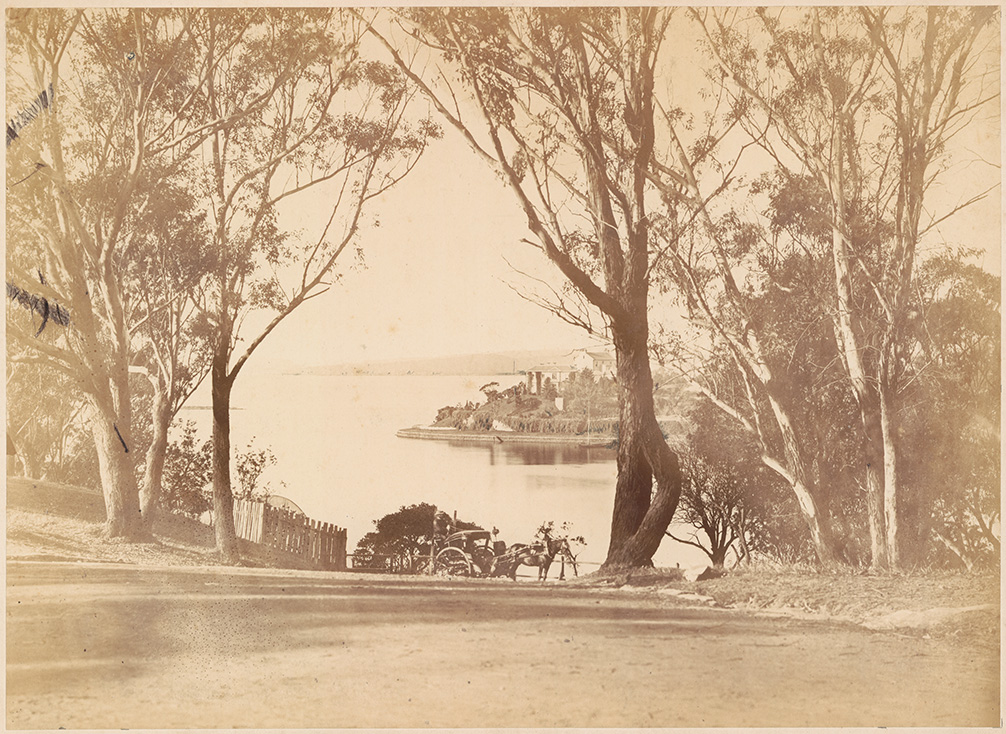
Road up from Milson's Point, 31 Dec 1880. Image 15344_a044_000013, courtesy State Records of NSW
NORTH SHORE ARE THE STRAIT GATE,
TO THE EDITOR OF THE SYDNEY DAILY TELEGRAPH.
Sir, — If all who enter through the strait gate and walk in the narrow way are off to " the Eden above." then of the North Shore people there shall not a ‘'hoof be left behind." From the Steam Ferry Company's wharf at Milson's Point to though main road, leading through St. Leonards to districts beyond, the passage is so narrow that only one vehicle can pass at the time. A single gate, and that of ordinary size, suffices to close the whole thoroughfare, so that the width cannot be over 10 feet. The roads and streets of the districts to the north converge towards the portion under notice.
The wood carts and fruit carts from Hornsby, Lane Cove, Willoughby, North Shore, together with the 'buse's, private carriages, horses, carts, buggies, drays, waggons, hearses, mourning-coaches, and wheelbarrows of the North Shore, one by one wriggle through a passage scarcely wide enough for an entrance to a coal-yard. Can anything be more ridiculous than the whole population of 80 square miles having no other access to the harbour and the city than by a way in width not a sixth of that required for a bush road 600 miles from the capital.
At about 1 o'clock in the afternoon the scene near the ferry is one of sweet confusion, as the zealous aspirants struggle for the narrow way. Whips crack, naves and spokes rattle, while Smith, Brown, and Jones strive for the track with all the Christian energy and zeal of. a captain in the Salvation Army. Here a coroner might spend all his time, provided the road was twice its present width; but as things are an accident seldom occurs, horses and people being be closely huddled together that there is no room for a kick or hit, or forcible collision. Now, sir, is there any need for such inconvenience? Patience is a virtue ; and they, who suffer without complaining, when suffering cannot be obviated, or when some good end is to be served, are worthy of the highest commendation. But where annoyance, loss of time, pain and danger are endured to no advantage, it is time to ask if the penury of the country is such that the resumption of 100 square yards of land in the neighbourhood of Milson's Point dare not be undertaken. If the thing is necessary and possible, and must be done some day, and can only be performed hereafter at greater expense, it should be undertaken without delay.
Yours &c
LANE COVE.
NORTH SHORE ARE THE STRAIT GATE. (1883, July 6). The Sydney Daily Telegraph (NSW : 1879 -1883), p. 3. Retrieved from http://nla.gov.au/nla.news-article239274832
Our Metropolitan Suburbs: North Shore.
FAMED alike for the beauty of its scenery and for the historical interest attaching to it, North Shore is, with-out doubt, one of the most charming of our metropolitan suburbs. Both as a place of residence and as a holiday resort, ' The Shore,' as it is familiarly called,, grows more popular year by year, although it is questionable whether even one per
MR. WILLIAM DIND.
cent, of the thousands of holiday-makers who flock to it during the summer months in search of the picturesque, give a thought to the days that are gone, or to the strange scenes that have been enacted on ground now covered with bricks and mortar, or cut up into desirable building sites.
And yet to know something of the history of a place is to feel a new interest in it ; to view it with new eyes. Standing here in front of East St. Leonards Town Hall, amid these busy shops and with crowded tramcars passing to and fro, let us construct a retrospective tableau of past years. These 'points,' or promontories, at which the ferryboats now call every few minutes throughout the day, are covered with dense scrub. Dotted about here and there are a few bark huts and tents, each in its clearing away up there on what is now known as Berry's Estate the blackfellows are camped. To-night they are going to hold a great corobboree, and their dusky skins, fantastically striped with red, white, and yellow clay, will glisten in the ruddy glow of their huge camp fire. The hills and dales all around us are covered with bush giant trees and matted undergrowth. Shall we, with an eye to the future, secure some of this wilderness while we have the chance? A little money will go a long way invested in land now, or, with a little skilful manoeuvring, a little manipulation of the wires, or some trifling service rendered to the State, we may perhaps get a Crown grant assured to us, and to our heirs and assigns 1 for ever ! Some day, perhaps, this land may be worth having. We will take a few thousand acres * on spec.'
And now- What's that? ' Beg par-don, sir, but I must ask you to move on ; you are obstructing the footpath.' We awake from our day dream, rub our eyes, and look up. Scrub and blackfellows and bark huts all fade away as if by magic. We are back again in 1889, and this is a police-man, and he has asked us-politely, indeed, but firmly - to 'move on.'
North Shore is divided into four boroughs: St. Leonards, East St. Leonards, Victoria, and North Willoughby. It is not every place that can boast of four mayors, but we do not know that ' The Shore' is to be congratulated on this account. On the contrary, indeed, the arrangement appears to us a very absurd one. Union is strength. One big corporation ought to possess more influence and carry more weight than four small ones, and the time cannot be very far distant now when an amalgamation must take place, and North Shore be known as ' North Sydney.' So far, indeed, has the Shore progressed towards this desirable end tnhat in three of the boroughs -namely, Victoria, St. Leo-nards, and East St. Leo-nards - the principle of amalgamation has been affirmed, and the matter has been placed in the hands of the members for the electorate, Messrs. Cullen and Burns, to bring forward in the Assembly. As things stand at present, the suburb suffers for want of funds to carry out such schemes as would materially advance its interests ; such important matters, for instance, as drainage, gas, and water. With an amalgamated Council, and with the golden prospects now before it, of which we shall have more to say, there should, be but little difficult}1 in floating a substantial loan on the English market, and in a few years rendering it the Brooklyn of Sydney ; of as great importance and with as flourishing a trade as that possessed by the more advanced suburbs across the water.
East St. Leonards Town Hall, a brick building, more useful than ornamental, is within four or five minutes' walk of the ferry landing at Milson's Point. The borough, covering an area of between 500 and 600 acres, contains 1,099 houses, and a population of about 5,250. It was incorporated in 1860. The first Council consisted of Aldermen William Tucker (Mayor), Mil-son, Lord, Dind, Loxton, and Erith. Death has played sad havoc with that Council!
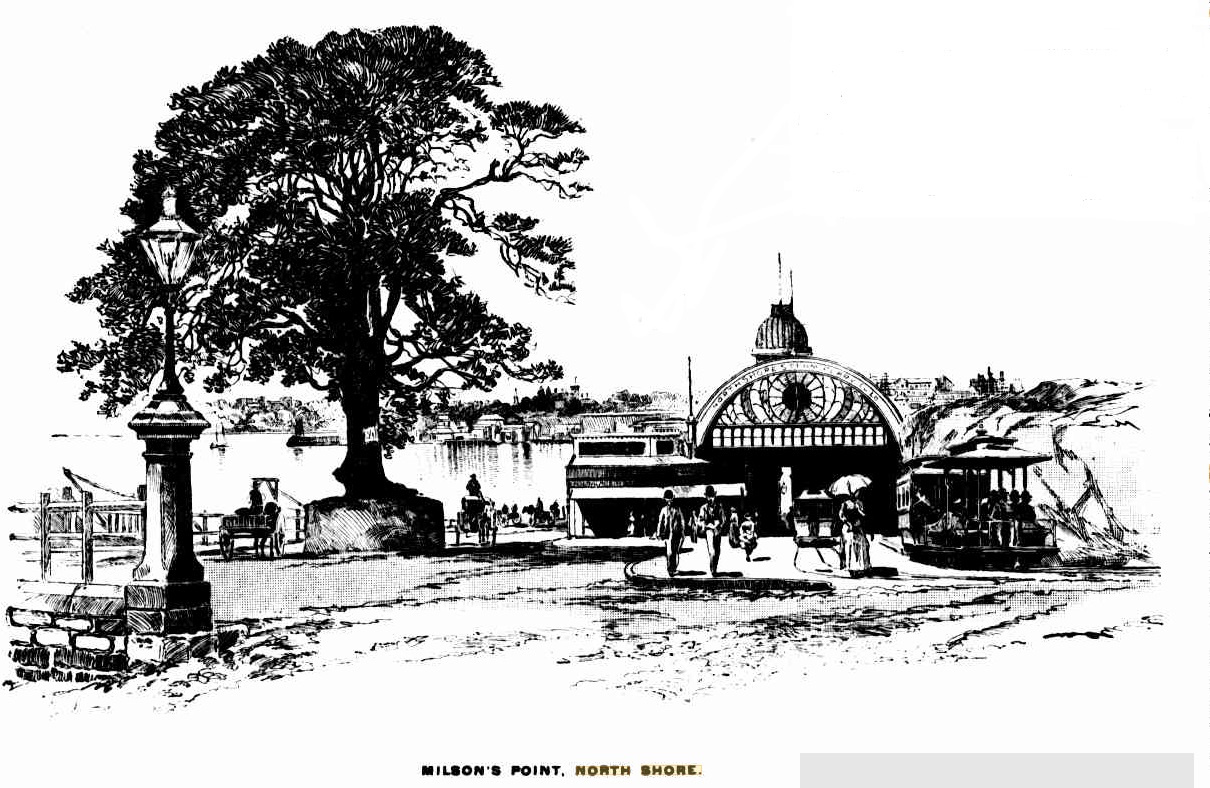
MILSON'S POINT, NORTH SHORE.
The present Mayor is Mr. J. W. Manford, builder and contractor, of Arthur-street. The total annual value of ratable property within the borough is £88,794 16s. 10d., the capital value being £1,330,000. The Council Clerk is Mr. P. A. Temple, who has occupied that important position for the past six years.
East St. Leonards is not particularly well off for public buildings, but between Milson's Point and Kirribilli Point are some of the prettiest private residences to be found in or around Sydney. At Kirribilli Point, by the way, is the residence of the Rear-Admiral, which was purchased by the Government from Mr. Thos. Cadell for some £30,000. The house stands in about five acres of ground, it is somewhat remarkable that while East St. Leonards is rich in water frontage, not one yard of that frontage has been reserved for the use of the public as a park or recreation ground. The first Government decreed that one hundred feet of
land, from high-water mark, should be reserved all around the harbour pro bono publico, but the law seems to have remained in this respect the deadest of dead letters. At Cremorne, formerly known as Robertson's Point, there remains about a mile and a half of the once-extensive water frontage still available. At the Council's instigation, Government intend to hold on to this poor little strip of land, in the interests of the North Shore public.
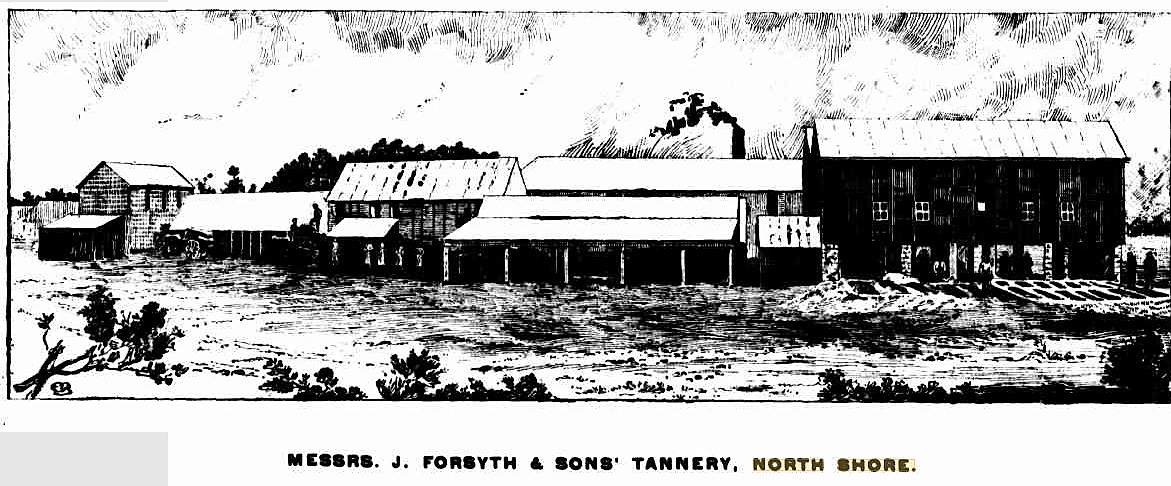
MESSRS. J. FORSYTH & SONS' TANNERY, NORTH SHORE.
The borough of St. Leonards, which adjoins that of East St. Leonards, is six square miles in extent, possesses 1597 houses, and a population, roughly speaking, of close on 8000. St. Leonards was incorporated in 1867. The Mayor is Mr. E. Bunch, and he appears to be very popular with the burgesses. The Clerk to the Council is Mr. W. B. Smith, who has acted in that capacity for the past four years. Choice building sites in St. Leonards are worth about £14 per foot, although one section, at the junction of Miller-street and Lane Cove-road, is valued at between £50 and £60 per foot, but this is on account of its exceptional position. There are three large public reserves in St. Leonards, one facing the Council Chambers, of some forty acres in extent, being remarkable for the beautiful scenery which it commands.
Victoria is an off-shoot of St. Leonards. It is two hundred acres in extent. The Mayor is Mr. "William "Waterhouse, this being his second year of office, and the Council Clerk is Mr. Walter George Millington, who has filled that position since Victoria Ward became a borough, in 1871. Victoria contains 779 houses, and a population of between 3000 and 4000.
North Willoughby, the remaining North Shore borough, covers an area of thirteen square miles. The population is about 1600, and there are just 550 houses within the Borough. Mr. James Simpson is the Mayor, and Mr. Jas. Anderson is Clerk to the Council. This is Mr. Simpson's second term of office, which is a sufficient proof of his popularity with the ratepayers. North Willoughby became a borough in 1865. Choice building sites in the main thorough-fare are worth from £4 to £5 a foot, and owners evince a decided inclination to ' hold on' for the rise in values which they are certain is coming. Certainly when the line now in course of construction between Hornsby and Milson's Point is opened for traffic, which will probably be in about a couple of years' time, North Willoughby, through which it passes, ought to ' look up.'
The North Shore water supply scheme, now on the point of completion, should prove a boon to the residents. At present the place is dependent for its water on a nine-inch pipe, which, passing under the harbour, connects with Crown-street reservoir. Were this pipe to burst there would be a ' water famine ' at North Shore, but this calamity will not threaten much longer for the new supply will shortly be available.
North Shore, Manly, and Pittwater form one electorate, and return three members to Parliament.
One of the most notable of North Shore identities is Mr. William Dind, who has resided in the place for something like forty years. Mr. Dind is, to use his own phrase, ' no chicken,' but he is nevertheless in the enjoyment of excellent health, and possessed of a physique which many a man twenty years his junior might envy; Mr. Dind knows much that is interesting about North Shore. He was formerly Mayor of East St. Leonards, and is very popular with* his fellow-townsmen. To show how land has increased in value at Milson’s Point, it is only necessary to mention that thirty-five years ago Mr. Dind purchased the site occupied by his hotel for £1 per foot. The same land is now worth £40 per foot, and indeed choice building sites are very difficult to get at all at North Shore.
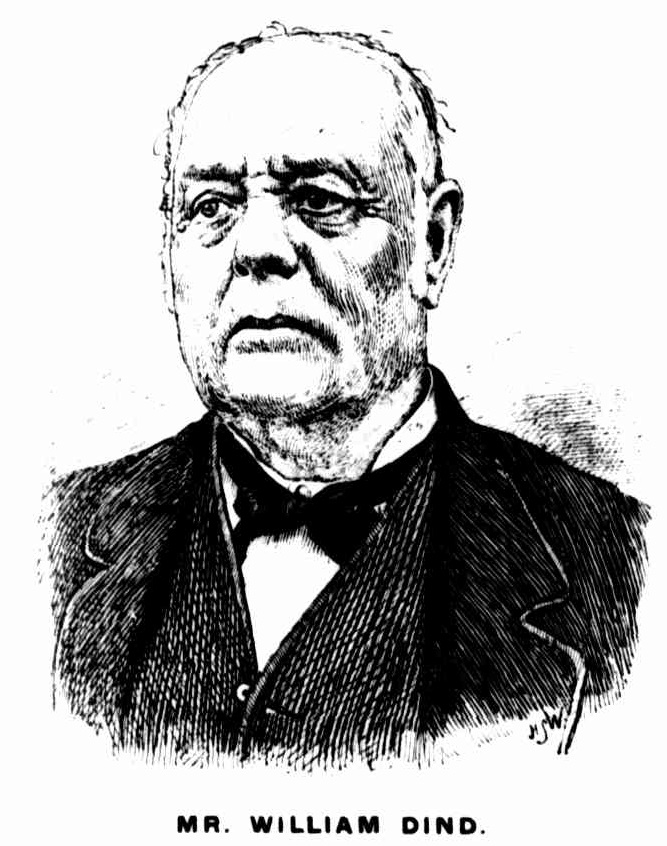
The oldest resident of Milson's Point is. Mr. J. Milson, a cheery old gentleman of about seventy years of age, who has lived on the Point which bears his family name since he was four years old. The Point, by the way, was called after the late Mr. Jas. Milson, who held a Crown gran!; of some fifty acres or thereabouts early in the century. Messrs. James and John Milson, his sons, are the only surviving members of the family. Mr. John remembers a time when hordes of black fellows frequented North Shore, and he has watched many a corobboree danced where shops and stores now stand, and 'buses and cabs ply for hire. Mr. Milson can recall the days of Bungaree, when, that dusky monarch, accompanied "by Queen Gooseberry, held his Court under the rocks in one of the bays or beneath the trees on the Point itself.
Bungaree, be it known to the reader, despite his name, which, like that of his queen, the fair Gooseberry, smacks somewhat of comic opera, was a noted chief or king in his day, and a mighty warrior. Culliban, another celebrated chief, Mr. Milson also remembers well. At that time North Shore was teeming with kangaroos and wallabies, while birds of all kinds were found in the bush, including the beautiful bronze-wing pigeon, and myriads of gaily-plumaged parrots and paroquets.
' The Shore ' was a favourite camping-ground of the blacks in those early days, and round about Milson's Point was their principal fishing ground. ' Bungaree died in a hut over at William Macleay's place, in Elizabeth Bay,' said Mr. Milson to the writer ; ' I remember his death well-it took place about forty years ago.'
It appears his Majesty was much addicted to the fire-water of the pale-faces, and he used to get very drunk, so helpless, in fact, that he was covered with scars caused by his continually falling into the camp-fire and getting burned while 'under the influence.' His love of liquor probably hastened his end.
Hundreds of blackfellows were buried at Milson's Point, and Mr. John Milson has quite an extensive collection of stone knives, tomahawks and axes, clubs and spears, etc., dug up on the Point. Such relics of the original owners of the soil are still found occasionally; probably an enthusiastic curio-hunter would easily fill a waggon with such things were he to visit the former camping grounds of the blacks at North Shore and other suburbs of Sydney.
The blacks on Milson's Point, by the way, had a queer method of making things un-pleasant for those of their number who offended against the laws laid down by the king for their general guidance. The offender would be made to toe a certain mark, nude, and with only a shield, sometimes of wood, sometimes of thin bark merely (it depended on the nature of his offence), to defend r himself with. Then a number of expert spearsmen would be told off for spear-throwing, the unhappy prisoner being the target. ''? The culprit was generally placed on low ; ground, the spearsmen standing on a hill : about seventy yards away.
At a given signal the fun would commence, the King, Queen, and the rest of the royal family manifesting a lively interest in the proceedings. If the prisoner knew how to use his shield he would pass through the ordeal without a scratch ; if he did not understand the use of the shield he would stand a pretty good chance of providing a funeral for the same day. Instances were common enough of half-a-dozen spears piercing shield and body at the same moment.
Mr. Milson remembers when Lavender Bay bore a less euphonious title. It was Hulk Bay once, so called from the fact that the convict hulk was moored in it. That is upwards of forty years ago. The old black hulk, together with most of its inmates, has long since ceased to exist ; but it was a great institution ' once upon a time,' and boats were constantly travelling between the hulk and the shore. In those days free labour was almost unknown, and convicts were assigned to the settlers and did ail their work for them in return for food and clothing.
Gerrard Brothers established the first North Shore ferry. That was forty years ago. Instead of the splendid service of penny steamers, which now run every quarter of an hour between Circular Quay and Milson's Point, two very indifferent steam craft carried passengers between Blue's Point and "Windmill-street. As these vessels also did the towing for the port, communication was extremely irregular, and the only alternative was to obtain a water-man's skiff - if one were procurable. Gerrard's Ferry, as it was called, subsequently became Milson's Ferry Company, the Gerrards disposing of their interest in the concern to Mr. John Milson and some others, who in their turn sold out to the present company.


1. VIEW OF LAVENDER DAY 2. NORTH SHORE HOSPITAL, 3. IN ST. LEONARDS PARK. 4. POST OFFICE AND COURT HOUSE. 5. THE WESLEYAN CHURCH. 6, A WATERFALL NEAR ALFRED ST, ST. LEONARDS. 7. THE CONGREGATIONAL CHURCH. 8. HANGING ROCK, NEUTRAL BAY. 9. TOWN HALL AND FIRE STATION 10. MESSRS. G. T. CLARKE &. MCINTYRE'S PREMISES.
There are some enterprising business men at North Shore. Of these, Messrs. J. Forsyth and Sons, tanners and carriers, merchants and importers, are amongst the most prominent. They own the North Willoughby Tannery, their city warehouse being situated at 29 and 31 George-street West The success attending the operations of this important firm goes to show what pluck, perseverance, and energy can accomplish. Less than a quarter of a century ago they started business at North Willoughby, their capital being just £20. Mr. Jas. Forsyth, senior, the founder of the firm, retired from it nine years ago, having realised a fortune. His two sons, who now carry on the business -Messrs. Thos. Todd and Robert Forsyth are following rapidly in their father's foot-steps. Their tannery is one of the best equipped in the colony, and the goods they turn out have won an intercolonial reputation.
Messrs. Clarke and McIntyre (formerly carrying on business in Walker - street, as Auctioneers, Land, Estate and Financial Agents, have been established for several years, and represent many leading capitalists who have property in the St. Leonards district. Mr. Gr. T. Clarke's name is identified with many important subdivision sales. As a land salesman, he is recognised as one who thoroughly understands his business. The firm are agents for leading insurance and financial houses. The premises occupied by the firm were specially erected by them for the conduct of their business. In addition to the public- office are spacious auction rooms, managers' and private offices, also board rooms.
The St Leonards Land, Building, and Investment Company, Limited, are also doing a large business. The above company was established in the year 1886, and from its inception has proved a success. The capital of the company is * steadily increasing; on the other hand business in loans is so satisfactory that within three years the assets of the company amounted to over' £22,000. W. H. Tulloch, Esq, J.P., is the chairman, a gentleman well known in commercial circles and highly respected by the residents of St. Leonards. Messrs. Joseph Monday, A. Armstrong, J.P., j. T. Atchison, and John W. Eaton are the Directors, all of whom are local gentlemen, occupying prominent positions in the district. Mr. G-. T. Clarke, J.P, is the manager.
Perhaps the most enterprising retail tradesman at the North Shore is Mr. W. H. Stephenson, whose ' drapery ' in Miller street is as well known as the Town Hall. Six years ago Mr. Stephenson commenced business in Lane Cove Road, and was so suc-cessful that he very soon had to add another shop to his already large premises. In November, 1888, he purchased his present business, the premises being much more commodious than his old ones, and the site a very much superior one to that in Lane Cove Road. Mr. Stephenson subsequently effected extensive alterations to the shops he now occupies, and he considers that the money paid away for this purpose was well spent. He started six years ago with two hands ; he now employs ten, and his carts go all over the Shore. Mr. Stephenson attributes his success to his unflagging attention to business; he never misses an opportunity, and is an adept at the art of making hay while the sun shines.
(To be continued in next issue.) MESSRS. W. H. STEPHENSON& CO.'S PREMISES. Our Metropolitan Suburbs: North Shore. (1889, August 22). Illustrated Sydney News (NSW : 1881 - 1894), p. 19. Retrieved from http://nla.gov.au/nla.news-article63621956
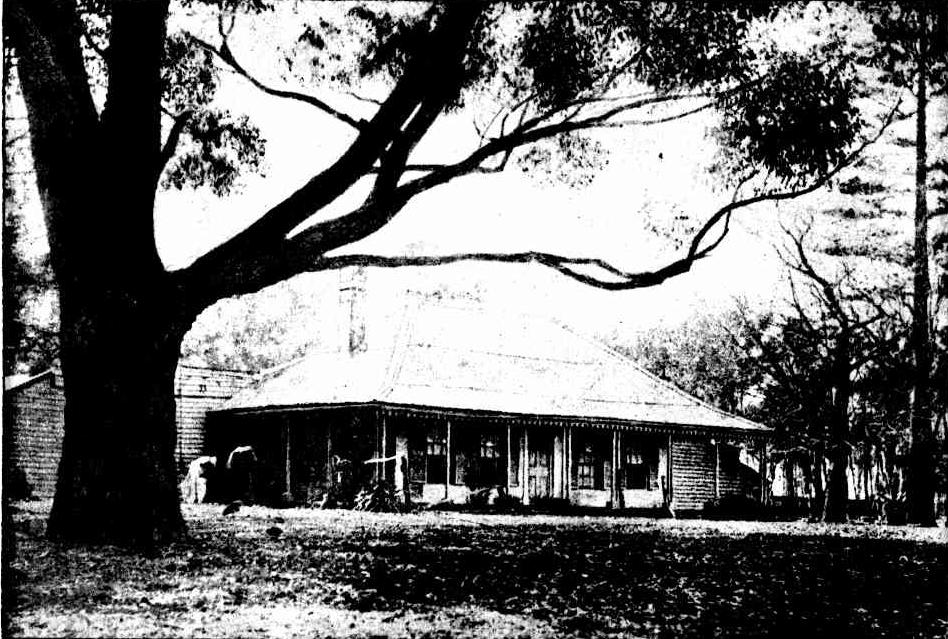
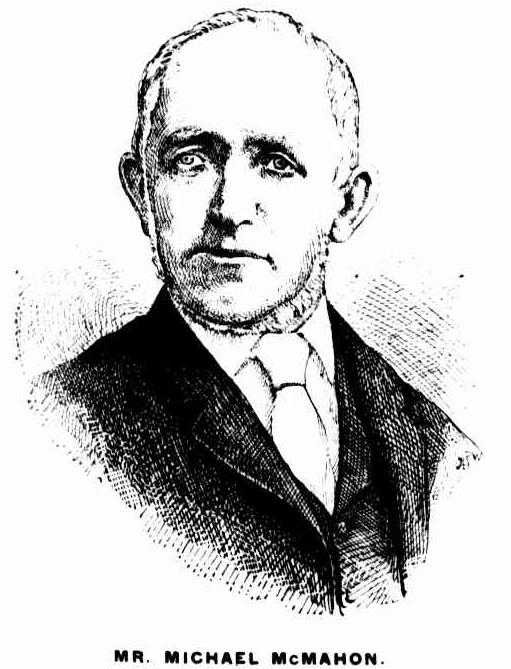
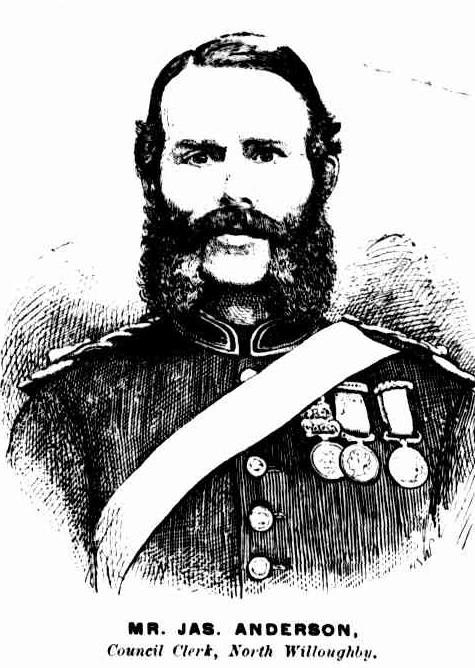
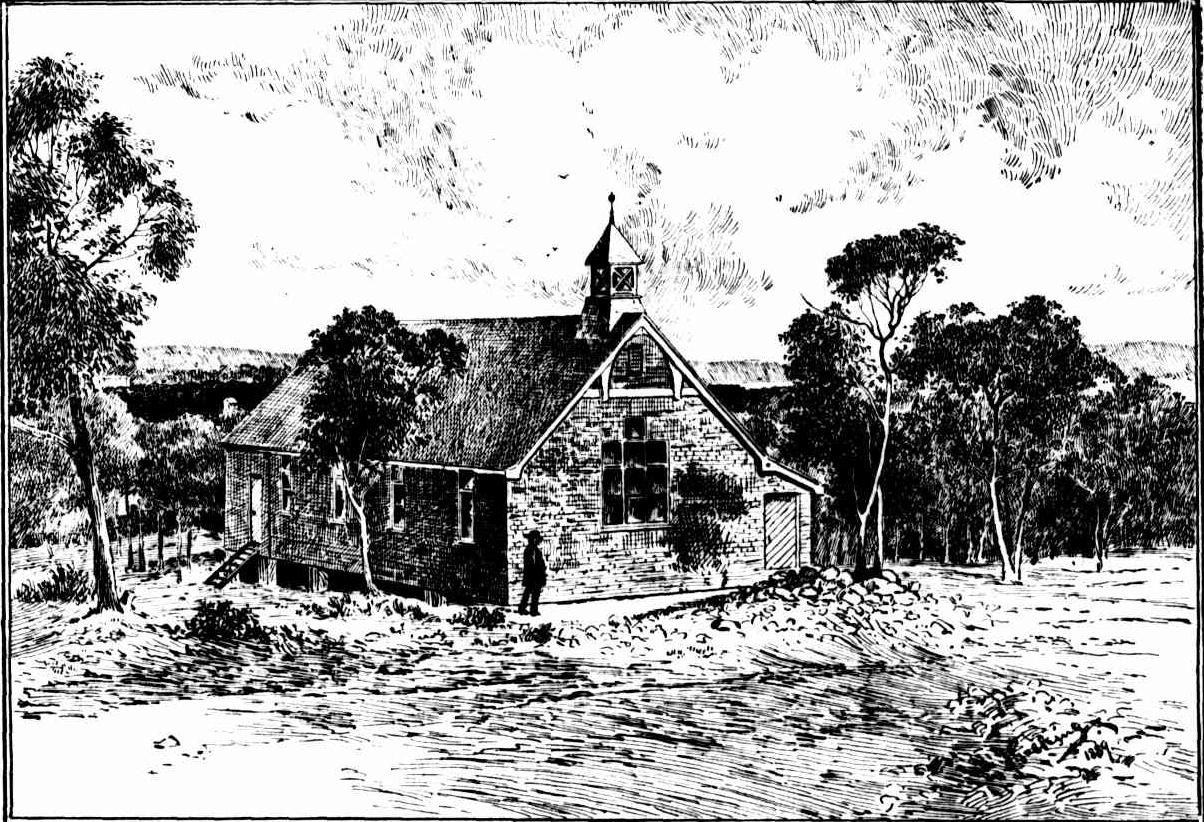
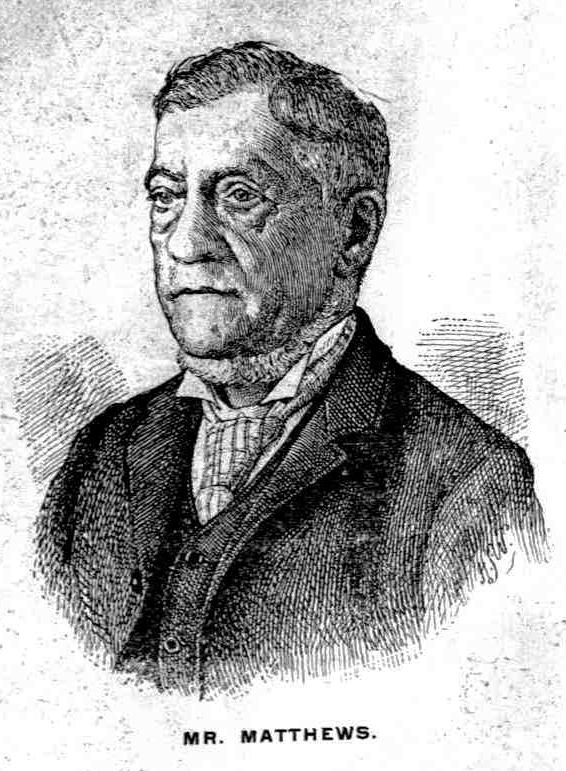
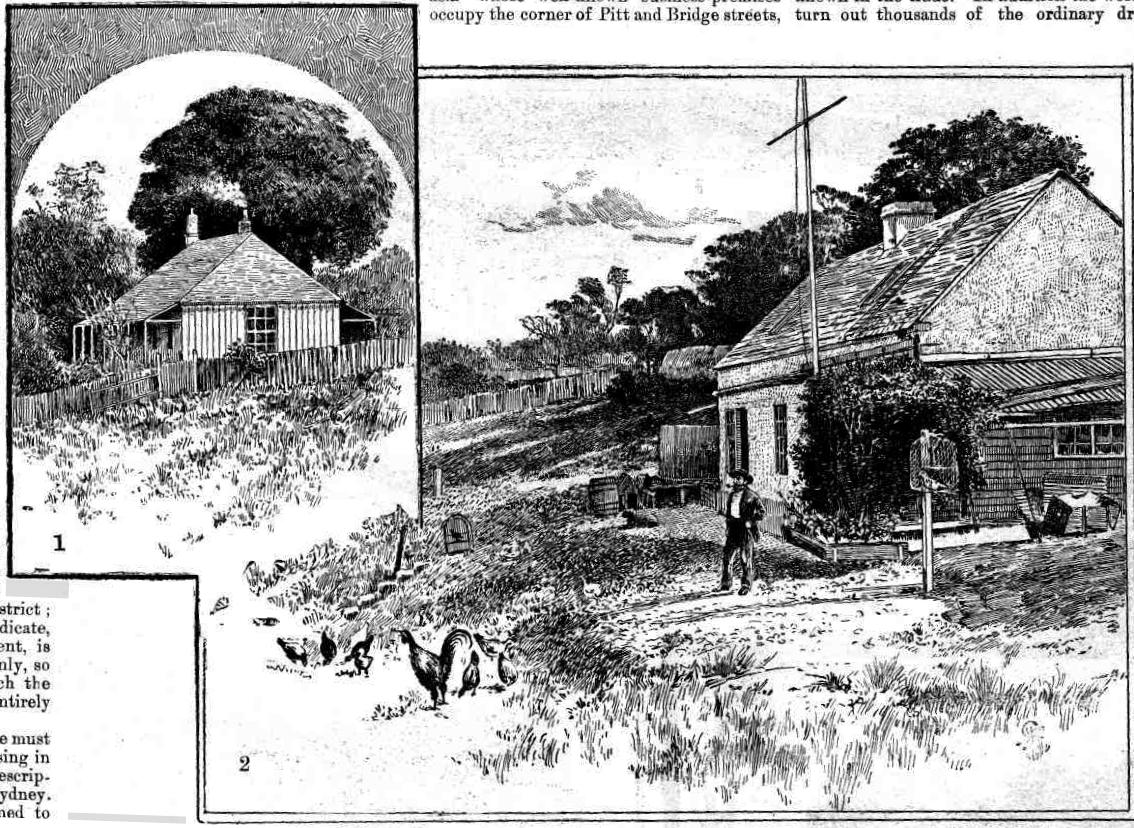
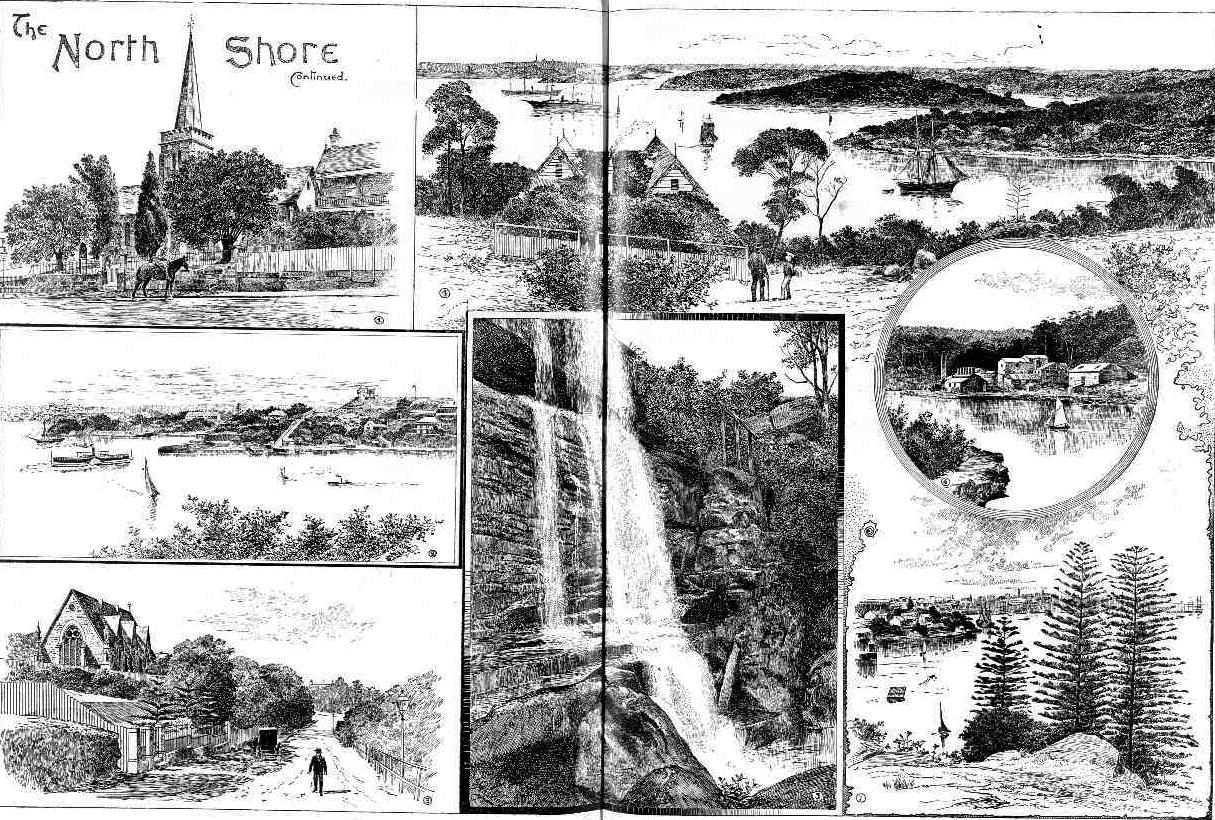
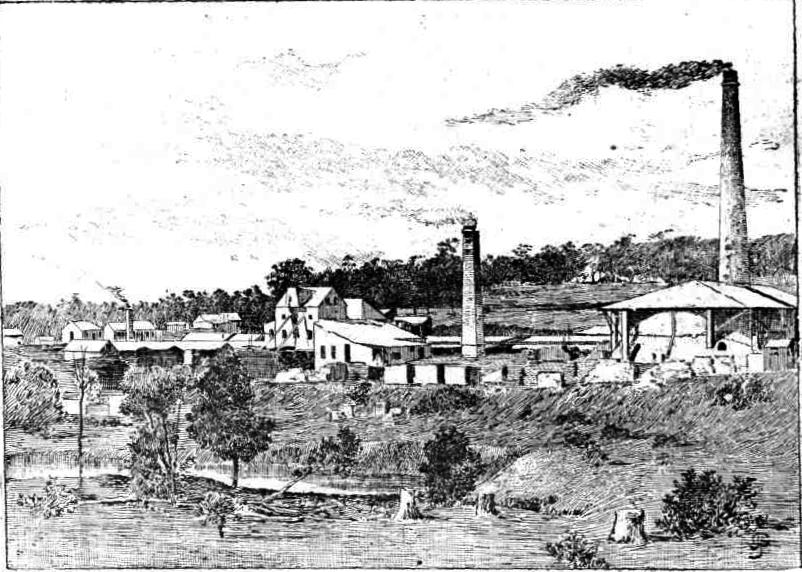

The North Shore, Sydney.
A RISING SUBURB.
(See illustrations on this page and page 26.)
.jpg?timestamp=1535698759302)
MILSON'S POINT, NORTH SHORE — VIEW OF THE NORTH SHORE STEAM FERRY COMPANY'S ARCADE AND WHARF. . (See letterpress on page 27.)

St. Leonards Railway Station, North Shore, on the St. Leonards-Hornsby Branch of the Sydney to Newcastle Railway. (See letterpress on this page.)
How great events from little causes spring" was forcibly illustrated in the founding of the mother city of Australasia. In the first rough exploration of Port Jackson, the largest and most permanent-looking fresh-water supply to be found was the Tank Stream. This stream has long ago disappeared, and is almost forgotten. But, small as it was, it was sufficient to determine the site for the city. Had fresh water been found in larger quantities at Manly or North Shore, or any other place in the harbor, the first settlement might have been there. However, the advantages of the many charming sites on the North Shore of Port Jackson were speedily recognised; and many residences were established there. At first these were only to be reached by watermen's skiffs and private rowing boats. But these were by no means sufficient for the requirements; and at an early date a steamer known as the Fairy Queen was introduced; and shortly afterward a sister boat, the Gypsy Queen, was obtained. These were among THE FIRST STEAMSHIPS, plying in the harbor; and compared with the fine ferry boats,now in use, they were queer look-ing little things. At first the service was very irregular; the boats only starting when there was a load for them. Mr. Milson, however, with four or five other gentlemen, formed a company to organise regular steam communica-tion; and the steamer Kirribilli was added to the fleet. The boats started at what would now be considered very long intervals; but the service was a great improvement on the intermittent service previously in force. In 1877 this com-pany was bought out by the present NORTH SHORE STEAM FERRY COMPANY; and as the population of "the Shore" in-creased fresh boats were added to the fleet; and the intervals between the times for starting were shortened. The company showed much enterprise; but it was not left entirely without opposition. More than once opposition companies were started; and these ran for a time. But they were unable to compete with the old company, and therefore died out. The effect of these oppositions was, however, to induce the company to lower the fares from time to time; and, finally, in 1888 it was resolved that a uniform charge of ONE PENNY PER TRIP should be made. This resolution came into effect on July 1 of that year. At the present time the company has no less than fourteen steamers running to Milson's and MacMahon's points, Lavender, Neutral, and Mosman's bays, and other portions of North Shore.
AT MILSON'S POINT, the principal landing place, a handsome arcade and waiting-room have been erected; a number of shops being let. The tower is a conspicuous object in the trip from Circular Quay to North Shore. On passing through the arcade the ground, formerly very rough and rocky, has been cut down and levelled, and a capital asphalt footpath leads from the arcade to the town. The cable tram-way starts from Milson's Point, and runs to the St. Leonards recreation ground, known as Tunks Park. About three miles from Milson's Point, and about one mile froth the tram terminus in Miller-street, is the terminus of the branch railway line from St. Leonards to Hornsby Junction, on the Homebush-Waratah railway line. The length of the branch line is 10 miles 42 chains. At Hornsby Junction the line is 592ft above high water mark, and at the ST. LEONARDS STATION 238ft, showing a drop of 354ft over the whole dis-tance. There are 39 gradients, varying from 1 in 50 to 1 in 440. There are 14 curves, varying from 15 to 160 chains radius; about 6 miles being straight. The cuttings were very heavy; no less than 693,000 cubic yards of earth having been removed from cuttings to embankments, or an average of 66,000 cubic yards per mile. Nearly the whole of the land required for the railway was resumed. There are eight stations or platforms between Hornsby and the St. Leonards terminus.
The St. Leonards rail-way station (see our illustration) is situated close to the Lane Cove-road, which crosses the line on an overhead bridge a few feet from the water tank. The tank has a capacity of 10,000 gallons, and is supplied from the main on the Lane Cove road. The platform is 264ft long by from 12ft to 15ft wide. The buildings are substantially built of brick, and comprise a lamp and store room, a ticket office, a general waiting-room, and a ladies' waiting-room, with lavatory and other conveniences. A wide verandah runs along the principal portion of the building. At the rear a pathway has been formed fronting the road which runs from the station to the Lane Cove road. Near the tank, and facing the Lane Cove road, is a comfortable five-roomed cottage occupied by Mr. F. Willis (the stationmaster) and his wife. The contractor for the station, stationmaster's house, &c., was Mr. William Refschauge, who appears to have carried out his work in a most substantial man-ner. At the present time the buildings are being painted, and have a glaring, brand-new appear-ance. There are four trains running along the line per day; and the average number of pas-sengers booked at St. Leonards is said to be twenty-two. The North Shore, Sydney. (1890, February 15). Australian Town and Country Journal (Sydney, NSW : 1870 - 1907), p. 27. Retrieved from http://nla.gov.au/nla.news-article71107995

.jpg?timestamp=1534223003229)
.jpg?timestamp=1534223030007)
Orchard Life Near Sydney.
(By "A City Cousin.")
(See illustrations on page 19.)
Sydney is for ever pushing out in all directions, elbowing all kinds of pleasant rural belongings out of the road, and replacing them with, villas, cottages, terraces, shops, etc. Yet the heart of the citizen turns longingly towards the country. He (talla 'himself that there peace da to be found, and possibly conjures up some pleasant dream of at length being able to sit under his own olive and fig, secure from the hurry and worry of the city, and tortured no more by its multitudinous noises. Sometimes the dream is realised in part, but. yaw true citizen, comes to find that his rural paradise is best when so situated that he can drop, without trouble or much delay, into the troublous city by the sea. How pleasant, then, must be the lot, I mused, of those whose lines are cast in such pleasant places. Think of the wide extent of orchard country near Sydney - only a matter of minutes' distance by rail from the heart of the city. And so I deter-mined to pay a visit to one of these spots-the one I selected as a type being on the North Shore line, which runs from Milson's Point on the harbor to Hornsby on the Northern line, 13 miles, but rising over 600ft in that distance.
The line from Milson's Point creeps round the picturesque bays and points, under the tunnels and bridges, continually giving glimpses of charming scenery, wide, sparkling water, distant, stately Sydney, moving ships, and panoramas of curving inlets and rugged headlands. On the train speeds, past new townships, with their fringe of tent dwellers and patched shanties, on to reaches of real bush, where luxuriant trees line the way, and scent the air with their sweet, aromatic leaves. Every few miles the red roofs of modern life glint through the trees, and old white cottages, half hidden in creepers, gleam through their wide orchards, some of them so old that they are moss-grown and broken down. About twelve miles from the Point the country becomes really sylvan, orchards crown the hills, and slope into the valleys, their golden, green, and ruddy fruit shining like jewels amid the varied verdure. Pymble possesses a fine situation, over 300ft above sea level, also a grand view over the vales and undulating hills to distant Sydney and outlying districts. A great advantage of this district is its nearness to the city, for the fruit gets only one handling. All this country side is very prolific, and there should be a great future for it.
The three-mile walk to Vernon Park, St. Ives, is pleasant enough, passing by quaint little cottages, tempting fruit trees leaning over the fencer, shady trees and gullies, and friendly people who greet the stranger pleasantly. The red dust and mosquitoes are to the fore, but the fresh, bracing air makes you forget such inconveniences. The creeper-clad homestead soon comes into view, lying behind an avenue of fine fir trees, tossing their tassels in the breeze, and surrounded by many acres of fine orchard. It is a pleasant situation, facing the east, receiving all the benefit of the early sun. It was a busy day when I arrived, but Mrs. X., who lives here, was glad to show her orchard. The 'summer fruit was in season, and the trees were laden, but not borne down to the ground. "You see," said the manager, "we are willing to throw away half the green fruit, if by so doing we can get a crop of extra fine fruit. See," and he plucked off many of what I thought, good peaches and threw them away, leaving a few dozen on the young tree in place of many.
The trees in this orchard are very well looked after, carefully manured with modern compounds, and the soil always kept just as they like it.
"Only seventeen years ago," said my friend, "this was a howling wilderness of big bush trees, but we grubbed them up, and loosened the soil 18in deep, and planted our oranges, etc., a little later. I have tried all kinds of experiments, some good and some bad, but now they are repaying me admirably, and go on giving, like the goose that laid the golden egg-I hope they will go on for ever, even if the other trees die."
"How many oranges does a tree bear on an average?"
"Well, on an average, about four cases a piece; of course, I have some trees which have given me about ten cases each. They bear nothing good until they are six years old, and in their old age they are better than ever,"
"When picking the oranges and lemons, do you scrub them to clean them for market?"
"Never, now; that is the old way. The sprayer does all that work."
I saw the sprayer at work-a simple thing, but it saves an infinite amount of trouble, for scrubbing a box of oranges is by no means a quick job. The lemon and orange trees suffer : from scale, Maori, and black spot; apples from Codlin moth and, aphis; pears from Codlin moth; peach trees from aphis; nectarines, from aphis; while plums and figs are almost free from pests. I looked at the strawberries, and thought they ought to pay well. It looks a nice easy crop to grow, but it needs à very great amount , of care and experience. I noticed there were many varieties of the one kind of fruit; the manager,'told me that it was the best plan to have forty trees of the same fruit, so that, in the sorting you -could, be sure of filling so many: cases with equal sizes. "Windfalls and small fruit ;bring in a fair sum; they sell easily and cheaply.
" I should think, an orchard like this ought to bring in a good profit?"
"Well, we have a margin, that is all, a fair margin. For the first ten years it is give, give, and after that the margin increases a trifle every year, till about now it is fair, very fair indeed; but working expenses are great, and storms an 1 rain do a lot of harm, while careless packing and picking also lessen profits. An apricot tree takes seven years to mature, and then gives about 180 dozen fruit; a peach tree takes three years to grow up, and at five years, when thinned, bears of big peaches two half-cases, about 14 dozen; plum trees take five years to produce a good crop, about 180 dozen; pears are not worth having-until seven years old, when a good tree gives 120 pears; apples at five .years of age give of . baking apples 66 dozen, of eating apples 192 dozen; nectarine ¡trees average about double the crop of peaches; lemon trees the same as oranges. A favorite fruit is the persimmon.
I spent a pleasant day- fruit-picking. Early in the day, when the birds began to sing, as the sun rose over the dewy garden land, we went into the orchard, with wide hats like baby tents, and deep hoods to keep the Inquisitive sun in, his place, and baskets, not to mention big aprons to hold the fruit in as it was plucked. I wonder why apples, etc., never taste so good as _when you pick them yourself, even four hours later at market they taste stale. It was a pretty picture, standing under the trees, watching the fruit being gathered and thrown into wide aprons, and the boys clambering like monkeys from branch to branch, while the sunlight flickered on the red cheeked apples. The fruit is carried up on a hand-barrow, so that it is not shaken and bruised, for the least touch bruises it unmercifully. The hand-barrow is Just like a stretcher, and. looks primitive, but nothing modern is more effective.
I wondered at so much unripe fruit being picked, but was told that the birds destroy it, even when nets are provided, and sudden storms are very destructive; also if ripe fruit is packed it often rots at once. Persimmons are always picked before they are quite ripe, and take, about a fortnight to ripen. I spent a few hours in the packing room, watching the work. The amount of sorting:, grading, and packing makes you wonder fruit is so cheap. There are partitions where the fruit is sorted into equal sizes, and very carefully looked over to see that they, are perfect. The moth is a curse, for it leaves no external sign, and many perfect specimens are "rotten at the core." At last the work is done, the boxes are corded and stencilled, the cart is laden, and ere daybreak will wend it-3 picturesque but weary three-hour drive to the Darling Harbor market.
Pure-bred or high-grade stock, if given good care and feed, respond by making an extra growth, while scrub stock has not been bred with a view to quick maturity, and will not grow beyond a certain point,.no matter how well-kept.
In breeding the motto, "Six good, thrifty pigs to a sow are better than a dozen-half of which are runts," is a good one to follow. Every sow is not a good mother, aud does not prove a good milker; There is just as much difference as there is in cows. Little pigs must be fed well to grow fast; a slow growth brings poor returns.
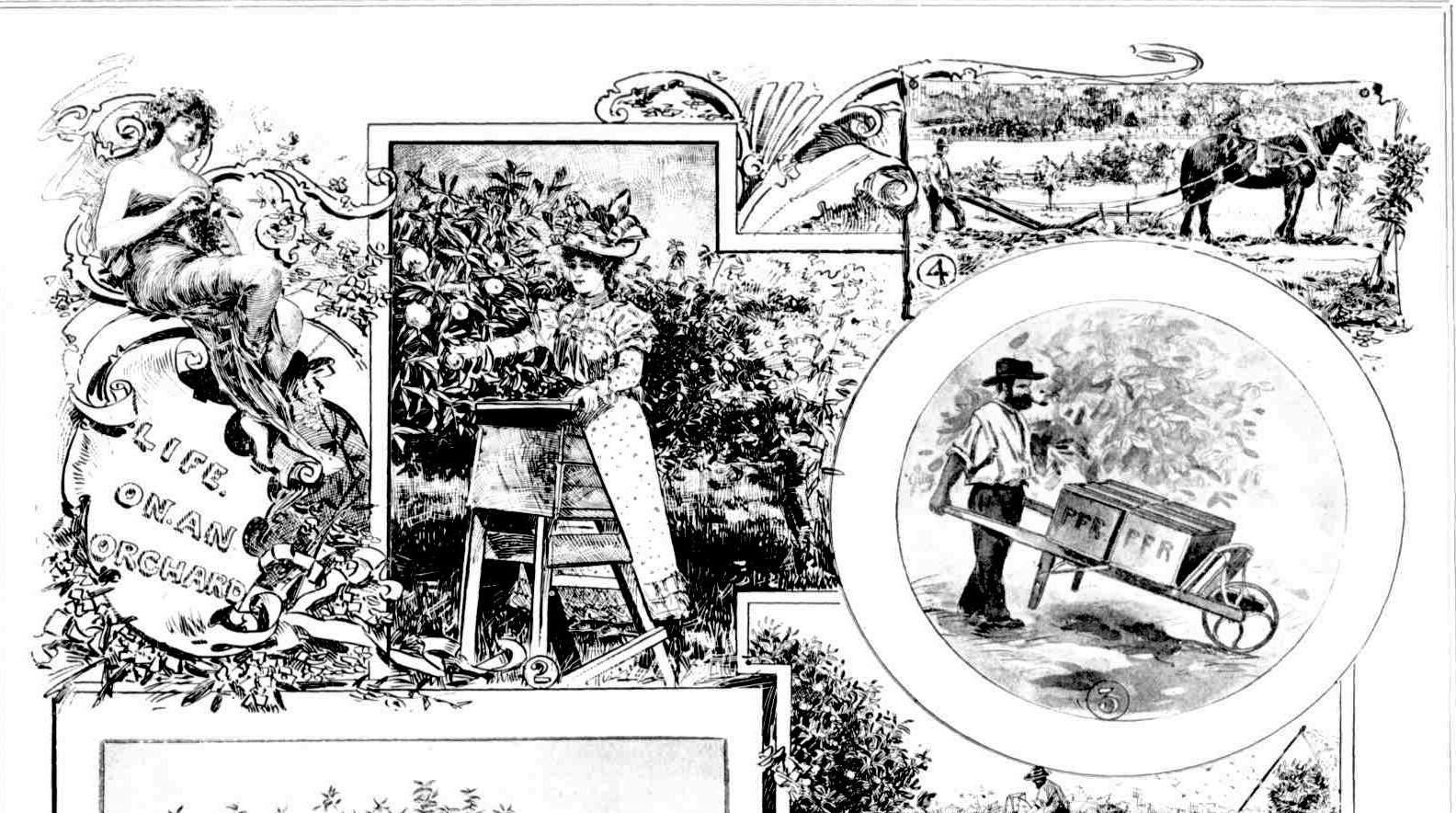
.jpg?timestamp=1534224493587)
.jpg?timestamp=1534224525551)
1. Picking fruit in the orchard. 2. A city cousin lends a helping hand. 3. Wheeling the fruit to the packing-house. 4. Ploughing the orchard. 5. Spraying the trees. 6. Carrying the fruit on a hand-barrow. 7. Scarifying the ground between the trees. 8. A view of the homestead.
(See letterpress In the Cultivator page 23.) Orchard Life Near Sydney. (1898, March 26). Australian Town and Country Journal (Sydney, NSW : 1870 - 1907), p. 19. Retrieved from http://nla.gov.au/nla.news-article71284603

Lane Cove Road at Turramurra ca.1910. Broadhurst postcard, courtesy State Library of NSW
LOCAL GOVERNMENT ACT, 1919.
Proposal to Declare a portion of the Shire of Ku-ring-gai to be a Residential District.
IT is hereby notified that the Ku-ring-gai Shire Council has applied to the Governor (a) to declare the portion of the Shire described in the Schedule hereto to be a Residential District, and to prohibit in such district (1) the erection of any building for use for the purposes of any trade, industry, manufacture, shop, or place of public amusement; (2} the use of any building for any such purposes; and (3) the erection or use of advertisement hoardings; and (b) to abolish the Residential Districts proclaimed by Proclamations in Government Gazettes Nos. 155 and 20 of 3rd November, 1922, and, 16th February, 1923, respectively.
Any person interested may, within one month from the date of this notice, make representations to the Minister in favour of or against the proposal, [L-G. 1924-134-717-196]
J. C. L. FITZPATRICK,
Minister.
Department of Local Government,
Sydney, 8th February, 1924.
Schedule.
The whole of the Shire of Ku-ring-gai with the exception of the following lands: —
(a) The public park known as "Ku-ring-gai Chase."
(b) Public reserves under the Council's control as owner or trustee, viz.:—
Roseville Chase; Davidson Park; Roseville Park; West Roseville Park; Children's Playground. Roseville; Lindfiold Park; Killara Park; Gordon Recreation Ground; East Gordon Park; Pymble Park; Soldiers' Memorial Park, Pymble; Hassall Park, St. Ives; Turramurra Park; Turramurra Look-out; and Wahroonga Park.
(c) Those lands having frontage to the following roads: —
Roseville—
Lane Cove road—South-westerly side." From Corona-avenue to Shirley-road, and shop
at corner of Grosvenor-road. Northeasterly ' side, from Boundary-street to Clanville-road.
Hill-street—North-easterly side, from Bancroft-avenue to Roseville-avenue, to a depth generally as far as the depth from Hill-street to Roberts-lane. Clive-street—Both sides.
Archbold-road—North-easterly side. From Carnarvon-road to Woodlands-road.
Middle Harbour—Lots 113 to 120 inclusive in Austin Chapman's subdivision, Lindfield'—
Lane Cove road—South-westerly side, from Gladstone-parade to Fidden's Wharf road, North-easterly side, from Middle Harbour road to Wolseley-road. Lindfield-avenue—North-easterly side, from Tryon-road to Woodside-a venue. Tryon-road—South-easterly side, from Lane Cove road to railway. Sydney-road—-North-easterly tide, from Brisbane-avenue "to Tryon-road.
Killara— .
Lane Cove road—Existing shops on lot 10, Killara Estate, lot 4, sec. 2, Taranna Estate, lots* 1 and 2, resubdivision of lot ]. Teranna Estate. Lots 8 and 9 and 10, sec. 1, Great Northern Township Estate. Marian-street Existing shops on north-westerly side—Lots 31 and 32, sec. 2, Springdale Estate. South-easterly side—lot 27, sec. 2, Springdale Estate.
Telita-avenue—-South-westerly side, from Marian-street to Lorne-avenue. Gordon—
Lane Cove road—North-easterly side, Greengate Hotel, North-easterly side, from Fox-street to Pittwater-road. South westerly side, from St. John's road to Ryde-road.
Fox-street—Both sides. Henry-street—South-westerly side, from Fox street to Pridham's (inclusive), John-street—North-easterly side from Khartoum-avenue to Gordon Recreation Ground.
Pymble—
Lane Cove road—South-westerly side, from Livingstone-avenue to Pymble Hotel (in/ elusive). North-easterly side, from Post Office to Bannockburn-road. Grandview-road—North-easterly side, from Station-street to Post Office street.
St. Ives—
Pittwater-road—North-westerly side, from Cowan-road lo Rosedale-road. Southeasterly side, from Rosedale-road to Stanley-street.
Turramurra—
Lane Cove road—Southern side, from Railway Bridge to Duff-street. Northern side, from Ku-ring-gai Chase avenue to and including corner block (lot 7, Arcadia Estate) on west side of Ray-street. Rohini-street—North-easterly side, from Lane Cove road to Eastern-road. Bay-street—East side, from Lane Cove road to William-street. Eastern-road—East side, from Alice-street to bridge opposite Gordon-lane. William-street—South-westerly side, from Lane Cove road to Rav-street. Ku-ring-gai Chase road—Both sides for 5
chains each way from King-street.
Warrawee— ,
Fox Valley road—North-westerly side, from Strone-avenue to Sanitarium. Portions 29 and 30. Lane Cove road—South-westerly side, from Marshall-avenue to approximately 3 chains south from Blytheswood-avenue.
Wahroonga—
Lane Cove road—North side, from Coonanbarra-road- to Isis-street. Coonanbarra-road -East side, from Lane Cove road to Railway. West side, from Millewa-avenue to Woniorn-avenue. Railway-avenue—Both sides, from Coonan barra-road to Railway Bridge. Stuart-street—South side—one existing shop at corner of Railway-avenue.
Warwilla-avenue—South-westerly side, from Coonanbarra-road to Neringah-avenue.
Gladvs-avenue—Both sides, from Hampden avenue to Westbrow-avenue. 1[4494]
LOCAL GOVERNMENT ACT, 1919. (1924, February 8). Government Gazette of the State of New South Wales (Sydney, NSW : 1901 - 2001), p. 900. Retrieved from http://nla.gov.au/nla.news-article223594240
WIDENING AND RECONSTRUCTING THE LANE COVE-ROAD.
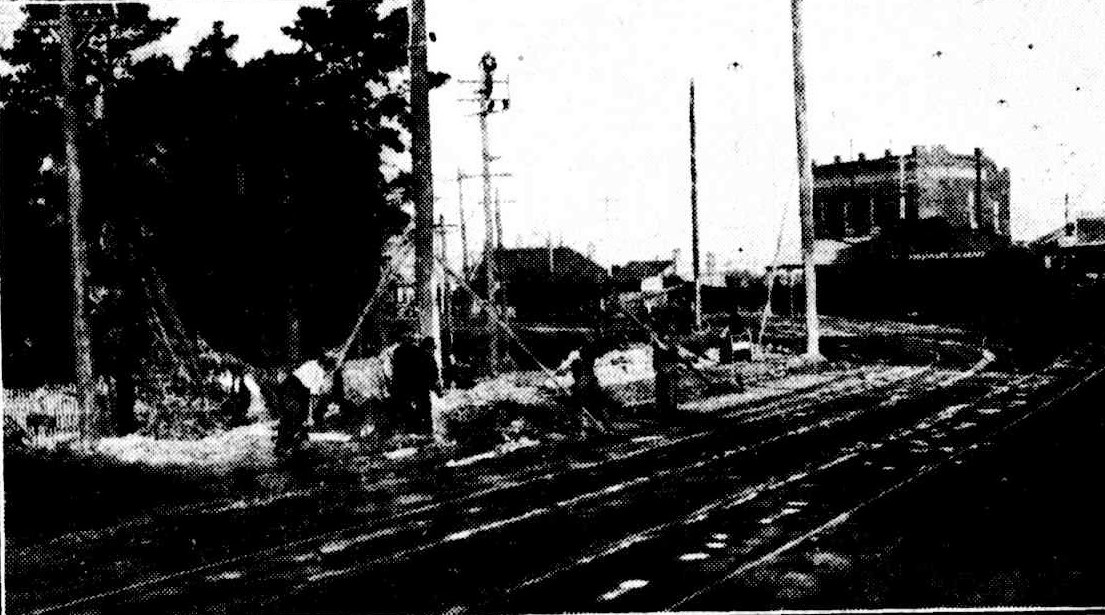
THE WORK IN PROGRESS NEAR THE GORE HILL CEMETERY. The road will be widened between St. Leonards Station and Longueville.
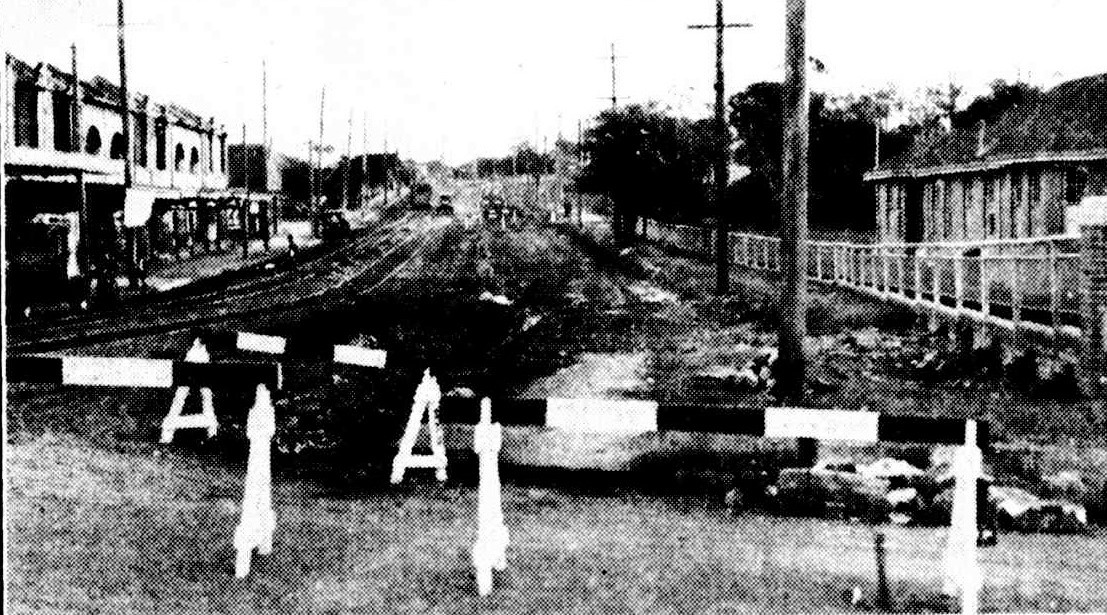
WIDENING AND RECONSTRUCTING THE LANE COVE-ROAD. (1927, June 21). The Sydney Morning Herald (NSW : 1842 - 1954), p. 14. Retrieved from http://nla.gov.au/nla.news-article16383865
MANLY TO BAY VIEW—A POPULAR EASTER RESORT BY ROAD

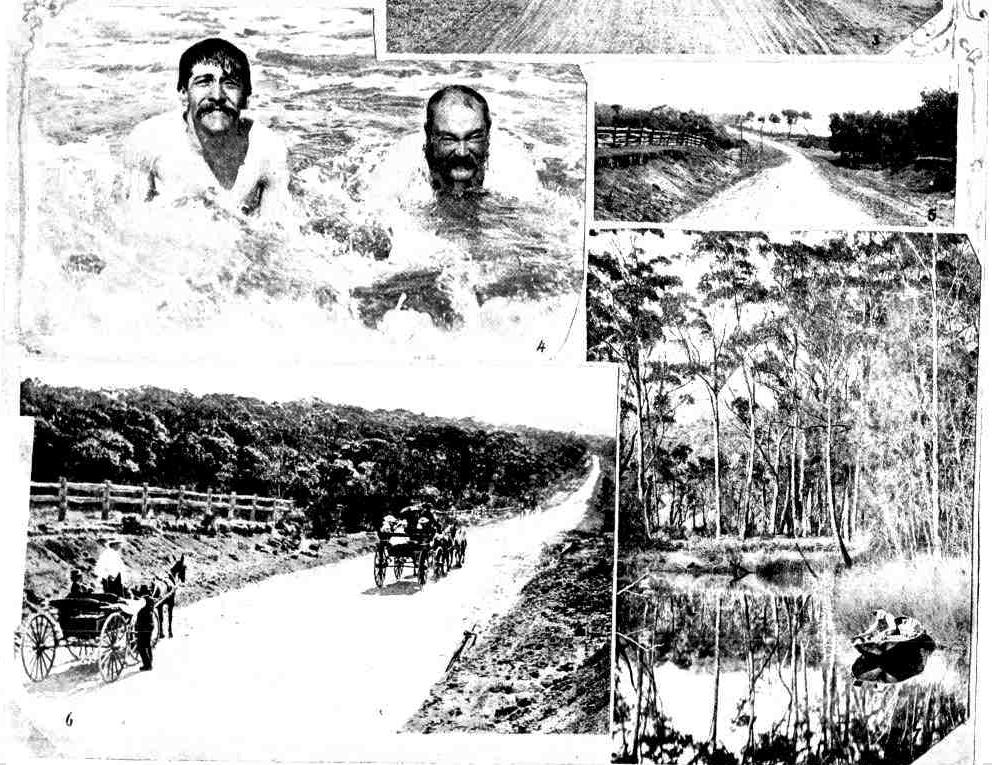
1. On the Narrabeen Lagoon. 2. View from Sheepstation Hill, looking south. 3. Bay View. 4. a dip in the surf at Narrabeen. 5. Near Long Reef. 6. Approaching Narrabeen. 7. One of the creeks.
The distance from Manly to Bay View is about 15 miles. The road is by the Narrabeen-road past Rocklily. A proposal to put down a tram line is now being considered, and a member of the ministry was recently driven over the country, which in many parts is remarkably picturesque.
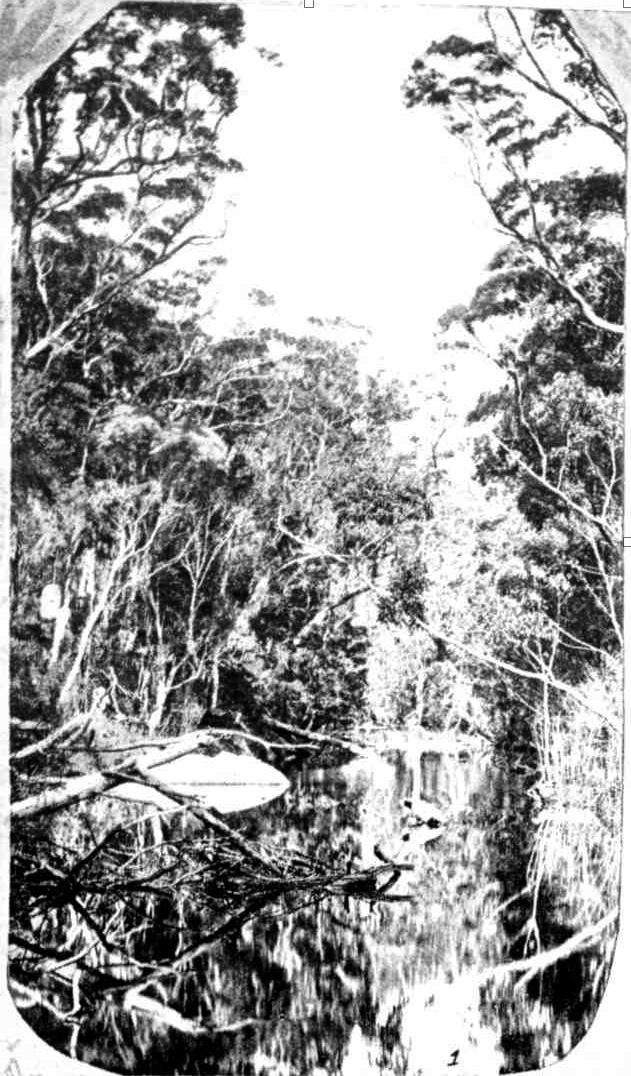
1. On the Narrabeen Lagoon.
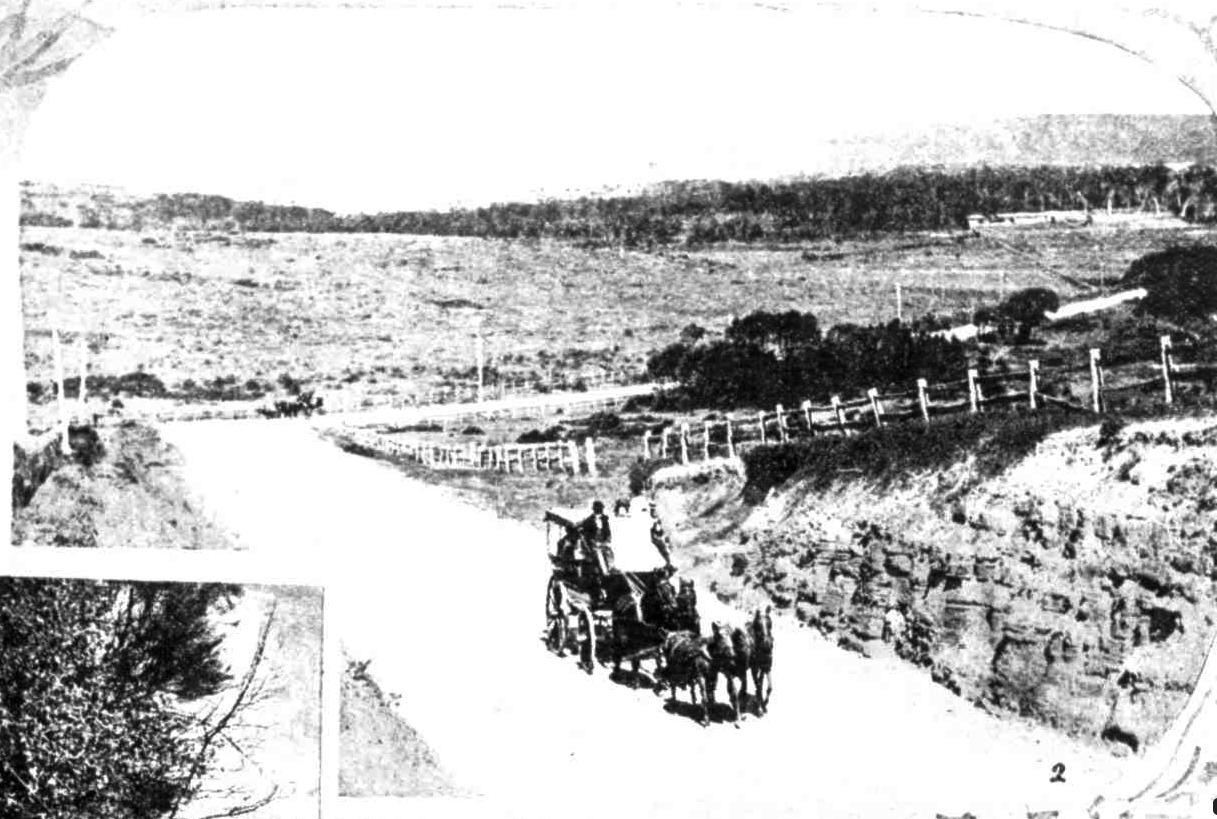
2. View from Sheepstation Hill, looking south.

3. Bay View.
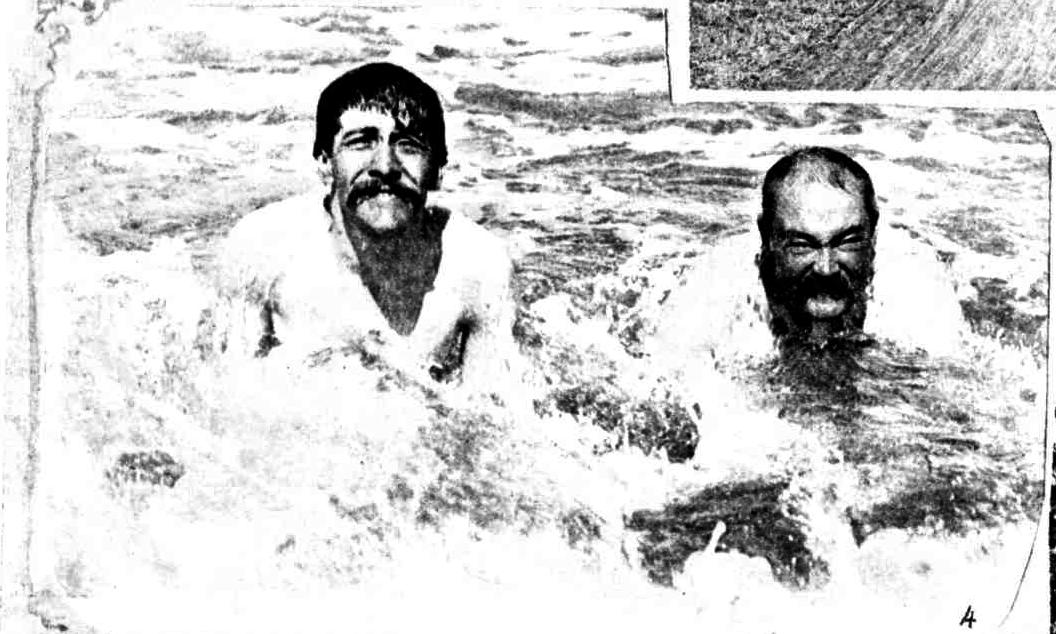
4. A dip in the surf at Narrabeen.
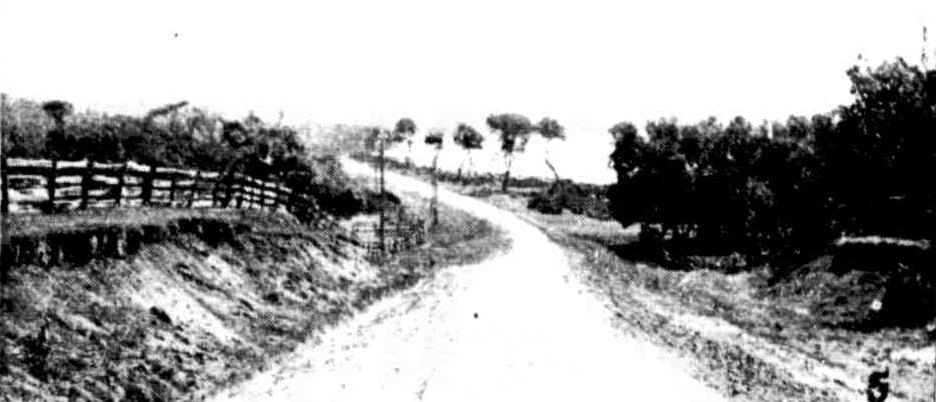
5. Near Long Reef.
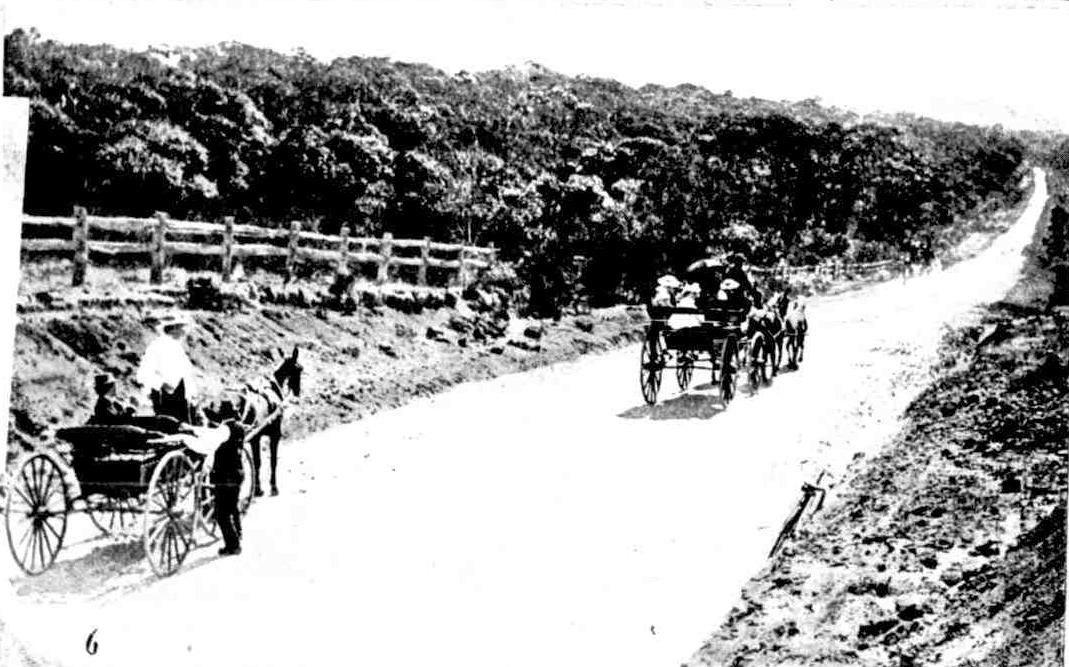
6. Approaching Narrabeen.
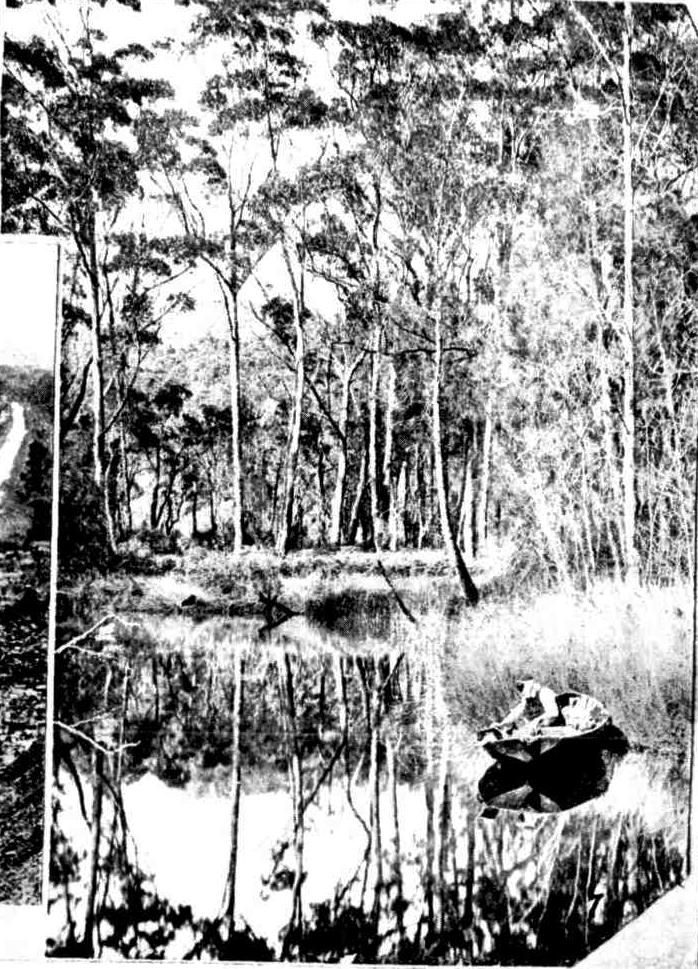
7. One of the creeks.
MANLY TO BAY VIEW—A POPULAR EASTER RESORT BY ROAD. (1900, April 14). The Sydney Mail and New South Wales Advertiser (NSW : 1871 - 1912), p. 878. Retrieved from http://nla.gov.au/nla.news-article165297416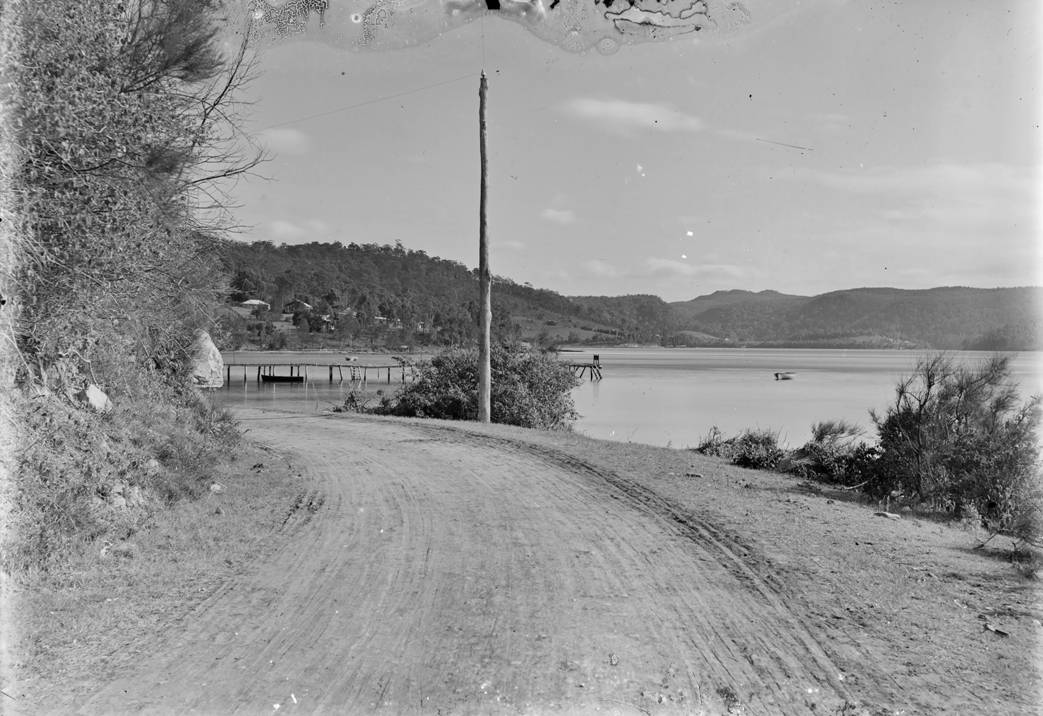
Image No.: c071950005 Box 17, Albums of William Joseph Macpherson - Bay View, courtesy State Library of NSW and Macpherson Family.
NB: these are photographs by William Joseph Macpherson (Wharriewood - Warriewood) - visit: The Macphersons of Wharriewood and Narrabeen: the photo albums of William Joseph Macpherson
That's right Readers - Roads IN Pittwater are next!